This repo will crawl apod(Astronomy Picture of the Day) from https://apod.nasa.gov/apod/ every day, using Github Actions.
2024/05/17
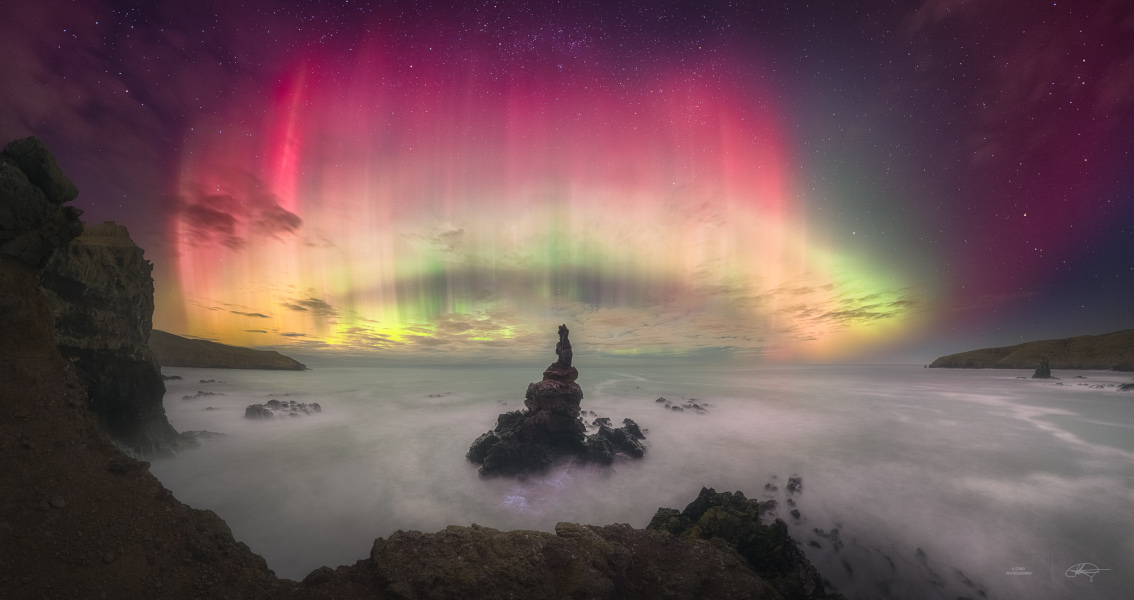
|
| Original url: https://apod.nasa.gov/apod/ |
|
Explanation: This well-composed composite panoramic view looks due south from Banks Peninsula near Christchurch on New Zealand's South Island. The base of a tower-like rocky sea stack is awash in the foreground, with stars of the Southern Cross at the top of the frame and planet Earth's south celestial pole near center. Still, captured on May 11, vibrant aurora australis dominate the starry southern sea and skyscape. The shimmering southern lights were part of extensive auroral displays that entertained skywatchers in northern and southern hemispheres around planet Earth, caused by intense geomagnetic storms. The extreme spaceweather was triggered by the impact of coronal mass ejections launched from powerful solar active region AR 3664. |
2024/05/16
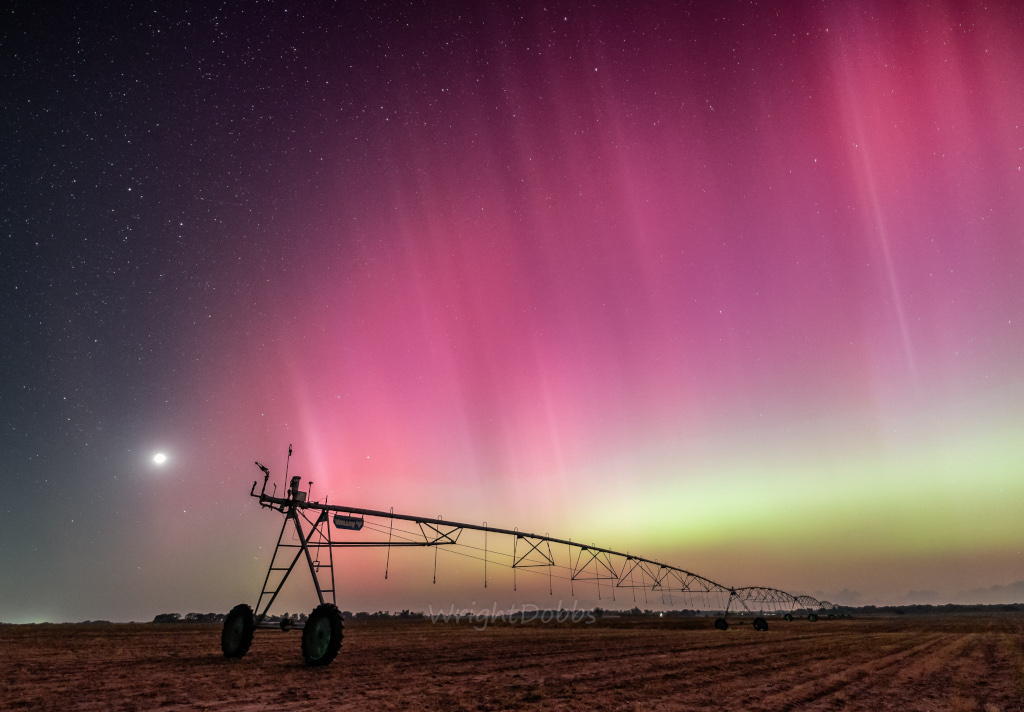
|
| Original url: https://apod.nasa.gov/apod/ap240516.html |
|
Explanation: A familiar sight from Georgia, USA, the Moon sets near the western horizon in this rural night skyscape. Captured on May 10 before local midnight, the image overexposes the Moon's bright waning crescent at left in the frame. A long irrigation rig stretches across farmland about 15 miles north of the city of Bainbridge. Shimmering curtains of aurora shine across the starry sky though, definitely an unfamiliar sight for southern Georgia nights. Last weekend, extreme geomagnetic storms triggered by the recent intense activity from solar active region AR 3664 brought epic displays of aurora , usually seen closer to the poles, to southern Georgia and even lower latitudes on planet Earth. As solar activity ramps up, more storms are possible. |
2024/05/15
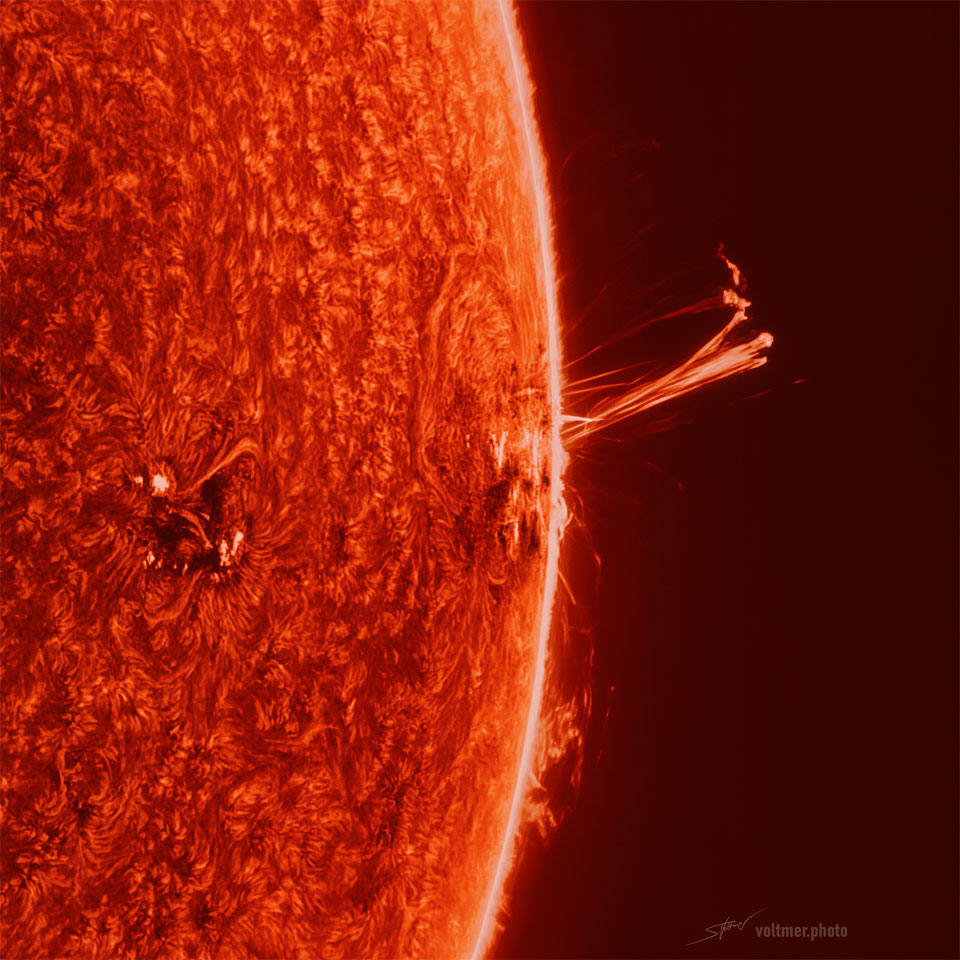
|
| Original url: https://apod.nasa.gov/apod/ap240515.html |
|
Explanation: What did the monster active region that created the recent auroras look like when at the Sun's edge? There, AR 3664 better showed its 3D structure. Pictured, a large multi-pronged solar prominence was captured extending from chaotic sunspot region AR 3664 out into space, just one example of the particle clouds ejected from this violent solar region. The Earth could easily fit under this long-extended prominence. The featured image was captured two days ago from this constantly changing region. Yesterday, the strongest solar flare in years was expelled (not shown), a blast classified in the upper X-class . Ultraviolet light from that flare quickly hit the Earth's atmosphere and caused shortwave radio blackouts across both North and South America . Although now rotated to be facing slightly away from the Earth, particles from AR 3664 and subsequent coronal mass ejections (CMEs) might still follow curved magnetic field lines across the inner Solar System and create more Earthly auroras . |
2024/05/14
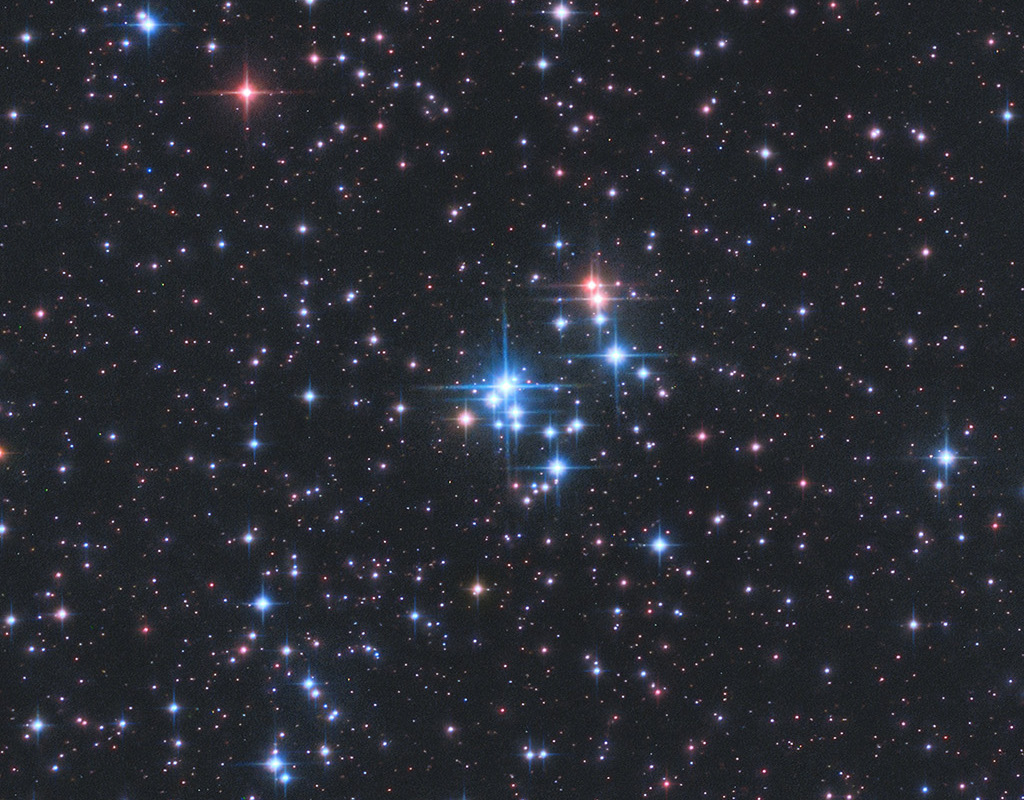
|
| Original url: https://apod.nasa.gov/apod/ap240514.html |
|
Explanation: For the mostly harmless denizens of planet Earth, the brighter stars of open cluster NGC 2169 seem to form a cosmic 37 . Did you expect 42 ? From our perspective, the improbable numerical asterism appears solely by chance. It lies at an estimated distance of 3,300 light-years toward the constellation Orion . As far as galactic or open star clusters go, NGC 2169 is a small one, spanning about 7 light-years. Formed at the same time from the same cloud of dust and gas, the stars of NGC 2169 are only about 11 million years old. Such clusters are expected to disperse over time as they encounter other stars, interstellar clouds, and experience gravitational tides while hitchhiking through the galaxy . Over four billion years ago, our own Sun was likely formed in a similar open cluster of stars . |
2024/05/13
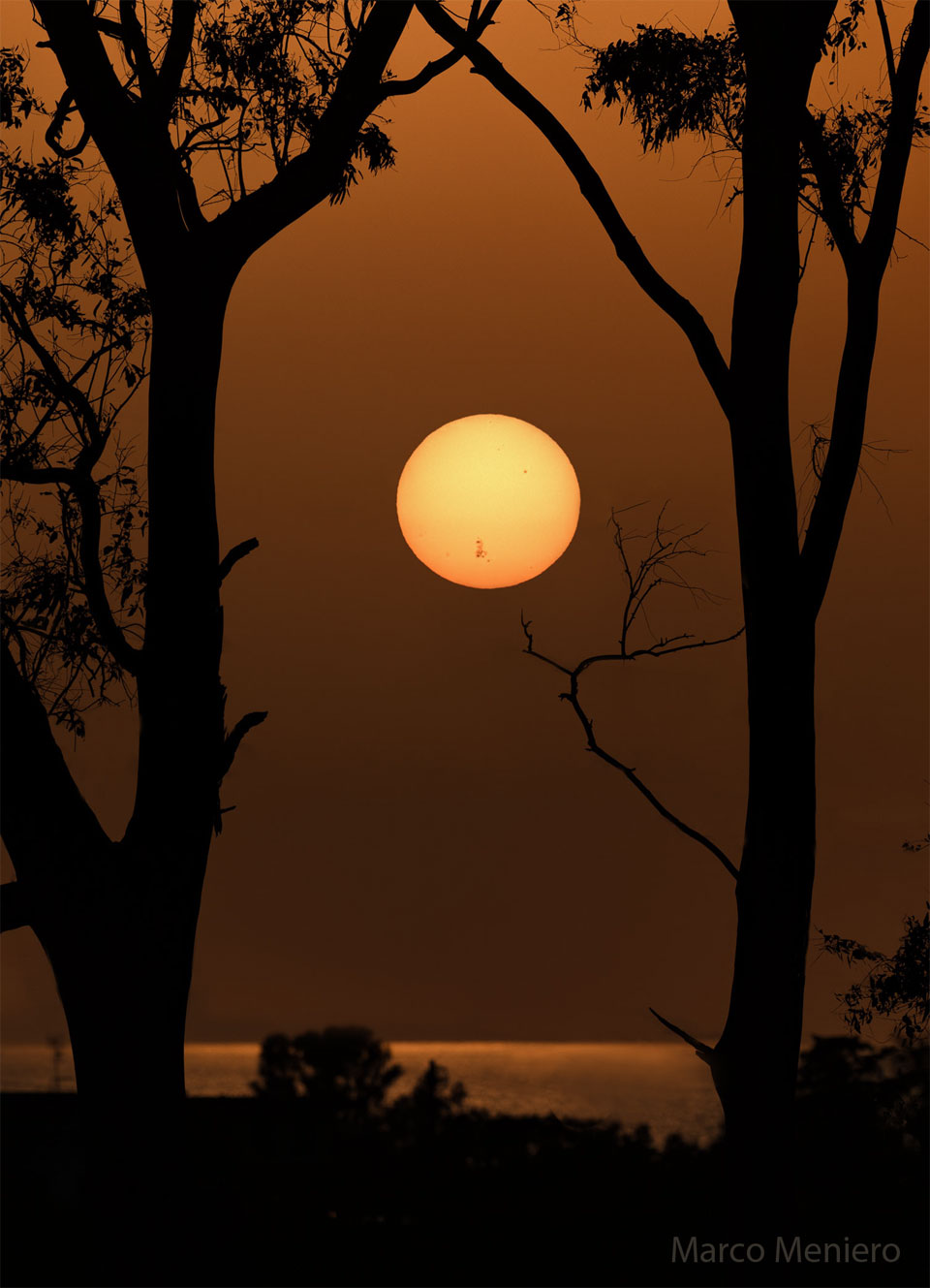
|
| Original url: https://apod.nasa.gov/apod/ap240513.html |
|
Explanation: It was larger than the Earth. It was so big you could actually see it on the Sun's surface without magnification. It contained powerful and tangled magnetic fields as well as numerous dark sunspot s. Labelled AR 3664 , it developed into one of the most energetic areas seen on the Sun in recent years, unleashing a series of explosions that led to a surge of energetic particles striking the Earth, which created beautiful auroras . And might continue . Although active regions on the Sun like AR 3664 can be quite dangerous, this region's Coronal Mass Ejections have not done, as yet, much damage to Earth-orbiting satellites or Earth-surface electrical grids . Pictured , the enormous active region was captured on the setting Sun a few days ago from Civitavecchia , Rome , Italy . The composite image includes a very short exposure taken of just the Sun's surface , but mimics what was actually visible. Finally, AR 3664 is now rotating away from the Earth, although the region may survive long enough to come around again . |
2024/05/12

|
| Original url: https://apod.nasa.gov/apod/ap240512.html |
|
Explanation: Northern lights don't usually reach this far south. Magnetic chaos in the Sun's huge Active Region 3664 , however, produced a surface explosion that sent a burst of electrons, protons, and more massive, charged nuclei into the Solar System . A few days later, that coronal mass ejection (CME) impacted the Earth and triggered auroras that are being reported unusually far from our planet's north and south poles . The free sky show might not be over -- the sunspot rich AR3664 has ejected even more CME s that might also impact the Earth tonight or tomorrow . That active region is now near the Sun's edge , though, and will soon be rotating away from the Earth . Pictured, a red and rayed aurora was captured in a single 6-second exposure from Racibórz , Poland early last night. The photographer's friend, seeing an aurora for the first time , is visible in the distance also taking images of the beautifully colorful nighttime sky. |
2024/05/11
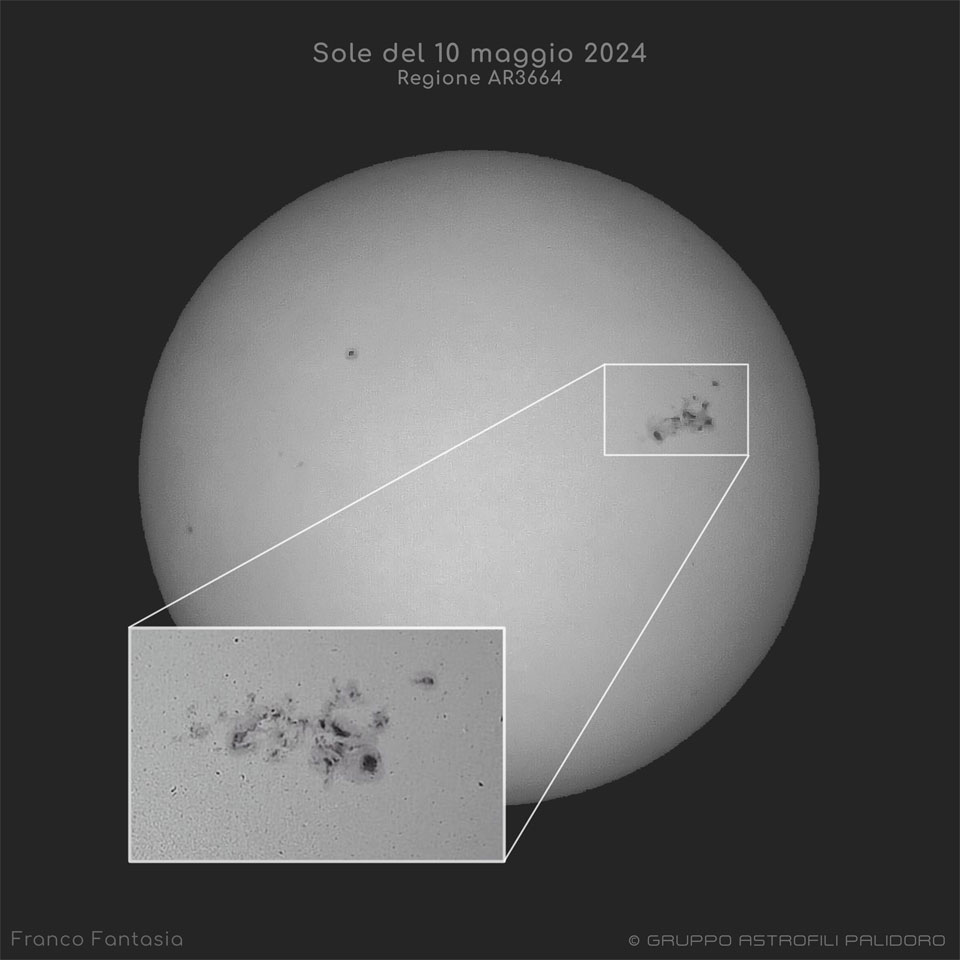
|
| Original url: https://apod.nasa.gov/apod/ap240511.html |
|
Explanation: Right now, one of the largest sunspot groups in recent history is crossing the Sun. Active Region 3664 is not only big -- it's violent, throwing off clouds of particles into the Solar System . Some of these CME s are already impacting the Earth, and others might follow. At the extreme, these solar storms could cause some Earth-orbiting satellites to malfunction , the Earth's atmosphere to slightly distort, and electrical power grids to surge . When impacting Earth's upper atmosphere , these particles can produce beautiful auroras, with some auroras already being reported unusually far south . Pictured here, AR3664 and its dark sunspot s were captured yesterday in visible light from Rome , Italy . The AR3664 sunspot group is so large that it is visible just with glasses designed to view last month's total solar eclipse . This weekend, skygazing enthusiasts will be keenly watching the night skies all over the globe for bright and unusual auroras . |
2024/05/09

|
| Original url: https://apod.nasa.gov/apod/ap240510.html |
|
Explanation: Bright elliptical galaxy Messier 87 (M87) is home to the supermassive black hole captured in 2017 by planet Earth's Event Horizon Telescope in the first ever image of a black hole. Giant of the Virgo galaxy cluster about 55 million light-years away, M87 is rendered in blue hues in this infrared image from the Spitzer Space telescope . Though M87 appears mostly featureless and cloud-like, the Spitzer image does record details of relativistic jets blasting from the galaxy's central region. Shown in the inset at top right, the jets themselves span thousands of light-years. The brighter jet seen on the right is approaching and close to our line of sight. Opposite, the shock created by the otherwise unseen receding jet lights up a fainter arc of material. Inset at bottom right, the historic black hole image is shown in context at the center of giant galaxy, between the relativistic jets. Completely unresolved in the Spitzer image, the supermassive black hole surrounded by infalling material is the source of enormous energy driving the relativistic jets from the center of active galaxy M87 . The Event Horizon Telescope image of M87 has been enhanced to reveal a sharper view of the famous supermassive black hole . |
2024/05/07
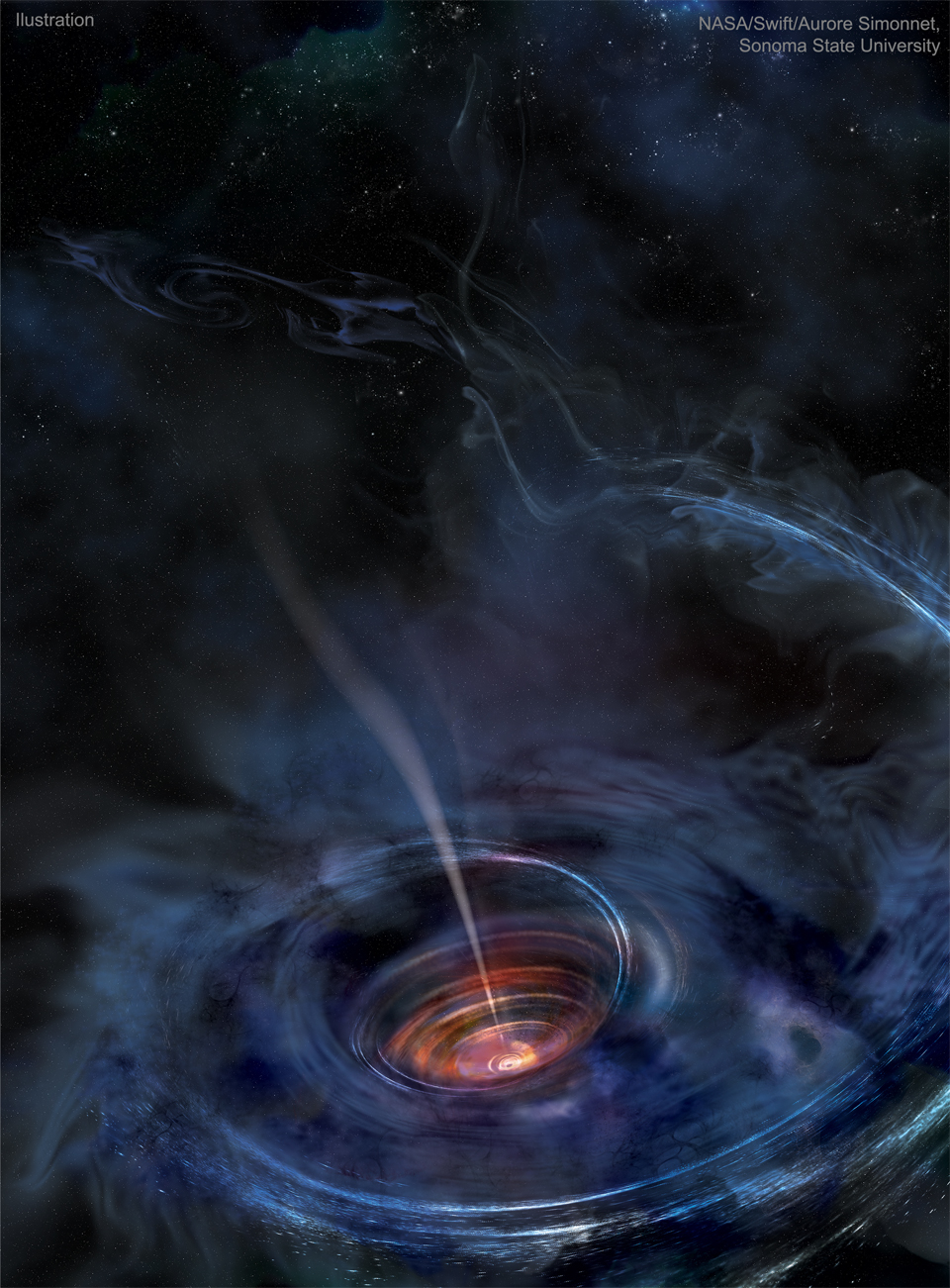
|
| Original url: https://apod.nasa.gov/apod/ap240508.html |
|
Explanation: What happens when a black hole devours a star? Many details remain unknown, but observations are providing new clues. In 2014, a powerful explosion was recorded by the ground-based robotic telescopes of the All Sky Automated Survey for SuperNovae (Project ASAS-SN), with followed-up observations by instruments including NASA 's Earth-orbiting Swift satellite . Computer modeling of these emissions fit a star being ripped apart by a distant supermassive black hole . The results of such a collision are portrayed in the featured artistic illustration . The black hole itself is a depicted as a tiny black dot in the center. As matter falls toward the hole , it collides with other matter and heats up . Surrounding the black hole is an accretion disk of hot matter that used to be the star, with a jet emanating from the black hole's spin axis . |
2024/05/05
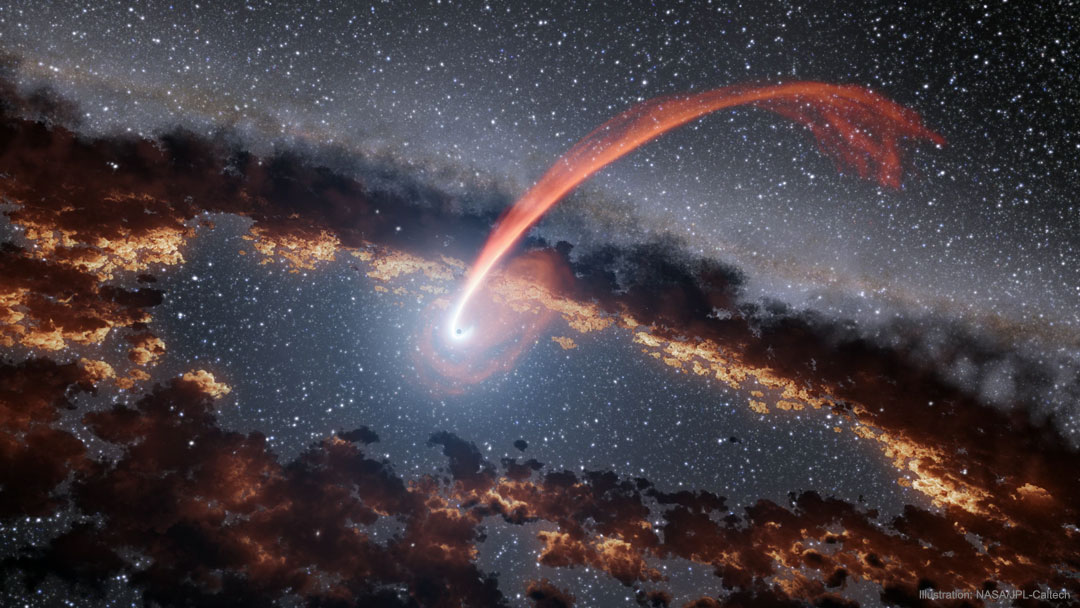
|
| Original url: https://apod.nasa.gov/apod/ap240506.html |
|
Explanation: What happens to a star that goes near a black hole? If the star directly impacts a massive black hole , then the star falls in completely -- and everything vanishes. More likely , though, the star goes close enough to have the black hole's gravity pull away its outer layers, or disrupt, the star . Then, most of the star's gas does not fall into the black hole . These stellar tidal disruption events can be as bright as a supernova, and an increasing amount of them are being discovered by automated sky surveys . In the featured artist's illustration , a star has just passed a massive black hole and sheds gas that continues to orbit. The inner edge of a disk of gas and dust surrounding the black hole is heated by the disruption event and may glow long after the star is gone. |
2024/05/04
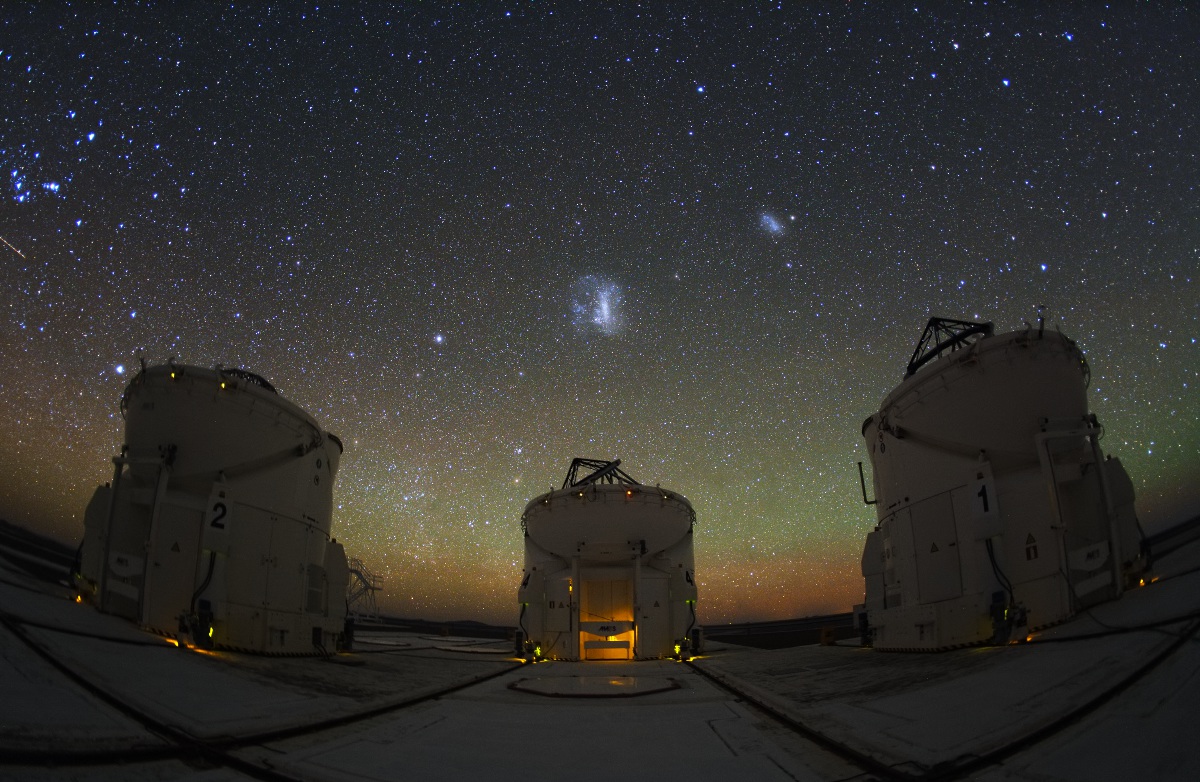
|
| Original url: https://apod.nasa.gov/apod/ap240504.html |
|
Explanation: Despite their resemblance to R2D2 , these three are not the droids you're looking for. Instead, the enclosures house 1.8 meter Auxiliary Telescopes (ATs) at Paranal Observatory in the Atacama Desert region of Chile. The ATs are designed to be used for interferometry , a technique for achieving extremely high resolution observations, in concert with the observatory's 8 meter Very Large Telescope units . A total of four ATs are operational, each fitted with a transporter that moves the telescope along a track allowing different arrays with the large unit telescopes. To work as an interferometer, the light from each telescope is brought to a common focal point by a system of mirrors in underground tunnels. Above these three ATs, the Large and Small Magellanic Clouds are the far, far away satellite galaxies of our own Milky Way. In the clear and otherwise dark southern skies, planet Earth's greenish atmospheric airglow stretches faintly along the horizon. |
2024/05/03

|
| Original url: https://apod.nasa.gov/apod/ap240503.html |
|
Explanation: A mere 280 light-years from Earth , tidally locked, Jupiter-sized exoplanet WASP-43b orbits its parent star once every 0.8 Earth days. That puts it about 2 million kilometers (less than 1/25th the orbital distance of Mercury) from a small, cool sun. Still, on a dayside always facing its parent star, temperatures approach a torrid 2,500 degrees F as measured at infrared wavelengths by the MIRI instrument on board the James Webb Space Telescope. In this illustration of the hot exoplanet's orbit, Webb measurements also show nightside temperatures remain above 1,000 degrees F. That suggests that strong equatorial winds circulate the dayside atmospheric gases to the nightside before they can completely cool off. Exoplanet WASP-43b is now formally known as Astrolábos, and its K-type parent star has been christened Gnomon. Webb's infrared spectra indicate water vapor is present on the nightside as well as the dayside of the planet, providing information about cloud cover on Astrolábos . |
2024/05/02

|
| Original url: https://apod.nasa.gov/apod/ap240502.html |
|
Explanation: Majestic on a truly cosmic scale, M100 is appropriately known as a grand design spiral galaxy. The large galaxy of over 100 billion stars has well-defined spiral arms, similar to our own Milky Way . One of the brightest members of the Virgo Cluster of galaxies, M100 , also known as NGC 4321 is 56 million light-years distant toward the well-groomed constellation Coma Berenices . In this telescopic image, the face-on grand design spiral shares a nearly 1 degree wide field-of-view with slightly less conspicuous edge-on spiral NGC 4312 (at upper right). The 21 hour long equivalent exposure from a dark sky site near Flagstaff, Arizona, planet Earth, reveals M100's bright blue star clusters and intricate winding dust lanes which are hallmarks of this class of galaxies. Measurements of variable stars in M100 have played an important role in determining the size and age of the Universe . |
2024/05/01
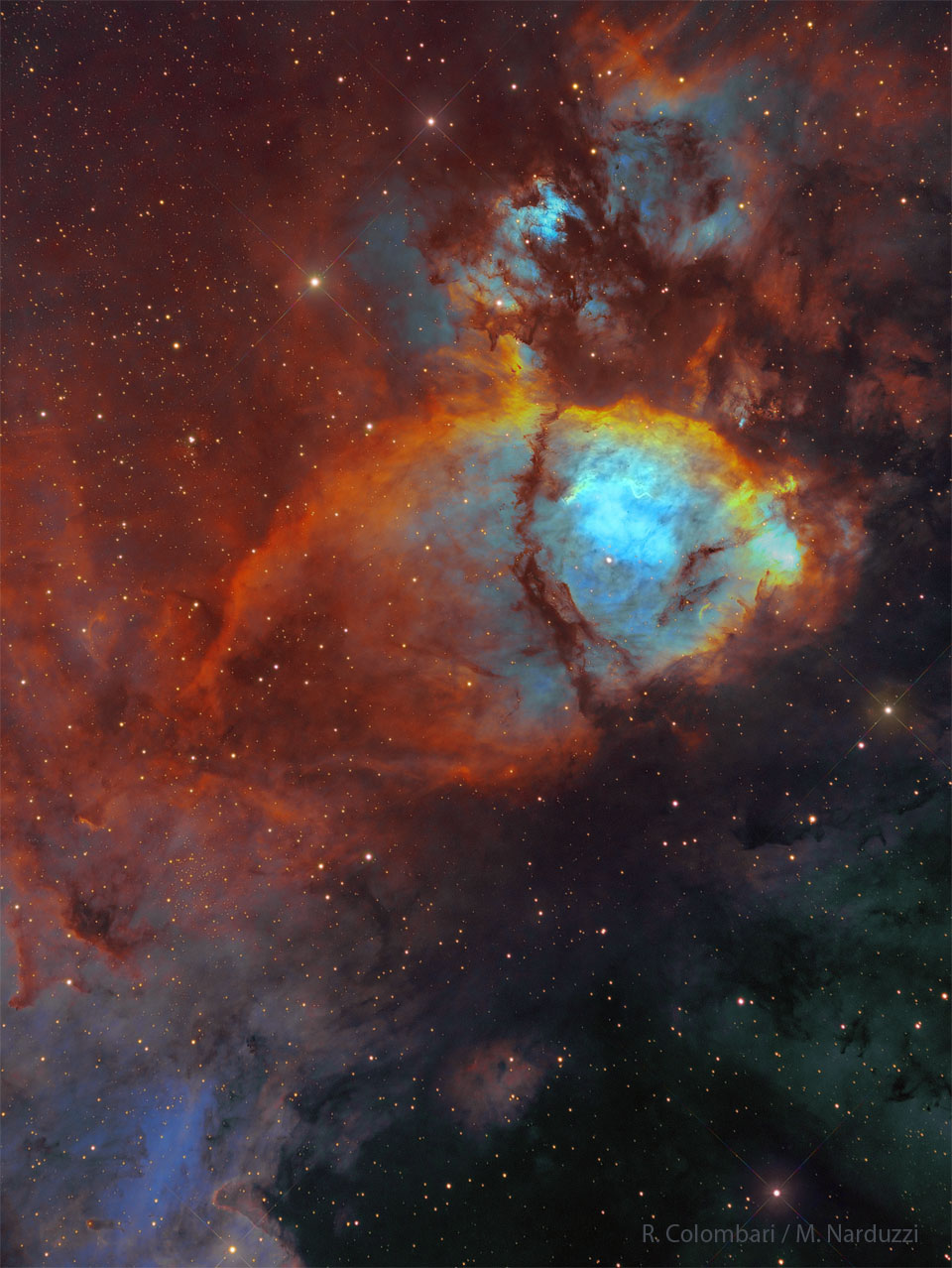
|
| Original url: https://apod.nasa.gov/apod/ap240501.html |
|
Explanation: To some, this nebula looks like the head of a fish . However, this colorful cosmic portrait really features glowing gas and obscuring dust clouds in IC 1795, a star forming region in the northern constellation Cassiopeia . The nebula's colors were created by adopting the Hubble color palette for mapping narrowband emissions from oxygen, hydrogen, and sulfur atoms to blue, green and red colors, and further blending the data with images of the region recorded through broadband filters. Not far on the sky from the famous Double Star Cluster in Perseus, IC 1795 is itself located next to IC 1805, the Heart Nebula , as part of a complex of star forming regions that lie at the edge of a large molecular cloud. Located just over 6,000 light-years away, the larger star forming complex sprawls along the Perseus spiral arm of our Milky Way Galaxy . At that distance, IC 1795 would span about 70 light-years across. |
2024/04/30
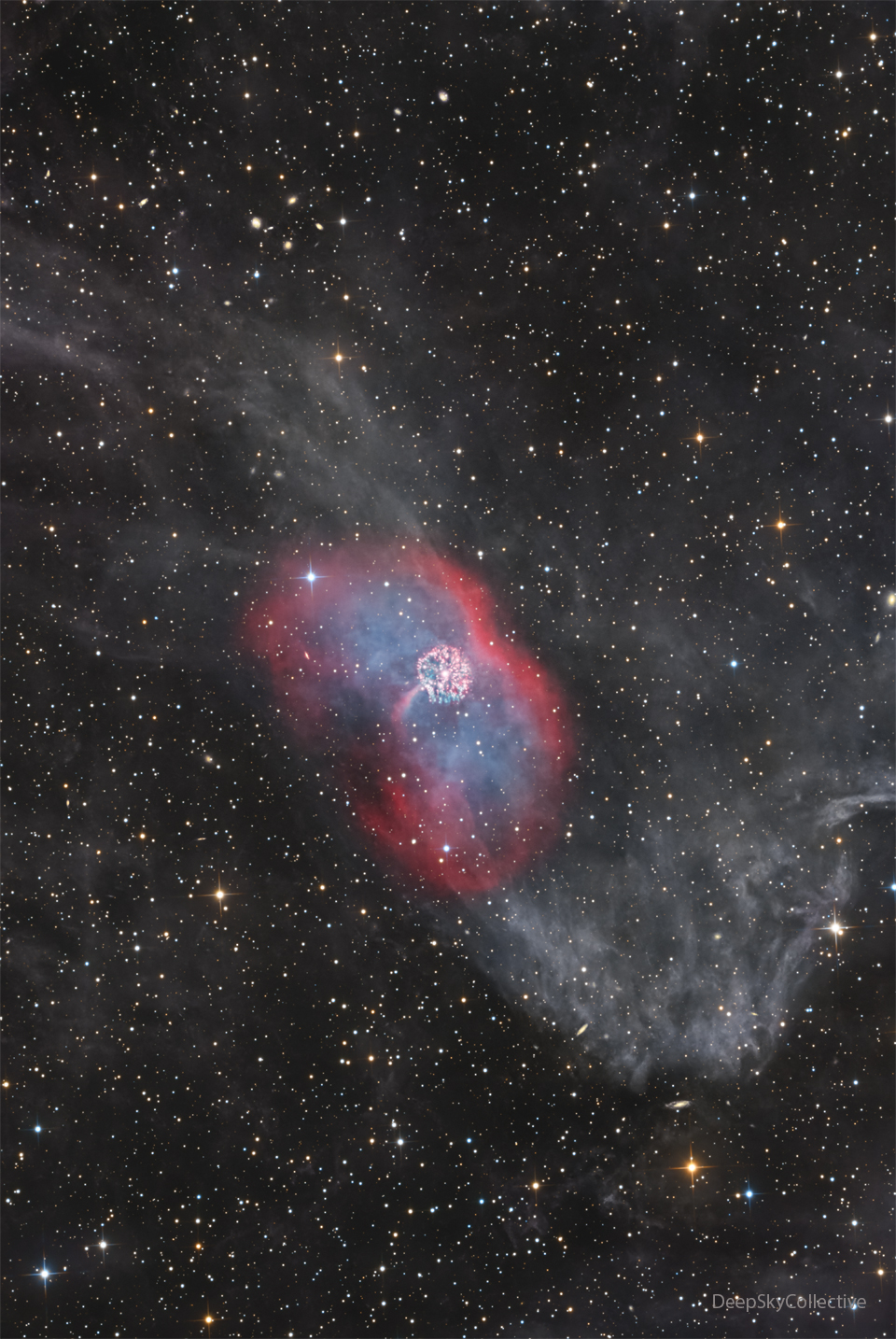
|
| Original url: https://apod.nasa.gov/apod/ap240430.html |
|
Explanation: The star system GK Per is known to be associated with only two of the three nebulas pictured . At 1500 light years distant, Nova Persei 1901 ( GK Persei ) was the second closest nova yet recorded. At the very center is a white dwarf star , the surviving core of a former Sun-like star. It is surrounded by the circular Firework nebula , gas that was ejected by a thermonuclear explosion on the white dwarf's surface -- a nova -- as recorded in 1901 . The red glowing gas surrounding the Firework nebula is the atmosphere that used to surround the central star. This gas was expelled before the nova and appears as a diffuse planetary nebula . The faint gray gas running across is interstellar cirrus that seems to be just passing through coincidently. In 1901, GK Per's nova became brighter than Betelgeuse . Similarly, star system T CrB is expected to erupt in a nova later this year, but we don't know exactly when nor how bright it will become. |
2024/04/29
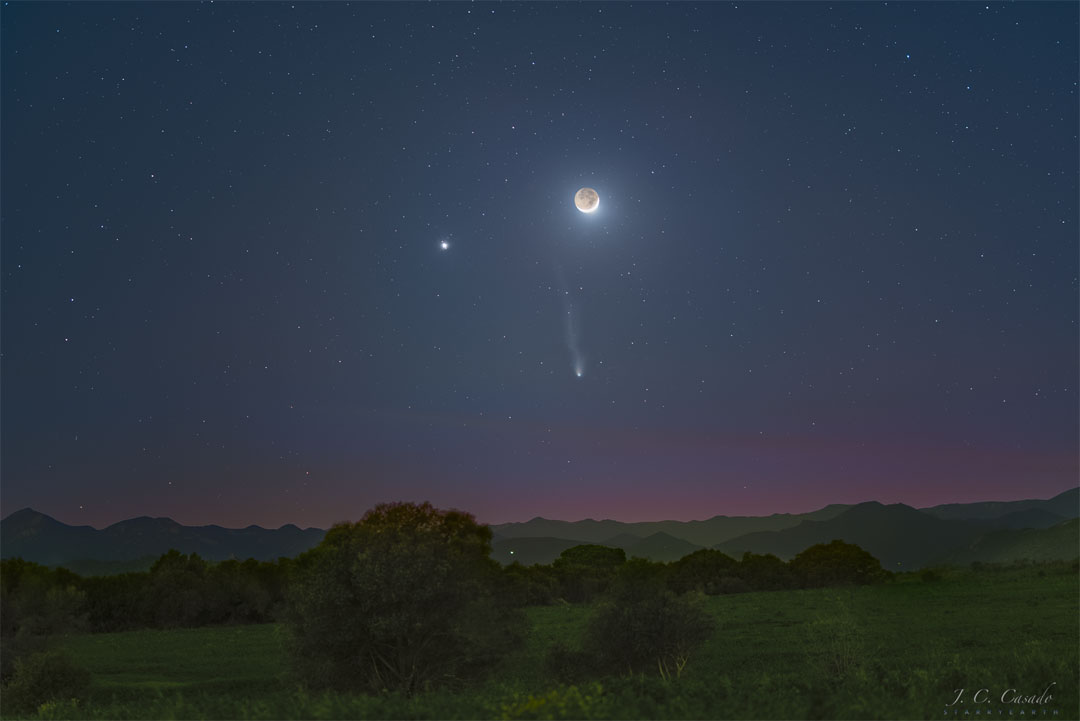
|
| Original url: https://apod.nasa.gov/apod/ap240429.html |
|
Explanation: Three bright objects satisfied seasoned stargazers of the western sky just after sunset earlier this month. The most familiar was the Moon , seen on the upper left in a crescent phase . The rest of the Moon was faintly visible by sunlight first reflected by the Earth . The bright planet Jupiter , the largest planet in the Solar System , is seen to the upper left. Most unusual was Comet 12P/Pons-Brooks , below the Moon and showing a stubby dust tail on the right but an impressive ion tail extending upwards . The featured image, a composite of several images taken consecutively at the same location and with the same camera, was taken near the village of Llers , in Spain 's Girona province . Comet Pons-Brooks passed its closest to the Sun last week and is now dimming as it moves into southern skies and returns to the outer Solar System. |
2024/04/28

|
| Original url: https://apod.nasa.gov/apod/ap240428.html |
|
Explanation: The Ring Nebula (M57) is more complicated than it appears through a small telescope. The easily visible central ring is about one light-year across, but this remarkably deep exposure - a collaborative effort combining data from three different large telescopes - explores the looping filaments of glowing gas extending much farther from the nebula 's central star. This composite image includes red light emitted by hydrogen as well as visible and infrared light . The Ring Nebula is an elongated planetary nebula , a type of nebula created when a Sun -like star evolves to throw off its outer atmosphere and become a white dwarf star . The Ring Nebula is about 2,500 light-years away toward the musical constellation Lyra . |
2024/04/27
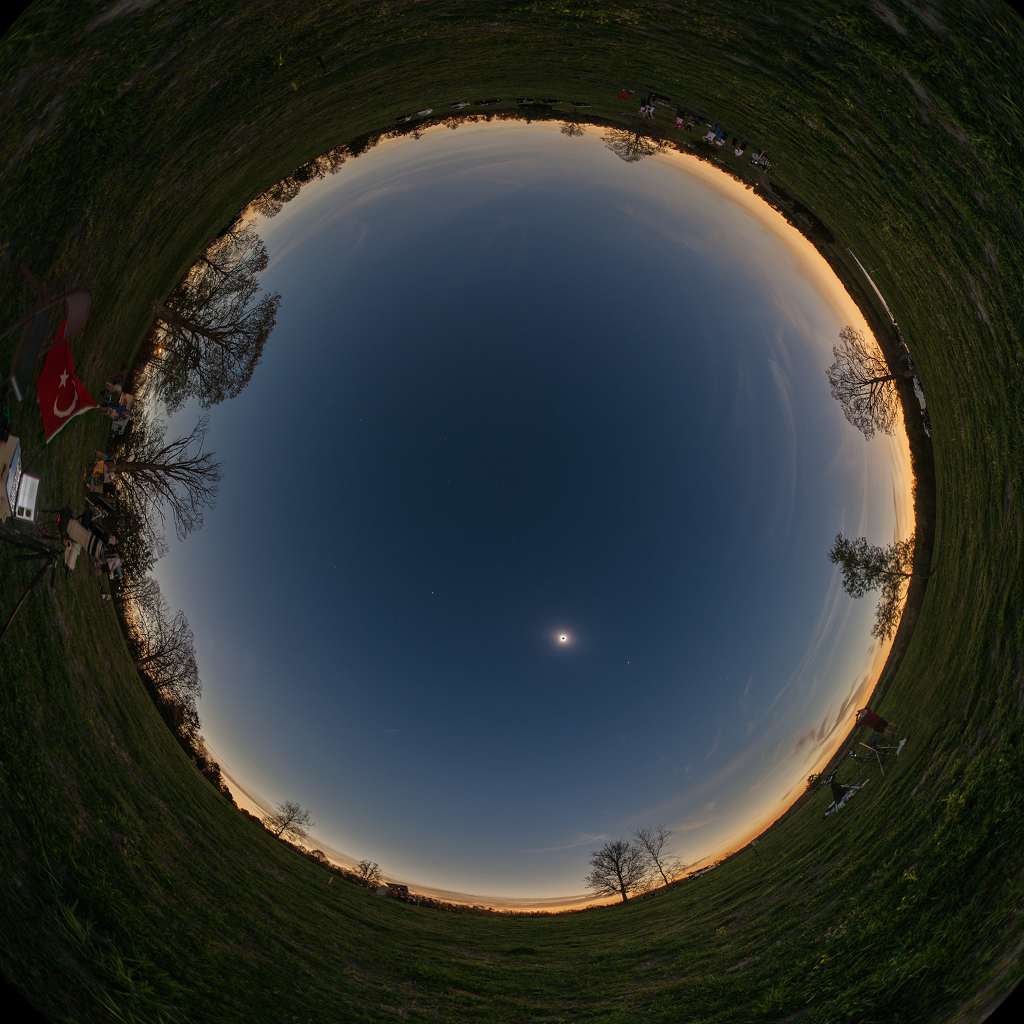
|
| Original url: https://apod.nasa.gov/apod/ap240427.html |
|
Explanation: If the Sun is up but the sky is dark and the horizon is bright all around, you might be standing in the Moon's shadow during a total eclipse of the Sun. In fact, the all-sky Moon shadow shown in this composited panoramic view was captured from a farm near Shirley, Arkansas, planet Earth. The exposures were made under clear skies during the April 8 total solar eclipse . For that location near the center line of the Moon's shadow track, totality lasted over 4 minutes. Along with the solar corona surrounding the silhouette of the Moon planets and stars were visible during the total eclipse phase. Easiest to see here are bright planets Venus and Jupiter, to the lower right and upper left of the eclipsed Sun. |
2024/04/26

|
| Original url: https://apod.nasa.gov/apod/ap240426.html |
|
Explanation: In northern hemisphere spring , bright star Regulus is easy to spot above the eastern horizon. The alpha star of the constellation Leo, Regulus is the spiky star centered in this telescopic field of view . A mere 79 light-years distant, Regulus is a hot, rapidly spinning star that is known to be part of a multiple star system. Not quite lost in the glare, the fuzzy patch just below Regulus is diffuse starlight from small galaxy Leo I. Leo I is a dwarf spheroidal galaxy , a member of the Local Group of galaxies dominated by our Milky Way Galaxy and the Andromeda Galaxy ( M31 ). About 800 thousand light-years away, Leo I is thought to be the most distant of the known small satellite galaxies orbiting the Milky Way. But dwarf galaxy Leo I has shown evidence of a supermassive black hole at its center, comparable in mass to the black hole at the center of the Milky Way. |
2024/04/25
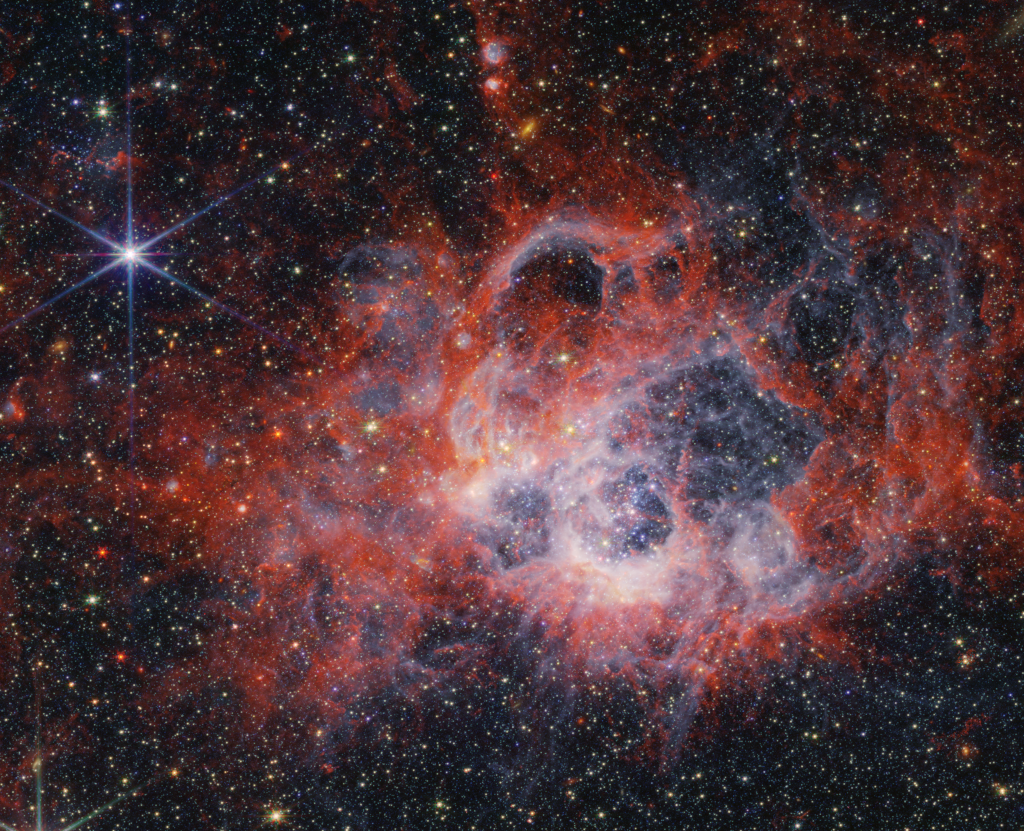
|
| Original url: https://apod.nasa.gov/apod/ap240425.html |
|
Explanation: Located some 3 million light-years away in the arms of nearby spiral galaxy M33 , giant stellar nursery NGC 604 is about 1,300 light-years across. That's nearly 100 times the size of the Milky Way's Orion Nebula , the closest large star forming region to planet Earth. In fact, among the star forming regions within the Local Group of galaxies, NGC 604 is second in size only to 30 Doradus, also known as the Tarantula Nebula in the Large Magellanic Cloud. Cavernous bubbles and cavities in NGC 604 fill this stunning infrared image from the James Webb Space Telescope's NIRCam . They are carved out by energetic stellar winds from the region's more than 200 hot, massive, young stars, all still in early stages of their lives . |
2024/04/24

|
| Original url: https://apod.nasa.gov/apod/ap240424.html |
|
Explanation: How did a star form this beautiful nebula? In the middle of emission nebula NGC 6164 is an unusually massive star . The central star has been compared to an oyster's pearl and an egg protected by the mythical sky dragons of Ara . The star, visible in the center of the featured image and catalogued as HD 148937 , is so hot that the ultraviolet light it emits heats up gas that surrounds it. That gas was likely thrown off from the star previously, possibly the result of a gravitational interaction with a looping stellar companion. Expelled material might have been channeled by the magnetic field of the massive star, in all creating the symmetric shape of the bipolar nebula . NGC 6164 spans about four light years and is located about 3,600 light years away toward the southern constellation Norma . |
2024/04/23

|
| Original url: https://apod.nasa.gov/apod/ap240423.html |
|
Explanation: What created this giant X in the clouds? It was the shadow of contrails illuminated from below. When airplanes fly, humid engine exhaust may form water droplets that might freeze in Earth's cold upper atmosphere . These persistent streams of water and ice scatter light from the Sun above and so appear bright from below . On rare occasions, though, when the Sun is near the horizon, contrails can be lit from below. These contrails cast long shadows upwards, shadows that usually go unseen unless there is a high cloud deck. But that was just the case over Istanbul , Türkiye , earlier this month. Contrails occur all over planet Earth and, generally, warm the Earth when the trap infrared light but cool the Earth when they efficiently reflect sunlight . The image was taken by a surprised photographer in the morning on the way to work . |
2024/04/22

|
| Original url: https://apod.nasa.gov/apod/ap240422.html |
|
Explanation: Yes, but can your volcano do this? To the surprise of some, Mt. Etna emits, on occasion, smoke rings. Technically known as vortex rings , the walls of the volcano slightly slow the outside of emitted smoke puffs , causing the inside gas to move faster. A circle of low pressure develops so that the emitted puff of volcanic gas and ash loops around in a ring , a familiar geometric structure that can be surprisingly stable as it rises. Smoke ring s are quite rare and need a coincidence of the right geometry of the vent, the right speed of ejected smoke , and the relative calmness of the outside atmosphere. In the featured image taken about two weeks ago from Gangi , Sicily , Italy , multiple volcanic smoke rings are visible. The scene is shaded by the red light of a dawn Sun , while a crescent Moon is visible in the background. |
2024/04/20

|
| Original url: https://apod.nasa.gov/apod/ap240421.html |
|
Explanation: When the dark shadow of the Moon raced across North America on April 8, sky watchers along the shadow's narrow central path were treated to a total solar eclipse. During the New Moon's shadow play diamonds glistened twice in the eclipse-darkened skies . The transient celestial jewels appeared immediately before and after the total eclipse phase. That's when the rays of a vanishing and then emerging sliver of solar disk are just visible behind the silhouetted Moon's edge, creating the appearance of a shiny diamond set in a dark ring. This dramatic timelapse composite from north-central Arkansas captures both diamond ring moments of this total solar eclipse . The diamond rings are separated by the ethereal beauty of the solar corona visible during totality. |
2024/04/19
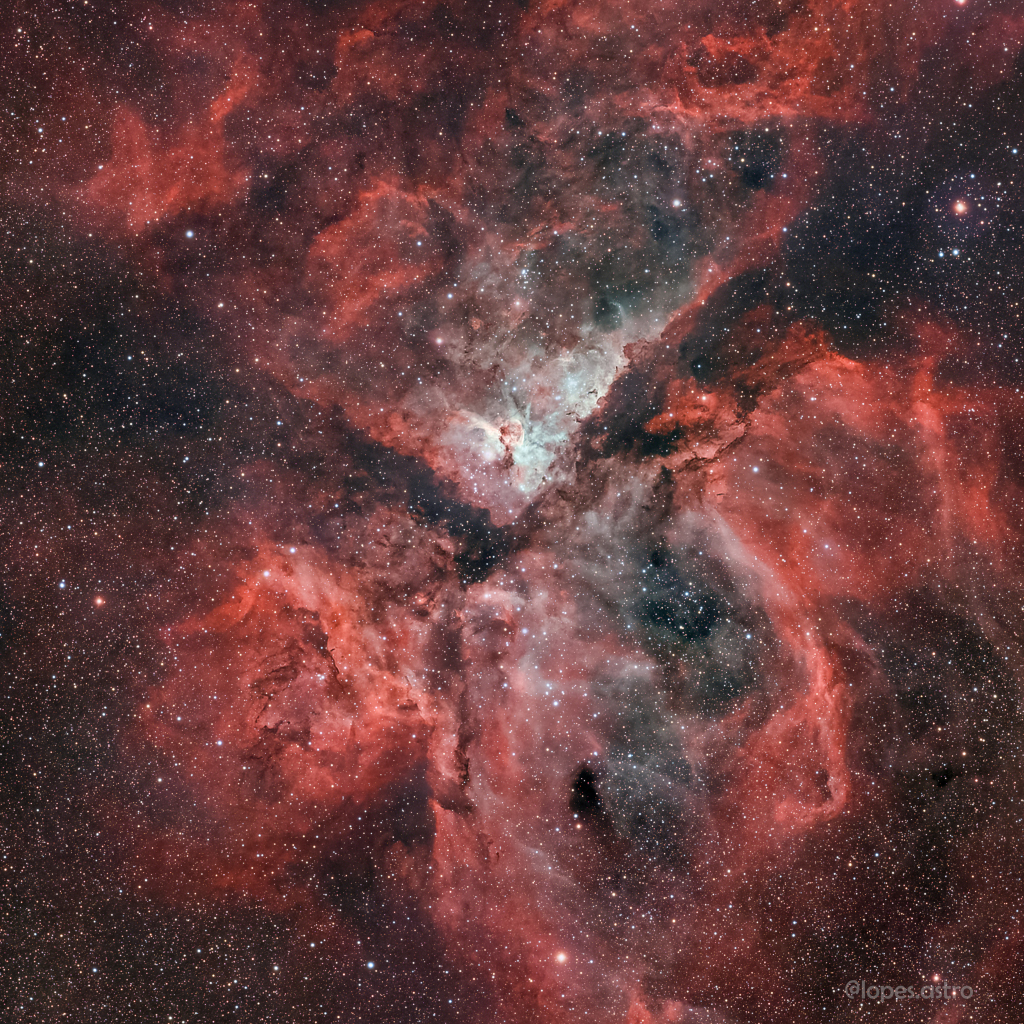
|
| Original url: https://apod.nasa.gov/apod/ap240419.html |
|
Explanation: A jewel of the southern sky , the Great Carina Nebula is more modestly known as NGC 3372. One of our Galaxy's largest star forming regions, it spans over 300 light-years. Like the smaller, more northerly Great Orion Nebula , the Carina Nebula is easily visible to the unaided eye. But at a distance of 7,500 light-years it lies some 5 times farther away. This stunning telescopic view reveals remarkable details of the region's glowing filaments of interstellar gas and obscuring cosmic dust clouds. The Carina Nebula is home to young, extremely massive stars, including the still enigmatic variable Eta Carinae , a star with well over 100 times the mass of the Sun. Eta Carinae is the bright star above the central dark notch in this field and left of the dusty Keyhole Nebula (NGC 3324). |
2024/04/18
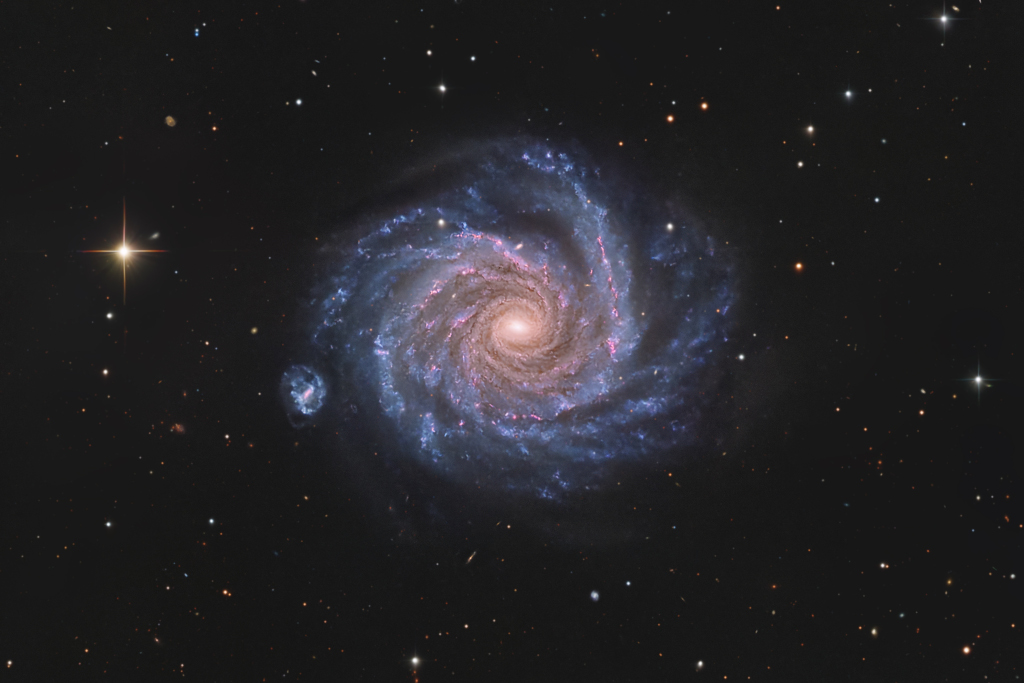
|
| Original url: https://apod.nasa.gov/apod/ap240418.html |
|
Explanation: From our vantage point in the Milky Way Galaxy , we see NGC 1232 face-on. Nearly 200,000 light-years across, the big, beautiful spiral galaxy is located some 47 million light-years away in the flowing southern constellation of Eridanus. This sharp, multi-color, telescopic image of NGC 1232 includes remarkable details of the distant island universe. From the core outward, the galaxy's colors change from the yellowish light of old stars in the center to young blue star clusters and reddish star forming regions along the grand, sweeping spiral arms. NGC 1232's apparent, small, barred-spiral companion galaxy is cataloged as NGC 1232A. Distance estimates place it much farther though, around 300 million light-years away, and unlikely to be interacting with NGC 1232 . Of course, the prominent bright star with the spiky appearance is much closer than NGC 1232 and lies well within our own Milky Way. |
2024/04/17
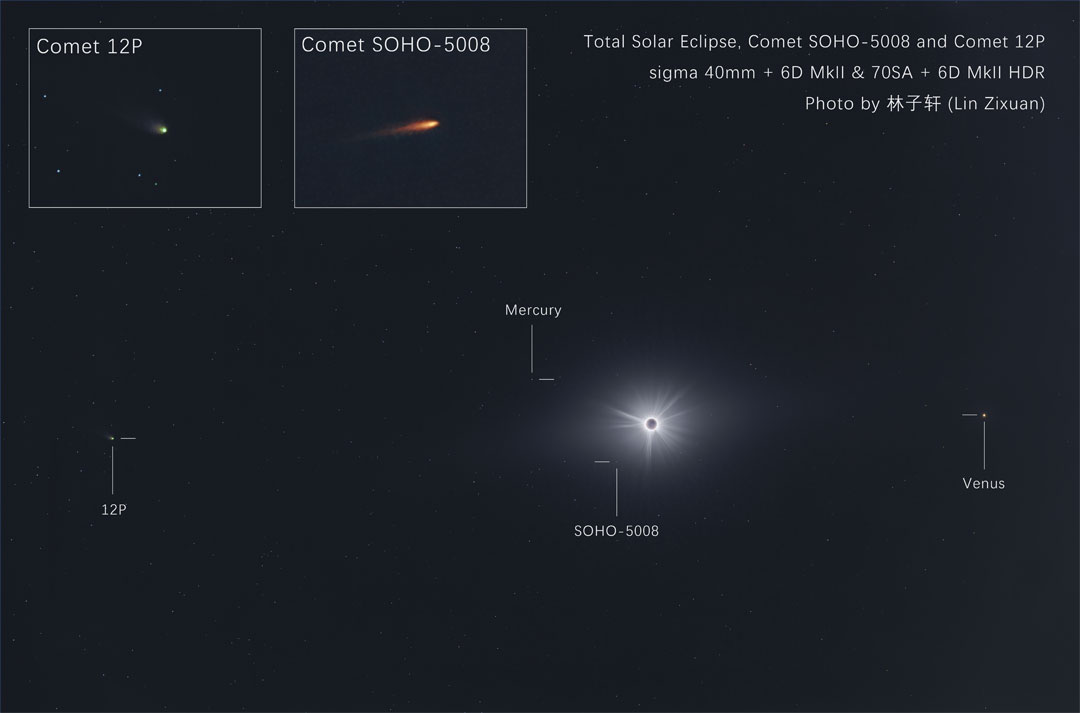
|
| Original url: https://apod.nasa.gov/apod/ap240417.html |
|
Explanation: Not one, but two comets appeared near the Sun during last week's total solar eclipse . The expected comet was Comet 12P/Pons-Brooks , but it was disappointingly dimmer than many had hoped. However, relatively unknown Comet SOHO-5008 also appeared in long duration camera exposures. This comet was the 5008th comet identified on images taken by ESA & NASA 's Sun-orbiting SOHO spacecraft . Likely much smaller, Comet SOHO-5008 was a sungrazer which disintegrated within hours as it passed too near the Sun . The featured image is not only unusual for capturing two comets during an eclipse, but one of the rare times that a sungrazing comet has been photographed from the Earth's surface. Also visible in the image is the sprawling corona of our Sun and the planets Mercury (left) and Venus (right). Of these planets and comets, only Venus was easily visible to millions of people in the dark shadow of the Moon that crossed North America on April 8. |
2024/04/16
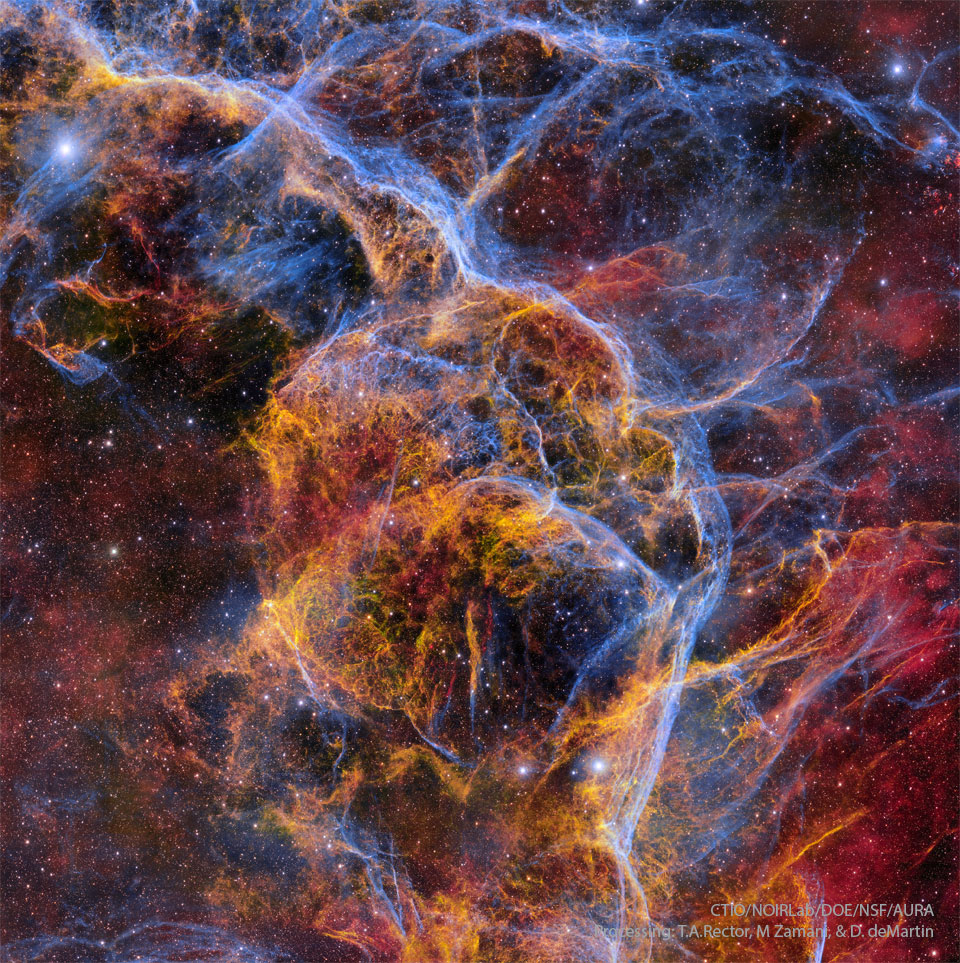
|
| Original url: https://apod.nasa.gov/apod/ap240416.html |
|
Explanation: The explosion is over, but the consequences continue. About eleven thousand years ago, a star in the constellation of Vela could be seen to explode , creating a strange point of light briefly visible to humans living near the beginning of recorded history . The outer layers of the star crashed into the interstellar medium , driving a shock wave that is still visible today. The featured image captures some of that filamentary and gigantic shock in visible light . As gas flies away from the detonated star, it decays and reacts with the interstellar medium, producing light in many different colors and energy bands. Remaining at the center of the Vela Supernova Remnant is a pulsar , a star as dense as nuclear matter that spins around more than ten times in a single second. |
2024/04/15
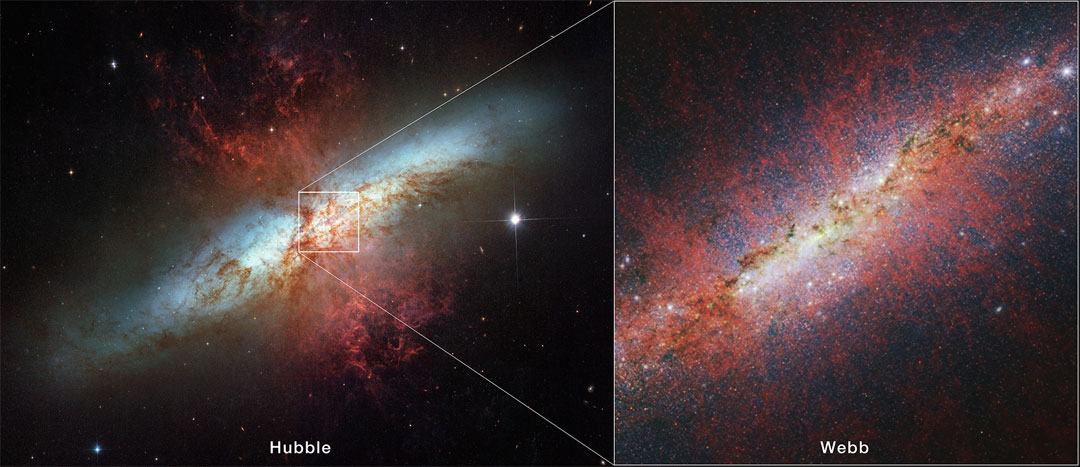
|
| Original url: https://apod.nasa.gov/apod/ap240415.html |
|
Explanation: Something strange happened to this galaxy, but what? Known as the Cigar Galaxy and cataloged as M82 , red glowing gas and dust are being cast out from the center. Although this starburst galaxy was surely stirred up by a recent pass near its neighbor , large spiral galaxy M81 , this doesn't fully explain the source of the red-glowing outwardly expanding gas and dust . Evidence indicates that this material is being driven out by the combined emerging particle winds of many stars, together creating a galactic superwind . In the featured images , a Hubble Space Telescope image in visible light is shown on the left, while a James Webb Space Telescope image of the central region in infrared light is shown on the right. Detailed inspection of the new Webb image shows, unexpectedly, that this red-glowing dust is associated with hot plasma . Research into the nature of this strange nearby galaxy will surely continue. |
2024/04/13
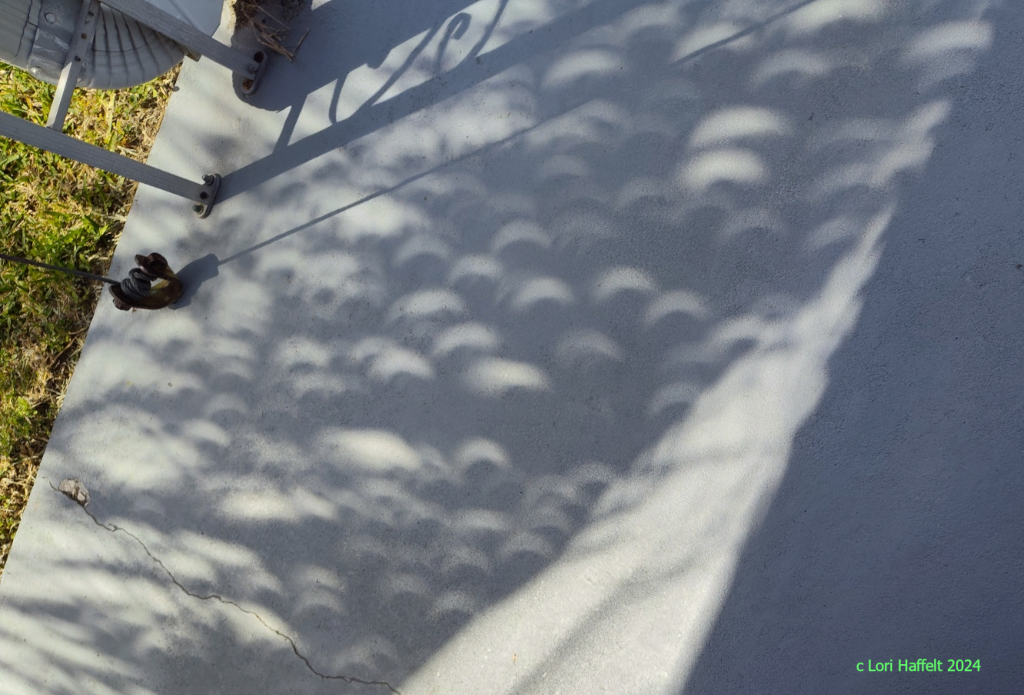
|
| Original url: https://apod.nasa.gov/apod/ap240414.html |
|
Explanation: Only those along the narrow track of the Moon's shadow on April 8 saw a total solar eclipse. But most of North America still saw a partial eclipse of the Sun. From Clearwater, Florida, USA this single snapshot captured multiple images of that more widely viewed celestial event without observing the Sun directly. In the shade of a palm tree, criss-crossing fronds are projecting recognizable eclipse images on the ground, pinhole camera style . In Clearwater the maximum eclipse phase was about 53 percent. |
2024/04/12
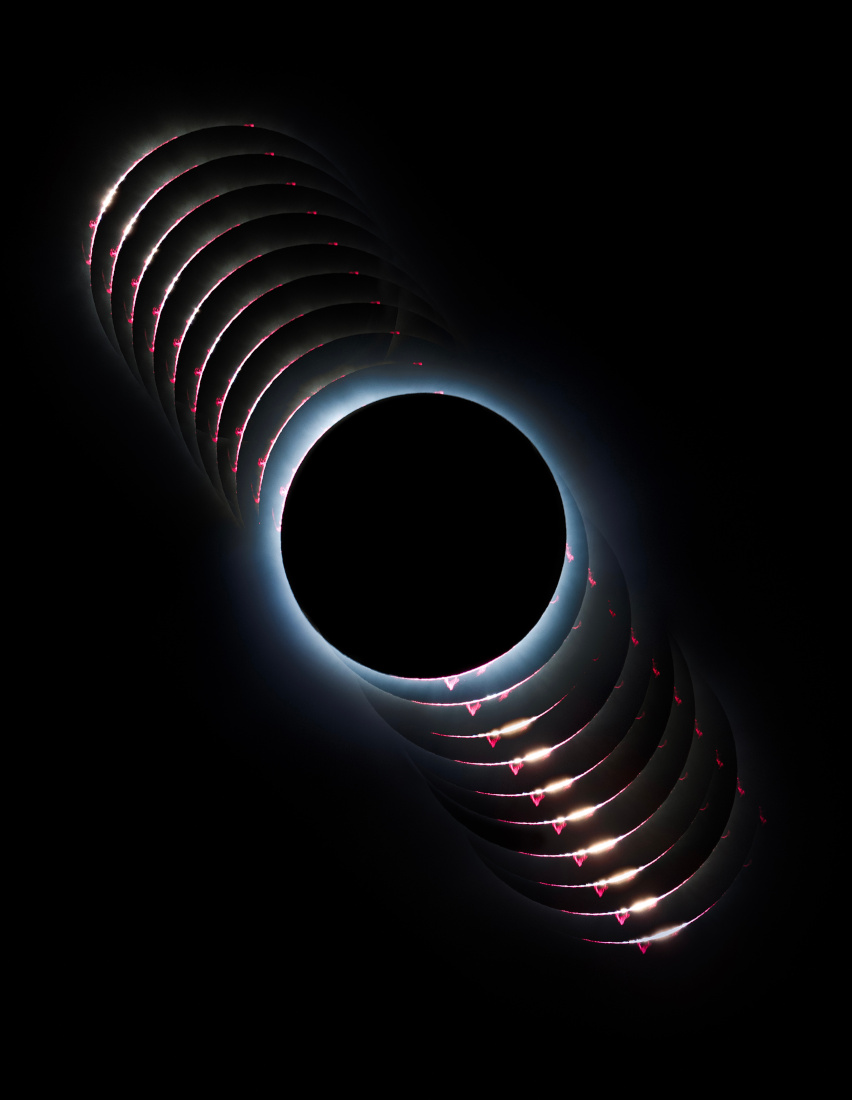
|
| Original url: https://apod.nasa.gov/apod/ap240412.html |
|
Explanation: Baily's beads often appear at the boundaries of the total phase of an eclipse of the Sun. Pearls of sunlight still beaming through gaps in the rugged terrain along the lunar limb silhouette, their appearance is recorded in this dramatic timelapse composite. The series of images follows the Moon's edge from beginning through the end of totality during April 8's solar eclipse from Durango, Mexico . They also capture pinkish prominences of plasma arcing high above the edge of the active Sun. One of the first places in North America visited by the Moon's shadow on April 8, totality in Durango lasted about 3 minutes and 46 seconds. |
2024/04/11
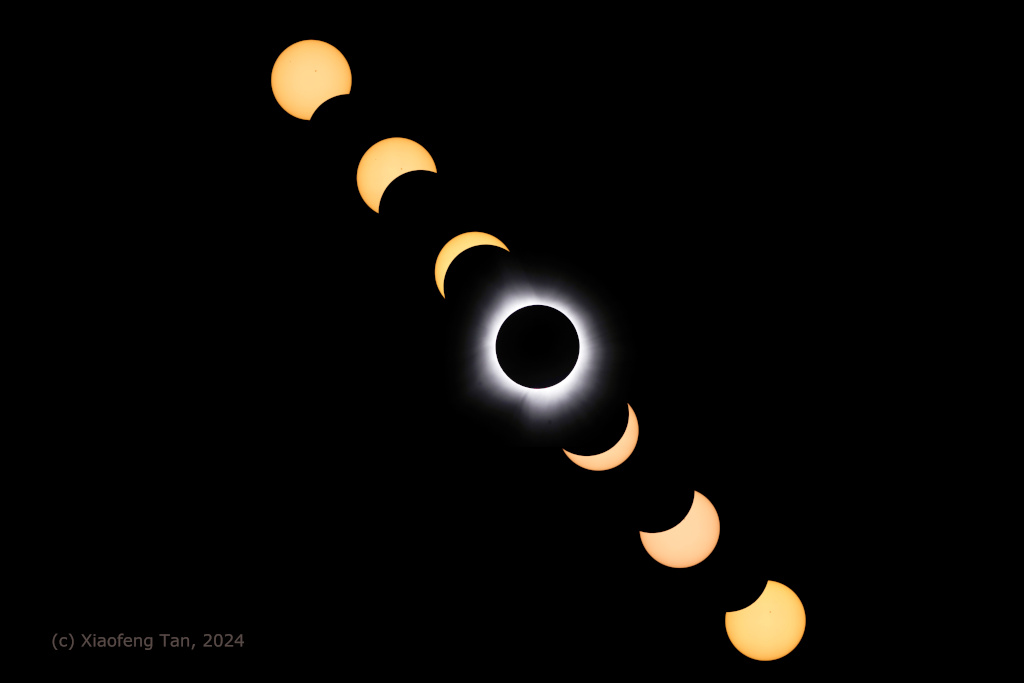
|
| Original url: https://apod.nasa.gov/apod/ap240411.html |
|
Explanation: Start at the upper left above and you can follow the progress of April 8's total eclipse of the Sun in seven sharp, separate exposures. The image sequence was recorded with a telescope and camera located within the narrow path of totality as the Moon's shadow swept across Newport, Vermont, USA. At center is a spectacular view of the solar corona . The tenuous outer atmosphere of the Sun is only easily visible to the eye in clear dark skies during the total eclipse phase. Seen from Newport , the total phase for this solar eclipse lasted about 3 minutes and 26 seconds. |
2024/04/10
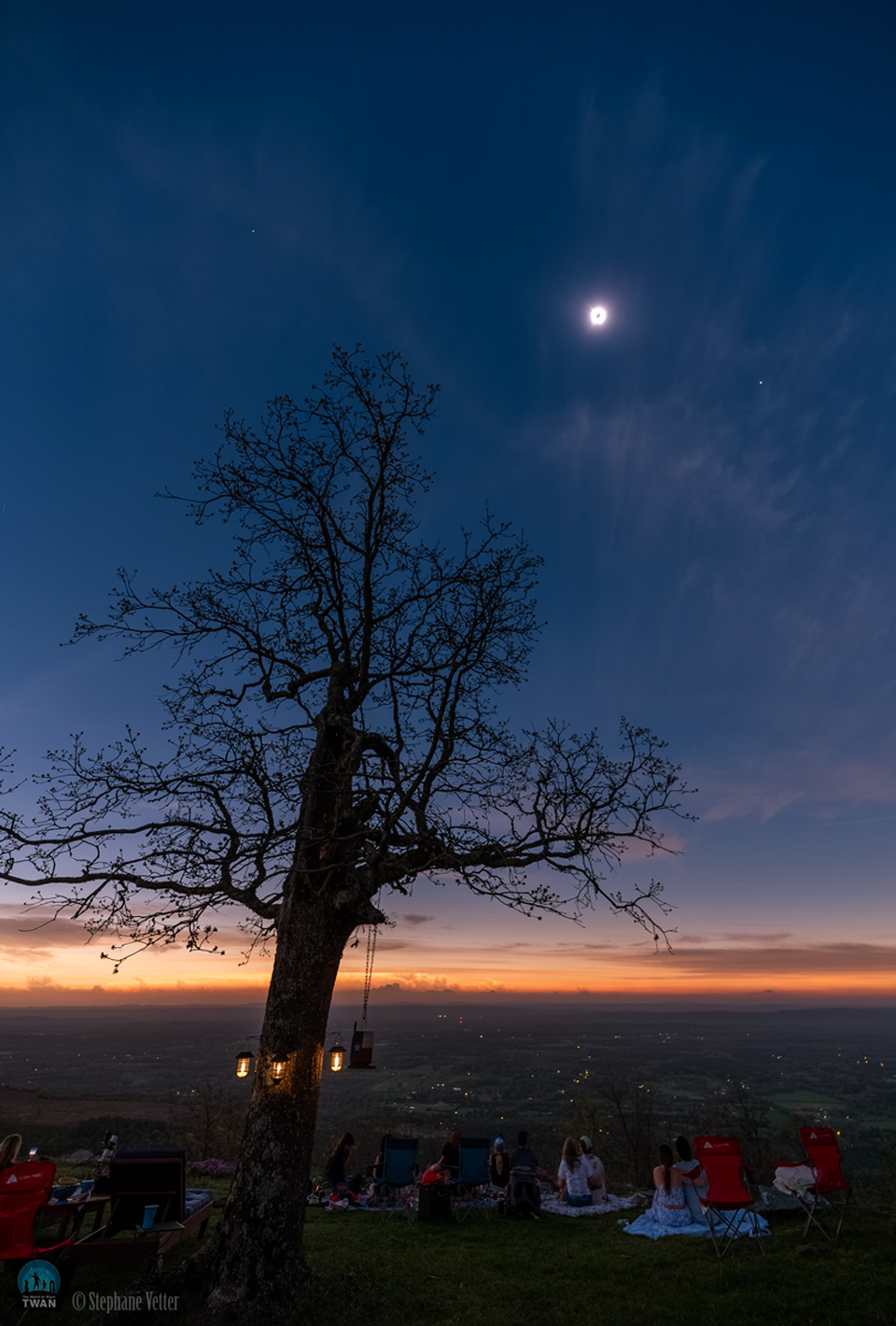
|
| Original url: https://apod.nasa.gov/apod/ap240410.html |
|
Explanation: What wonders appear when the Moon blocks the Sun? For many eager observers of Monday’s total eclipse of the Sun, the suddenly dark sky included the expected corona and two (perhaps surprise) planets: Venus and Jupiter . Normally, in recent days, Venus is visible only in the morning when the Sun and Jupiter are below the horizon, while Jupiter appears bright only in the evening. On Monday, though, for well-placed observers, both planets became easily visible during the day right in line with the totally eclipsed Sun . This line was captured Monday afternoon in the featured image from Mount Nebo , Arkansas , USA , along with a line of curious observers — and a picturesque tree . |
2024/04/09

|
| Original url: https://apod.nasa.gov/apod/ap240409.html |
|
Explanation: Captured in this snapshot, the shadow of the Moon came to Lake Magog, Quebec, North America, planet Earth on April 8. For the lakeside eclipse chasers, the much anticipated total solar eclipse was a spectacle to behold in briefly dark, but clear skies. Of course Lake Magog was one of the last places to be visited by the Moon's shadow. The narrow path of totality for the 2024 total solar eclipse swept from Mexico's Pacific Coast north and eastward through the US and Canada. But a partial eclipse was visible across the entire North American continent. |
2024/04/08

|
| Original url: https://apod.nasa.gov/apod/ap240408.html |
|
Explanation: How does a comet tail change? It depends on the comet. The ion tail of Comet 12P/Pons–Brooks has been changing markedly, as detailed in the featured image sequenced over nine days from March 6 to 14 (top to bottom). On some days, the comet's ion tail was relatively long and complex, but not every day. Reasons for tail changes include the rate of ejection of material from the comet's nucleus , the strength and complexity of the passing solar wind , and the rotation rate of the comet . Over the course of a week, apparent changes even include a change of perspective from the Earth. In general, a comet's ion tail will point away from the Sun , as gas expelled is pushed out by the Sun's wind . Today, Pons-Brooks may become a rare comet suddenly visible in the middle of the day for those able to see the Sun totally eclipsed by the Moon . |
2024/04/07
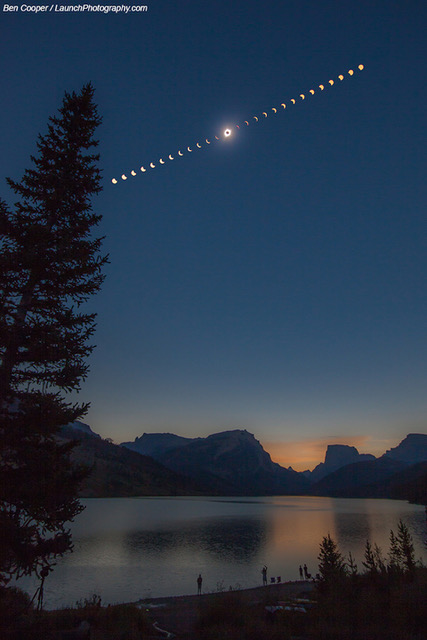
|
| Original url: https://apod.nasa.gov/apod/ap240407.html |
|
Explanation: Will the sky be clear enough to see the eclipse? This question is already on the minds of many North Americans hoping to see tomorrow's solar eclipse . This question was also on the mind of many people attempting to see the total solar eclipse that crossed North America in August 2017 . Then, the path of total darkness shot across the mainland of the USA from coast to coast , from Oregon to South Carolina -- but, like tomorrow's event, a partial eclipse occurred above most of North America . Unfortunately, in 2017, many locations saw predominantly clouds . One location that did not was a bank of the Green River Lakes , Wyoming . Intermittent clouds were far enough away to allow the center image of the featured composite sequence to be taken, an image that shows the corona of the Sun extending out past the central dark Moon that blocks our familiar Sun . The surrounding images show the partial phase s of the solar eclipse both before and after totality. |
2024/04/06
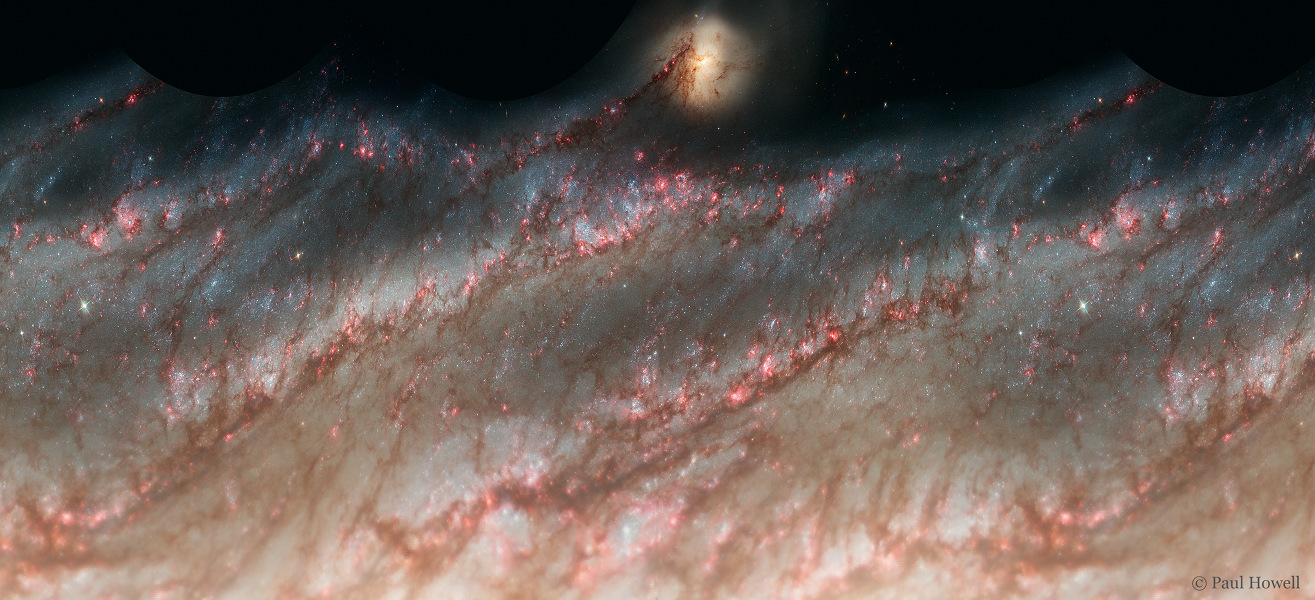
|
| Original url: https://apod.nasa.gov/apod/ap240406.html |
|
Explanation: The arms of a grand design spiral galaxy 60,000 light-years across are unwound in this digital transformation of the magnificent 2005 Hubble Space Telescope portrait of M51 . In fact, M51 is one of the original spiral nebulae, its winding arms described by a mathematical curve known as a logarithmic spiral , a spiral whose separation grows in a geometric way with increasing distance from the center. Applying logarithms to shift the pixel coordinates in the Hubble image relative to the center of M51 maps the galaxy's spiral arms into diagonal straight lines. The transformed image dramatically shows the arms themselves are traced by star formation, lined with pinkish starforming regions and young blue star clusters. Companion galaxy NGC 5195 (top) seems to alter the track of the arm in front of it though, and itself remains relatively unaffected by this unwinding of M51. Also known as the spira mirabilis , logarthimic spirals can be found in nature on all scales. For example, logarithmic spirals can also describe hurricanes , the tracks of subatomic particles in a bubble chamber and, of course, cauliflower . |
2024/04/05
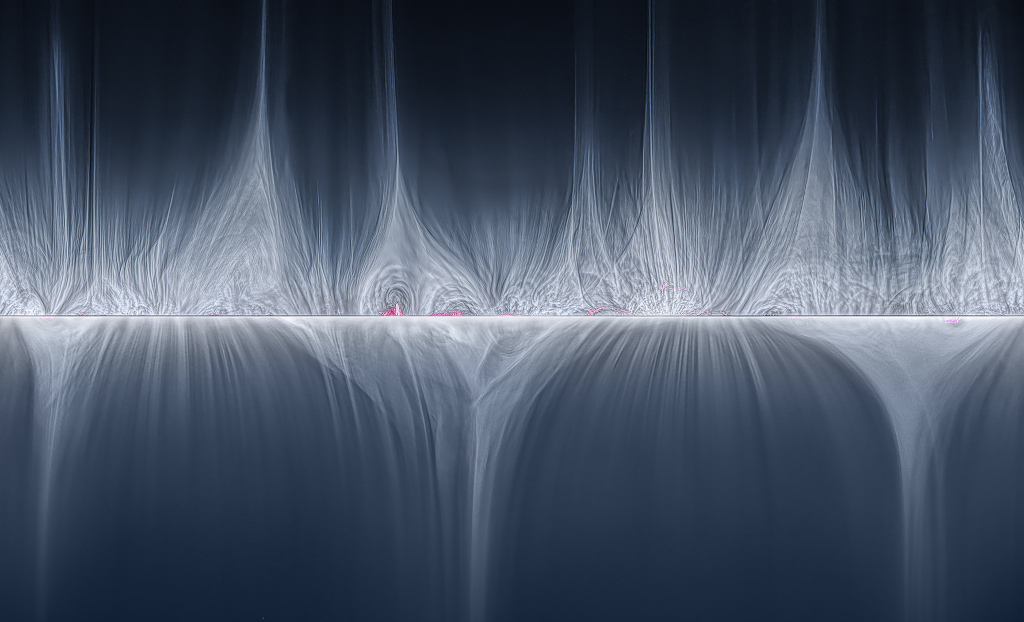
|
| Original url: https://apod.nasa.gov/apod/ap240405.html |
|
Explanation: Changes in the alluring solar corona are detailed in this creative composite image mapping the dynamic outer atmosphere of the Sun during two separate total solar eclipses. Unwrapped from the complete circle of the eclipsed Sun's edge to a rectangle and mirrored, the entire solar corona is shown during the 2017 eclipse (bottom) seen from Jackson Hole, Wyoming, and the 2023 eclipse from Exmouth, Western Australia. While the 2017 eclipse was near a minimum in the Sun's 11 year activity cycle , the 2023 eclipse was closer to solar maximum. The 2023 solar corona hints at the dramatically different character of the active Sun, with many streamers and pinkish prominences arising along the solar limb. Of course, the solar corona is only easily visible to the eye while standing in the shadow of the Moon. |
2024/04/04
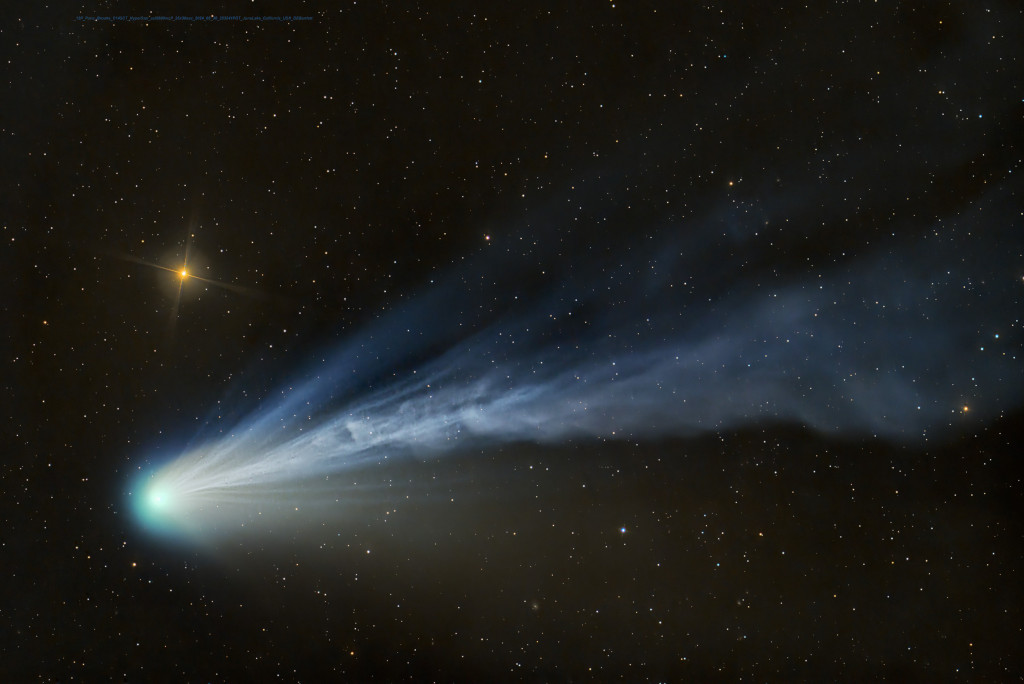
|
| Original url: https://apod.nasa.gov/apod/ap240404.html |
|
Explanation: In dark evening skies over June Lake , northern hemisphere, planet Earth, Comet 12P/Pons-Brooks stood just above the western horizon on March 30. Its twisted turbulent ion tail and diffuse greenish coma are captured in this two degree wide telescopic field of view along with bright yellowish star Hamal also known as Alpha Arietis . Now Pons-Brooks has moved out of the northern night though, approaching perihelion on April 21. On April 8 you might still spot the comet in daytime skies. But to do it, you will have to stand in the path of totality and look away from the spectacle of an alluring solar corona and totally eclipsed Sun. |
2024/04/03
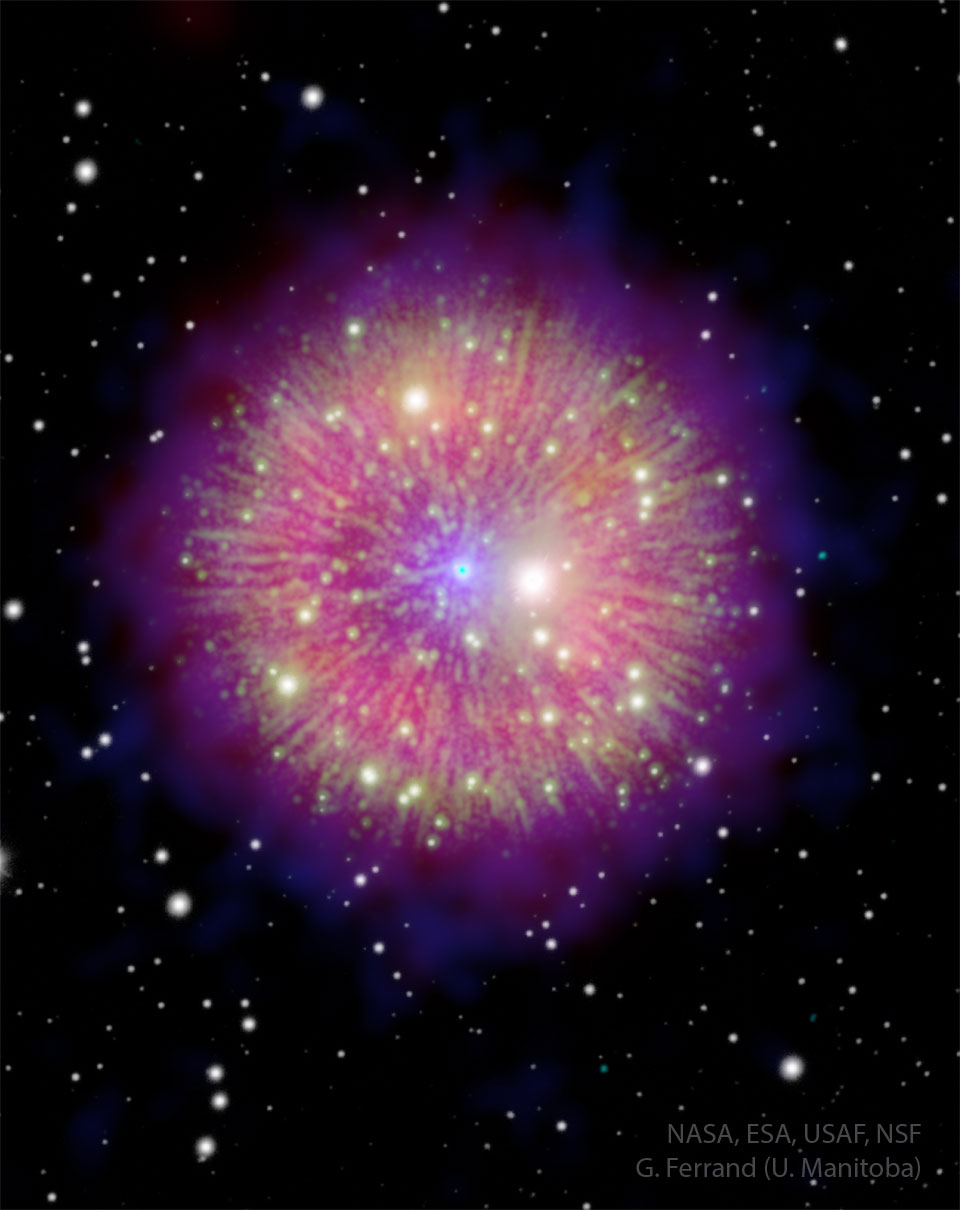
|
| Original url: https://apod.nasa.gov/apod/ap240403.html |
|
Explanation: What created this unusual celestial firework? The nebula, dubbed Pa 30 , appears in the same sky direction now as a bright " guest star " did in the year 1181 . Although Pa 30's filaments look similar to that created by a nova (for example GK Per ), and a planetary nebula (for example NGC 6751 ), some astronomers now propose that it was created by a rare type of supernova : a thermonuclear Type Iax, and so is (also) named SN 1181 . In this model , the supernova was not the result of the detonation of a single star, but rather a blast that occurred when two white dwarf stars spiraled together and merged. The blue dot in the center is hypothesized to be a zombie star , the remnant white dwarf that somehow survived this supernova -level explosion. The featured image combines images and data obtained with infrared ( WISE ), visible ( MDM , Pan-STARRS ), and X-ray ( Chandra , XMM ) telescopes. Future observations and analyses may tell us more . |
2024/04/02
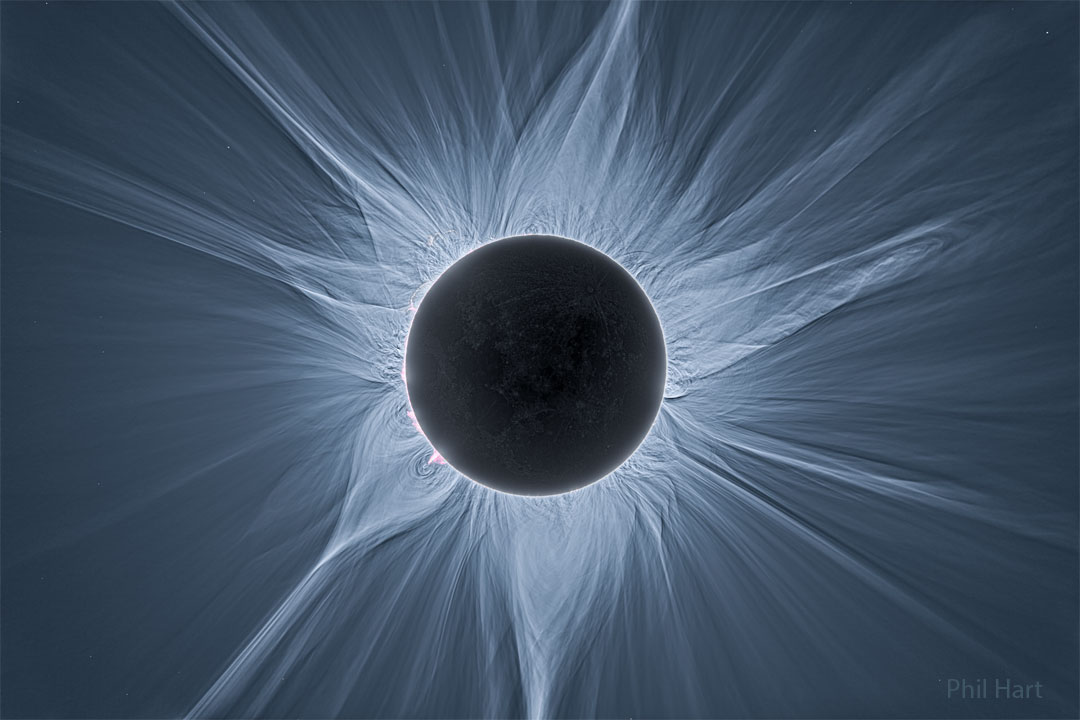
|
| Original url: https://apod.nasa.gov/apod/ap240402.html |
|
Explanation: Only in the fleeting darkness of a total solar eclipse is the light of the solar corona easily visible. Normally overwhelmed by the bright solar disk, the expansive corona , the sun's outer atmosphere , is an alluring sight. But the subtle details and extreme ranges in the corona's brightness, although discernible to the eye, are notoriously difficult to photograph. Pictured here , however, using multiple images and digital processing, is a detailed image of the Sun's corona taken during the April 20, 2023 total solar eclipse from Exmouth , Australia. Clearly visible are intricate layers and glowing caustics of an ever changing mixture of hot gas and magnetic fields . Bright looping prominences appear pink just around the Sun's limb . A similar solar corona might be visible through clear skies in a narrow swath across the North America during the total solar eclipse that occurs just six days from today |
2024/04/01
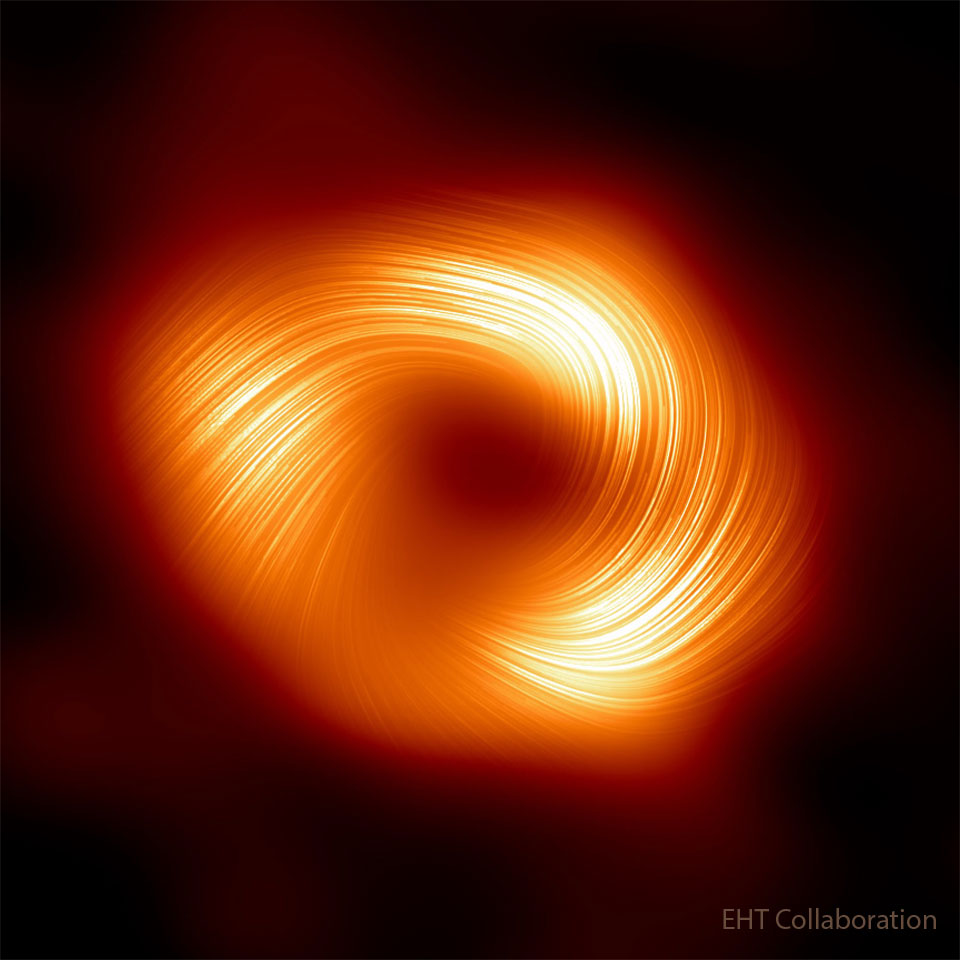
|
| Original url: https://apod.nasa.gov/apod/ap240401.html |
|
Explanation: What's happening to the big black hole in the center of our galaxy? It is sucking in matter from a swirling disk -- a disk that is magnetized , it has now been confirmed. Specifically, the black hole's accretion disk has recently been seen to emit polarized light , radiation frequently associated with a magnetized source . Pictured here is a close-up of Sgr A*, our Galaxy's central black hole , taken by radio telescopes around the world participating in the Event Horizon Telescope (EHT) Collaboration . Superposed are illustrative curved lines indicating polarized light likely emitted from swirling magnetized gas that will soon fall into the 4+ million mass central black hole . The central part of this image is likely dark because little light-emitting gas is visible between us and the dark event horizon of the black hole. Continued EHT monitoring of this and M87's central black hole may yield new clues about the gravity of black holes and how infalling matter creates disks and jets . |
2024/03/31

|
| Original url: https://apod.nasa.gov/apod/ap240331.html |
|
Explanation: In late 2021 there was a total solar eclipse visible only at the end of the Earth. To capture the unusual phenomenon , airplanes took flight below the clouded seascape of Southern Ocean . The featured image shows one relatively spectacular capture where the bright spot is the outer corona of the Sun and the eclipsing Moon is seen as the dark spot in the center. A wing and engine of the airplane are visible across the left and bottom of the image, while another airplane observing the eclipse is visible on the far left. The dark area of the sky surrounding the eclipsed Sun is called a shadow cone . It is dark because you are looking down a long corridor of air shadowed by the Moon. A careful inspection of the eclipsed Sun will reveal the planet Mercury just to the right. You won't have to travel to the end of the Earth to see the next total solar eclipse . The total eclipse path will cross North America on 2024 April 8 , just over one week from today. |
2024/03/29
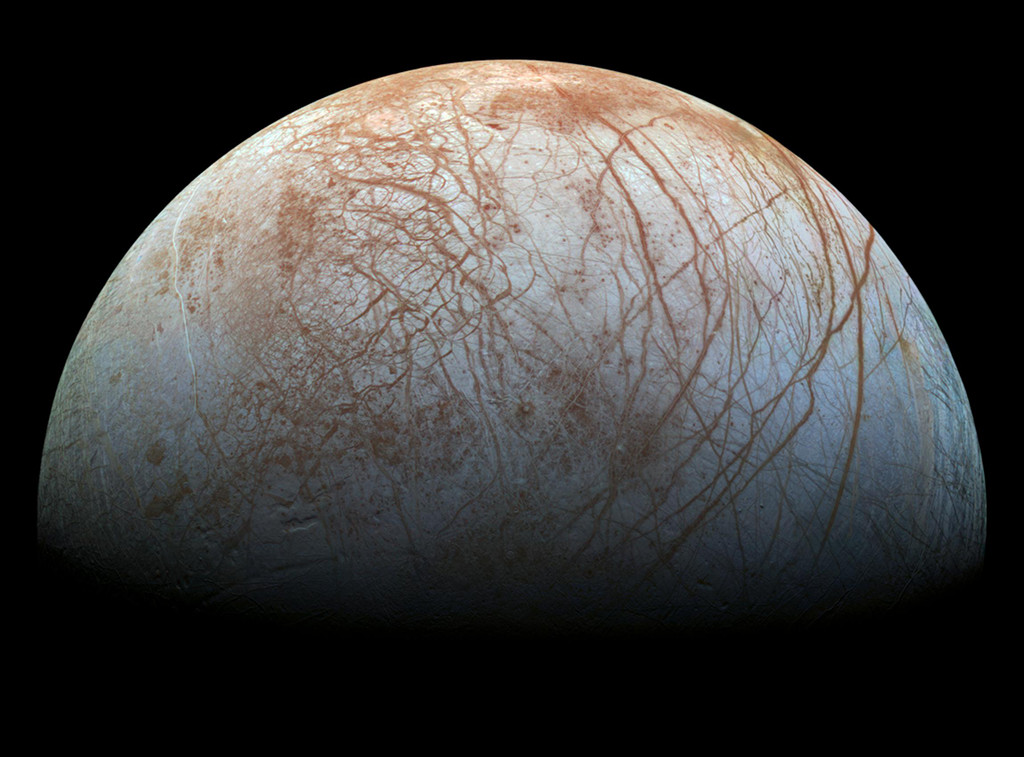
|
| Original url: https://apod.nasa.gov/apod/ap240330.html |
|
Explanation: Looping through the Jovian system in the late 1990s, the Galileo spacecraft recorded stunning views of Europa and uncovered evidence that the moon's icy surface likely hides a deep, global ocean. Galileo's Europa image data has been remastered here , with improved calibrations to produce a color image approximating what the human eye might see. Europa's long curving fractures hint at the subsurface liquid water . The tidal flexing the large moon experiences in its elliptical orbit around Jupiter supplies the energy to keep the ocean liquid. But more tantalizing is the possibility that even in the absence of sunlight that process could also supply the energy to support life, making Europa one of the best places to look for life beyond Earth. The Juno spacecraft currently in Jovian orbit has also made repeated flybys of the water world, returning images along with data exploring Europa's habitability . This October will see the launch of the NASA's Europa Clipper on a voyage of exploration . The spacecraft will make nearly 50 flybys, approaching to within 25 kilometers of Europa's icy surface. |
2024/03/28
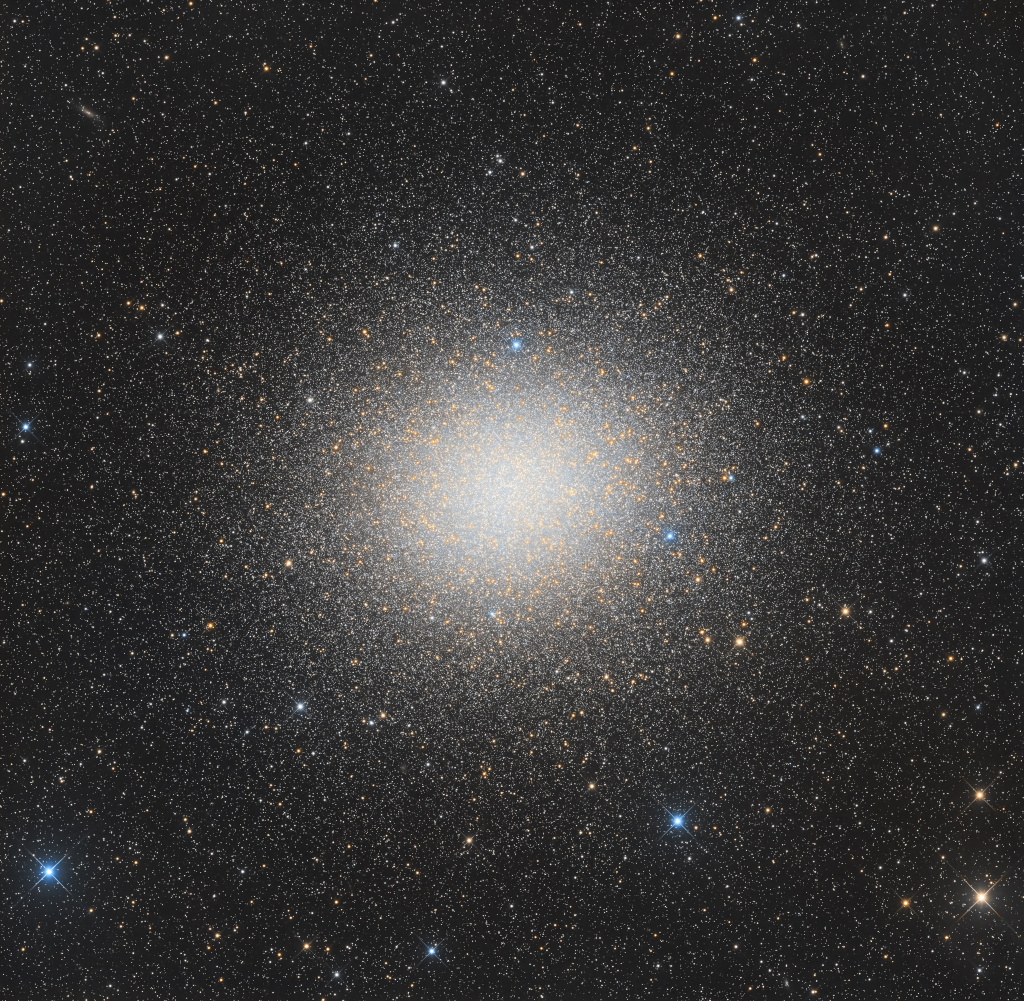
|
| Original url: https://apod.nasa.gov/apod/ap240328.html |
|
Explanation: Globular star cluster Omega Centauri , also known as NGC 5139, is 15,000 light-years away. The cluster is packed with about 10 million stars much older than the Sun within a volume about 150 light-years in diameter. It's the largest and brightest of 200 or so known globular clusters that roam the halo of our Milky Way galaxy. Though most star clusters consist of stars with the same age and composition, the enigmatic Omega Cen exhibits the presence of different stellar populations with a spread of ages and chemical abundances. In fact, Omega Cen may be the remnant core of a small galaxy merging with the Milky Way. With a yellowish hue , Omega Centauri's red giant stars are easy to pick out in this sharp, color telescopic view . |
2024/03/27
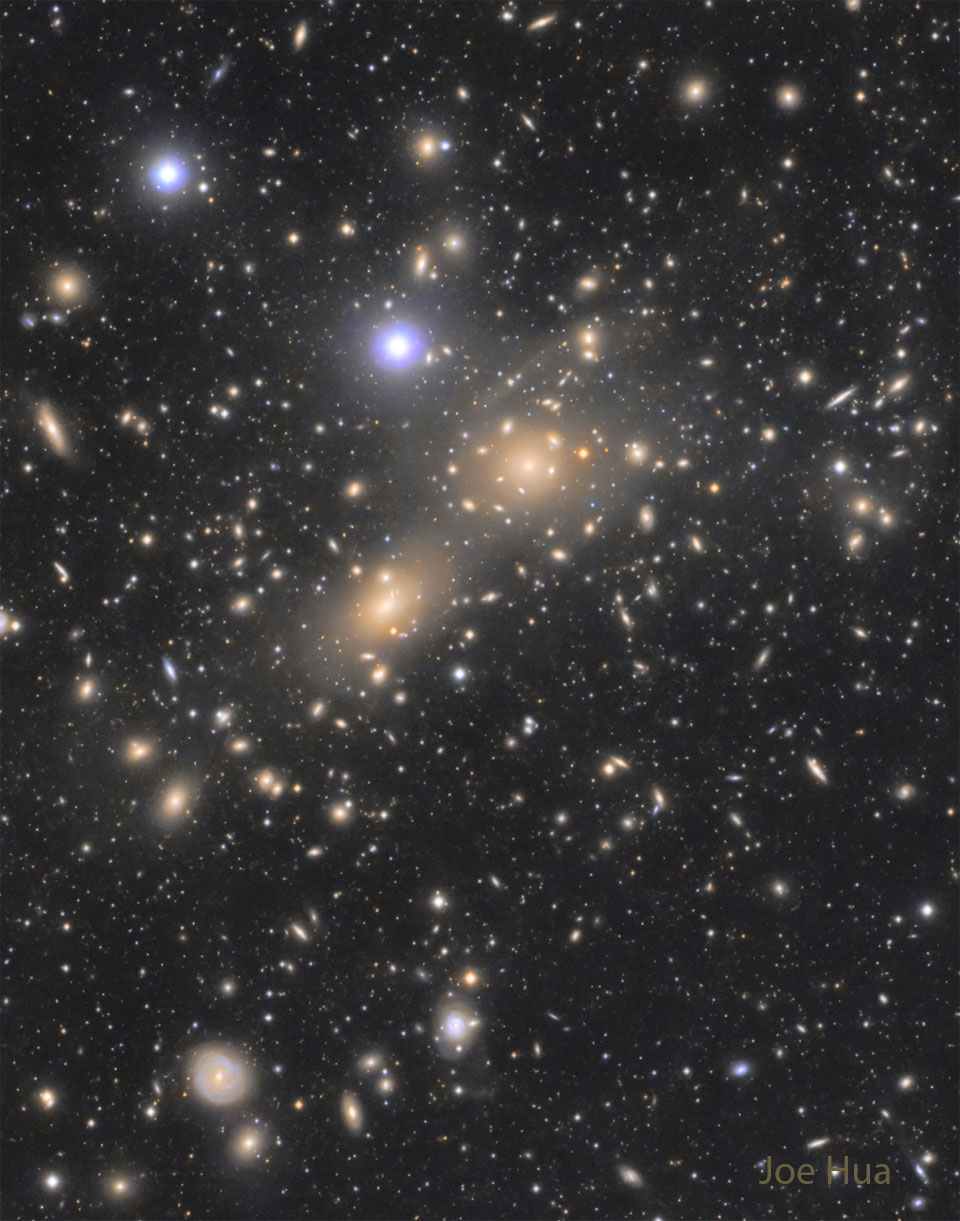
|
| Original url: https://apod.nasa.gov/apod/ap240327.html |
|
Explanation: Almost every object in the featured photograph is a galaxy. The Coma Cluster of Galaxies pictured here is one of the densest clusters known - it contains thousands of galaxies . Each of these galaxies houses billions of stars - just as our own Milky Way Galaxy does. Although nearby when compared to most other clusters , light from the Coma Cluster still takes hundreds of millions of years to reach us. In fact, the Coma Cluster is so big it takes light millions of years just to go from one side to the other. Most galaxies in Coma and other clusters are ellipticals , while most galaxies outside of clusters are spirals . The nature of Coma's X-ray emission is still being investigated . |
2024/03/26

|
| Original url: https://apod.nasa.gov/apod/ap240326.html |
|
Explanation: Comet Pons-Brooks has quite a tail to tell. First discovered in 1385 , this erupting dirty snowball loops back into our inner Solar System every 71 years and, this time, is starting to put on a show for deep camera exposures. In the featured picture , the light blue stream is the ion tail which consists of charged molecule s pushed away from the comet's nucleus by the solar wind. The ion tail, shaped by the Sun's wind and the comet's core's rotation , always points away from the Sun. Comet 12P/Pons–Brooks is now visible with binoculars in the early evening sky toward the northwest, moving perceptibly from night to night. The frequently flaring comet is expected to continue to brighten, on the average, and may even become visible with the unaided eye -- during the day -- to those in the path of totality of the coming solar eclipse on April 8 . |
2024/03/24

|
| Original url: https://apod.nasa.gov/apod/ap240325.html |
|
Explanation: Here is what the Earth looks like during a solar eclipse . The shadow of the Moon can be seen darkening part of Earth . This shadow moved across the Earth at nearly 2000 kilometers per hour. Only observers near the center of the dark circle see a total solar eclipse - others see a partial eclipse where only part of the Sun appears blocked by the Moon . This spectacular picture of the 1999 August 11 solar eclipse was one of the last ever taken from the Mir space station . The two bright spots that appear on the upper left are thought to be Jupiter and Saturn . Mir was deorbited in a controlled re-entry in 2001. A new solar eclipse will occur over North America in about two weeks. |
2024/03/23
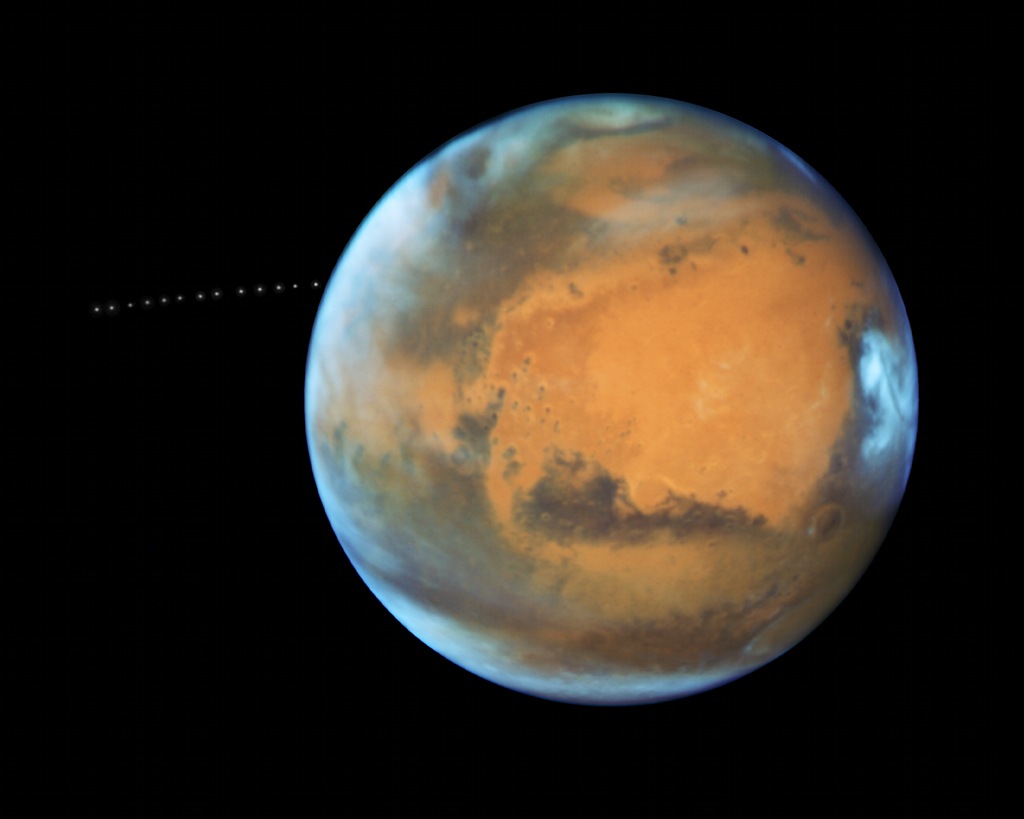
|
| Original url: https://apod.nasa.gov/apod/ap240323.html |
|
Explanation: A tiny moon with a scary name , Phobos emerges from behind the Red Planet in this timelapse sequence from the Earth-orbiting Hubble Space Telescope . Over 22 minutes the 13 separate exposures were captured near the 2016 closest approach of Mars to planet Earth. Martians have to look to the west to watch Phobos rise, though. The small moon is closer to its parent planet than any other moon in the Solar System, about 3,700 miles (6,000 kilometers) above the Martian surface . It completes one orbit in just 7 hours and 39 minutes. That's faster than a Mars rotation, which corresponds to about 24 hours and 40 minutes. So on Mars, Phobos can be seen to rise above the western horizon 3 times a day. Still, Phobos is doomed . |
2024/03/22

|
| Original url: https://apod.nasa.gov/apod/ap240322.html |
|
Explanation: A tiny moon with a scary name , Phobos emerges from behind the Red Planet in this timelapse sequence from the Earth-orbiting Hubble Space Telescope . Over 22 minutes the 13 separate exposures were captured near the 2016 closest approach of Mars to planet Earth. Martians have to look to the west to watch Phobos rise, though. The small moon is closer to its parent planet than any other moon in the Solar System, about 3,700 miles (6,000 kilometers) above the Martian surface . It completes one orbit in just 7 hours and 39 minutes. That's faster than a Mars rotation, which corresponds to about 24 hours and 40 minutes. So on Mars, Phobos can be seen to rise above the western horizon 3 times a day. Still, Phobos is doomed . |
2024/03/21
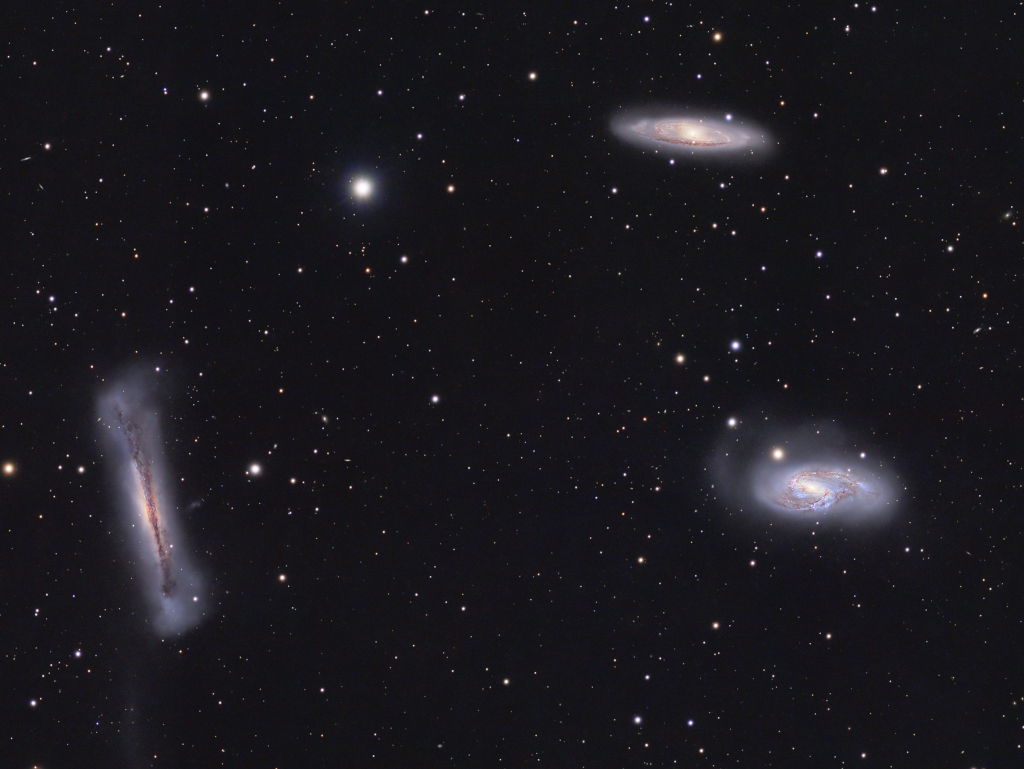
|
| Original url: https://apod.nasa.gov/apod/ap240321.html |
|
Explanation: This popular group leaps into the early evening sky around the March equinox and the northern hemisphere spring . Famous as the Leo Triplet , the three magnificent galaxies found in the prominent constellation Leo gather here in one astronomical field of view. Crowd pleasers when imaged with even modest telescopes, they can be introduced individually as NGC 3628 (left), M66 (bottom right), and M65 (top). All three are large spiral galaxies but tend to look dissimilar, because their galactic disks are tilted at different angles to our line of sight. NGC 3628 , also known as the Hamburger Galaxy, is temptingly seen edge-on, with obscuring dust lanes cutting across its puffy galactic plane. The disks of M66 and M65 are both inclined enough to show off their spiral structure. Gravitational interactions between galaxies in the group have left telltale signs, including the tidal tails and warped, inflated disk of NGC 3628 and the drawn out spiral arms of M66. This gorgeous view of the region spans over 1 degree (two full moons) on the sky in a frame that covers over half a million light-years at the trio's estimated distance of 30 million light-years. |
2024/03/20
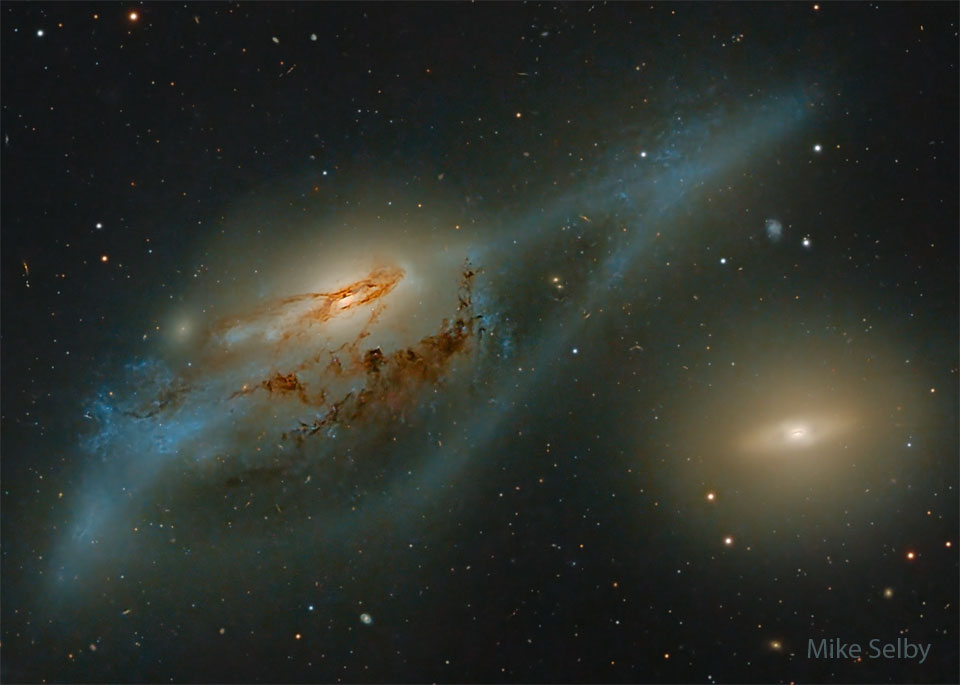
|
| Original url: https://apod.nasa.gov/apod/ap240320.html |
|
Explanation: Across the heart of the Virgo Galaxy Cluster lies a string of galaxies known as Markarian's Chain . Prominent in Markarian's Chain are these two interacting galaxies , NGC 4438 (left) and NGC 4435 - also known as The Eyes. About 50 million light-year s away, the two galaxies appear to be about 100,000 light-years apart in this sharp close-up , but have likely approached to within an estimated 16,000 light-years of each other in their cosmic past . Gravitational tides from the close encounter have ripped away at their stars, gas, and dust. The more massive NGC 4438 managed to hold on to much of the material torn out in the collision , while material from the smaller NGC 4435 was more easily lost . The remarkably deep image of this crowded region of the universe also includes many more distant background galaxies . |
2024/03/19

|
| Original url: https://apod.nasa.gov/apod/ap240319.html |
|
Explanation: What's that at the end of the road? The Sun. Many towns have roads that run east-west, and on two days each year, the Sun rises and sets right down the middle . Today, in some parts of the world (tomorrow in others), is one of those days: an equinox . Not only is this a day of equal night ("aequus"-"nox") and day time, but also a day when the sun rises precisely to the east and sets due west. Displayed here is a picturesque rural road in Alberta , Canada that runs approximately east-west. The featured image was taken during the September Equinox of 2021, but the geometry remains the same every year. In many cultures, this March equinox is taken to be the first day of a season, typically spring in Earth's northern hemisphere , and autumn in the south . Does your favorite street run east-west? Tonight, at sunset, you can find out with a quick glance. |
2024/03/18
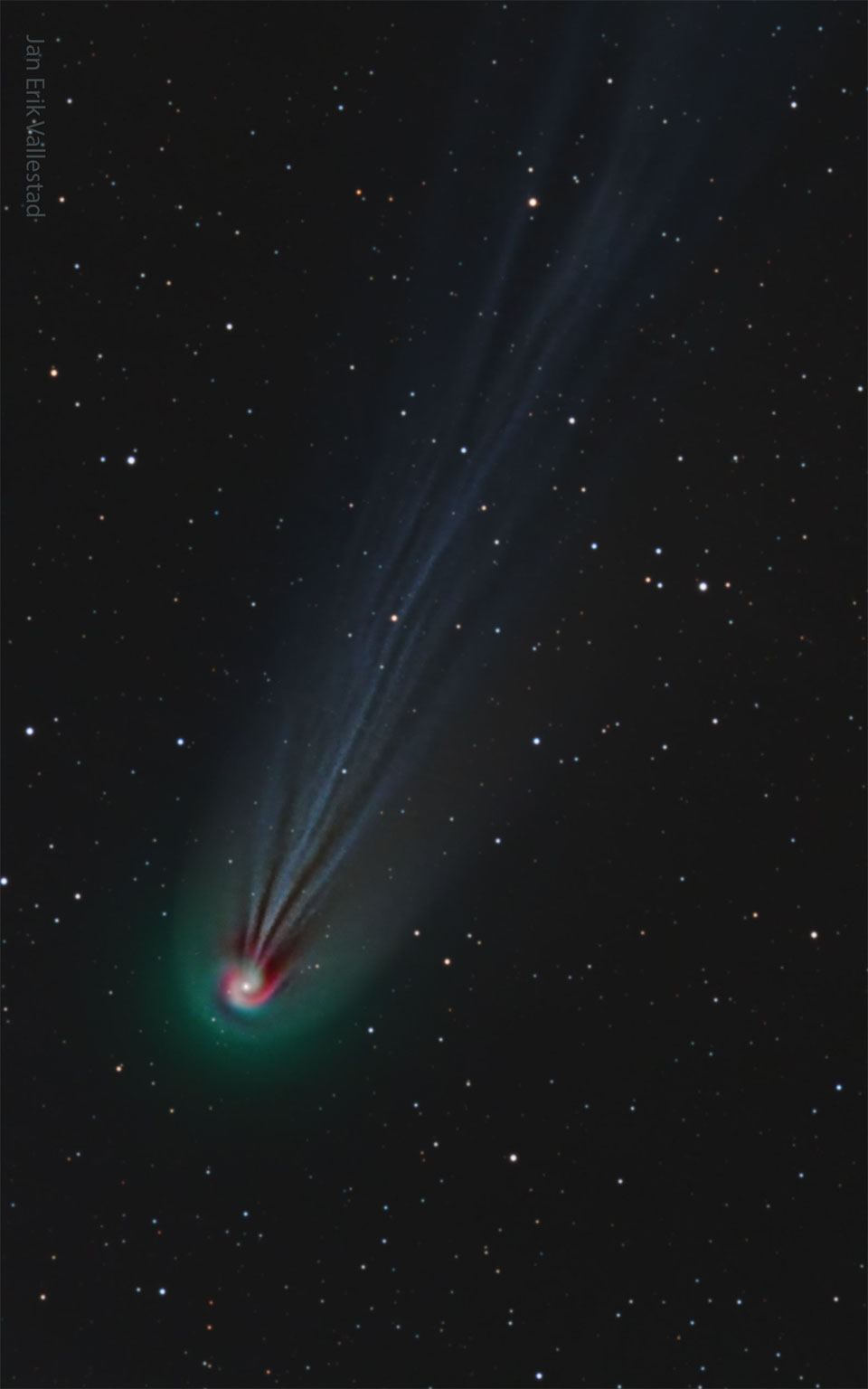
|
| Original url: https://apod.nasa.gov/apod/ap240318.html |
|
Explanation: A bright comet will be visible during next month's total solar eclipse. This very unusual coincidence occurs because Comet 12P/Pons-Brooks 's return to the inner Solar System places it by chance only 25 degrees away from the Sun during Earth's April 8 total solar eclipse . Currently the comet is just on the edge of visibility to the unaided eye, best visible with binoculars in the early evening sky toward the constellation of the Fish ( Pisces ). Comet Pons-Brooks , though, is putting on quite a show for deep camera images even now. The featured image is a composite of three very specific colors, showing the comet's ever-changing ion tail in light blue, its outer coma in green, and highlights some red-glowing gas around the coma in a spiral . The spiral is thought to be caused by gas being expelled by the slowly rotating nucleus of the giant iceberg comet. Although it is always difficult to predict the future brightness of comets, Comet Pons-Brook has been particularly prone to outbursts , making it even more difficult to predict how bright it will actually be as the Moon moves in front of the Sun on April 8 . |
2024/03/17
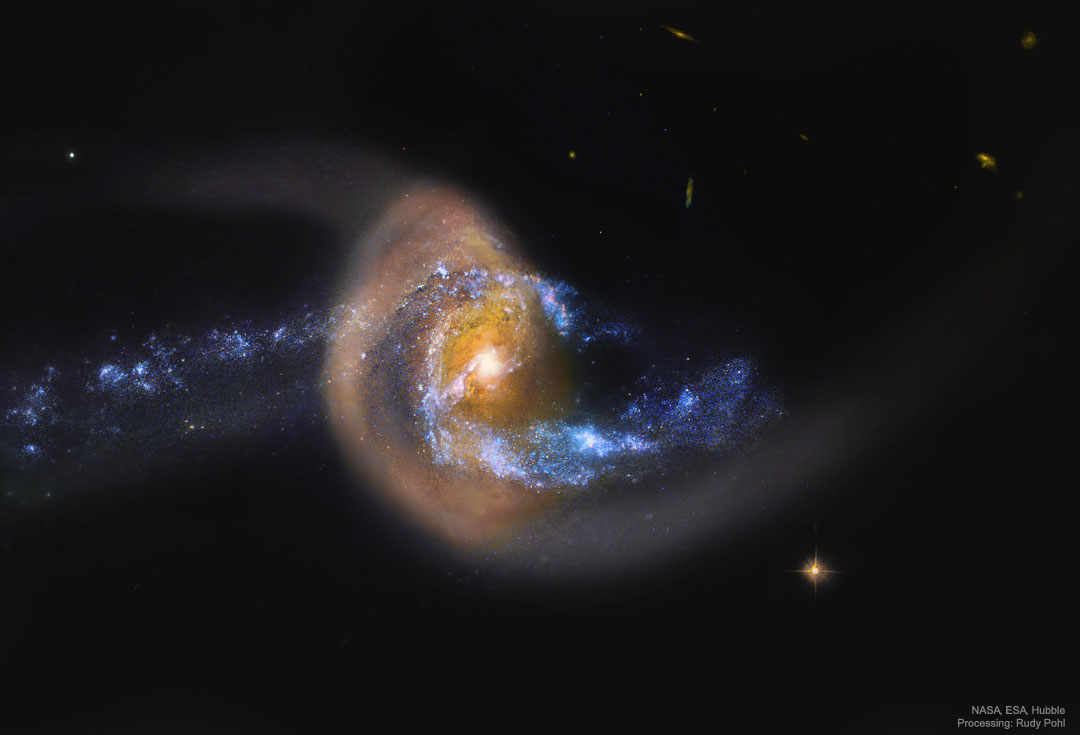
|
| Original url: https://apod.nasa.gov/apod/ap240317.html |
|
Explanation: Is this galaxy jumping through a giant ring of stars ? Probably not. Although the precise dynamics behind the featured image is yet unclear, what is clear is that the pictured galaxy, NGC 7714 , has been stretched and distorted by a recent collision with a neighboring galaxy. This smaller neighbor, NGC 7715 , situated off to the left of the frame, is thought to have charged right through NGC 7714 . Observations indicate that the golden ring pictured is composed of millions of older Sun-like stars that are likely co-moving with the interior bluer stars . In contrast, the bright center of NGC 7714 appears to be undergoing a burst of new star formation. The featured image was captured by the Hubble Space Telescope . NGC 7714 is located about 130 million light years away toward the constellation of the Two Fish ( Pisces ). The interactions between these galaxies likely started about 150 million years ago and should continue for several hundred million years more , after which a single central galaxy may result. |
2024/03/16
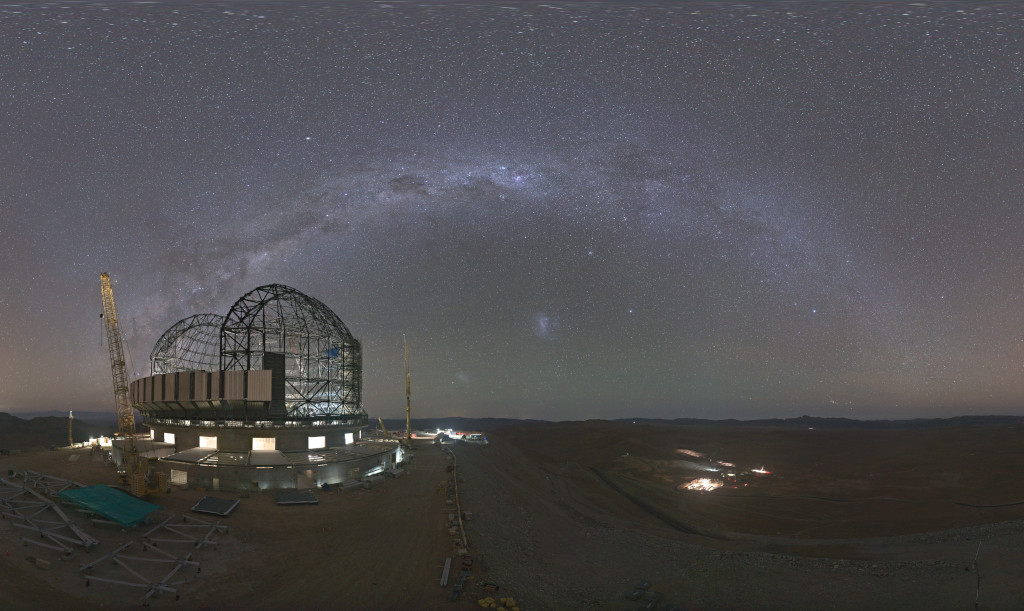
|
| Original url: https://apod.nasa.gov/apod/ap240316.html |
|
Explanation: The southern winter Milky Way sprawls across this night skyscape. Looking due south, the webcam view was recorded near local midnight on March 11 in dry, dark skies over the central Chilean Atacama desert. Seen below the graceful arc of diffuse starlight are satellite galaxies of the mighty Milky Way, also known as the Large and Small Magellanic clouds . In the foreground is the site of the European Southern Observatory's 40-metre-class Extremely Large Telescope (ELT). Under construction at the 3000 metre summit of Cerro Armazones , the ELT is on track to become planet Earth's biggest Eye on the Sky. |
2024/03/15

|
| Original url: https://apod.nasa.gov/apod/ap240315.html |
|
Explanation: Big, beautiful spiral galaxy NGC 1055 is a dominant member of a small galaxy group a mere 60 million light-years away toward the aquatically intimidating constellation Cetus . Seen edge-on, the island universe spans over 100,000 light-years, a little larger than our own Milky Way galaxy. The colorful, spiky stars decorating this cosmic portrait of NGC 1055 are in the foreground, well within the Milky Way. But the telltale pinkish star forming regions are scattered through winding dust lanes along the distant galaxy's thin disk. With a smattering of even more distant background galaxies, the deep image also reveals a boxy halo that extends far above and below the central bulge and disk of NGC 1055. The halo itself is laced with faint, narrow structures, and could represent the mixed and spread out debris from a satellite galaxy disrupted by the larger spiral some 10 billion years ago . |
2024/03/14
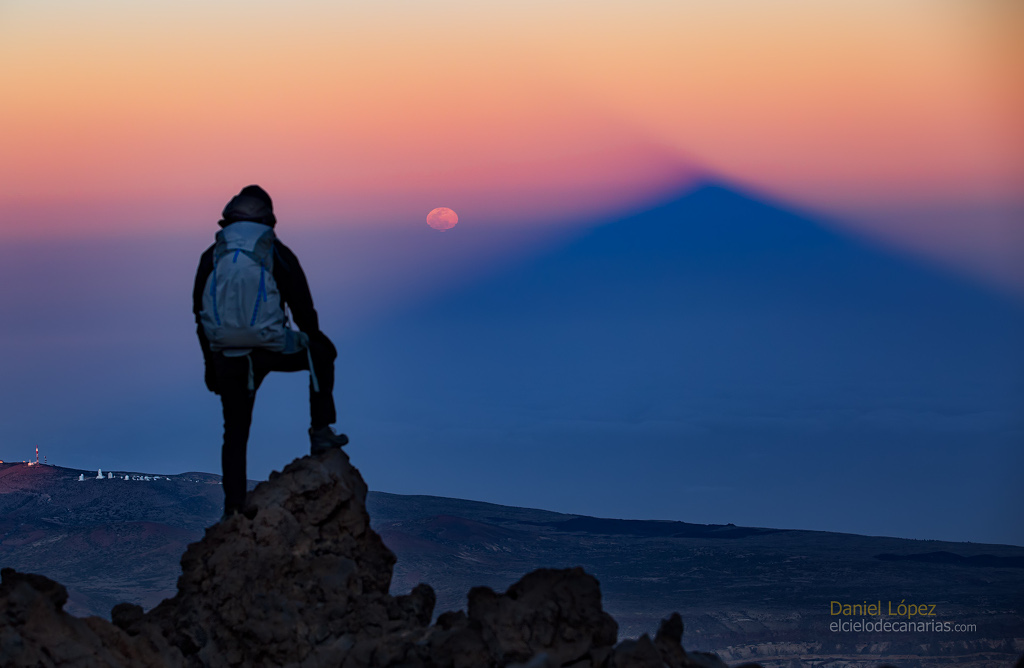
|
| Original url: https://apod.nasa.gov/apod/ap240314.html |
|
Explanation: What phase of the Moon is 3.14 radians from the Sun? The Full Moon, of course. Even though the Moon might look full for several days, the Moon is truly at its full phase when it is Pi radians (aka 180 degrees) from the Sun in ecliptic longitude. That's opposite the Sun in planet Earth's sky. Rising as the Sun set on March 9, 2020, only an hour or so after the moment of its full phase, this orange tinted and slightly flattened Moon still looked full. It was photographed opposite the setting Sun from Teide National Park on the Canary Island of Tenerife. Also opposite the setting Sun, seen from near the Teide volcano peak about 3,500 meters above sea level, is the mountain's rising triangular shadow extending into Earth's dense atmosphere. Below the distant ridge line on the left are the white telescope domes of Teide Observatory . Again Pi radians from the Sun, on March 25 the Full Moon will dim slightly as it glides through Earth's outer shadow in a penumbral lunar eclipse . |
2024/03/13
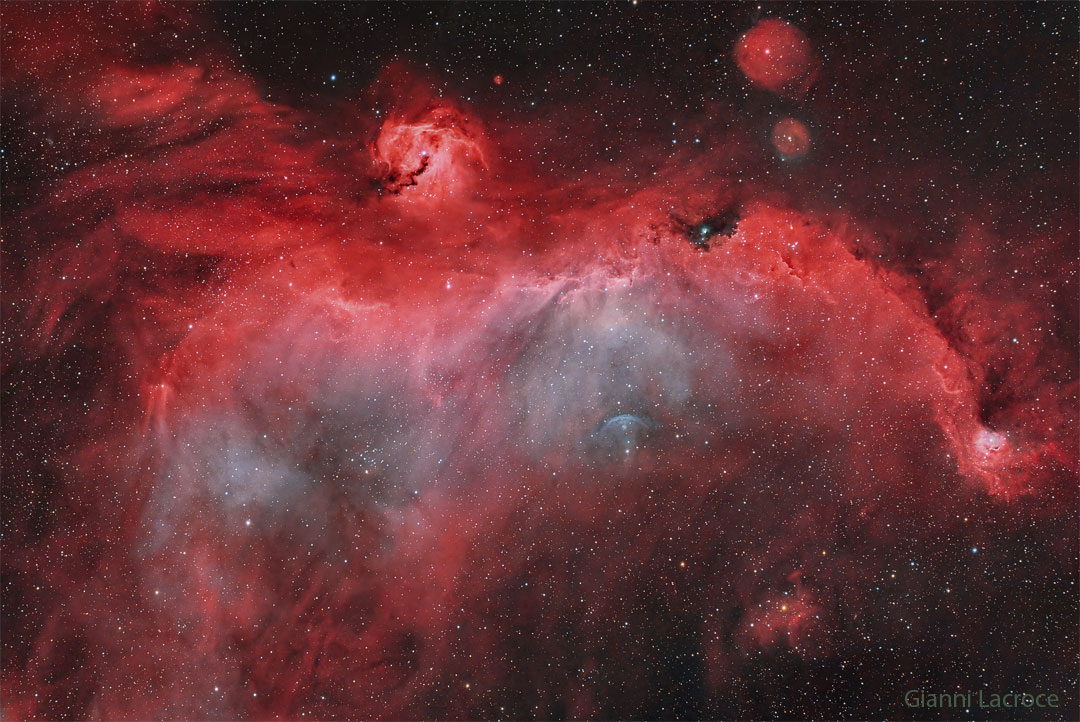
|
| Original url: https://apod.nasa.gov/apod/ap240313.html |
|
Explanation: A broad expanse of glowing gas and dust presents a bird-like visage to astronomers from planet Earth , suggesting its popular moniker: the Seagull Nebula . This portrait of the cosmic bird covers a 1.6-degree wide swath across the plane of the Milky Way, near the direction of Sirius , the alpha star of the constellation of the Big Dog ( Canis Major ). Of course, the region includes objects with other catalog designations: notably NGC 2327 , a compact, dusty emission and reflection nebula with an embedded massive star that forms the bird's head . Dominated by the reddish glow of atomic hydrogen , the complex of gas and dust clouds with bright young stars spans over 100 light-years at an estimated 3,800 light-year distance. |
2024/03/12
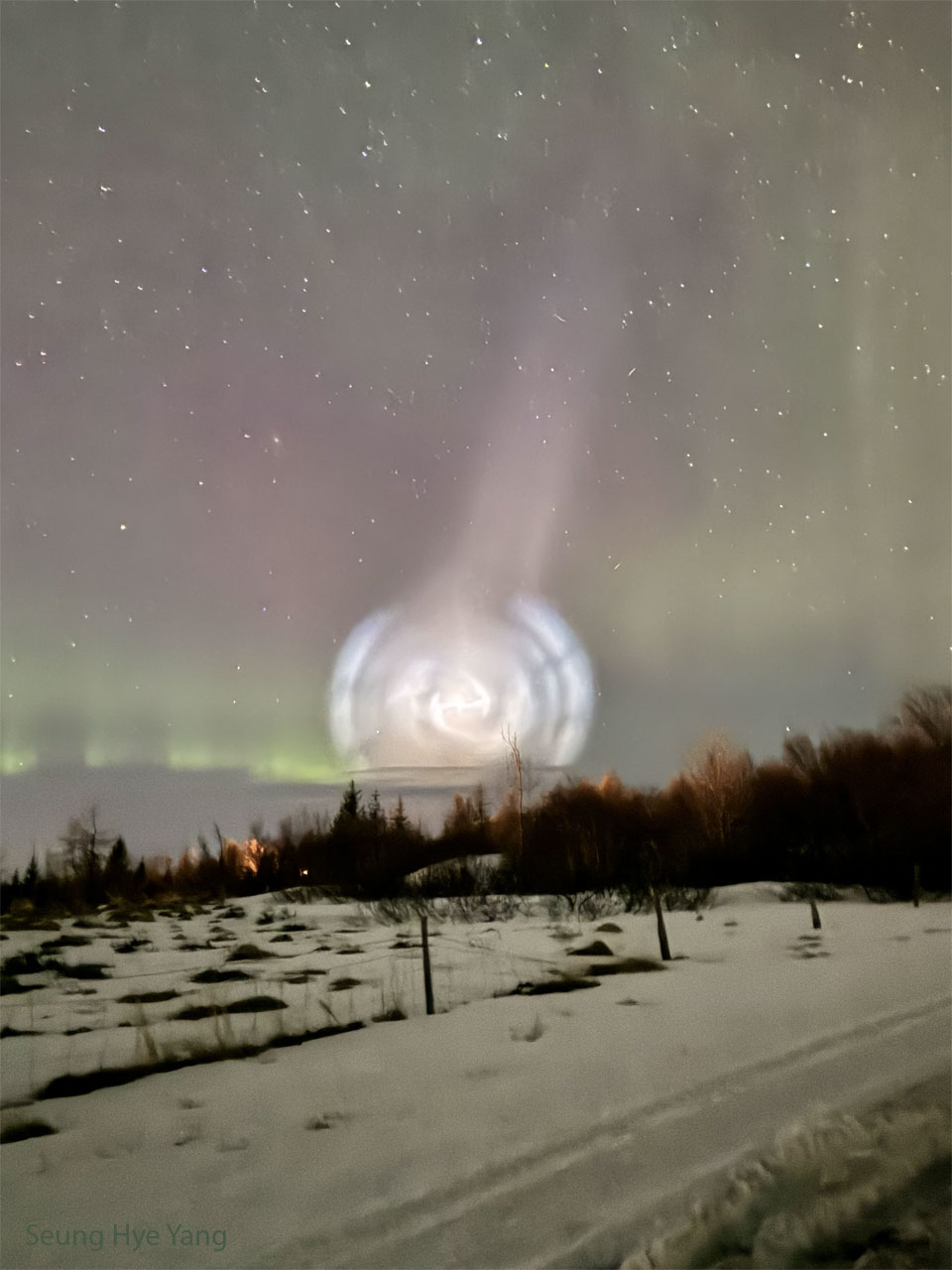
|
| Original url: https://apod.nasa.gov/apod/ap240312.html |
|
Explanation: What's that over the horizon? What may look like a strangely nearby galaxy is actually a normal rocket's exhaust plume -- but unusually backlit. Although the SpaceX Falcon 9 rocket was launched from Cape Canaveral in Florida , USA , its burned propellant was visible over a much wider area, with the featured photograph being taken from Akureyri , Iceland . The huge spaceship was lifted off a week ago, and the resulting spectacle was captured soon afterward with a single 10-second smartphone exposure, before it quickly dissipated. Like noctilucent clouds , the plume's brightness is caused by the Twilight Effect , where an object is high enough to be illuminated by the twilight Sun, even when the observer on the ground experiences the darkness of night. The spiral shape is likely caused by high winds pushing the expelled gas into the shape of a corkscrew , which, when seen along the trajectory, looks like a spiral . Stars and faint green and red aurora appear in the background of this extraordinary image. |
2024/03/11

|
| Original url: https://apod.nasa.gov/apod/ap240311.html |
|
Explanation: What glows in the night? This night featured a combination of usual and unusual glows. Perhaps the most usual glow was from the Moon , a potentially familiar object. The full Moon's nearly vertical descent results from the observer being near Earth's equator . As the Moon sets, air and aerosol s in Earth's atmosphere preferentially scatter out blue light, making the Sun-reflecting satellite appear reddish when near the horizon. Perhaps the most unusual glow was from the bioluminescent plankton , likely less familiar objects. These microscopic creatures glow blue, it is thought, primarily to surprise and deter predators . In this case, the glow was caused primarily by plankton-containing waves crashing onto the beach. The image was taken on Soneva Fushi Island , Maldives just over one year ago. |
2024/03/10

|
| Original url: https://apod.nasa.gov/apod/ap240310.html |
|
Explanation: Would you go to the end of the world to see a total eclipse of the Sun? If you did, would you be surprised to find someone else there already? In 2003, the Sun , the Moon, Antarctica, and two photographers all lined up in Antarctica during an unusual total solar eclipse . Even given the extreme location, a group of enthusiastic eclipse chasers ventured near the bottom of the world to experience the surreal momentary disappearance of the Sun behind the Moon . One of the treasures collected was the featured picture -- a composite of four separate images digitally combined to realistically simulate how the adaptive human eye saw the eclipse. As the image was taken, both the Moon and the Sun peeked together over an Antarctic ridge. In the sudden darkness , the magnificent corona of the Sun became visible around the Moon. Quite by accident, another photographer was caught in one of the images checking his video camera. Visible to his left are an equipment bag and a collapsible chair . A more easily visible solar eclipse will occur in just under four weeks and be visible from a long, thin swath of North America. |
2024/03/09
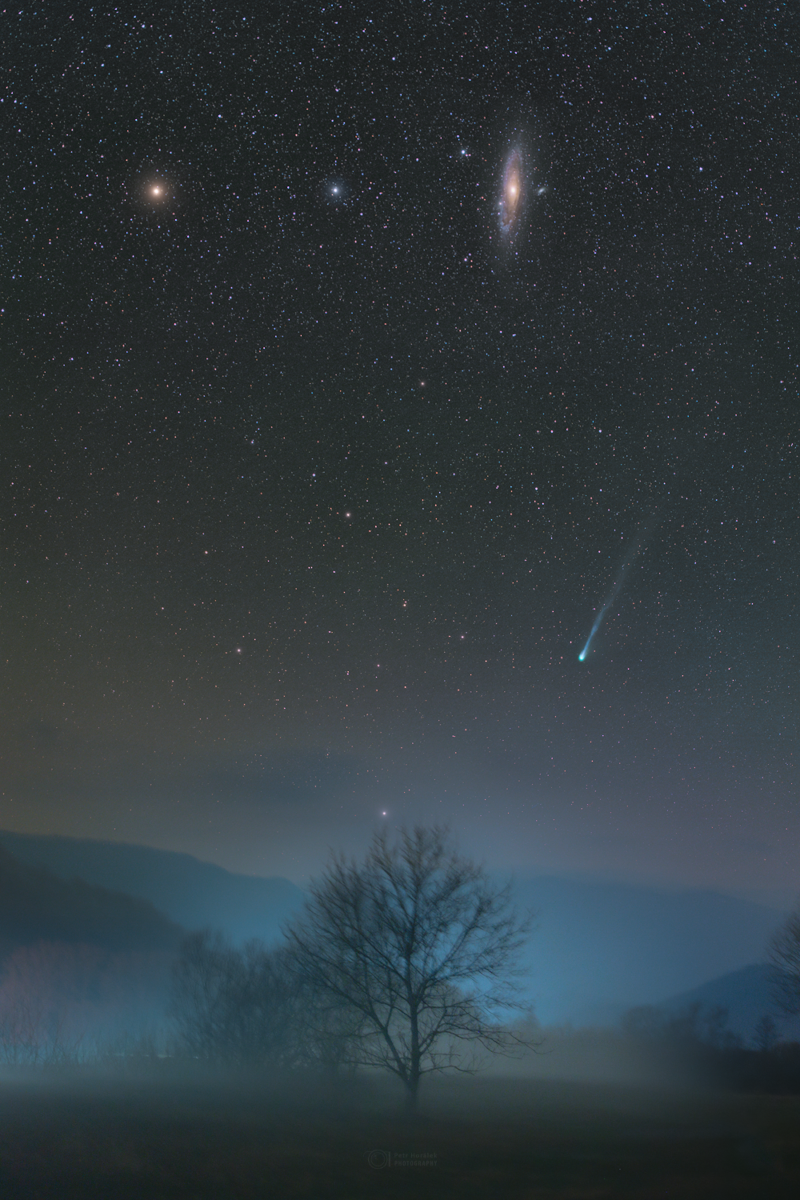
|
| Original url: https://apod.nasa.gov/apod/ap240309.html |
|
Explanation: As spring approaches for northern skygazers Comet 12P/Pons-Brooks is growing brighter. Currently visible with small telescopes and binoculars the Halley-type comet could reach naked eye visibility in the coming weeks. Seen despite a foggy atmosphere, the comet's green coma and long tail hover near the horizon, in this well-composed deep night skyscape from Revuca, Slovakia recorded on March 5. In the sky above the Halley-type comet, the Andromeda (right) and Triangulum galaxies flank bright star Mirach , beta star of the constellation Andromeda. The two spiral galaxies are members of our local galaxy group and over 2.5 million light-years distant. Comet Pons-Brooks is a periodic visitor to the inner Solar System and less than 14 light-minutes away. Reaching its perihelion on April 21, this comet should be visible in the sky during the April 8 total solar eclipse. |
2024/03/08
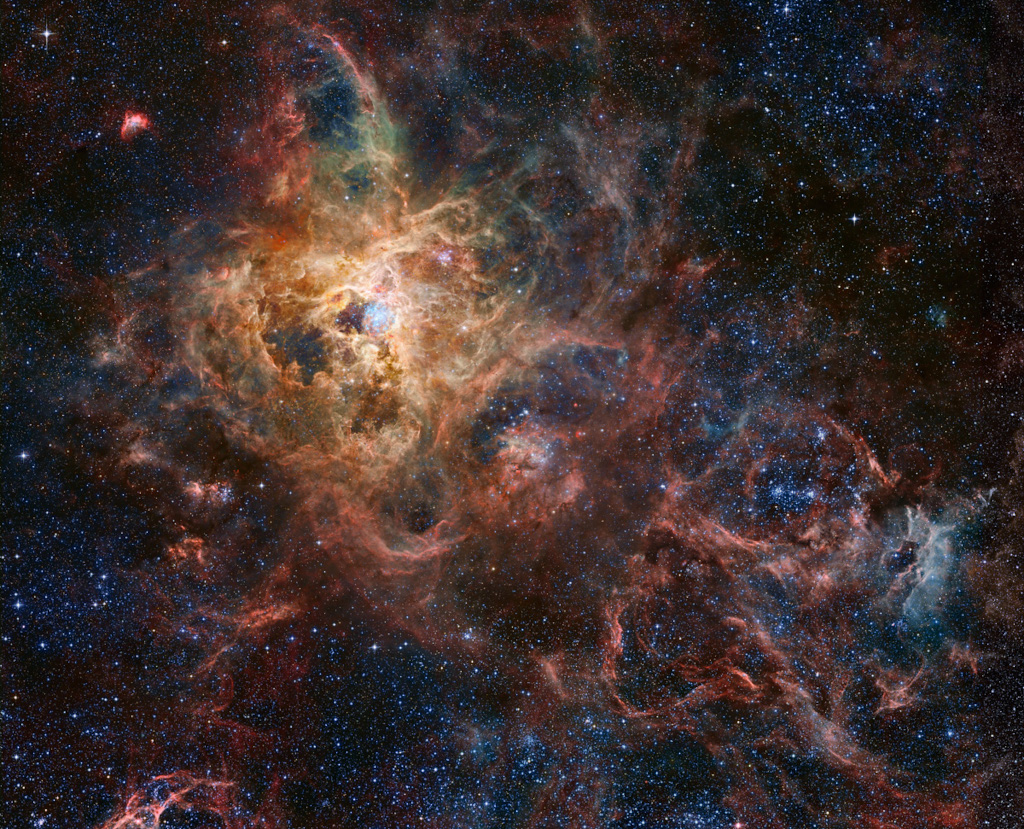
|
| Original url: https://apod.nasa.gov/apod/ap240308.html |
|
Explanation: The Tarantula Nebula , also known as 30 Doradus, is more than a thousand light-years in diameter, a giant star forming region within nearby satellite galaxy the Large Magellanic Cloud . About 180 thousand light-years away, it's the largest, most violent star forming region known in the whole Local Group of galaxies. The cosmic arachnid sprawls across this magnificent view , an assembly of image data from large space- and ground-based telescopes. Within the Tarantula (NGC 2070), intense radiation, stellar winds, and supernova shocks from the central young cluster of massive stars cataloged as R136 energize the nebular glow and shape the spidery filaments. Around the Tarantula are other star forming regions with young star clusters, filaments, and blown-out bubble-shaped clouds. In fact, the frame includes the site of the closest supernova in modern times, SN 1987A , at lower right. The rich field of view spans about 2 degrees or 4 full moons in the southern constellation Dorado . But were the Tarantula Nebula closer, say 1,500 light-years distant like the Milky Way's own star forming Orion Nebula , it would take up half the sky. |
2024/03/07
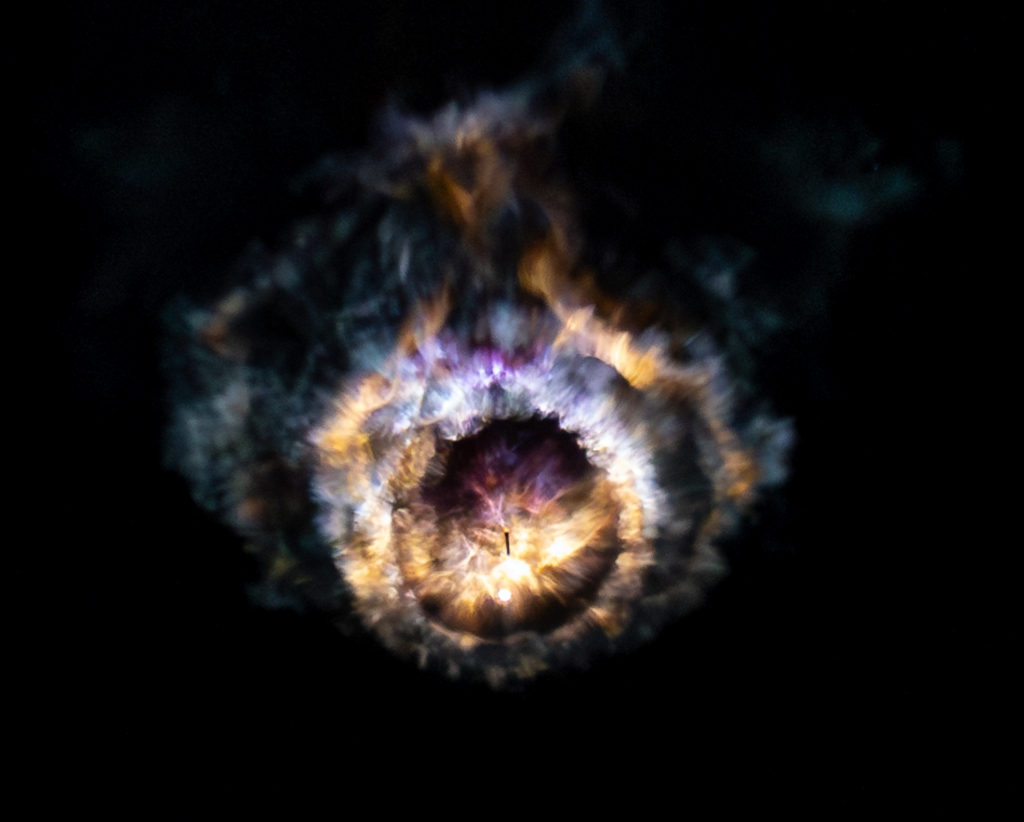
|
| Original url: https://apod.nasa.gov/apod/ap240307.html |
|
Explanation: Not the James Webb Space Telescope's latest view of a distant galactic nebula, this cloud of gas and dust dazzled spacecoast skygazers on March 3. The telephoto snapshot was taken minutes after the launch of a Falcon 9 rocket on the SpaceX Crew-8 mission , to the International Space Station. It captures plumes and exhaust from the separated first and second stage, a drifting Rorschach pattern in dark evening skies. The bright spot near bottom center within the stunning terrestrial nebulosity is the second stage engine firing to carry 4 humans to space in the Crew Dragon spacecraft Endeavour . In sharp silhouette just above it is the Falcon 9 first stage booster orienting itself for return to a landing zone at Cape Canaveral , planet Earth. This reuseable first stage booster was making its first flight. But the Crew Dragon Endeavour capsule has flown humans to low Earth orbit and back again 4 times before. Endeavour , as a name for a spacecraft, has also seen reuse, christening retired Space Shuttle Endeavour and the Apollo 15 command module . |
2024/03/06

|
| Original url: https://apod.nasa.gov/apod/ap240306.html |
|
Explanation: What kind of celestial object is this? A relatively normal galaxy -- but seen from its edge. Many disk galaxies are actually just as thin as NGC 5866, the Spindle galaxy, pictured here , but are not seen edge-on from our vantage point. A perhaps more familiar galaxy seen edge-on is our own Milky Way galaxy . Also cataloged as M102, the Spindle galaxy has numerous and complex dust lanes appearing dark and red, while many of the bright stars in the disk give it a more blue underlying hue. The blue disk of young stars can be seen in this Hubble image extending past the dust in the extremely thin galactic plane . There is evidence that the Spindle galaxy has cannibalized smaller galaxies over the past billion years or so, including multiple streams of faint stars, dark dust that extends away from the main galactic plane, and a surrounding group of galaxies (not shown). In general, many disk galaxies become thin because the gas that forms them collides with itself as it rotates about the gravitational center. The Spindle galaxy lies about 50 million light years distant toward the constellation of the Dragon ( Draco ). |
2024/03/05

|
| Original url: https://apod.nasa.gov/apod/ap240305.html |
|
Explanation: Is this a painting or a photograph? In this celestial abstract art composed with a cosmic brush, dusty nebula NGC 2170 , also known as the Angel Nebula, shines just above the image center. Reflecting the light of nearby hot stars, NGC 2170 is joined by other bluish reflection nebulae, a red emission region, many dark absorption nebulae , and a backdrop of colorful stars . Like the common household items that abstract painters often choose for their subjects, the clouds of gas, dust, and hot stars featured here are also commonly found in a setting like this one -- a massive, star-forming molecular cloud in the constellation of the Unicorn ( Monoceros ). The giant molecular cloud , Mon R2 , is impressively close, estimated to be only 2,400 light-years or so away. At that distance, this canvas would be over 60 light-years across. |
2024/03/04

|
| Original url: https://apod.nasa.gov/apod/ap240304.html |
|
Explanation: What's happening across that field? Pictured here are not auroras but nearby light pillars , a phenomenon typically much closer. In most places on Earth , a lucky viewer can see a Sun pillar , a column of light appearing to extend up from the Sun caused by flat fluttering ice-crystals reflecting sunlight from the upper atmosphere . Usually, these ice crystal s evaporate before reaching the ground. During freezing temperatures, however, flat fluttering ice crystals may form near the ground in a form of light snow sometimes known as a crystal fog . These ice crystals may then reflect ground lights in columns not unlike a Sun pillar . The featured image was taken last month across the Wulan Butong Grasslands in Inner Mongolia , China . |
2024/03/02
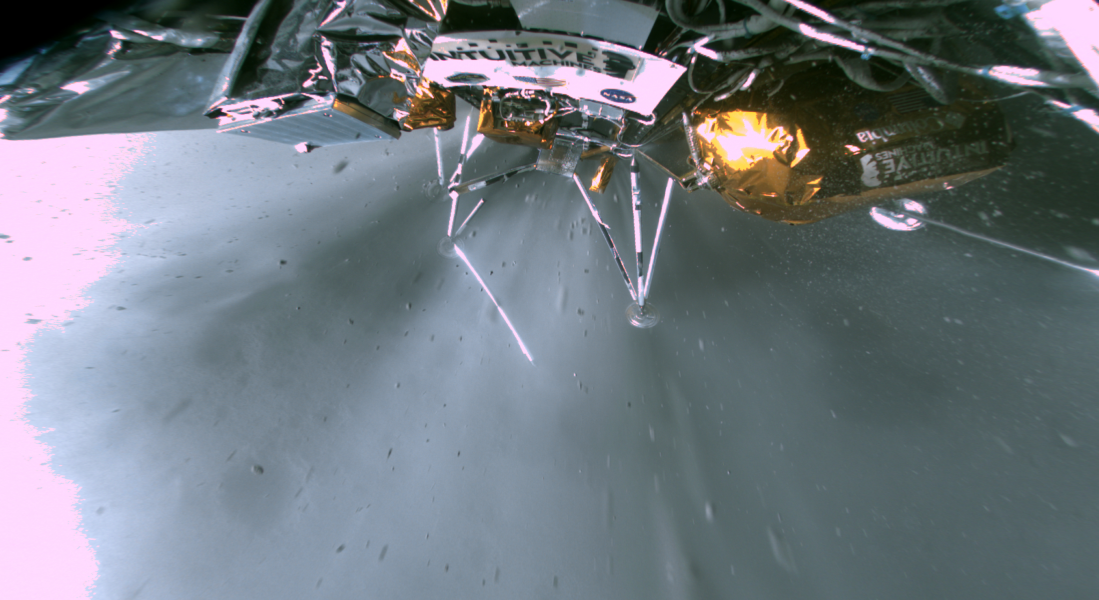
|
| Original url: https://apod.nasa.gov/apod/ap240303.html |
|
Explanation: Methalox rocket engine firing, Odysseus' landing legs absorb first contact with the lunar surface in this wide-angle snapshot from a camera on board the robotic Intuitive Machines Nova-C moon lander . Following the landing on February 22 , broken landing legs, visible in the image, ultimately left the lander at rest but tilted. Odysseus' gentle lean into a sloping lunar surface preserved the phone booth-sized lander's ability to operate, collect solar power, and return images and data to Earth. Its exact landing site in the Moon's far south polar region was imaged by NASA's Lunar Reconnaissance Orbiter. Donated by NASA, the American flag seen on the lander's central panel is 1970 Apollo program flight hardware. |
2024/03/01
|
|
| Original url: https://apod.nasa.gov/apod/ap240301.html |
|
Explanation: Murriyang, the CSIRO’s Parkes radio telescope points toward a nearly Full Moon in this image from New South Wales, Australia, planet Earth. Bathed in moonlight, the 64 meter dish is receiving weak radio signals from Odysseus, following the robotic lander's February 22 touch down some 300 kilometers north of the Moon's south pole . The landing of Odysseus represents the first U.S. landing on the Moon since the Apollo 17 mission in 1972 . Odysseus' tilted orientation on the lunar surface prevents its high-gain antenna from pointing toward Earth. But the sensitivity of the large, steerable Parkes dish significantly improved the reception of data from the experiments delivered to the lunar surface by the robotic moon lander. Of course the Parkes Radio Telescope dish became famous for its superior lunar television reception during the Apollo 11 mission in 1969, allowing denizens of planet Earth to watch the first moonwalk. |
2024/02/29

|
| Original url: https://apod.nasa.gov/apod/ap240229.html |
|
Explanation: In 46 BC Julius Caesar reformed the calendar system . Based on advice by astronomer Sosigenes of Alexandria , the Julian calendar included one leap day every four years to account for the fact that an Earth year is slightly more than 365 days long. In modern terms, the time it takes for the planet to orbit the Sun once is 365.24219 mean solar days. So if calendar years contained exactly 365 days they would drift from the Earth's year by about 1 day every 4 years and eventually July (named for Julius Caesar himself) would occur during the northern hemisphere winter. By adopting a leap year with an extra day every four years, the Julian calendar year would drift much less. In 1582 Pope Gregory XIII provided the further fine-tuning that leap days should not occur in years ending in 00, unless divisible by 400. This Gregorian Calendar system is the one in wide use today. Of course, tidal friction in the Earth-Moon system slows Earth's rotation and gradually lengthens the day by about 1.4 milliseconds per century. That means that leap days like today will not be necessary, about 4 million years from now . This Roman silver coin, a denarius , depicts Julius Caesar (left) and Venus, Roman goddess of love. |
2024/02/28
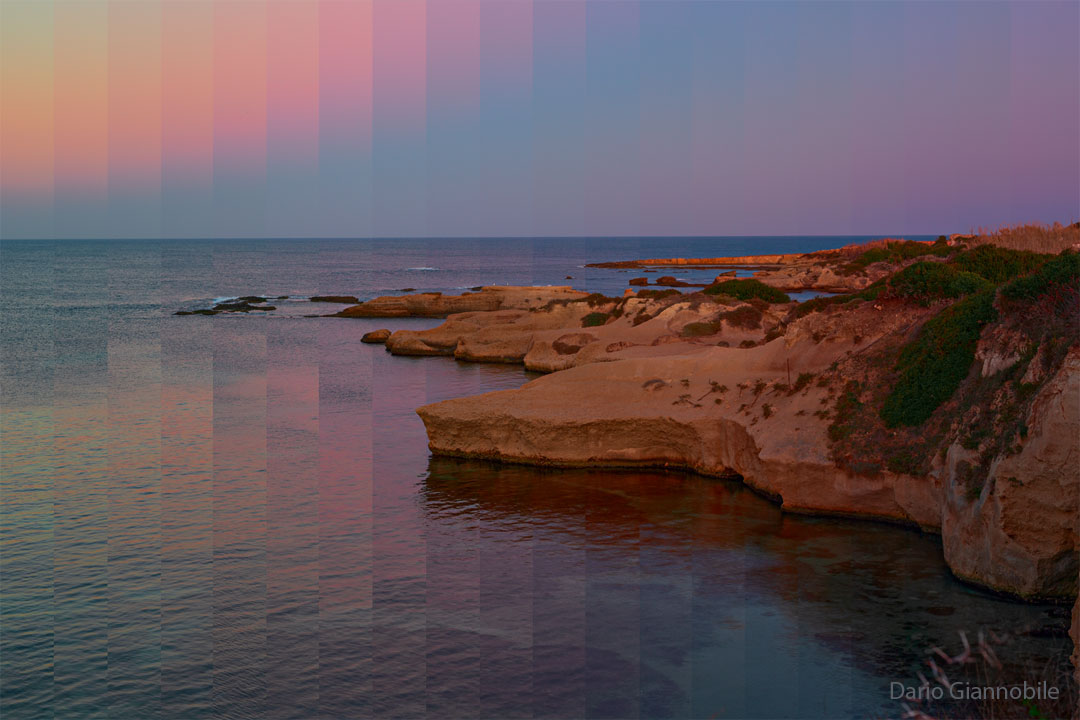
|
| Original url: https://apod.nasa.gov/apod/ap240228.html |
|
Explanation: How does the sky turn dark at night? In stages, and with different characteristic colors rising from the horizon. The featured image shows, left to right, increasingly late twilight times after sunset in 20 different vertical bands. The picture was taken last month in Syracuse , Sicily , Italy , in the direction opposite the Sun . On the far left is the pre-sunset upper sky. Toward the right, prominent bands include the Belt of Venus , the Blue Band , the Horizon Band , and the Red Band. As the dark shadow of the Earth rises, the colors in these bands are caused by direct sunlight reflecting from air and aerosol s in the Earth's atmosphere , multiple reflections sometimes involving a reddened sunset , and refraction . In practice, these bands can be diffuse and hard to discern, and their colors can depend on colors near the setting Sun . Finally, the Sun completely sets and the sky becomes dark. Don't despair -- the whole thing will happen in reverse when the Sun rises again in the morning. |
2024/02/27

|
| Original url: https://apod.nasa.gov/apod/ap240227.html |
|
Explanation: It's easy to get lost following the intricate, looping, and twisting filaments of supernova remnant Simeis 147. Also cataloged as Sharpless 2-240, the filamentary nebula goes by the popular nickname the Spaghetti Nebula. Seen toward the boundary of the constellations of the Bull ( Taurus ) and the Charioteer ( Auriga ), the impressive gas structure covers nearly 3 degrees on the sky, equivalent to 6 full moon s. That's about 150 light-years at the stellar debris cloud's estimated distance of 3,000 light-years. This composite image includes data taken through narrow-band filters isolating emission from hydrogen (red) and oxygen (blue) glowing gas. The supernova remnant has an estimated age of about 40,000 years, meaning light from this massive stellar explosion first reached the Earth when woolly mammoth s roamed free. Besides the expanding remnant, this cosmic catastrophe left behind a pulsar : a spinning neutron star that is the remnant of the original star's core. |
2024/02/25

|
| Original url: https://apod.nasa.gov/apod/ap240226.html |
|
Explanation: All of the other aurora watchers had gone home. By 3:30 am in Iceland , on a quiet September night, much of that night's auroras had died down. Suddenly, unexpectedly, a new burst of particles streamed down from space, lighting up the Earth's atmosphere once again. This time, surprisingly, pareidolia cally, the night lit up with an amazing shape reminiscent of a giant phoenix . With camera equipment at the ready, two quick sky images were taken, followed immediately by a third of the land. The mountain in the background is Helgafell , while the small foreground river is called Kaldá, both located about 30 kilometers north of Iceland's capital Reykjavík . Seasoned skywatchers will note that just above the mountain, toward the left, is the constellation of Orion , while the Pleiades star cluster is also visible just above the frame center. The 2016 aurora , which lasted only a minute and was soon gone forever -- would possibly be dismissed as a fanciful fable -- were it not captured in the featured, digitally-composed, image mosaic . |
2024/02/24
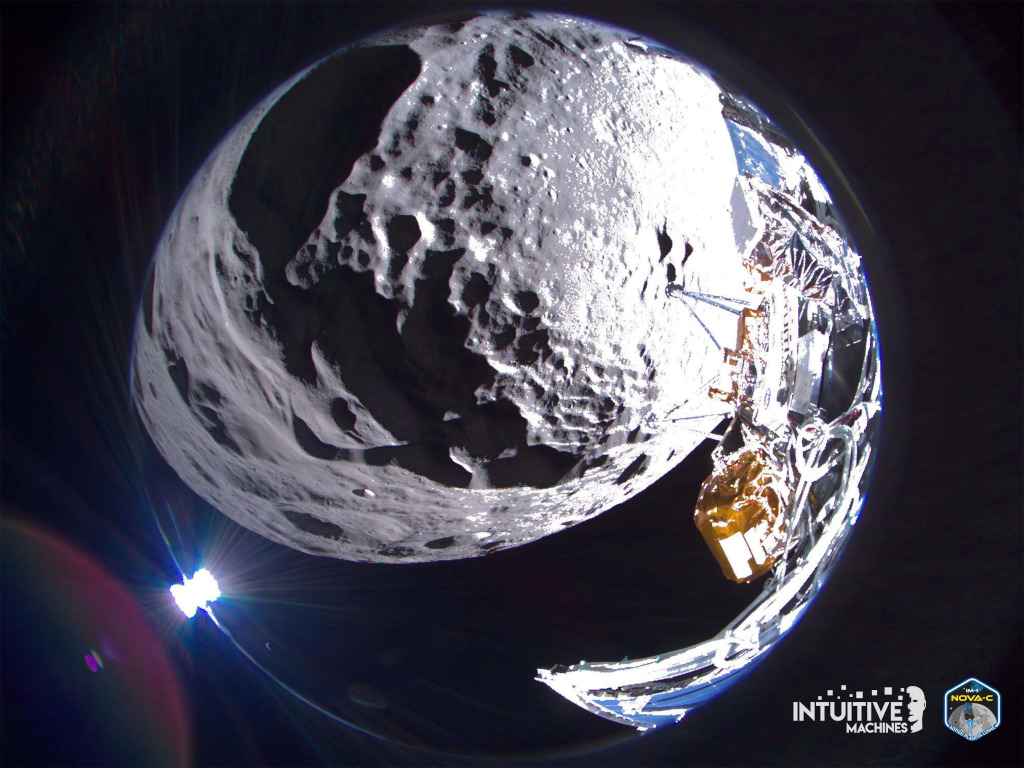
|
| Original url: https://apod.nasa.gov/apod/ap240224.html |
|
Explanation: Intuitive Machines' robotic lander Odysseus has accomplished the first U.S. landing on the Moon since the Apollo 17 mission in 1972 . Launched on a SpaceX rocket on February 15, the phone booth sized lander reached lunar orbit on the 21st and touched down on the lunar surface at 6:23 pm ET on February 22nd. Its landing region is about 300 kilometers north of the Moon's south pole , near a crater designated Malapert A. The lander is presently collecting solar power and transmitting data back to the Intuitive Machines' mission control center in Houston. The mission marks the first commercial uncrewed landing on the Moon. Prior to landing, Odysseus’ camera captured this extreme wide angle image (landing legs visible at right) as it flew over Schomberger crater some 200 kilometers from its landing site. Odysseus was still about 10 kilometers above the lunar surface. |
2024/02/23

|
| Original url: https://apod.nasa.gov/apod/ap240223.html |
|
Explanation: This supernova shock wave plows through interstellar space at over 500,000 kilometers per hour. Centered and moving upward in the sharply detailed color composite its thin, bright, braided filaments are actually long ripples in a cosmic sheet of glowing gas seen almost edge-on. Discovered in the 1840s by Sir John Herschel , the narrow-looking nebula is sometimes known as Herschel's Ray. Cataloged as NGC 2736 , its pointed appearance suggests its modern popular name, the Pencil Nebula. The Pencil Nebula is about 800 light-years away. Nearly 5 light-years long it represents only a small part of the Vela supernova remnant though. The enormous Vela remnant itself is around 100 light-years in diameter, the expanding debris cloud of a star that was seen to explode about 11,000 years ago. Initially, the section of the shock wave seen as the Pencil nebula was moving at millions of kilometers per hour but has slowed considerably, sweeping up surrounding interstellar material. |
2024/02/22
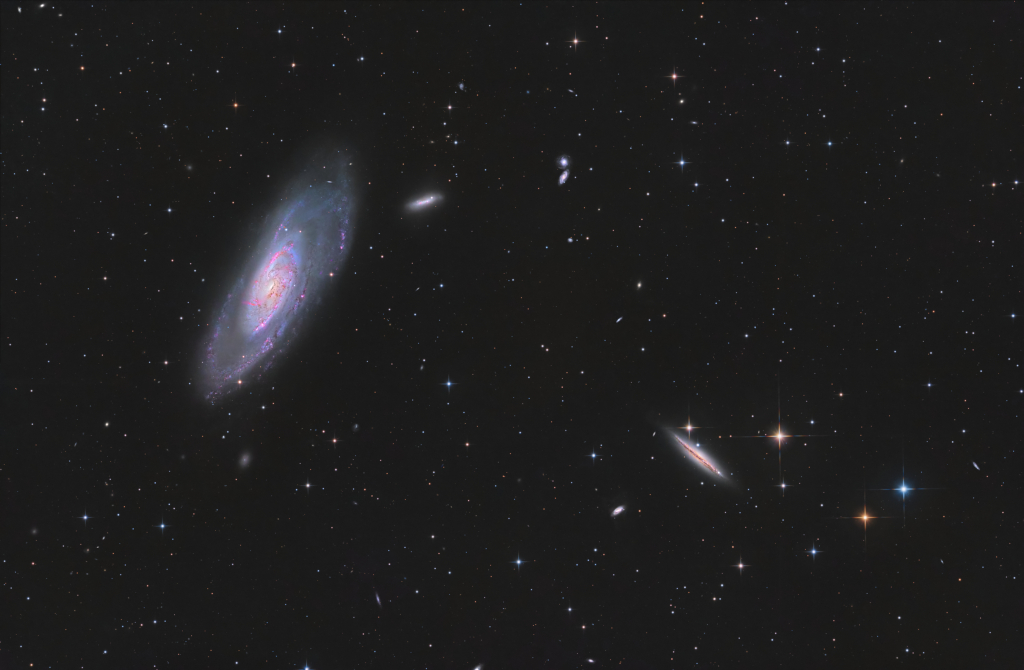
|
| Original url: https://apod.nasa.gov/apod/ap240222.html |
|
Explanation: Big, bright, beautiful spiral, Messier 106 dominates this cosmic vista. The nearly two degree wide telescopic field of view looks toward the well-trained constellation Canes Venatici, near the handle of the Big Dipper. Also known as NGC 4258, M106 is about 80,000 light-years across and 23.5 million light-years away, the largest member of the Canes II galaxy group. For a far far away galaxy, the distance to M106 is well-known in part because it can be directly measured by tracking this galaxy's remarkable maser, or microwave laser emission. Very rare but naturally occurring, the maser emission is produced by water molecules in molecular clouds orbiting its active galactic nucleus . Another prominent spiral galaxy on the scene, viewed nearly edge-on, is NGC 4217 below and right of M106. The distance to NGC 4217 is much less well-known, estimated to be about 60 million light-years, but the bright spiky stars are in the foreground, well inside our own Milky Way galaxy. |
2024/02/21

|
| Original url: https://apod.nasa.gov/apod/ap240221.html |
|
Explanation: The bird is bigger than the peak. Nicknamed for its avian shape, the Seagull Nebula is an emission nebula on the night sky that is vast , spanning an angle over five times the diameter of the full moon and over 200 light years . The head of the nebula is catalogued as IC 2177 , and the star cluster under its right wing is catalogued as NGC 2343. Consisting of mostly red-glowing hydrogen gas, the Seagull Nebula incorporates some dust lanes and is forming stars . The peak over which this Seagull seems to soar occurs at Pinnacles National Park in California , USA . The featured image is a composite of long exposure images of the background sky and short exposure images of the foreground, all taken consecutively with the same camera and from the same location. |
2024/02/20
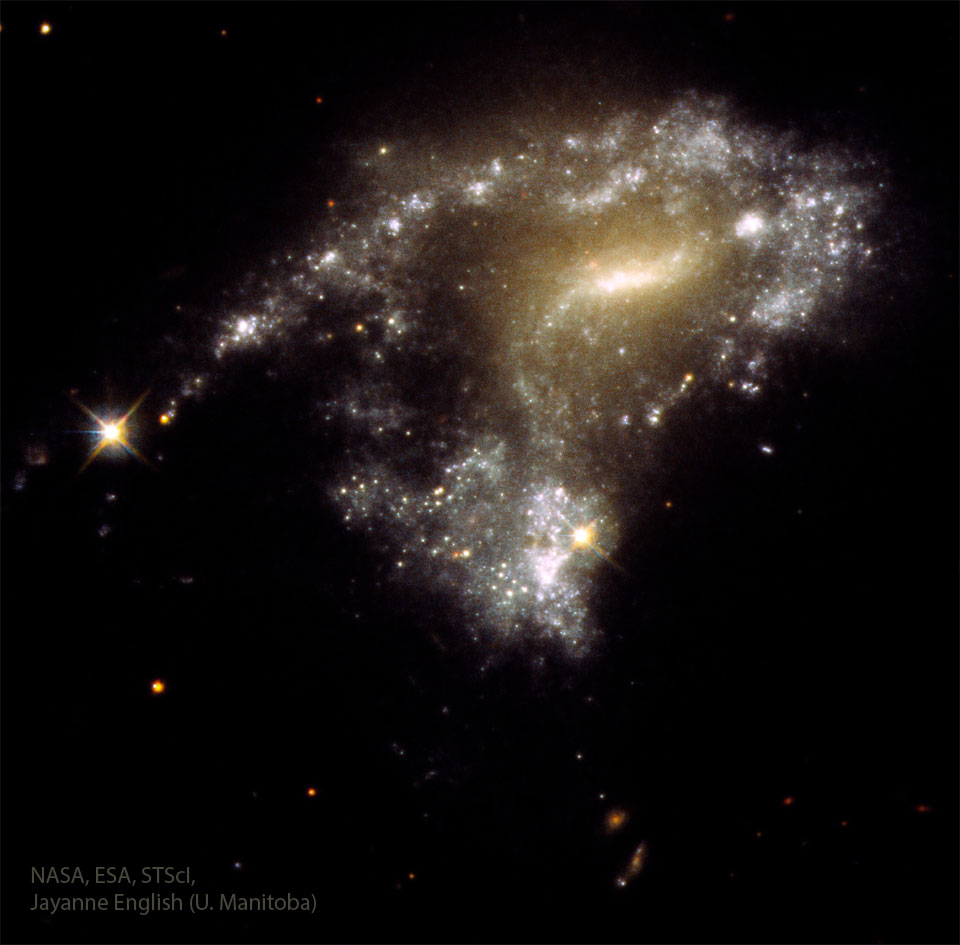
|
| Original url: https://apod.nasa.gov/apod/ap240220.html |
|
Explanation: When galaxies collide, how many stars are born? For AM1054-325, featured here in a recently released image by the Hubble Space Telescope , the answer is millions. Instead of stars being destroyed as galaxy AM1054-325 and a nearby galaxy circle each other , their gravity and motion has ignited stellar creation . Star formation occurs rapidly in the gaseous debris stretching from AM1054-325 ’s yellowish body due to the other galaxy’s gravitational pull. Hydrogen gas surrounding newborn stars glows pink . Bright infant stars shine blue and cluster together in compact nurseries of thousands to millions of stars . AM1054-325 possesses over 100 of these intense-blue, dot-like star clusters , some appearing like a string of pearls . Analyzing ultraviolet light helped determine that most of these stars are less than 10 million years old: stellar babies . Many of these nurseries may grow up to be globular star clusters , while the bundle of young stars at the bottom tip may even detach and form a small galaxy . |
2024/02/18

|
| Original url: https://apod.nasa.gov/apod/ap240219.html |
|
Explanation: Is this one galaxy or two? This question came to light in 1950 when astronomer Arthur Hoag chanced upon this unusual extragalactic object. On the outside is a ring dominated by bright blue stars, while near the center lies a ball of much redder stars that are likely much older. Between the two is a gap that appears almost completely dark. How Hoag's Object formed, including its nearly perfectly round ring of stars and gas, remains unknown. Genesis hypotheses include a galaxy collision billions of years ago and the gravitational effect of a central bar that has since vanished . The featured photo was taken by the Hubble Space Telescope and reprocessed using an artificially intelligent de-noising algorithm . Observations in radio waves indicate that Hoag's Object has not accreted a smaller galaxy in the past billion years. Hoag's Object spans about 100,000 light years and lies about 600 million light years away toward the constellation of the Snake ( Serpens ). Many galaxies far in the distance are visible toward the right, while coincidentally , visible in the gap at about seven o'clock, is another but more distant ring galaxy . |
2024/02/17
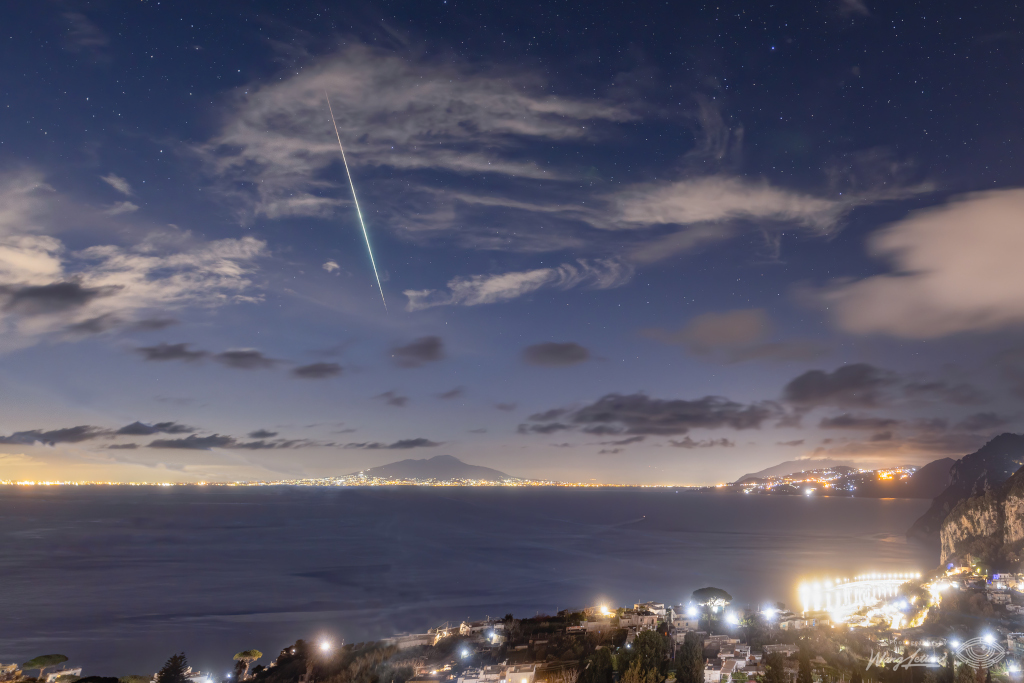
|
| Original url: https://apod.nasa.gov/apod/ap240217.html |
|
Explanation: A cosmic dust grain plowing through the upper atmosphere much faster than a falling leaf created this brilliant meteor streak . In a serendipitous moment, the sublime night sky view was captured from the resort island of Capri, in the Bay of Naples, on the evening of February 8. Looking across the bay, the camera faces northeast toward the lights of Naples and surrounding cities. Pointing toward the horizon, the meteor streak by chance ends above the silhouette of Mount Vesuvius. One of planet Earth's most famous volcanos, an eruption of Mount Vesuvius destroyed the city of Pompeii in 79 AD . |
2024/02/16
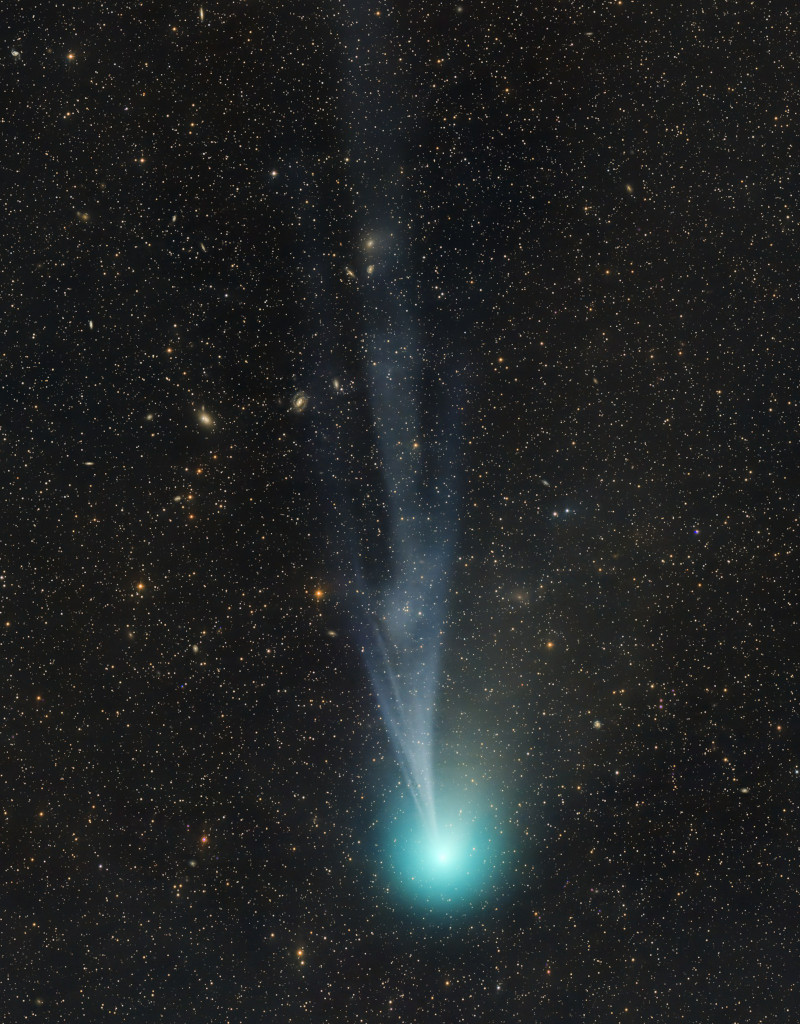
|
| Original url: https://apod.nasa.gov/apod/ap240216.html |
|
Explanation: Heading for its next perihelion passage on April 21, Comet 12P/Pons-Brooks is growing brighter. The greenish coma of this periodic Halley-type comet has become relatively easy to observe in small telescopes. But the bluish ion tail now streaming from the active comet's coma and buffeted by the solar wind, is faint and difficult to follow. Still, in this image stacked exposures made on the night of February 11 reveal the fainter tail's detailed structures. The frame spans over two degrees across a background of faint stars and background galaxies toward the northern constellation Lacerta. Of course Comet 12P's April 21 perihelion passage will be only two weeks after the April 8 total solar eclipse, putting the comet in planet Earth's sky along with a totally eclipsed Sun . |
2024/02/15

|
| Original url: https://apod.nasa.gov/apod/ap240215.html |
|
Explanation: Shiny NGC 253 is one of the brightest spiral galaxies visible, and also one of the dustiest. Some call it the Silver Coin Galaxy for its appearance in small telescopes, or just the Sculptor Galaxy for its location within the boundaries of the southern constellation Sculptor. Discovered in 1783 by mathematician and astronomer Caroline Herschel , the dusty island universe lies a mere 10 million light-years away. About 70 thousand light-years across, NGC 253 is the largest member of the Sculptor Group of Galaxies , the nearest to our own Local Group of Galaxies . In addition to its spiral dust lanes, tendrils of dust seem to be rising from its galactic disk laced with young star clusters and star forming regions in this colorful galaxy portrait . The high dust content accompanies frantic star formation, earning NGC 253 the designation of a starburst galaxy . NGC 253 is also known to be a strong source of high-energy x-rays and gamma rays , likely due to massive black holes near the galaxy's center. |
2024/02/14

|
| Original url: https://apod.nasa.gov/apod/ap240214.html |
|
Explanation: Can you find the Rosette Nebula? The large, red , and flowery-looking nebula on the upper left may seem the obvious choice, but that is actually just diffuse hydrogen emission surrounding the Cone and Fox Fur Nebulas . The famous Rosette Nebula is really located on the lower right and connected to the other nebulas by irregular filaments. Because the featured image of Rosetta's field is so wide and deep , it seems to contain other flowers. Designated NGC 2237 , the center of the Rosette nebula is populated by the bright blue stars of open cluster NGC 2244 , whose winds and energetic light are evacuating the nebula's center. The Rosette Nebula is about 5,000 light years distant and, just by itself, spans about three times the diameter of a full moon . This flowery field can be found toward the constellation of the Unicorn ( Monoceros ). |
2024/02/13
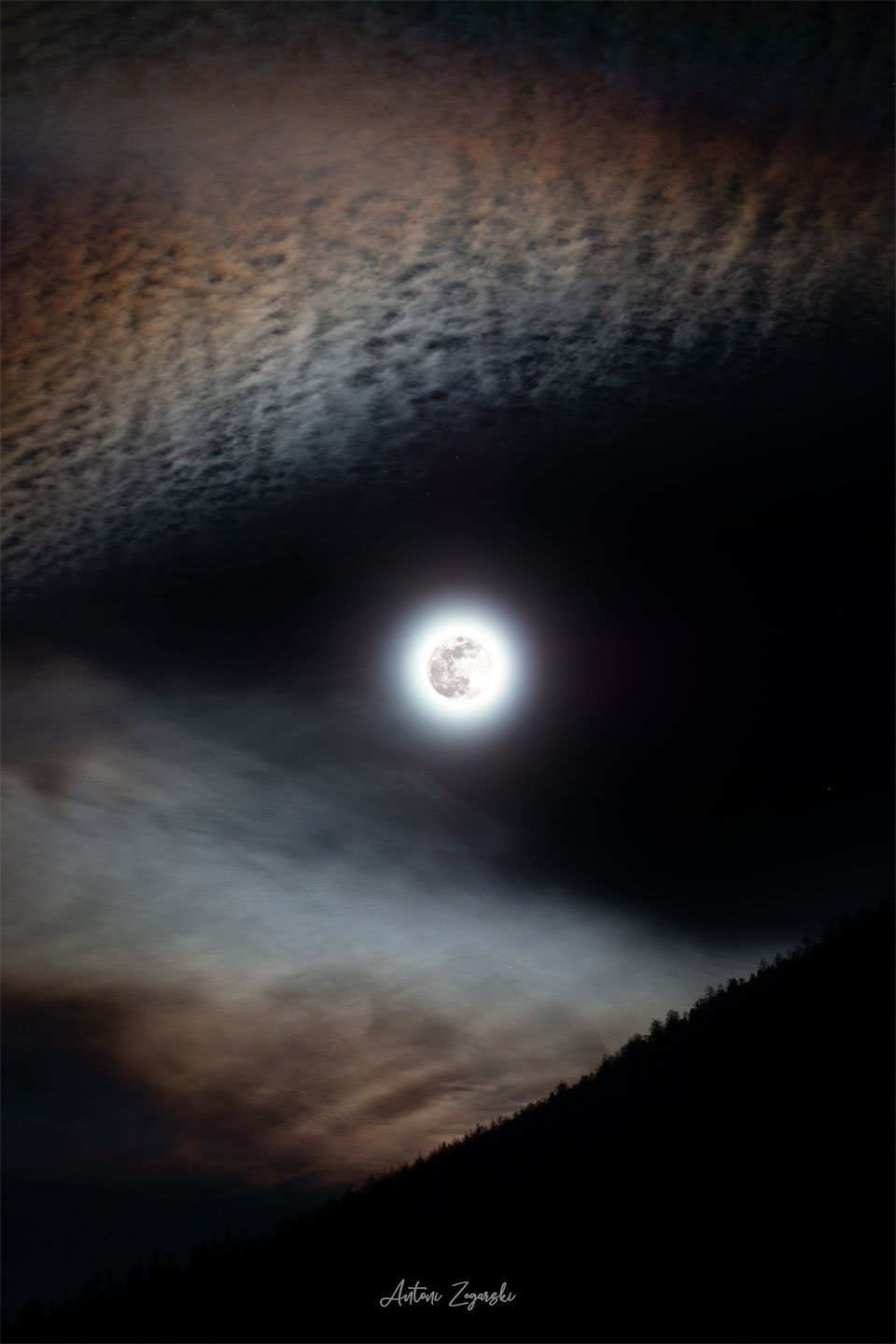
|
| Original url: https://apod.nasa.gov/apod/ap240213.html |
|
Explanation: Did you see the full moon last month? During every month, on average, a full moon occurs in the skies over planet Earth . This is because the Moon takes a month to complete another orbit around our home planet , goes through all of its phases , and once again has its entire Earth-facing half lit by reflected sunlight. Many indigenous cultures give each full moon a name , and this past full moon's names include the Ice Moon, the Stay at Home Moon, and the Quiet Moon. Occurring in January on the modern western calendar , several cultures have also named the most recent full moon the Wolf Moon , in honor of the famous howling animal . Featured here above the Italian Alps mountains, this past Wolf Moon was captured in combined long and short exposure images. The image is striking because, to some, the surrounding clouds appear as a wolf's mouth ready to swallow the Wolf Moon , while others see the Moon as a wolf's eye. |
2024/02/12
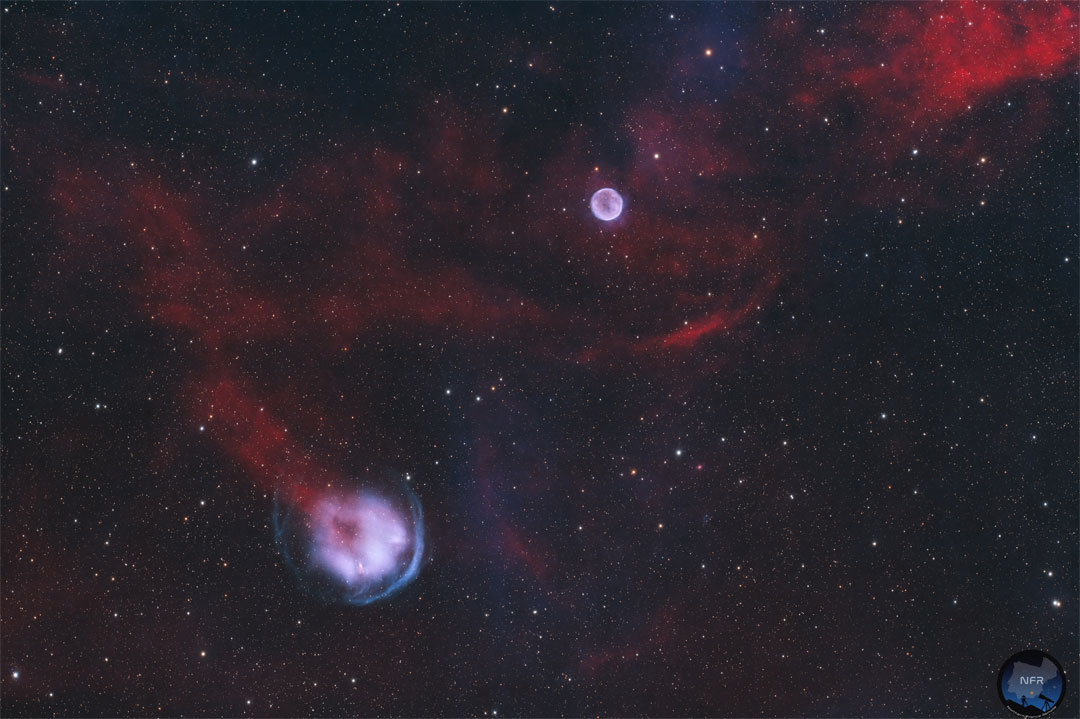
|
| Original url: https://apod.nasa.gov/apod/ap240212.html |
|
Explanation: Planetary nebulae like Heckathorn-Fesen-Gull 1 (HFG1) and Abell 6 in the constellation Cassiopeia are remnants from the last phase of a medium sized star like our Sun . In spite of their shapes, planetary nebulae have nothing in common with actual planets . Located in the bottom left part of the featured photo , HFG1 was created by the binary star system V664 Cas, which consists of a white dwarf star and a red giant star . Both stars orbit their center of mass over about half an Earth day . Traveling with the entire nebula at a speed about 300 times faster than the fastest train on Earth, V664 Cas generates a bluish arc shaped shock wave . The wave interacts most strongly with the surrounding interstellar medium in the areas where the arc is brightest. After roughly 10,000 years , planetary nebulae become invisible due to a lack of ultraviolet light being emitted by the star s that create them. Displaying beautiful shapes and structures, planetary nebulae are highly desired object s for astrophotographers. |
2024/02/11

|
| Original url: https://apod.nasa.gov/apod/ap240211.html |
|
Explanation: Why would the shadow of a rocket's launch plume point toward the Moon? In early 2001 during a launch of the space shuttle Atlantis , the Sun , Earth , Moon , and rocket were all properly aligned for this photogenic coincidence . First, for the space shuttle 's plume to cast a long shadow, the time of day must be either near sunrise or sunset . Only then will the shadow be its longest and extend all the way to the horizon . Finally, during a Full Moon , the Sun and Moon are on opposite sides of the sky. Just after sunset , for example, the Sun is slightly below the horizon , and, in the other direction, the Moon is slightly above the horizon . Therefore, as Atlantis blasted off, just after sunset , its shadow projected away from the Sun toward the opposite horizon , where the Full Moon happened to be. |
2024/02/10
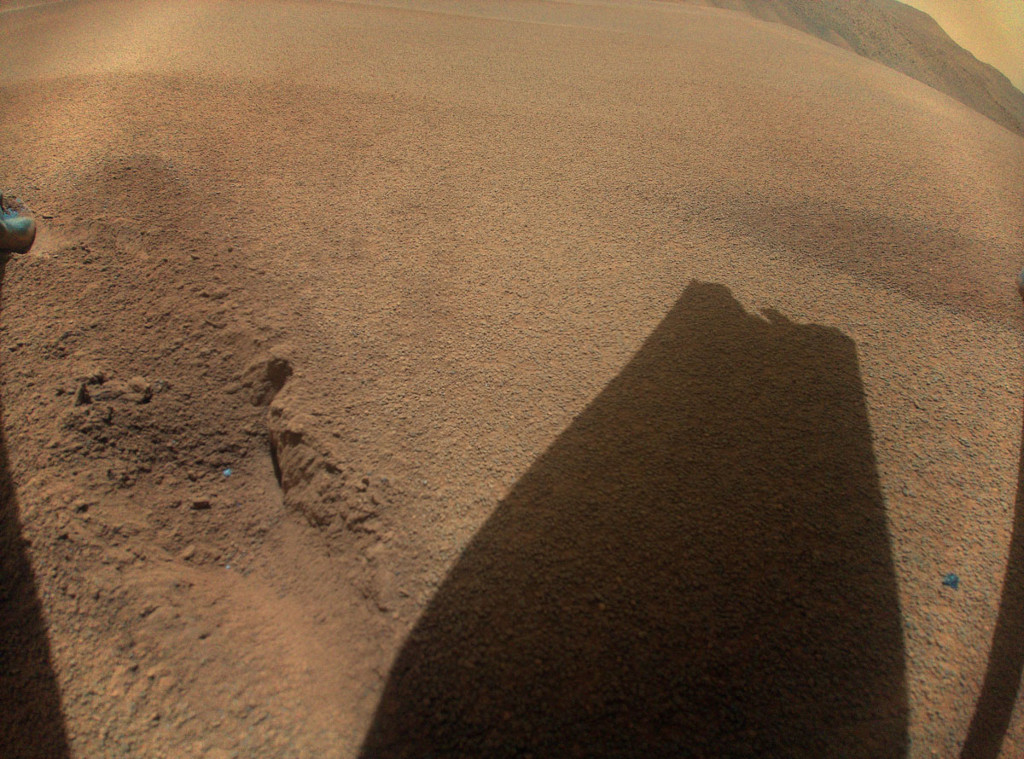
|
| Original url: https://apod.nasa.gov/apod/ap240210.html |
|
Explanation: On January 18, 2024 , during its 72nd flight in the thin Martian atmosphere, autonomous Mars Helicopter Ingenuity rose to an altitude of 12 meters (40 feet) and hovered for 4.5 seconds above the Red Planet. Ingenuity's 72nd landing was a rough one though. During descent it lost contact with the Perseverance rover about 1 meter above the Martian surface. Ingenuity was able to transmit this image after contact was re-established, showing the shadow of one of its rotor blades likely damaged during landing. And so, after wildly exceeding expectations during over 1,000 days of exploring Mars, the history-making Ingenuity has ended its flight operations. Nicknamed Ginny, Mars Helicopter Ingenuity became the first aircraft to achieve powered, controlled flight on another planet on April 19, 2021 . Before launch, a small piece of material from the lower-left wing of the Wright Brothers Flyer 1, the first aircraft to achieve powered, controlled flight on planet Earth, was fixed to the underside of Ingenuity's solar panel. |
2024/02/09

|
| Original url: https://apod.nasa.gov/apod/ap240209.html |
|
Explanation: Not all roses are red of course , but they can still be very pretty. Likewise, the beautiful Rosette Nebula and other star forming regions are often shown in astronomical images with a predominately red hue, in part because the dominant emission in the nebula is from hydrogen atoms . Hydrogen's strongest optical emission line, known as H-alpha, is in the red region of the spectrum. But the beauty of an emission nebula need not be appreciated in red light alone. Other atoms in the nebula are also excited by energetic starlight and produce narrow emission lines as well. In this close-up view of the Rosette Nebula, narrowband images are mapped into broadband colors to show emission from Sulfur atoms in red, Hydrogen in green, and Oxygen in blue. In fact, the scheme of mapping these narrow atomic emission lines (SHO) into the broader colors (RGB) is adopted in many Hubble images of emission nebulae. This image spans about 50 light-years across the center of the Rosette Nebula . The nebula lies some 3,000 light-years away in the constellation Monoceros. |
2024/02/08
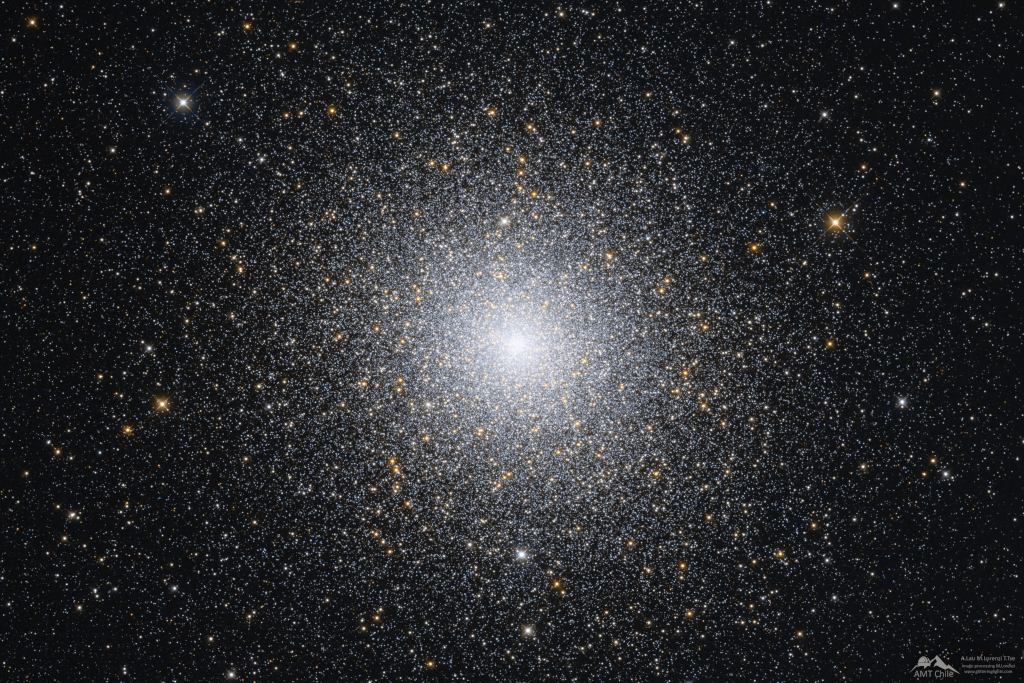
|
| Original url: https://apod.nasa.gov/apod/ap240208.html |
|
Explanation: Globular star cluster 47 Tucanae is a jewel of the southern sky. Also known as NGC 104 , it roams the halo of our Milky Way Galaxy along with some 200 other globular star clusters . The second brightest globular cluster (after Omega Centauri ) as seen from planet Earth, 47 Tuc lies about 13,000 light-years away. It can be spotted with the naked-eye close on the sky to the Small Magellanic Cloud in the constellation of the Toucan . The dense cluster is made up of hundreds of thousands of stars in a volume only about 120 light-years across. Red giant stars on the outskirts of the cluster are easy to pick out as yellowish stars in this sharp telescopic portrait . Tightly packed globular cluster 47 Tuc is also home to a star with the closest known orbit around a black hole . |
2024/02/07
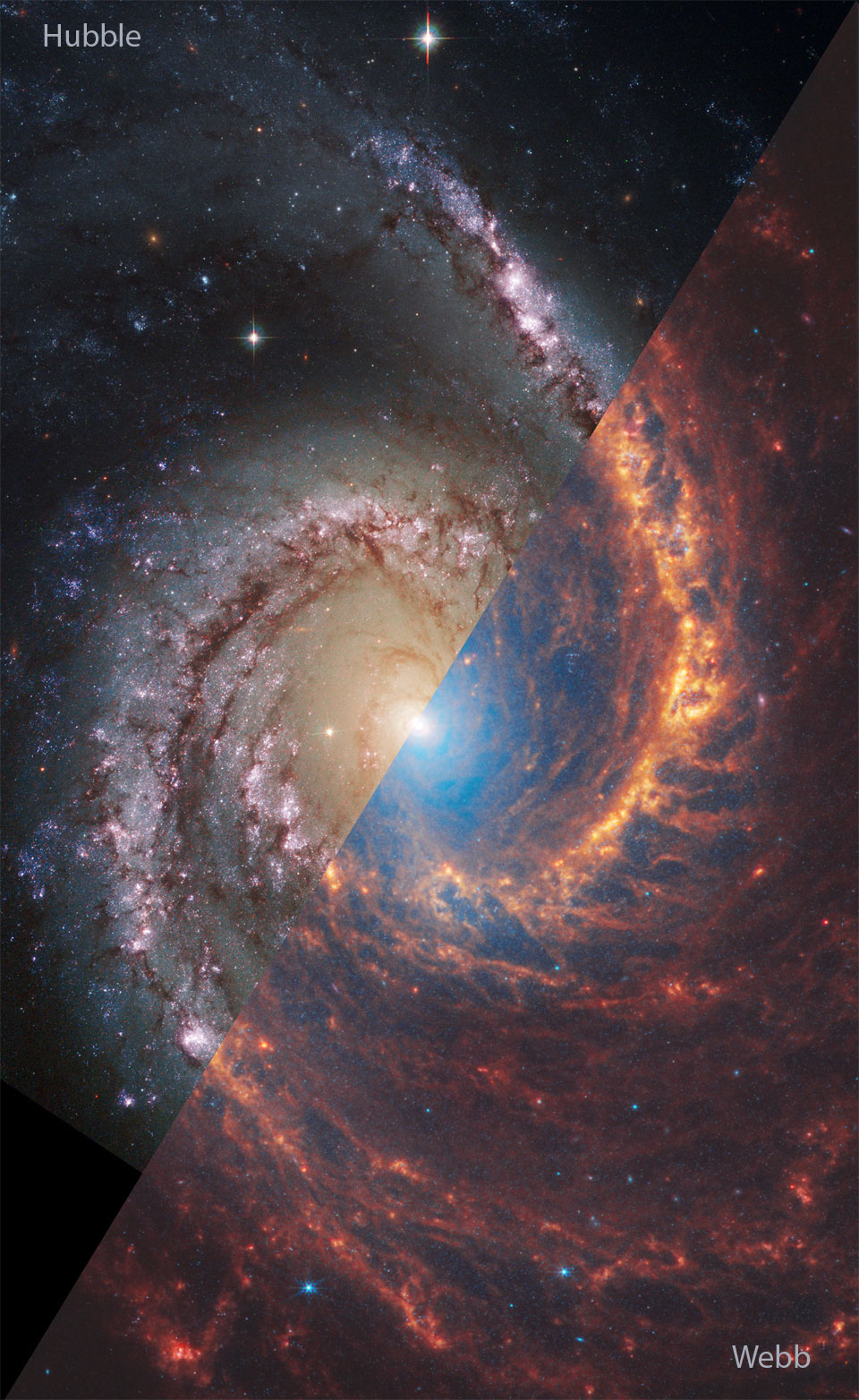
|
| Original url: https://apod.nasa.gov/apod/ap240207.html |
|
Explanation: What's different about this galaxy? Very little, which makes the Spanish Dancer galaxy , NGC 1566 , one of the most typical and photogenic spirals on the sky. There is something different about this galaxy image , though, because it is a diagonal combination of two images: one by the Hubble Space Telescope on the upper left, and the other by the James Webb Space Telescope on the lower right. The Hubble image was taken in ultraviolet light and highlights the locations of bright blue stars and dark dust along the galaxy's impressive spiral arms. In contrast, the Webb image was taken in infrared light and highlights where the same dust emits more light than it absorbed. In the rollover image, the other two sides of these images are revealed. Blinking between the two images shows which stars are particularly hot because they glow brighter in ultraviolet light, and the difference between seemingly empty space and infrared-glowing dust. |
2024/02/06

|
| Original url: https://apod.nasa.gov/apod/ap240206.html |
|
Explanation: What's different about this galaxy? Very little, which makes the Spanish Dancer galaxy , NGC 1566 , one of the most typical and photogenic spirals on the sky. There is something different about this galaxy image , though, because it is a diagonal combination of two images: one by the Hubble Space Telescope on the upper left, and the other by the James Webb Space Telescope on the lower right. The Hubble image was taken in ultraviolet light and highlights the locations of bright blue stars and dark dust along the galaxy's impressive spiral arms. In contrast, the Webb image was taken in infrared light and highlights where the same dust emits more light than it absorbed. In the rollover image, the other two sides of these images are revealed. Blinking between the two images shows which stars are particularly hot because they glow brighter in ultraviolet light, and the difference between seemingly empty space and infrared-glowing dust. |
2024/02/05
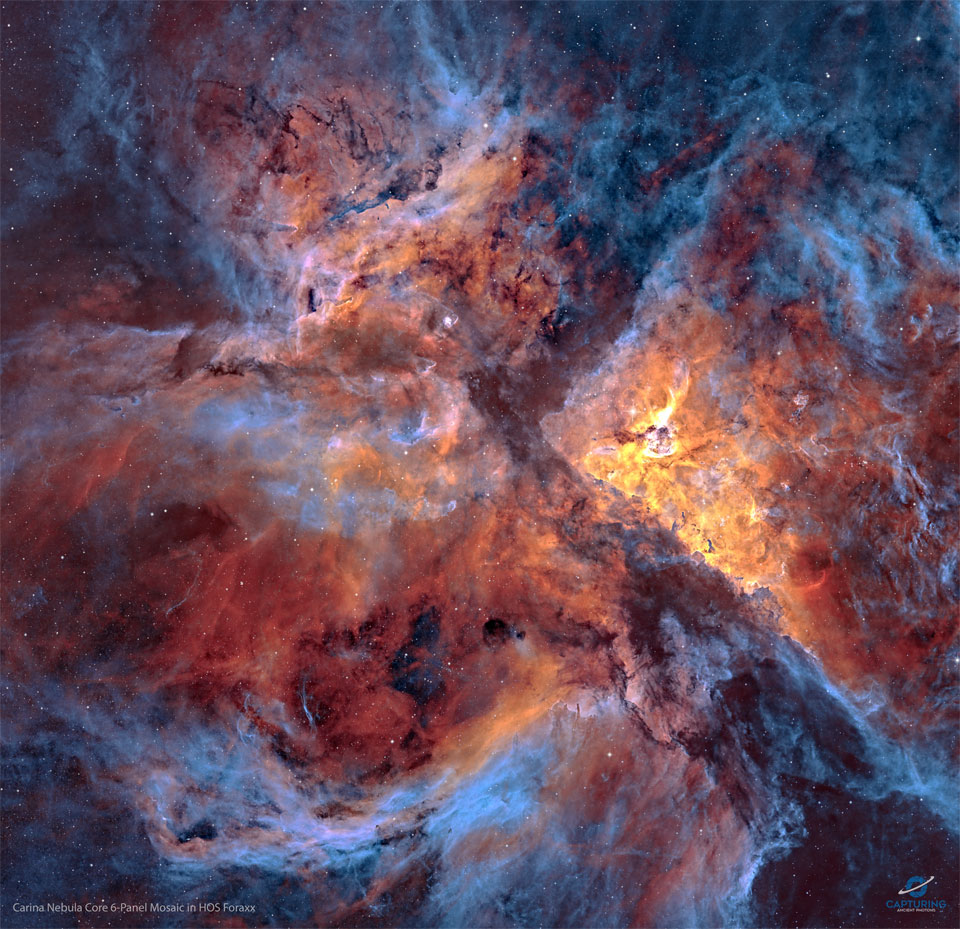
|
| Original url: https://apod.nasa.gov/apod/ap240205.html |
|
Explanation: What's happening in the core of the Carina Nebula? Stars are forming, dying, and leaving an impressive tapestry of dark dusty filaments. The entire Carina Nebula , cataloged as NGC 3372, spans over 300 light years and lies about 8,500 light-years away in the constellation of Carina. The nebula is composed predominantly of hydrogen gas, which emits the pervasive red and orange glows seen mostly in the center of this highly detailed featured image . The blue glow around the edges is created primarily by a trace amount of glowing oxygen . Young and massive stars located in the nebula's center expel dust when they explode in supernovas. Eta Carinae , the most energetic star in the nebula's center, was one of the brightest stars in the sky in the 1830s, but then faded dramatically . |
2024/02/04

|
| Original url: https://apod.nasa.gov/apod/ap240204.html |
|
Explanation: Stars are forming in the gigantic dust pillar called the Cone Nebula. Cones, pillars , and majestic flowing shapes abound in stellar nurseries where natal clouds of gas and dust are buffeted by energetic winds from newborn stars. The Cone Nebula , a well-known example, lies within the bright galactic star-forming region NGC 2264 . The Cone was captured in unprecedented detail in this close-up composite of several observations from the Earth-orbiting Hubble Space Telescope . While the Cone Nebula , about 2,500 light-year s away in Monoceros , is around 7 light-years long, the region pictured here surrounding the cone's blunted head is a mere 2.5 light-years across. In our neck of the galaxy that distance is just over half way from our Sun to its nearest stellar neighbors in the Alpha Centauri star system. The massive star NGC 2264 IRS , seen by Hubble's infrared camera in 1997, is the likely source of the wind sculpting the Cone Nebula and lies off the top of the image. The Cone Nebula 's reddish veil is produced by dust and glowing hydrogen gas. |
2024/02/03
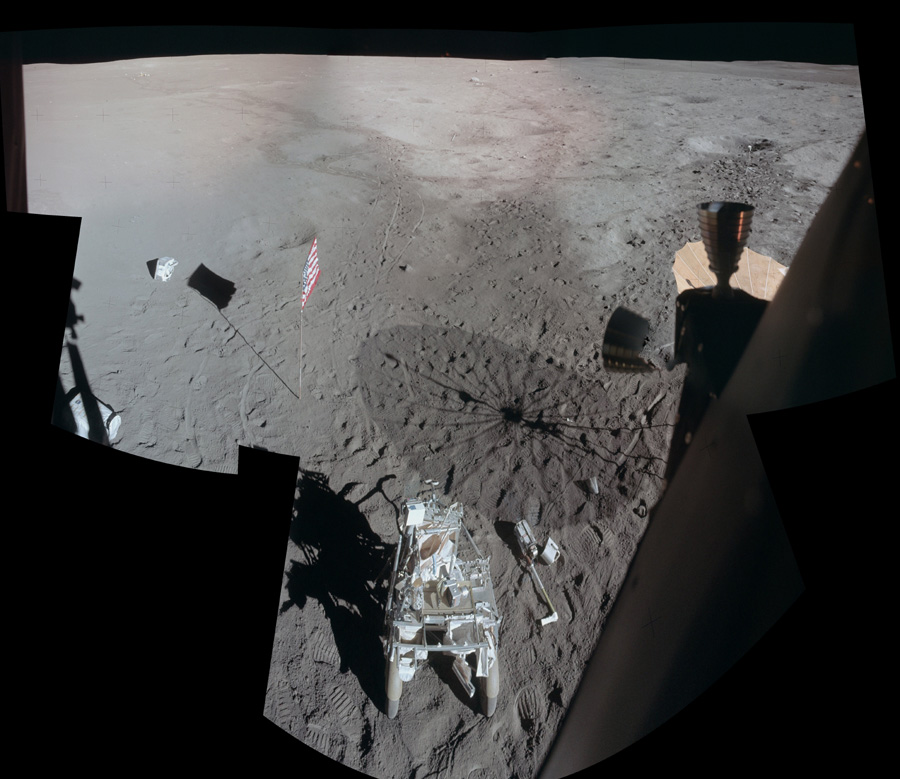
|
| Original url: https://apod.nasa.gov/apod/ap240203.html |
|
Explanation: Apollo 14's Lunar Module Antares landed on the Moon on February 5, 1971. Toward the end of the stay astronaut Ed Mitchell snapped a series of photos of the lunar surface while looking out a window, assembled into this detailed mosaic by Apollo Lunar Surface Journal editor Eric Jones. The view looks across the Fra Mauro highlands to the northwest of the landing site after the Apollo 14 astronauts had completed their second and final walk on the Moon . Prominent in the foreground is their Modular Equipment Transporter, a two-wheeled, rickshaw-like device used to carry tools and samples. Near the horizon at top center is a 1.5 meter wide boulder dubbed Turtle rock. In the shallow crater below Turtle rock is the long white handle of a sampling instrument, thrown there javelin-style by Mitchell. Mitchell's fellow moonwalker and first American in space, Alan Shepard , also used a makeshift six iron to hit two golf balls . One of Shepard's golf balls is just visible as a white spot below Mitchell's javelin . |
2024/02/02

|
| Original url: https://apod.nasa.gov/apod/ap240202.html |
|
Explanation: This cosmic view shows off an otherwise faint emission nebula IC 410, captured under clear Netherlands skies with telescope and narrowband filters. Above and right of center you can spot two remarkable inhabitants of the interstellar pond of gas and dust, known as the tadpoles of IC 410. Partly obscured by foreground dust, the nebula itself surrounds NGC 1893, a young galactic cluster of stars. Formed in the interstellar cloud a mere 4 million years ago, the intensely hot, bright cluster stars energize the glowing gas. Globules composed of denser cooler gas and dust, the tadpoles are around 10 light-years long and are likely sites of ongoing star formation . Sculpted by stellar winds and radiation their heads are outlined by bright ridges of ionized gas while their tails trail away from the cluster's central young stars. IC 410 and embedded NGC 1893 lie some 10,000 light-years away, toward the nebula-rich constellation Auriga . |
2024/02/01
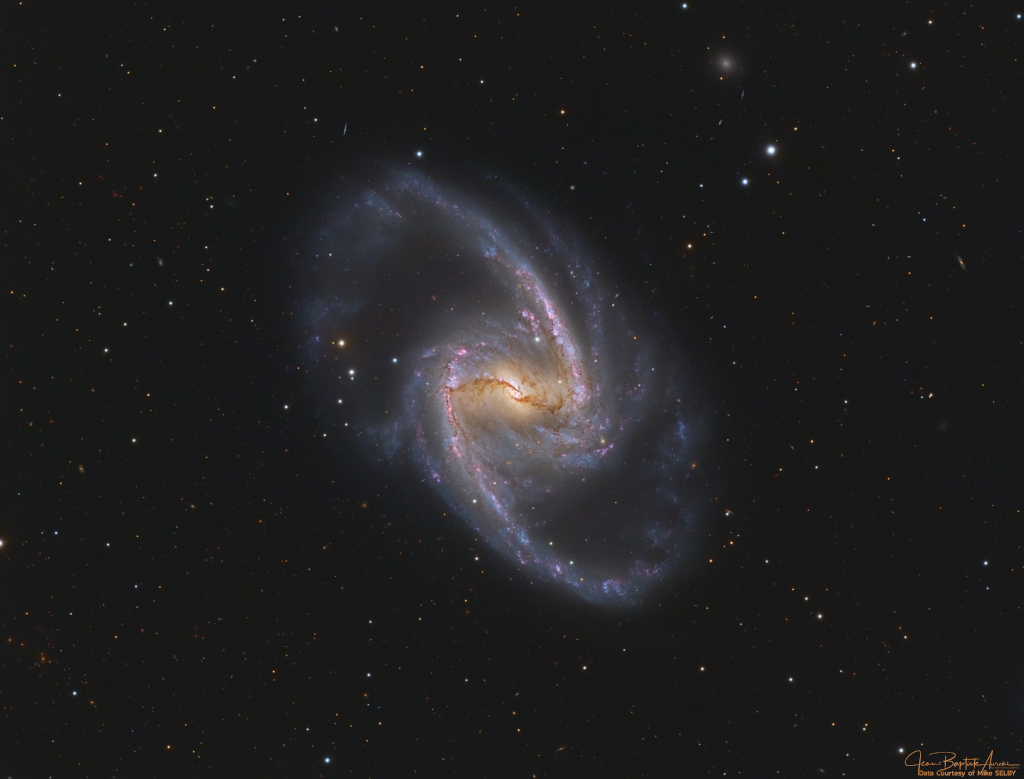
|
| Original url: https://apod.nasa.gov/apod/ap240201.html |
|
Explanation: Barred spiral galaxy NGC 1365 is truly a majestic island universe some 200,000 light-years across. Located a mere 60 million light-years away toward the faint but heated constellation Fornax , NGC 1365 is a dominant member of the well-studied Fornax Cluster of galaxies. This sharp color image shows the intense, reddish star forming regions near the ends of the galaxy's central bar and along its spiral arms. Seen in fine detail, obscuring dust lanes cut across the galaxy's bright core. At the core lies a supermassive black hole. Astronomers think NGC 1365's prominent bar plays a crucial role in the galaxy's evolution, drawing gas and dust into a star-forming maelstrom and ultimately feeding material into the central black hole . |
2024/01/31
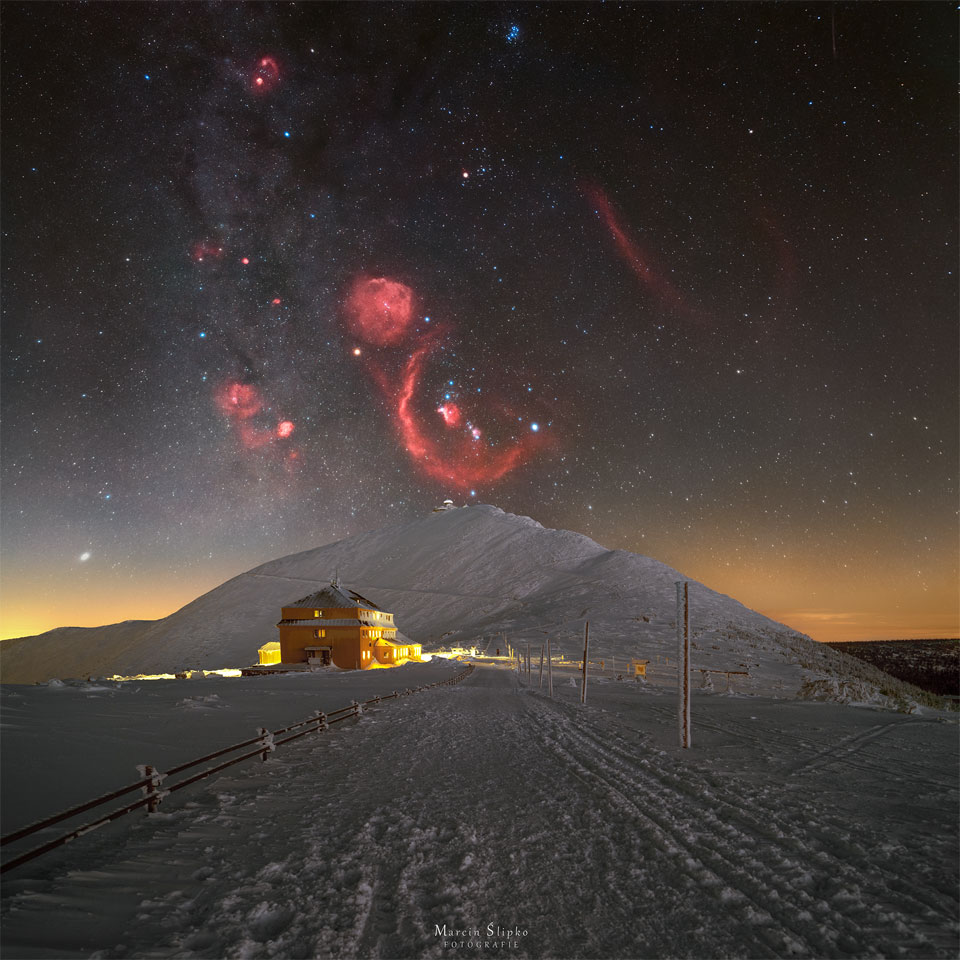
|
| Original url: https://apod.nasa.gov/apod/ap240131.html |
|
Explanation: What does Orion rising look like to a camera? During this time of the year, the famous constellation is visible to the southeast just after sunset. From most Earth ly locations, Orion's familiar star pattern , highlighted by the three-stars-in-a-row belt stars, rises sideways . An entire section of the night sky that includes Orion was photographed rising above Śnieżka , a mountain on the border between Poland and the Czech Republic . The long duration exposure sequence brings up many faint features including the Orion and Flame Nebulas, both encompassed by the curving Barnard's Loop . The featured wide-angle camera composite also captured night sky icons including the blue Pleiades star cluster at the image top and the red Rosette Nebula to the left of Orion. Famous stars in the frame include Sirius , Betelgeuse , Rigel and Aldebaran . Orion will appear successively higher in the sky at sunset during the coming months. |
2024/01/30
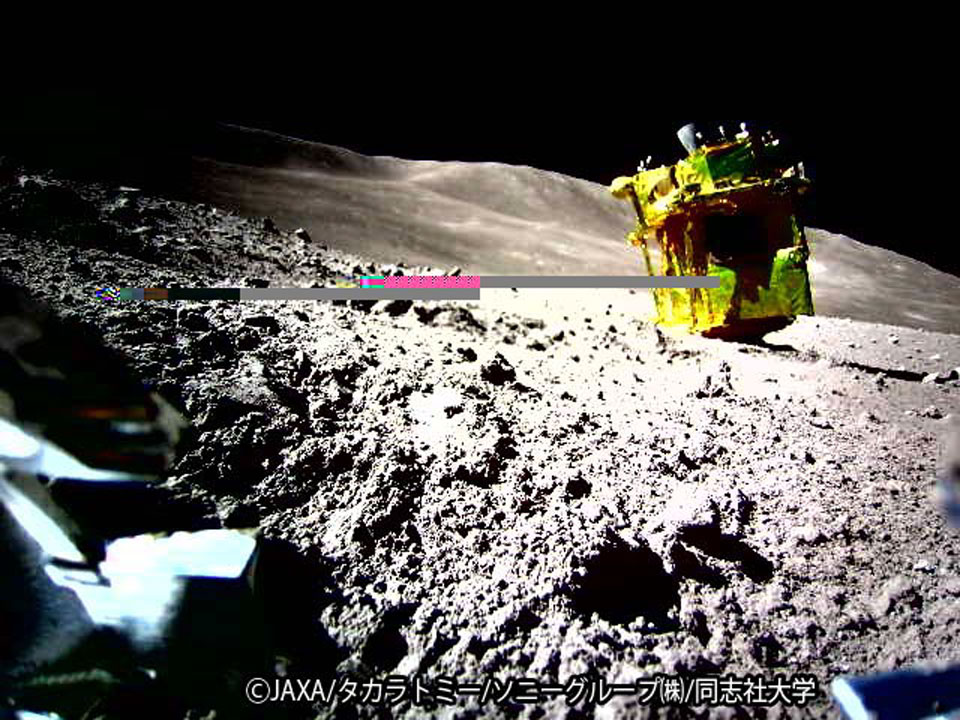
|
| Original url: https://apod.nasa.gov/apod/ap240130.html |
|
Explanation: New landers are on the Moon. Nearly two weeks ago, Japan 's Smart Lander for Investigating Moon (SLIM) released two rovers as it descended, before its main lander touched down itself. The larger of the two rovers can hop like a frog , while the smaller rover is about the size of a baseball and can move after pulling itself apart like a transformer . The main lander, nicknamed Moon Sniper, is seen in the featured image taken by the smaller rover. Inspection of the image shows that Moon Sniper 's thrusters are facing up, meaning that the lander is upside down from its descent configuration and on its side from its intended landing configuration . One result is that Moon Sniper 's solar panel s are not in the expected orientation , so that powering the lander had to be curtailed and adapted. SLIM 's lander has already succeeded as a technology demonstration , its main mission, but was not designed to withstand the lunar night -- which starts tomorrow . |
2024/01/29
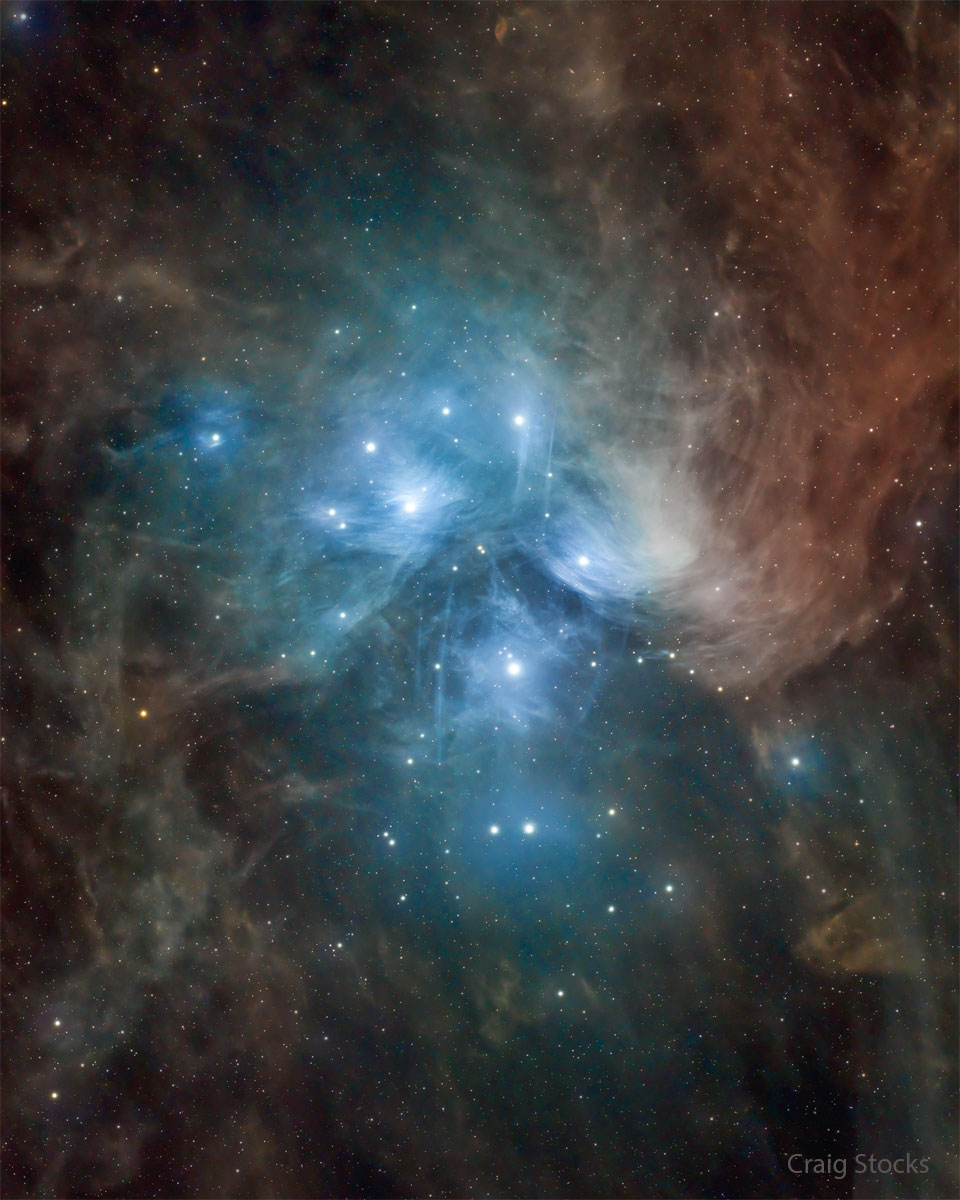
|
| Original url: https://apod.nasa.gov/apod/ap240129.html |
|
Explanation: The well-known Pleiades star cluster is slowly destroying part of a passing cloud of gas and dust. The Pleiades is the brightest open cluster of stars on Earth's sky and can be seen from almost any northerly location with the unaided eye . Over the past 100,000 years, a field of gas and dust is moving by chance right through the Pleiades star cluster and is causing a strong reaction between the stars and dust. The passing cloud might be part of the Radcliffe wave , a newly discovered structure of gas and dust connecting several regions of star formation in the nearby part of our Milky Way galaxy . Pressure from the stars' light significantly repels the dust in the surrounding blue reflection nebula , with smaller dust particles being repelled more strongly. A short-term result is that parts of the dust cloud have become filamentary and stratified . The featured deep image incorporates nearly 9 hours of exposure and was captured from Utah Desert Remote Observatory in Utah , USA , last year. |
2024/01/28
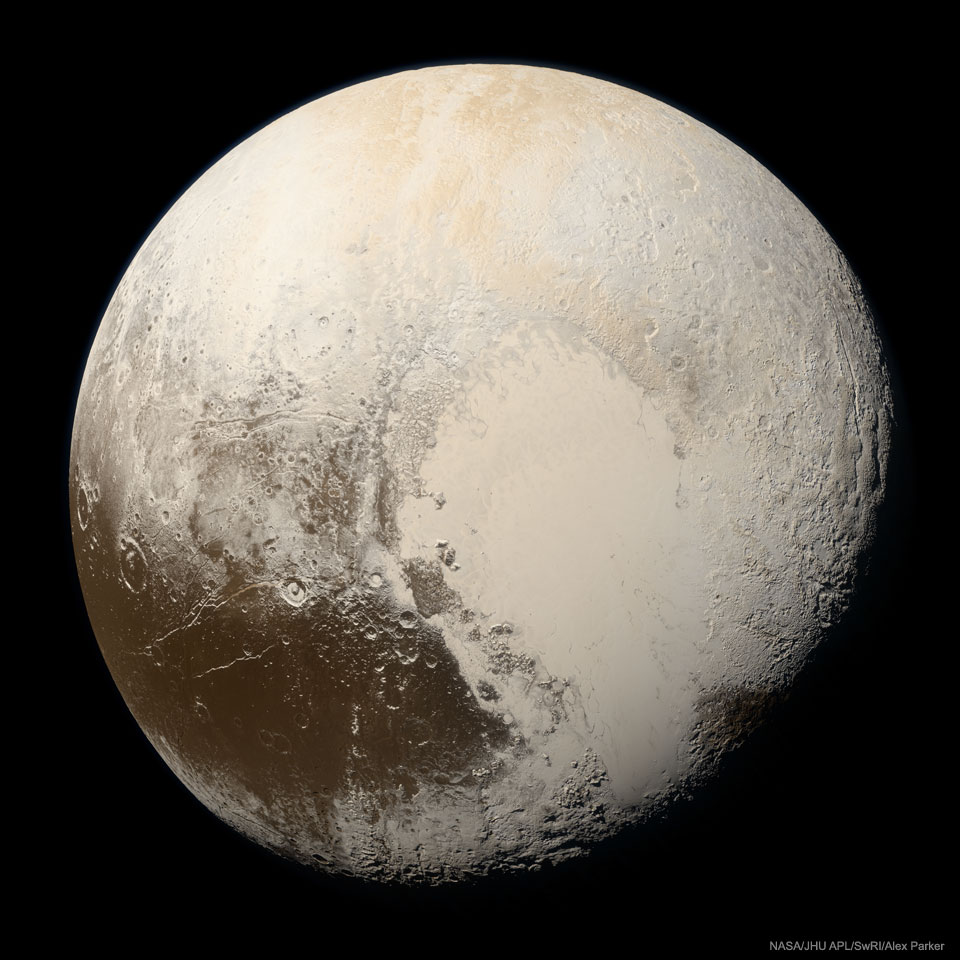
|
| Original url: https://apod.nasa.gov/apod/ap240128.html |
|
Explanation: What color is Pluto, really? It took some effort to figure out. Even given all of the images sent back to Earth when the robotic New Horizons spacecraft sped past Pluto in 2015, processing these multi-spectral frames to approximate what the human eye would see was challenging. The result featured here , released three years after the raw data was acquired by New Horizons , is the highest resolution true color image of Pluto ever taken. Visible in the image is the light-colored, heart-shaped, Tombaugh Regio , with the unexpectedly smooth Sputnik Planitia , made of frozen nitrogen , filling its western lobe. New Horizons found the dwarf planet to have a surprisingly complex surface composed of many regions having perceptibly different hues . In total, though, Pluto is mostly brown , with much of its muted color originating from small amounts of surface methane energized by ultraviolet light from the Sun. |
2024/01/27
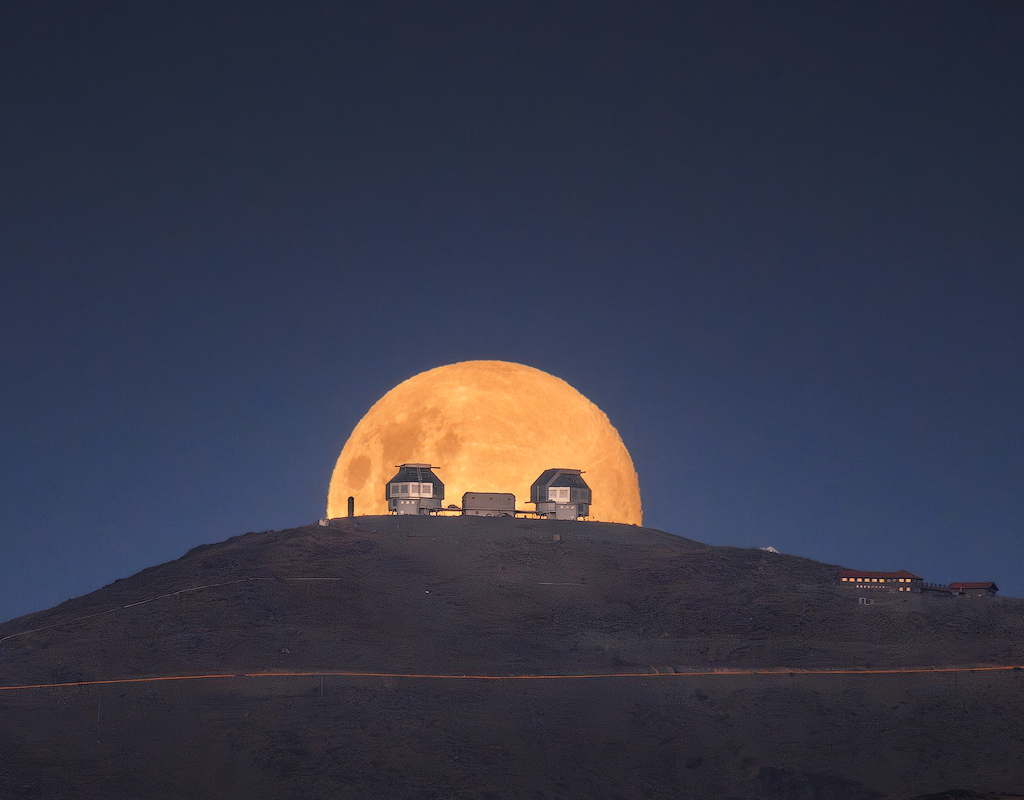
|
| Original url: https://apod.nasa.gov/apod/ap240127.html |
|
Explanation: A popular name for January's full moon in the northern hemisphere is the Full Wolf Moon. As the new year's first full moon, it rises over Las Campanas Observatory in this dramatic Earth-and-moonscape . Peering from the foreground like astronomical eyes are the observatory's twin 6.5 meter diameter Magellan telescopes. The snapshot was captured with telephoto lens across rugged terrain in the Chilean Atacama Desert, taken at a distance of about 9 miles from the observatory and about 240,000 miles from the lunar surface . Of course the first full moon of the lunar new year , known to some as the Full Snow Moon, will rise on February 24. |
2024/01/26

|
| Original url: https://apod.nasa.gov/apod/ap240126.html |
|
Explanation: Epsilon Tauri lies 146 light-years away. A K-type red giant star, epsilon Tau is cooler than the Sun, but with about 13 times the solar radius it has nearly 100 times the solar luminosity. A member of the Hyades open star cluster the giant star is known by the proper name Ain , and along with brighter giant star Aldebaran, forms the eyes of Taurus the Bull. Surrounded by dusty, dark clouds in Taurus, epsilon Tau is also known to have a planet. Discovered by radial velocity measurements in 2006, Epsilon Tauri b is a gas giant planet larger than Jupiter with an orbital period of 1.6 years. And though the exoplanet can't be seen directly, on a dark night its parent star epsilon Tauri is easily visible to the unaided eye. |
2024/01/25
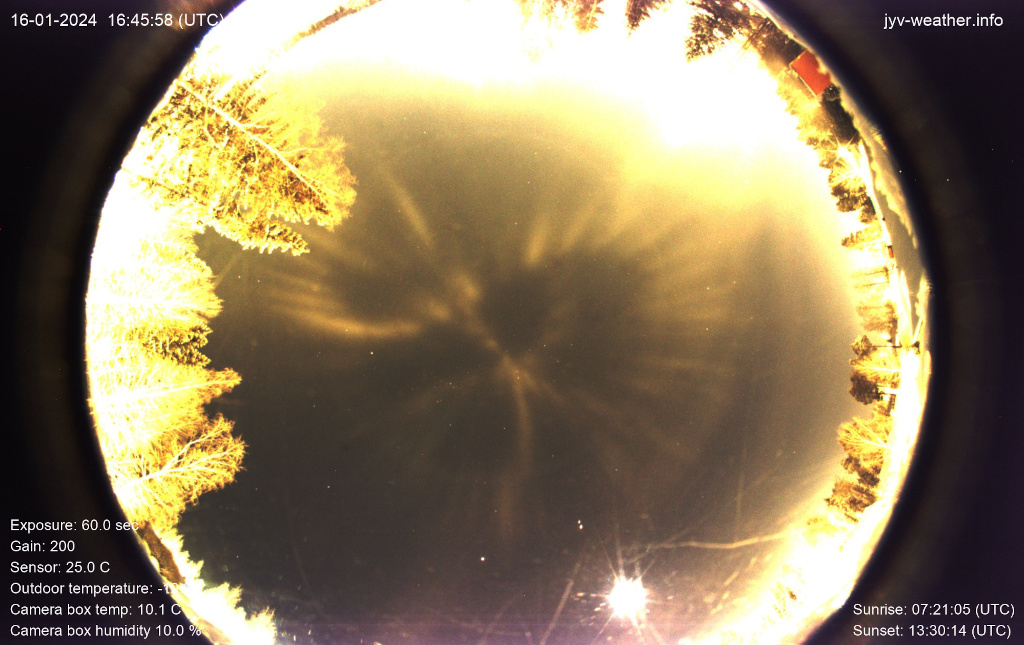
|
| Original url: https://apod.nasa.gov/apod/ap240125.html |
|
Explanation: You might not immediately recognize this street map of a neighborhood in Jyväskylä , Finland, planet Earth . But that's probably because the map was projected into the night sky and captured with an allsky camera on January 16. The temperature recorded on that northern winter night was around minus 20 degrees Celsius. As ice crystals formed in the atmosphere overhead, street lights spilling illumination into the sky above produced visible light pillars , their ethereal appearance due to specular reflections from the fluttering crystals' flat surfaces. Of course, the projected light pillars trace a map of the brightly lit local streets, though reversed right to left in the upward looking camera's view. This light pillar street map was seen to hover for hours in the Jyväskylä night . |
2024/01/24

|
| Original url: https://apod.nasa.gov/apod/ap240124.html |
|
Explanation: What do the Earth and Moon look like from beyond the Moon? Although frequently photographed together , the familiar duo was captured with this unusual perspective in late 2022 by the robotic Orion spacecraft of NASA 's Artemis I mission as it looped around Earth's most massive satellite and looked back toward its home world. Since our Earth is about four times the diameter of the Moon , the satellite’s seemingly large size was caused by the capsule being closer to the smaller body. Artemis II , the next launch in NASA’s Artemis series, is currently scheduled to take people around the Moon in 2025, while Artemis III is planned to return humans to lunar surface in late 2026. Last week, JAXA 's robotic SLIM spacecraft , launched from Japan , landed on the Moon and released two hopping rovers. |
2024/01/23
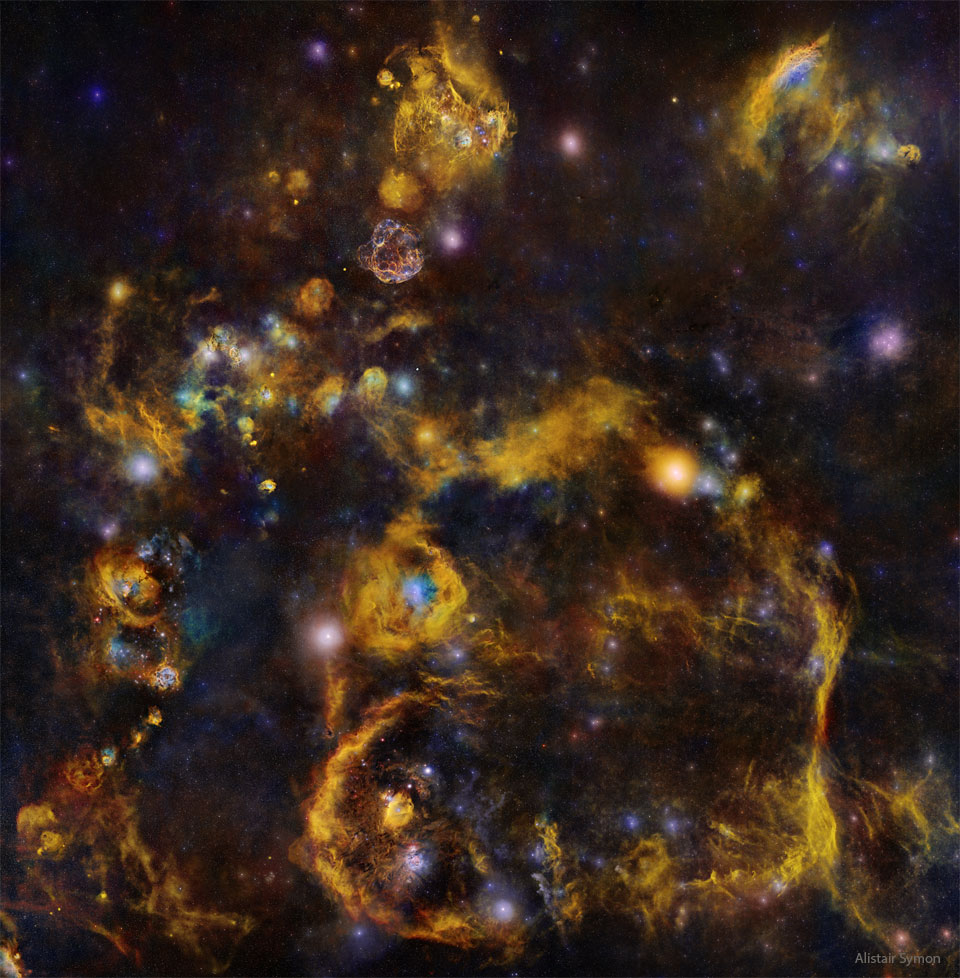
|
| Original url: https://apod.nasa.gov/apod/ap240123.html |
|
Explanation: How well do you know the night sky? OK, but how well can you identify famous sky objects in a very deep image? Either way, here is a test: see if you can find some well-known night-sky icons in a deep image filled with faint nebulosity. This image contains the Pleiades star cluster , Barnard's Loop , Horsehead Nebula , Orion Nebula , Rosette Nebula , Cone Nebula , Rigel , Jellyfish Nebula , Monkey Head Nebula , Flaming Star Nebula , Tadpole Nebula , Aldebaran , Simeis 147 , Seagull Nebula and the California Nebula . To find their real locations, here is an annotated image version . The reason this task might be difficult is similar to the reason it is initially hard to identify familiar constellations in a very dark sky : the tapestry of our night sky has an extremely deep hidden complexity . The featured composite reveals some of this complexity in a mosaic of 28 images taken over 800 hours from dark skies over Arizona , USA . |
2024/01/22
|
|
| Original url: https://apod.nasa.gov/apod/ap240122.html |
|
Explanation: Can the Moon and a mountain really cast similar shadows? Yes, but the division between light and dark does not have to be aligned. Pictured, a quarter moon was captured above the mountain Grivola in Italy in early October of 2022. The Sun is to the right of the featured picturesque landscape , illuminating the right side of the Moon in a similar way that it illuminates the right side of the mountain. This lunar phase is called " quarter " because the lit fraction visible from Earth is one quarter of the entire lunar surface. Digital post-processing of this single exposure gave both gigantic objects more prominence. Capturing the terminator of this quarter moon in close alignment with nearly vertical mountain ridge required careful timing because the Earth rotates once a day. |
2024/01/21
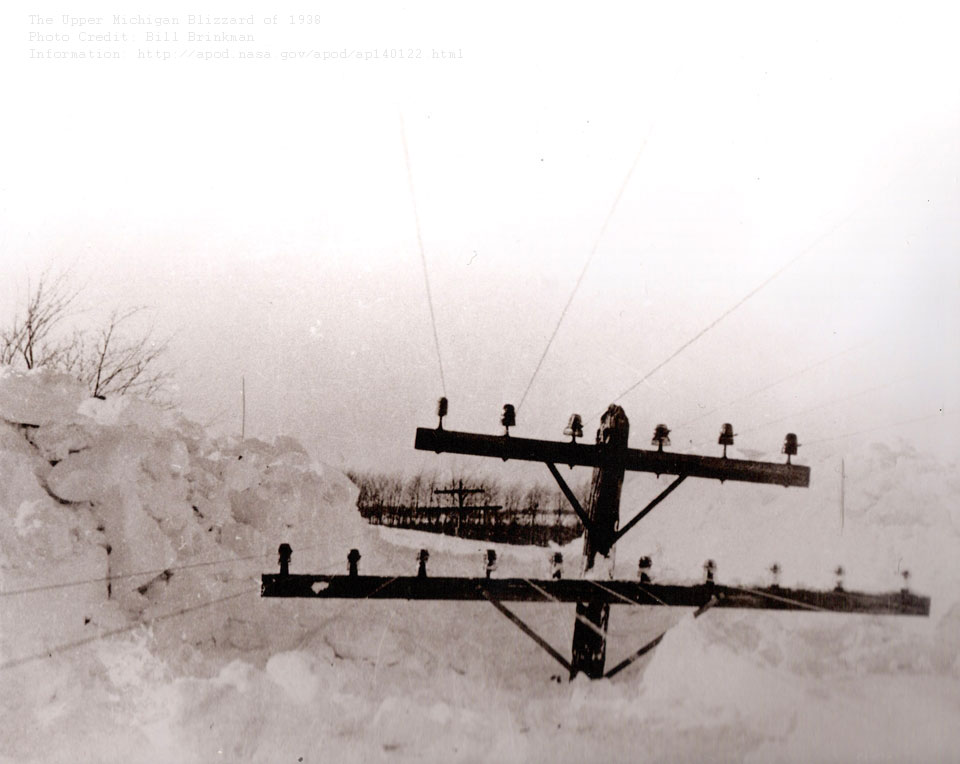
|
| Original url: https://apod.nasa.gov/apod/ap240121.html |
|
Explanation: Yes, but can your blizzard do this? In the Upper Peninsula of Michigan 's Storm of the Century in 1938, some snow drifts reached the level of utility poles . Nearly a meter of new and unexpected snow fell over two days in a storm that started 86 years ago this week. As snow fell and gale-force winds piled snow to surreal heights , many roads became not only impassable but unplowable; people became stranded, cars, school buses and a train became mired, and even a dangerous fire raged . Two people were killed and some student s were forced to spend several consecutive days at school. The featured image was taken by a local resident soon after the storm . Although all of this snow eventually melted , repeated snow storms like this help build lasting glaciers in snowy regions of our planet Earth . |
2024/01/20
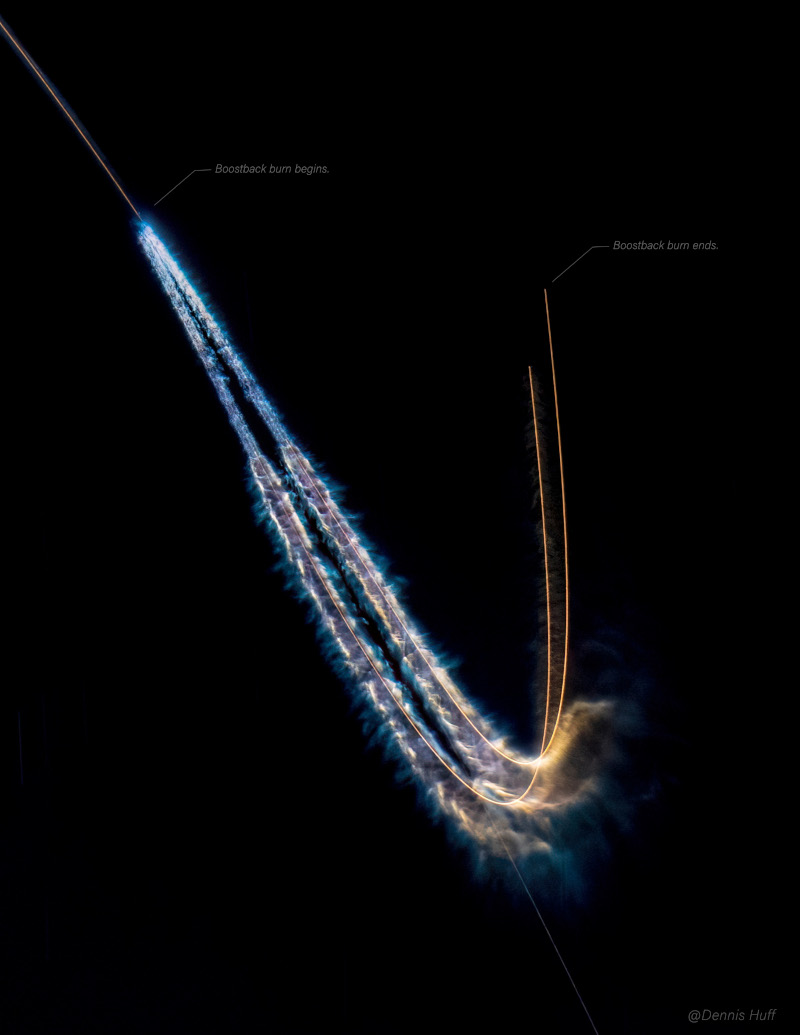
|
| Original url: https://apod.nasa.gov/apod/ap240120.html |
|
Explanation: The December 28 night launch of a Falcon Heavy rocket from Kennedy Space Center in Florida marked the fifth launch for the rocket's reusable side boosters. About 2 minutes 20 seconds into the flight, the two side boosters separated from the rocket's core stage. Starting just after booster separation, this three minute long exposure captures the pair's remarkable boostback burns , maneuvers executed prior to their return to landing zones on planet Earth. While no attempt was made to recover the Falcon Heavy's core stage, both side boosters landed successfully and can be flown again . The four previous flights for these side boosters included last October's launch of NASA's asteroid-bound Psyche mission . |
2024/01/19
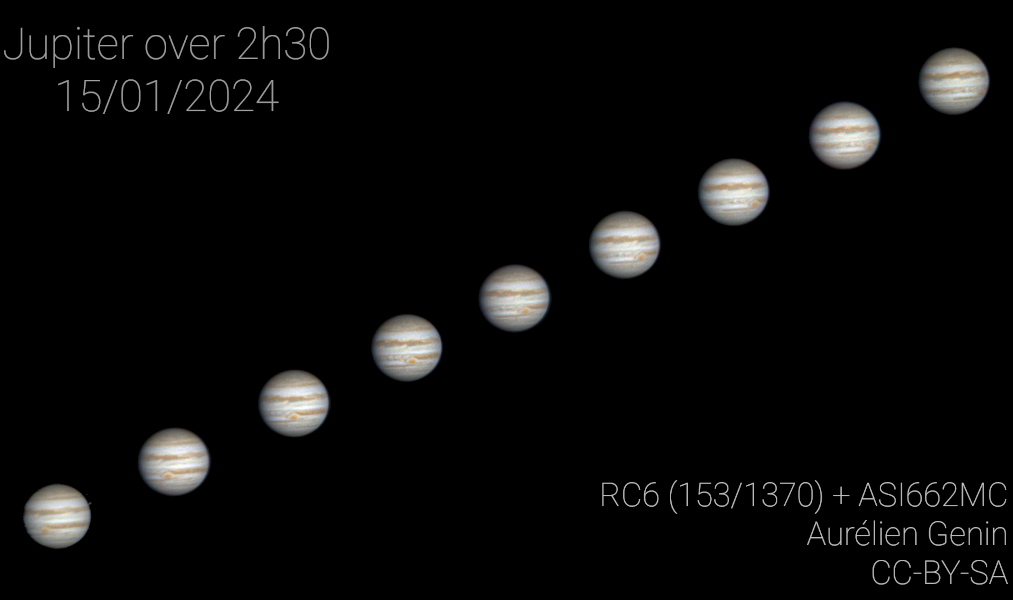
|
| Original url: https://apod.nasa.gov/apod/ap240119.html |
|
Explanation: Jupiter, our Solar System's ruling gas giant, is also the fastest spinning planet , rotating once in less than 10 hours. The gas giant doesn't rotate like a solid body though. A day on Jupiter is about 9 hours and 56 minutes long at the poles, decreasing to 9 hours and 50 minutes near the equator. The giant planet's fast rotation creates strong jet streams , separating its clouds into planet girdling bands of dark belts and bright zones. You can easily follow Jupiter's rapid rotation in this sharp sequence of images from the night of January 15, all taken with a camera and small telescope outside of Paris, France. Located just south of the equator, the giant planet's giant storm system, also known as the Great Red Spot , can be seen moving left to right with the planet's rotation. From lower left to upper right, the sequence spans about 2 hours and 30 minutes. |
2024/01/18
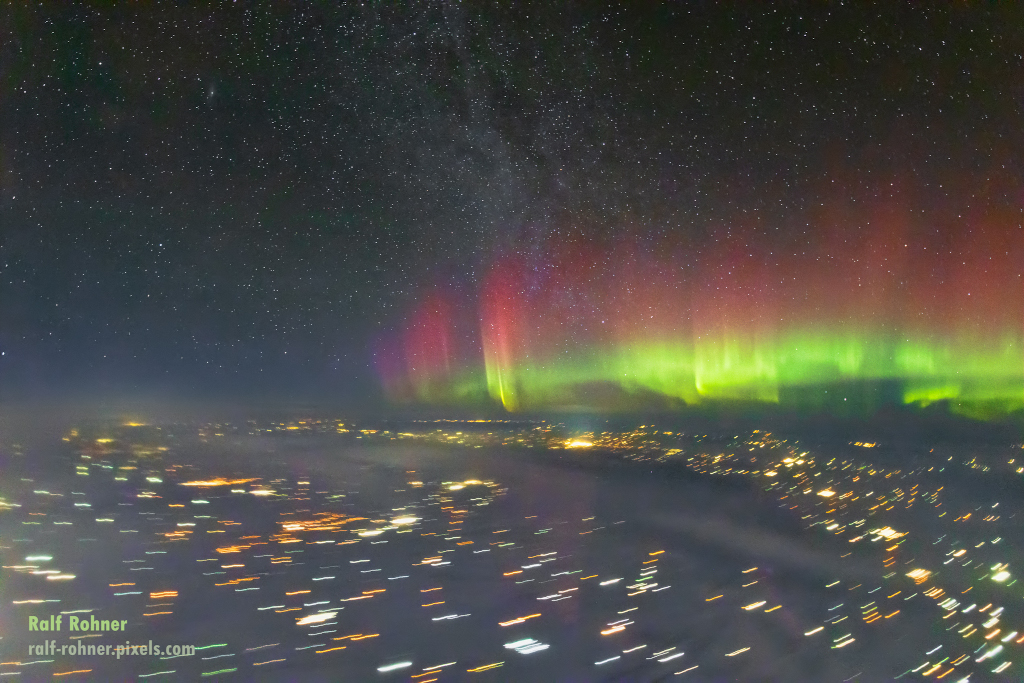
|
| Original url: https://apod.nasa.gov/apod/ap240118.html |
|
Explanation: Northern lights shine in this night skyview from planet Earth's stratosphere, captured on January 15. The single, 5 second exposure was made with a hand-held camera on board an aircraft above Winnipeg, Canada. During the exposure, terrestrial lights below leave colorful trails along the direction of motion of the speeding aircraft. Above the more distant horizon, energetic particles accelerated along Earth's magnetic field at the planet's polar regions excite atomic oxygen to create the shimmering display of Aurora Borealis . The aurora's characteristic greenish hue is generated at altitudes of 100-300 kilometers and red at even higher altitudes and lower atmospheric densities. The luminous glow of faint stars along the plane of our Milky Way galaxy arcs through the night, while the Andromeda galaxy extends this northern skyview to extragalactic space. A diffuse hint of Andromeda, the closest large spiral to the Milky Way, can just be seen to the upper left. |
2024/01/17

|
| Original url: https://apod.nasa.gov/apod/ap240117.html |
|
Explanation: Get out your red/blue glasses and check out this stereo view of another world. The scene was recorded by Apollo 17 mission commander Eugene Cernan on December 11, 1972, one orbit before descending to land on the Moon. The stereo anaglyph was assembled from two photographs ( AS17-147-22465, AS17-147-22466 ) captured from his vantage point on board the Lunar Module Challenger as he and Dr. Harrison Schmitt flew over Apollo 17's landing site in the Taurus-Littrow Valley . The broad, sunlit face of the mountain dubbed South Massif rises near the center of the frame , above the dark floor of Taurus-Littrow to its left. Piloted by Ron Evans, the Command Module America is visible in orbit in the foreground against the South Massif's peak . Beyond the mountains, toward the lunar limb, lies the Moon's Mare Serenitatis . Four astronauts will venture around the Moon and back again on the Artemis II mission , scheduled for launch no earlier than September 2025. |
2024/01/16
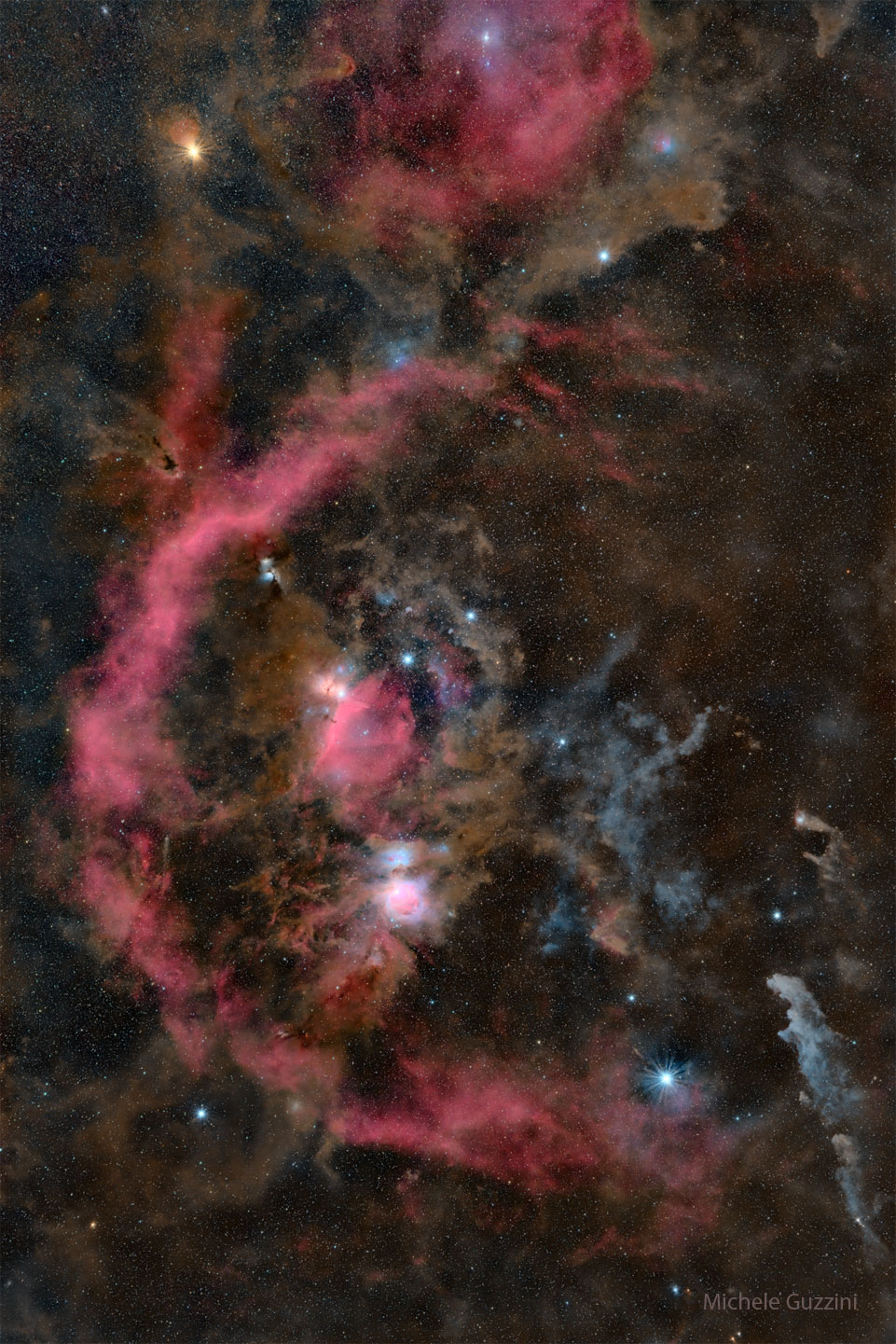
|
| Original url: https://apod.nasa.gov/apod/ap240116.html |
|
Explanation: Do you recognize this constellation? Although it is one of the most recognizable star groupings on the sky, this is a more full Orion than you can see -- an Orion only revealed with long exposure digital camera imaging and post - processing . Here the cool red giant Betelgeuse takes on a strong orange tint as the brightest star on the upper left. Orion 's hot blue stars are numerous, with supergiant Rigel balancing Betelgeuse on the lower right, and Bellatrix at the upper right. Lined up in Orion's belt are three stars all about 1,500 light-years away, born from the constellation's well-studied interstellar clouds . Just below Orion's belt is a bright but fuzzy patch that might also look familiar -- the stellar nursery known as Orion's Nebula . Finally, just barely visible to the unaided eye but quite striking here is Barnard's Loop -- a huge gaseous emission nebula surrounding Orion's Belt and Nebula discovered over 100 years ago by the pioneering Orion photographer E. E. Barnard . |
2024/01/15
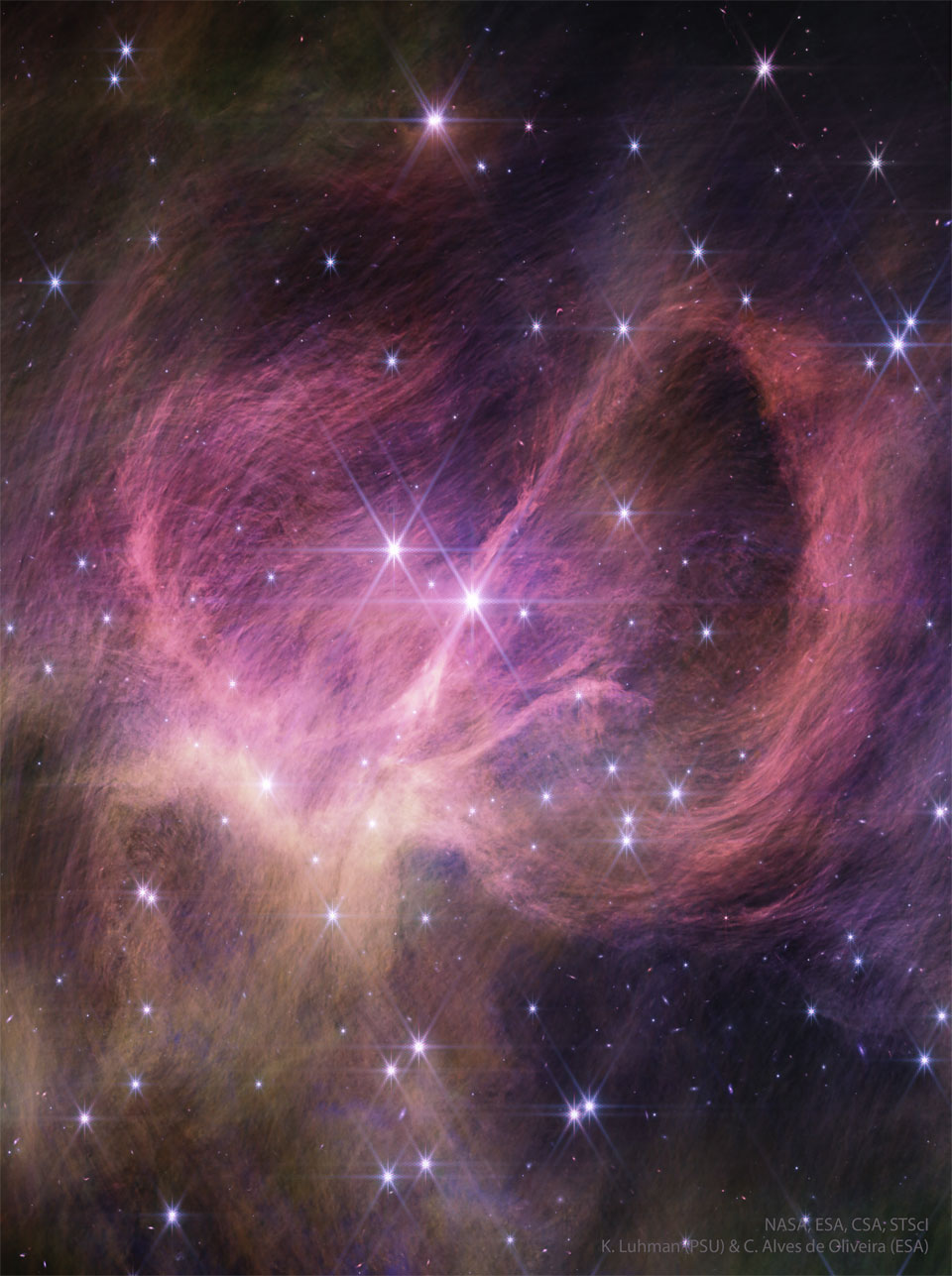
|
| Original url: https://apod.nasa.gov/apod/ap240115.html |
|
Explanation: Sometimes, it's the stars that are the hardest to see that are the most interesting. IC 348 is a young star cluster that illuminates surrounding filamentary dust. The stringy and winding dust appears pink in this recently released infrared image from the Webb Space Telescope . In visible light , this dust reflects mostly blue light, giving the surrounding material the familiar blue hue of a reflection nebula. Besides bright stars, several cool objects have been located in IC 348, visible because they glow brighter in infrared light . These objects are hypothesized to be low mass brown dwarfs . Evidence for this includes the detection of an unidentified atmospheric chemical, likely a hydrocarbon, seen previously in the atmosphere of Saturn . These objects appear to have masses slightly greater than known planets, only a few times greater than Jupiter . Together, these indicate that this young star cluster contains something noteworthy -- young planet-mass brown dwarfs that float free, not orbiting any other star. |
2024/01/14
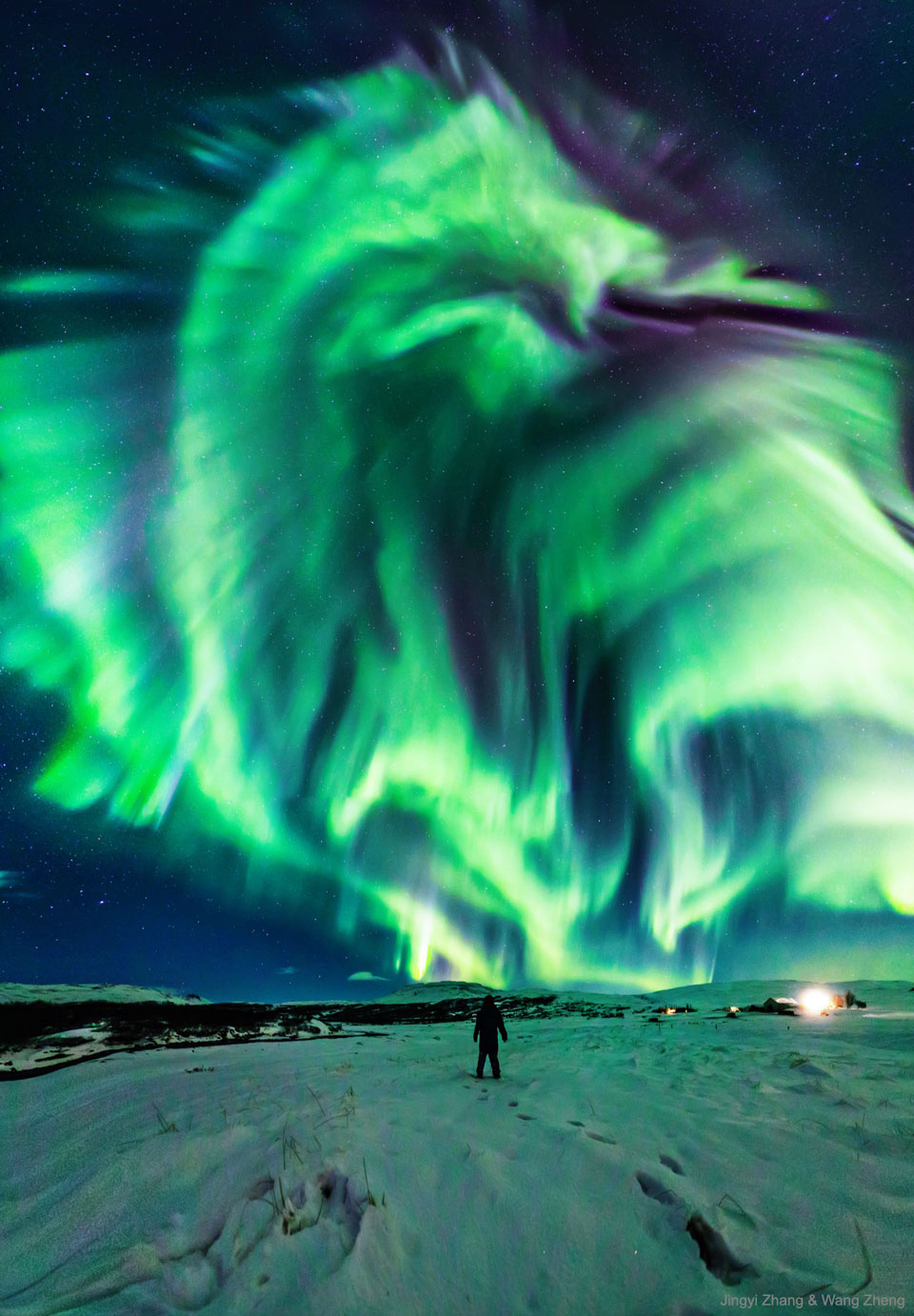
|
| Original url: https://apod.nasa.gov/apod/ap240114.html |
|
Explanation: Have you ever seen a dragon in the sky? Although real flying dragons don't exist, a huge dragon-shaped aurora developed in the sky over Iceland in 2019 . The aurora was caused by a hole in the Sun's corona that expelled charged particles into a solar wind that followed a changing interplanetary magnetic field to Earth's magnetosphere . As some of those particles then struck Earth's atmosphere , they excited atoms which subsequently emitted light: aurora. This iconic display was so enthralling that the photographer's mother ran out to see it and was captured in the foreground. Our active Sun continues to show an unusually high number of prominences , filaments , sunspots , and large active regions as solar maximum approaches in 2025. |
2024/01/13

|
| Original url: https://apod.nasa.gov/apod/ap240113.html |
|
Explanation: Earth's orbit around the Sun is not a circle, it's an ellipse. The point along its elliptical orbit where our fair planet is closest to the Sun is called perihelion. This year, perihelion was on January 2 at 01:00 UTC, with the Earth about 3 million miles closer to the Sun than it was at aphelion (last July 6), the farthest point in its elliptical orbit. Of course, distance from the Sun doesn't determine the seasons , and it doesn't the determine size of Sun halos. Easier to see with the Sun hidden behind a tall tree trunk, this beautiful ice halo forms a 22 degree-wide circle around the Sun, recorded while strolling through the countryside near Heroldstatt, Germany. The Sun halo's 22 degree angular diameter is determined by the six-sided geometry of water ice crystals drifting high in planet Earth's atmosphere. |
2024/01/12

|
| Original url: https://apod.nasa.gov/apod/ap240112.html |
|
Explanation: Yesterday, the Moon was New . But on January 9, early morning risers around planet Earth were treated to the sight of an old Moon, low in the east as the sky grew bright before dawn . Above the city of Saarburg in Rhineland-Palatinate, western Germany, this simple snapshot found the waning Moon's sunlit crescent just before sunrise. But also never wandering far from the Sun in Earth's sky , inner planets Venus and Mercury shared the cold morning skyview . In the foreground are the historic city's tower and castle with ruins from the 10th century. |
2024/01/11

|
| Original url: https://apod.nasa.gov/apod/ap240111.html |
|
Explanation: Named for a forgotten constellation , the Quadrantid Meteor Shower puts on an annual show for planet Earth's northern hemisphere skygazers. The shower's radiant on the sky lies within the old, astronomically obsolete constellation Quadrans Muralis . That location is not far from the Big Dipper asterism, known to some as the Plough , at the boundaries of the modern constellations Bootes and Draco. In fact the Big Dipper "handle" stars are near the upper right corner in this frame, with the meteor shower radiant just below. North star Polaris is toward the top left. Pointing back toward the radiant, Quadrantid meteors streak through the night in this skyscape from Jangsu, South Korea. The composite image was recorded in the hours around the shower's peak on January 4, 2024. A likely source of the dust stream that produces Quadrantid meteors was identified in 2003 as an asteroid . |
2024/01/10

|
| Original url: https://apod.nasa.gov/apod/ap240110.html |
|
Explanation: This colorful skyscape spans about three full moons across nebula rich starfields along the plane of our Milky Way Galaxy toward the royal northern constellation Cepheus . Near the edge of the region's massive molecular cloud some 2,400 light-years away, bright reddish emission region Sharpless (Sh)2-155 is at the center of the frame, also known as the Cave Nebula . About 10 light-years across the cosmic cave's bright walls of gas are ionized by ultraviolet light from the hot young stars around it. Dusty bluish reflection nebulae, like vdB 155 at the left, and dense obscuring clouds of dust also abound on the interstellar canvas. Astronomical explorations have revealed other dramatic signs of star formation , including the bright reddish fleck of Herbig-Haro (HH) 168. At the upper left in the frame, the Herbig-Haro object emission is generated by energetic jets from a newborn star . |
2024/01/09

|
| Original url: https://apod.nasa.gov/apod/ap240109.html |
|
Explanation: Thor not only has his own day (Thursday), but a helmet in the heavens. Popularly called Thor's Helmet, NGC 2359 is a hat-shaped cosmic cloud with wing-like appendages. Heroically sized even for a Norse god , Thor's Helmet is about 30 light-years across. In fact, the cosmic head-covering is more like an interstellar bubble , blown with a fast wind from the bright, massive star near the bubble's center. Known as a Wolf-Rayet star , the central star is an extremely hot giant thought to be in a brief, pre- supernova stage of evolution . NGC 2359 is located about 15,000 light-years away toward the constellation of the Great Overdog . This remarkably sharp image is a mixed cocktail of data from narrowband filters , capturing not only natural looking stars but details of the nebula's filamentary structures. The star in the center of Thor's Helmet is expected to explode in a spectacular supernova sometime within the next few thousand years. |
2024/01/08

|
| Original url: https://apod.nasa.gov/apod/ap240108.html |
|
Explanation: Venus goes through phases . Just like our Moon, Venus can appear as a full circular disk, a thin crescent , or anything in between. Venus, frequently the brightest object in the post-sunset or pre-sunrise sky, appears so small, however, that it usually requires binoculars or a small telescope to clearly see its current phase. The featured time-lapse sequence was taken over the course of six months in 2015 from Surgères, Charente-Maritime , France , and shows not only how Venus changes phase, but changes angular size as well. When Venus is on the far side of the Sun from the Earth, it appears angularly smallest and nearest to full phase, while when Venus and Earth are on the same side of the Sun, Venus appears larger, but as a crescent. This month Venus rises before dawn in waxing gibbous phases . |
2024/01/07

|
| Original url: https://apod.nasa.gov/apod/ap240107.html |
|
Explanation: To some it looks like a cat's eye. To others, perhaps like a giant cosmic conch shell . It is actually one of the brightest and most highly detailed planetary nebula known, composed of gas expelled in the brief yet glorious phase near the end of life of a Sun-like star. This nebula 's dying central star may have produced the outer circular concentric shells by shrugging off outer layers in a series of regular convulsions. The formation of the beautiful, complex-yet-symmetric inner structures , however, is not well understood . The featured image is a composite of a digitally sharpened Hubble Space Telescope image with X-ray light captured by the orbiting Chandra Observatory . The exquisite floating space statue spans over half a light-year across. Of course, gazing into this Cat's Eye , humanity may well be seeing the fate of our sun, destined to enter its own planetary nebula phase of evolution ... in about 5 billion years . |
2024/01/05
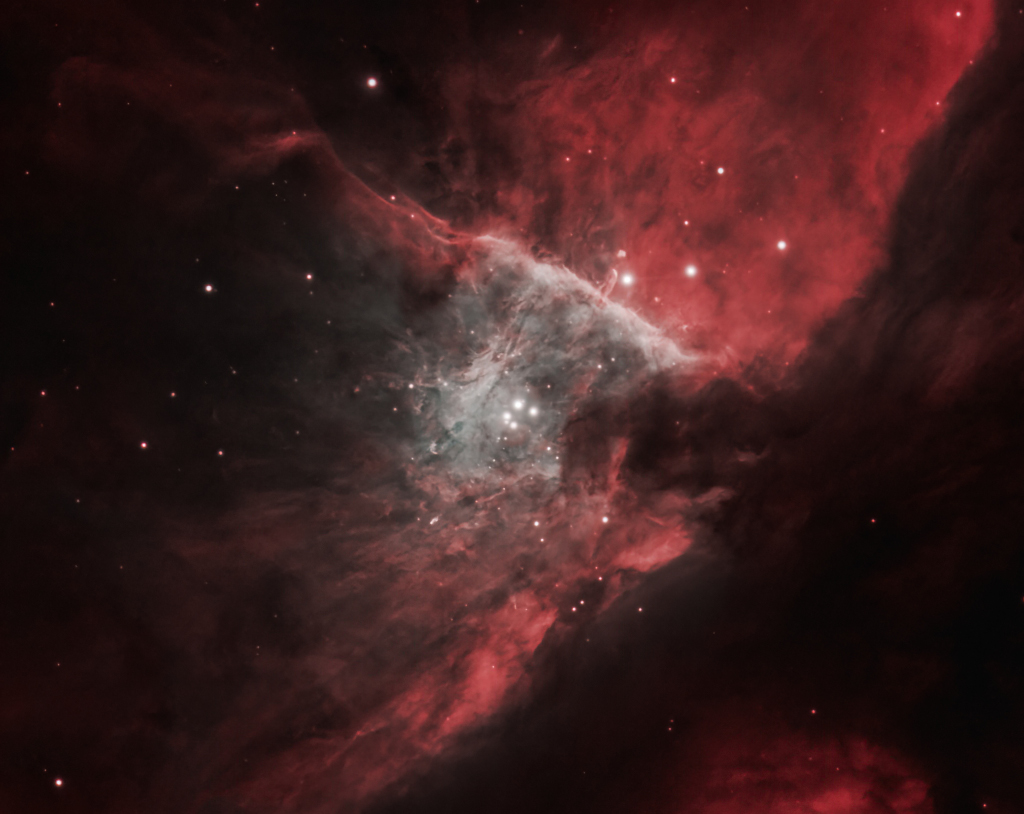
|
| Original url: https://apod.nasa.gov/apod/ap240106.html |
|
Explanation: Near the center of this sharp cosmic portrait, at the heart of the Orion Nebula , are four hot, massive stars known as the Trapezium . Gathered within a region about 1.5 light-years in radius, they dominate the core of the dense Orion Nebula Star Cluster. Ultraviolet ionizing radiation from the Trapezium stars , mostly from the brightest star Theta-1 Orionis C powers the complex star forming region's entire visible glow. About three million years old, the Orion Nebula Cluster was even more compact in its younger years and a dynamical study indicates that runaway stellar collisions at an earlier age may have formed a black hole with more than 100 times the mass of the Sun. The presence of a black hole within the cluster could explain the observed high velocities of the Trapezium stars . The Orion Nebula's distance of some 1,500 light-years would make it one of the closest known black holes to planet Earth. |
2024/01/04
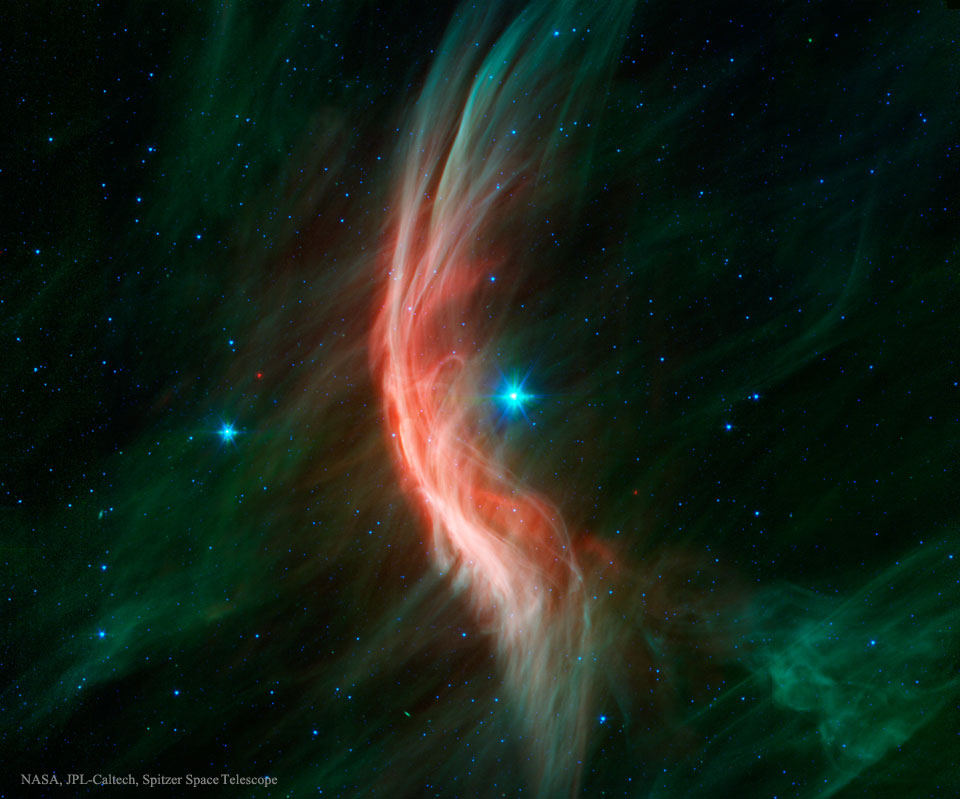
|
| Original url: https://apod.nasa.gov/apod/ap240104.html |
|
Explanation: Like a ship plowing through cosmic seas, runaway star Zeta Ophiuchi produces the arcing interstellar bow wave or bow shock seen in this stunning infrared portrait. In the false-color view, bluish Zeta Oph, a star about 20 times more massive than the Sun, lies near the center of the frame, moving toward the left at 24 kilometers per second . Its strong stellar wind precedes it, compressing and heating the dusty interstellar material and shaping the curved shock front. What set this star in motion? Zeta Oph was likely once a member of a binary star system , its companion star was more massive and hence shorter lived. When the companion exploded as a supernova catastrophically losing mass, Zeta Oph was flung out of the system. About 460 light-years away, Zeta Oph is 65,000 times more luminous than the Sun and would be one of the brighter stars in the sky if it weren't surrounded by obscuring dust . The image spans about 1.5 degrees or 12 light-years at the estimated distance of Zeta Ophiuchi . In January 2020, NASA placed the Spitzer Space Telescope in safe mode, ending its 16 successful years of exploring the cosmos . |
2024/01/03
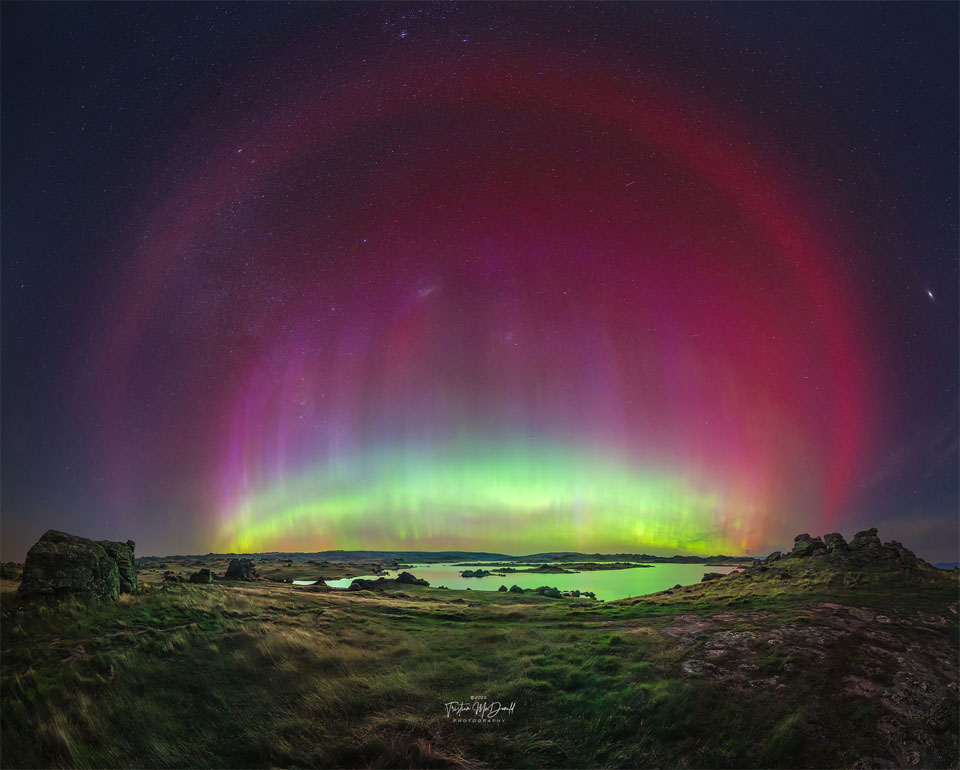
|
| Original url: https://apod.nasa.gov/apod/ap240103.html |
|
Explanation: What is that unusual red halo surrounding this aurora? It is a Stable Auroral Red (SAR) arc. SAR arc s are rare and have only been acknowledged and studied since 1954. The featured wide-angle photograph , capturing nearly an entire SAR arc surrounding more common green and red aurora, was taken earlier this month from Poolburn , New Zealand , during an especially energetic geomagnetic storm . Why SAR arcs form remains a topic of research , but is likely related to Earth's protective magnetic field , a field created by molten iron flowing deep inside the Earth . This magnetic field usually redirects incoming charged particles from the Sun's wind toward the Earth's poles. However, it also traps a ring of ions closer to the equator, where they can gain energy from the magnetosphere during high solar activity . The energetic electrons in this ion ring can collide with and excite oxygen higher in Earth's ionosphere than typical auroras , causing the oxygen to glow red. Ongoing research has uncovered evidence that a red SAR arc can even transform into a purple and green STEVE . |
2024/01/02

|
| Original url: https://apod.nasa.gov/apod/ap240102.html |
|
Explanation: Can a rocket make the Moon ripple? No, but it can make a background moon appear wavy . The rocket, in this case, was a SpaceX Falcon Heavy that blasted off from NASA 's Kennedy Space Center last week. In the featured launch picture , the rocket's exhaust plume glows beyond its projection onto the distant, rising, and nearly full moon. Oddly, the Moon's lower edge shows unusual drip-like ripples . The Moon itself , far in the distance, was really unchanged. The physical cause of these apparent ripples was pockets of relatively hot or rarefied air deflecting moonlight less strongly than pockets of relatively cool or compressed air: refraction . Although the shot was planned , the timing of the launch had to be just right for the rocket to be transiting the Moon during this single exposure. |
2024/01/01
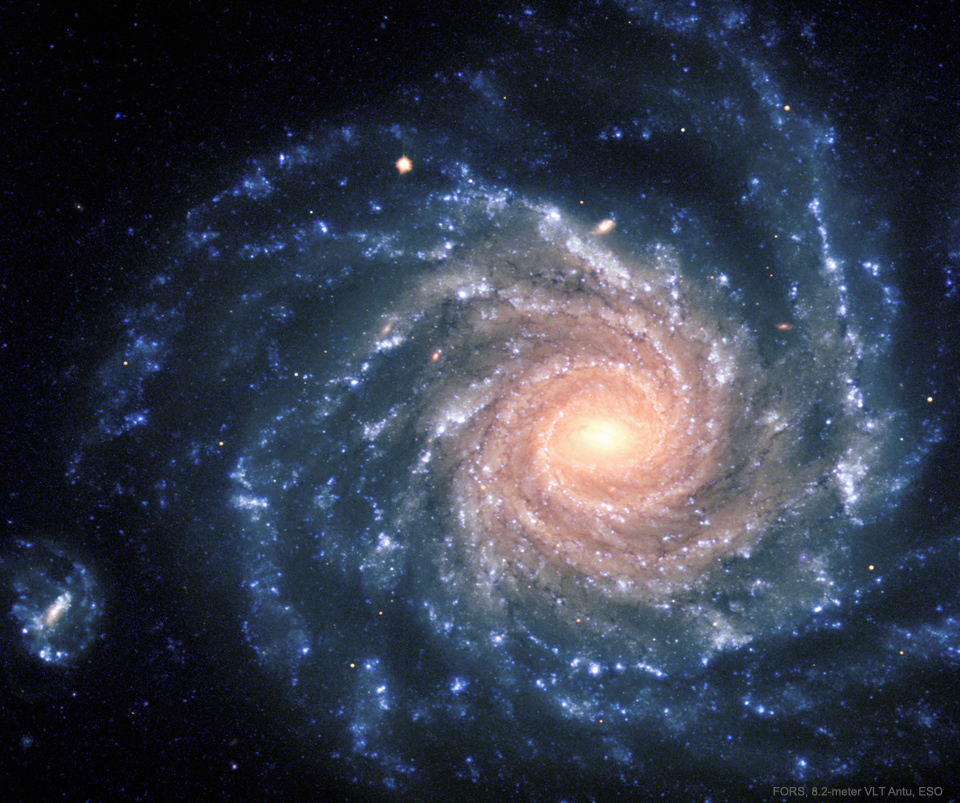
|
| Original url: https://apod.nasa.gov/apod/ap240101.html |
|
Explanation: Galaxies are fascinating not only for what is visible, but for what is invisible. Grand spiral galaxy NGC 1232 , captured in detail by one of the Very Large Telescopes , is a good example. The visible is dominated by millions of bright stars and dark dust , caught up in a gravitational swirl of spiral arms revolving about the center. Open clusters containing bright blue stars can be seen sprinkled along these spiral arms, while dark lanes of dense interstellar dust can be seen sprinkled between them. Less visible , but detectable, are billions of dim normal stars and vast tracts of interstellar gas , together wielding such high mass that they dominate the dynamics of the inner galaxy . Leading theories indicate that even greater amounts of matter are invisible, in a form we don't yet know. This pervasive dark matter is postulated, in part, to explain the motions of the visible matter in the outer regions of galaxies. |
2023/12/30

|
| Original url: https://apod.nasa.gov/apod/ap231231.html |
|
Explanation: Known to some in the northern hemisphere as December's Cold Moon or the Long Night Moon , the last full moon of 2023 is rising in this surreal mountain and skyscape. The Daliesque scene was captured in a single exposure with a camera and long telephoto lens near Monte Grappa, Italy. The full moon is not melting, though . Its stretched and distorted appearance near the horizon is caused as refraction along the line of sight changes and creates shifting images or mirages of the bright lunar disk . The changes in atmospheric refraction correspond to atmospheric layers with sharply different temperatures and densities. Other effects of atmospheric refraction produced by the long sight-line to this full moon rising include the thin red rim seen faintly on the distorted lower edge of the Moon and a thin green rim along the top. |
2023/12/29
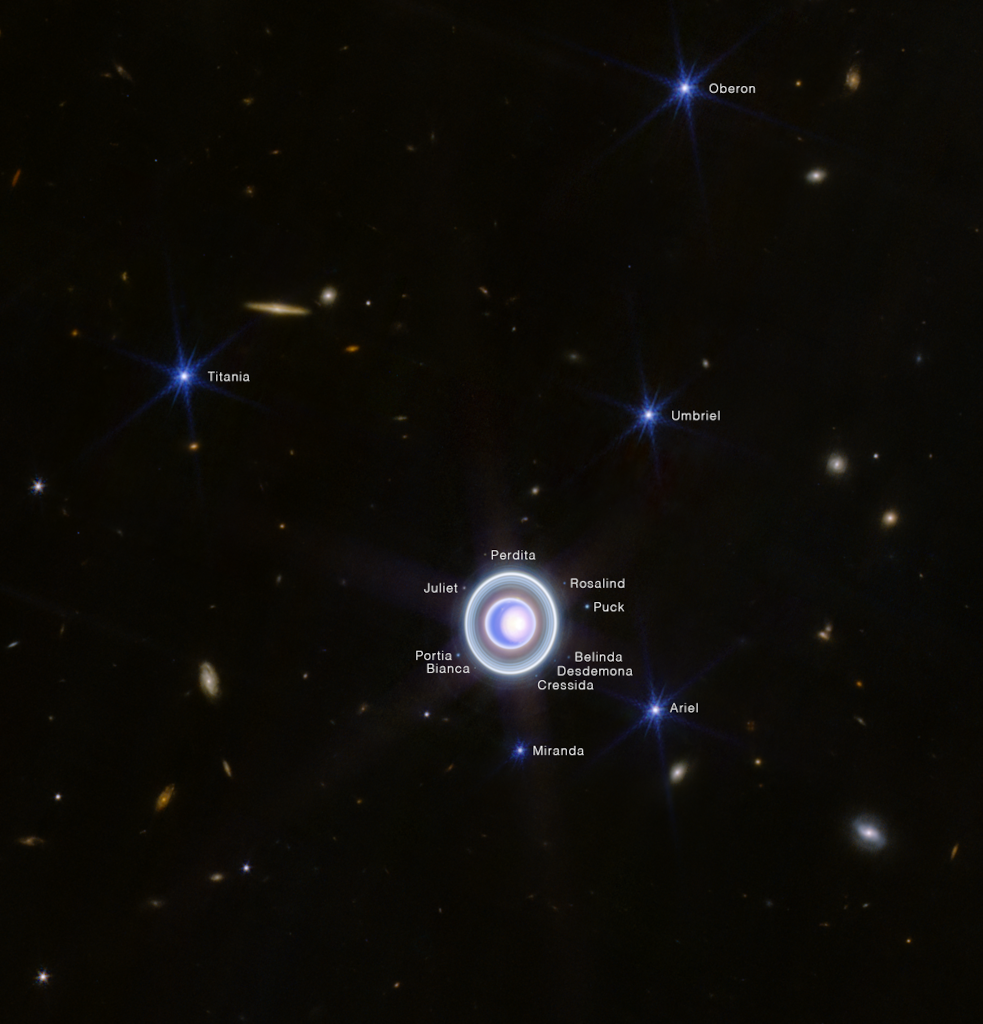
|
| Original url: https://apod.nasa.gov/apod/ap231229.html |
|
Explanation: In 1986, Voyager 2 became the only spacecraft to explore ice giant planet Uranus close up. Still, this newly released image from the NIRCam (Near-Infrared Camera) on the James Webb Space Telescope offers a detailed look at the distant world . The tilted outer planet rotates on its axis once in about 17 hours. Its north pole is presently pointed near our line of sight, offering direct views of its northern hemisphere and a faint but extensive system of rings. Of the giant planet's 27 known moons, 14 are annotated in the image . The brighter ones show hints of Webb's characteristic diffraction spikes . And though these worlds of the outer Solar System were unknown in Shakespearean times, all but two of the 27 Uranian moons are named for characters in the English Bard's plays. |
2023/12/28
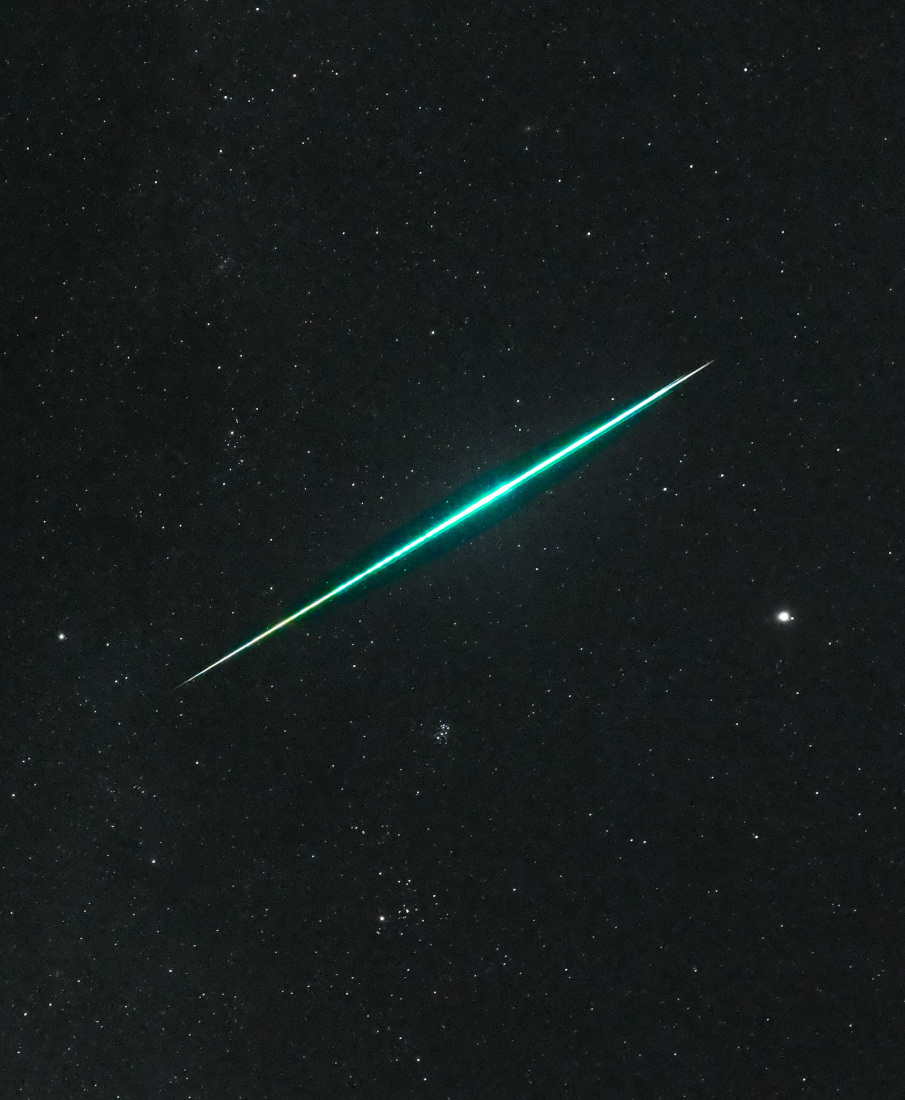
|
| Original url: https://apod.nasa.gov/apod/ap231228.html |
|
Explanation: For a brief moment , this brilliant fireball meteor outshone Jupiter in planet Earth's night. The serendipitous image was captured while hunting meteors under cold Canadian skies with a camera in timelapse mode on December 14, near the peak of the Geminid meteor shower . The Geminid meteor shower, asteroid 3200 Phaethon's annual gift , always arrives in December. Dust shed along the orbit of the mysterious asteroid causes the meteor streaks, as the vaporizing grains plow through our fair planet's upper atmosphere at 22 kilometers per second. Of course Geminid shower meteors appear to radiate from a point in the constellation of the Twins. That's below and left of this frame. With bright Jupiter on the right, also in the December night skyview are the Pleiades and Hyades star clusters. |
2023/12/27
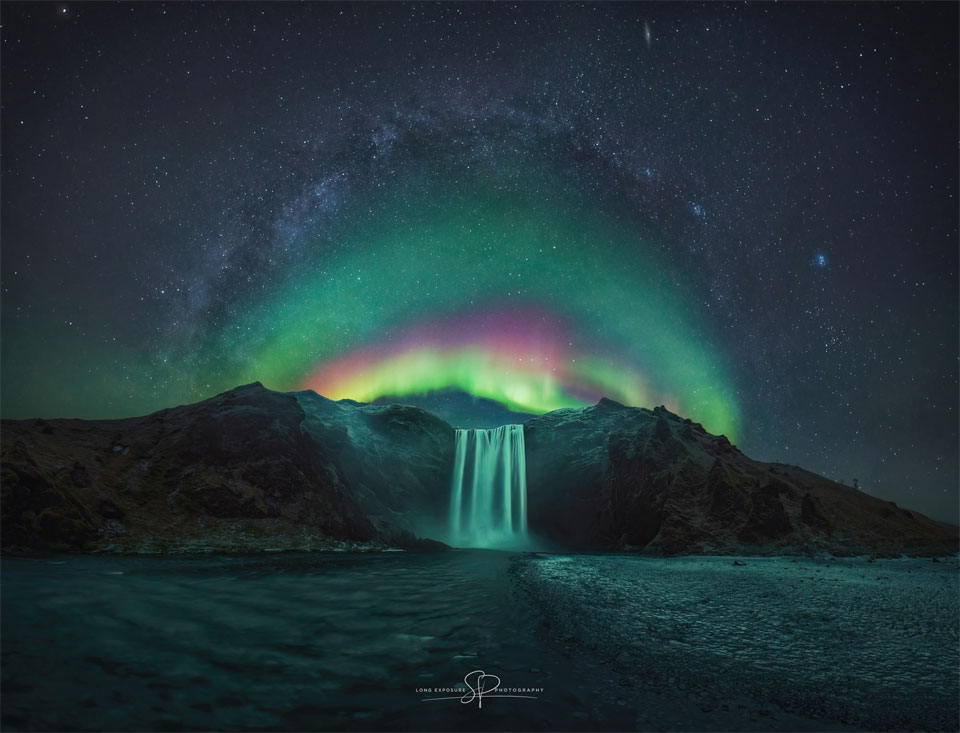
|
| Original url: https://apod.nasa.gov/apod/ap231227.html |
|
Explanation: Yes, but can your aurora do this? First, yes, auroras can look like rainbows even though they are completely different phenomena. Auroras are caused by Sun-created particles being channeled into Earth's atmosphere by Earth's magnetic field , and create colors by exciting atom s at different heights. Conversely, rainbows are created by sunlight backscattering off falling raindrops, and different colors are refracted by slightly different angles. Unfortunately , auroras can’t create waterfalls, but if you plan well and are lucky enough, you can photograph them together. The featured picture is composed of several images taken on the same night last month near the Skógafoss waterfall in Iceland . The planning centered on capturing the central band of our Milky Way galaxy over the picturesque cascade . By luck, a spectacular aurora soon appeared just below the curving arch of the Milky Way. Far in the background, the Pleiades star cluster and the Andromeda galaxy can be found. |
2023/12/26

|
| Original url: https://apod.nasa.gov/apod/ap231226.html |
|
Explanation: Why is this jellyfish swimming in a sea of stars? Drifting near bright star Eta Geminorum , seen at the right, the Jellyfish Nebula extends its tentacles from the bright arcing ridge of emission left of center. In fact, the cosmic jellyfish is part of bubble-shaped supernova remnant IC 443, the expanding debris cloud from a massive star that exploded . Light from the explosion first reached planet Earth over 30,000 years ago . Like its cousin in astronomical waters, the Crab Nebula supernova remnant IC 443 is known to harbor a neutron star -- the remnant of the collapsed stellar core. The Jellyfish Nebula is about 5,000 light-years away. At that distance, the featured image would span about 140 light-years across. |
2023/12/25
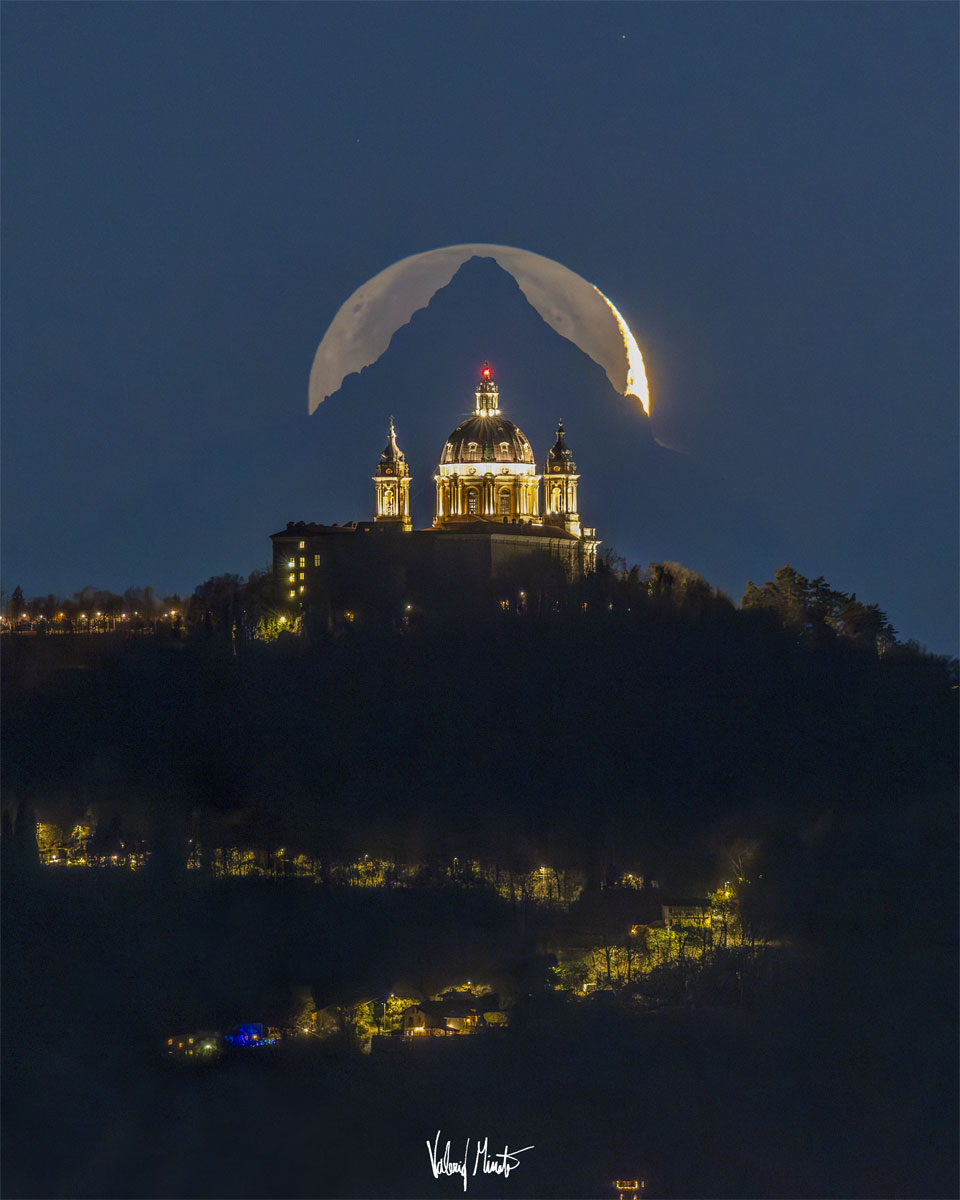
|
| Original url: https://apod.nasa.gov/apod/ap231225.html |
|
Explanation: Single shots like this require planning. The first step is to realize that such an amazing triple-alignment actually takes place. The second step is to find the best location to photograph it. But it was the third step: being there at exactly the right time -- and when the sky was clear -- that was the hardest. Five times over six years the photographer tried and found bad weather . Finally, just ten days ago, the weather was perfect, and a photographic dream was realized. Taken in Piemonte , Italy , the cathedral in the foreground is the Basilica of Superga , the mountain in the middle is Monviso , and, well, you know which moon is in the background. Here, even though the setting Moon was captured in a crescent phase , the exposure was long enough for doubly reflected Earthlight , called the da Vinci glow , to illuminate the entire top of the Moon . |
2023/12/24
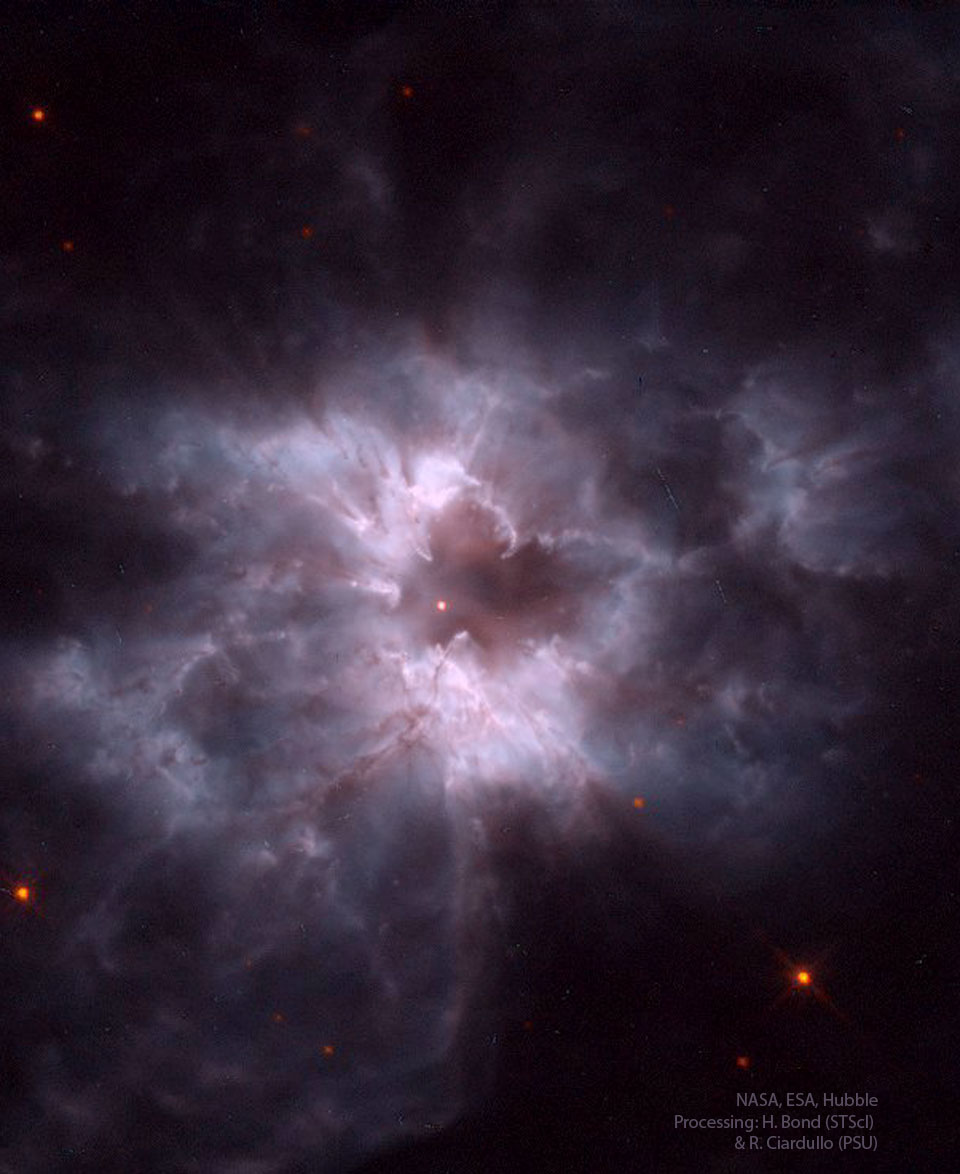
|
| Original url: https://apod.nasa.gov/apod/ap231224.html |
|
Explanation: What's that in the center? Like a butterfly , a white dwarf star begins its life by casting off a cocoon of gas that enclosed its former self. In this analogy, however, the Sun would be a caterpillar and the ejected shell of gas would become the prettiest cocoon of all. In the featured cocoon , the planetary nebula designated NGC 2440 contains one of the hottest white dwarf stars known. The white dwarf can be seen as the bright orange dot near the image center. Our Sun will eventually become a white dwarf butterfly, but not for another 5 billion years . |
2023/12/23
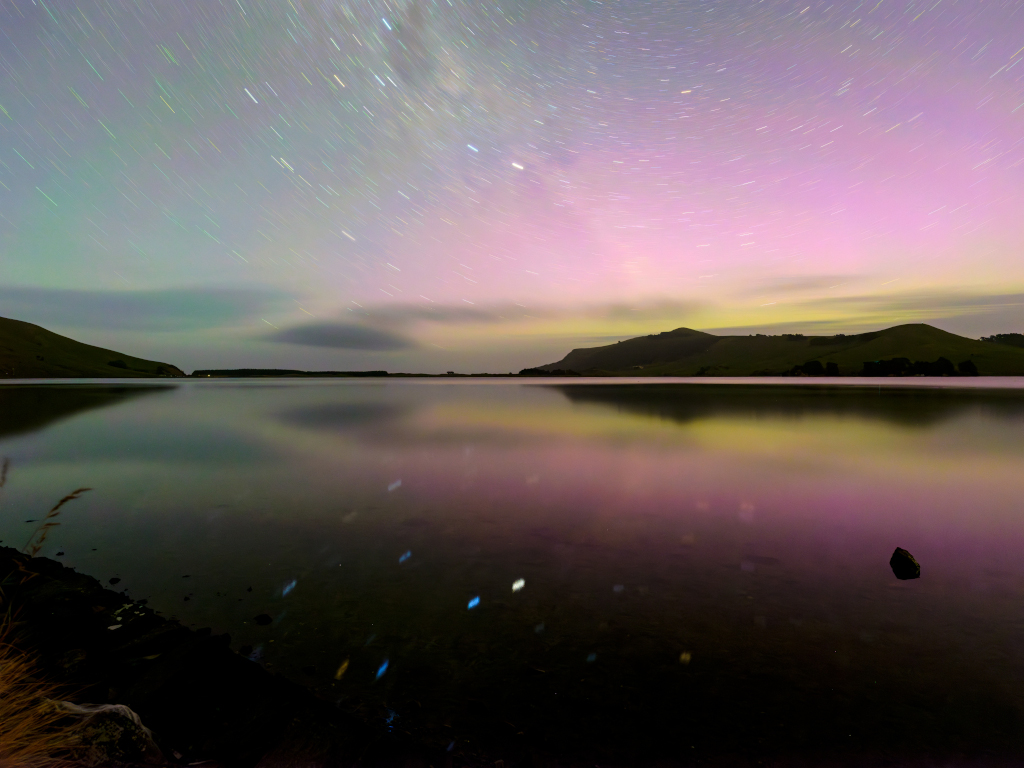
|
| Original url: https://apod.nasa.gov/apod/ap231223.html |
|
Explanation: Colours of a serene evening sky are captured in this 8 minute exposure, made near this December's solstice from New Zealand, southern hemisphere, planet Earth . Looking south, star trails form the short concentric arcs around the rotating planet's south celestial pole positioned just off the top of the frame. At top and left of center are trails of the Southern Cross stars and a dark smudge from the Milky Way's Coalsack Nebula. Alpha and Beta Centauri make the brighter yellow and blue tinted trails, reflected below in the waters of Hoopers Inlet in the Pacific coast of the South Island's Otago Peninsula. On that short December summer night, aurora australis also gave luminous, green and reddish hues to the sky above the hills. An upper atmospheric glow distinct from the aurora excited by collisions with energetic particles, pale greenish bands of airglow caused by a cascade of chemical reactions excited by sunlight can be traced in diagonal bands near the top left. |
2023/12/22

|
| Original url: https://apod.nasa.gov/apod/ap231222.html |
|
Explanation: A single 183 day exposure with a pinhole camera and photographic paper resulted in this long-duration solargraph . Recorded from solstice to solstice , June 21 to December 21, in 2022, it follows the Sun's daily arcing path through planet Earth's skies from Mertola, Portugal. On June 21, the Sun's highest point and longest arc represents the longest day and the astronomical beginning of summer in the northern hemisphere. The solstice date with the fewest hours of daylight is at the beginning of winter in the north, corresponding to the Sun's shortest and lowest arc in the 2022 solargraph. For 2023, the northern winter solstice was on December 22 at 3:27 UTC. That's December 21 for North America time zones. |
2023/12/21
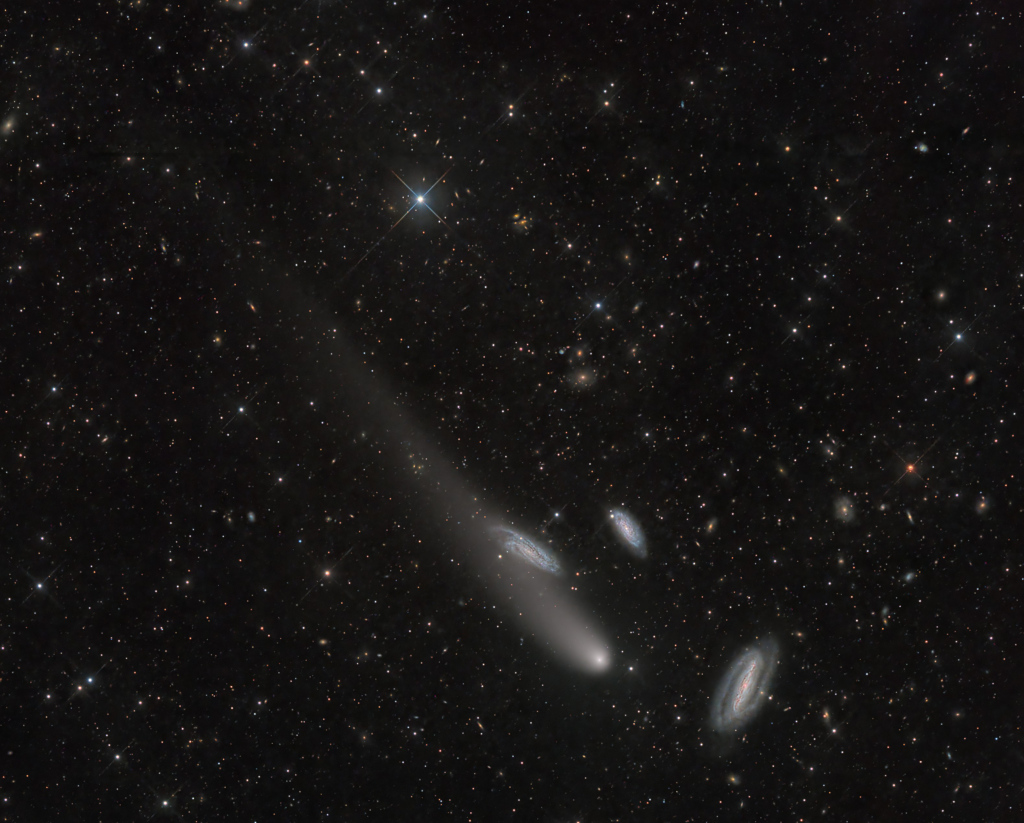
|
| Original url: https://apod.nasa.gov/apod/ap231221.html |
|
Explanation: Distant galaxies abound in this one degree wide field of view toward the southern constellation Grus (The Crane). But the three spiral galaxies at the lower right are quite striking. In fact, all three galaxies are grouped about 70 million light years away and sometimes known as the Grus Triplet . They share the pretty telescopic frame, recorded on December 13, with the comet designated C/2020 V2 ZTF . Now outbound from the inner Solar System and swinging below the ecliptic plane in a hyperbolic orbit, the comet was about 29 light-minutes from our fair planet in this image. And though comet ZTF was brighter when it was closest to the Sun last May and closest to Earth in September of 2023, it still shines in telescopes pointed toward southern night skies, remaining almost as bright as the Grus Triplet galaxies. |
2023/12/20
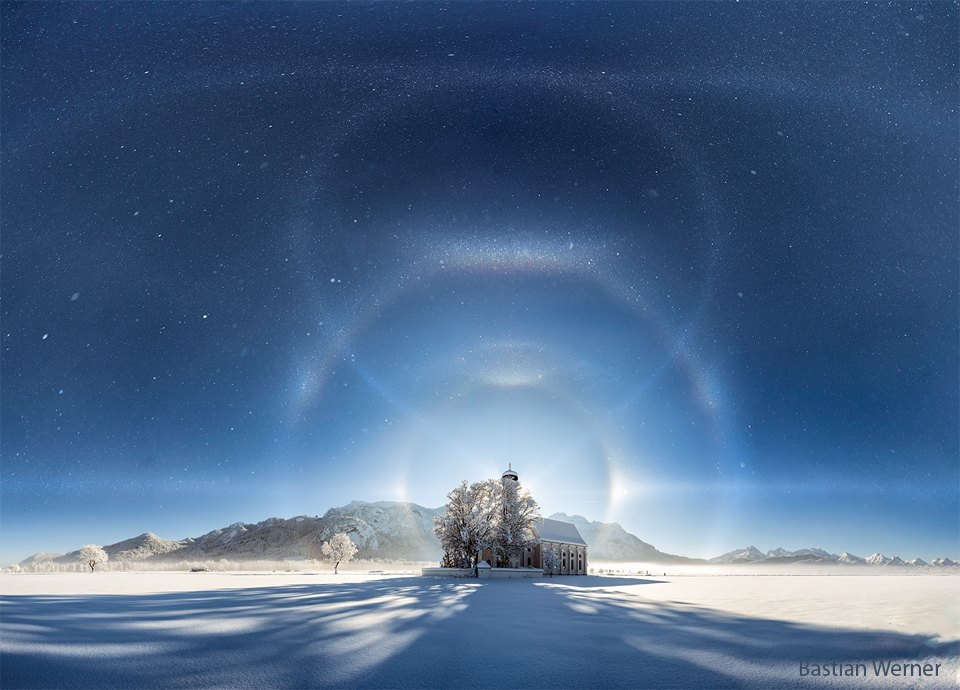
|
| Original url: https://apod.nasa.gov/apod/ap231220.html |
|
Explanation: What's causing those unusual sky arcs? Ice crystals. While crossing a field of fresh snow near Füssen , Bavaria , Germany , earlier this month, the photographer noticed that he had entered an ice fog. For suspended water to freeze into an ice fog requires quite cold temperatures, and indeed the air temperature on this day was measured at well below zero. The ice fog reflected light from the Sun setting behind St. Coleman Church . The result was one of the greatest spectacles the photographer has ever seen. First, the spots in the featured picture are not background stars but suspended ice and snow. Next, two prominent ice halos are visible: the 22-degree halo and the 46-degree halo . Multiple arcs are also visible , including, from top to bottom, antisolar (subsun), circumzenithal , Parry , tangent , and parhelic (horizontal). Finally, the balloon shaped curve connecting the top arc to the Sun is the rarest of all: it is the heliac arc , created by reflection from the sides of hexagonally shaped ice crystals suspended in a horizontal orientation. |
2023/12/19

|
| Original url: https://apod.nasa.gov/apod/ap231219.html |
|
Explanation: Could Queen Calafia 's mythical island exist in space? Perhaps not, but by chance the outline of this molecular space cloud echoes the outline of the state of California , USA. Our Sun has its home within the Milky Way's Orion Arm , only about 1,000 light-years from the California Nebula . Also known as NGC 1499 , the classic emission nebula is around 100 light-year s long. On the featured image , the most prominent glow of the California Nebula is the red light characteristic of hydrogen atoms recombining with long lost electrons, stripped away ( ionized ) by energetic starlight. The star most likely providing the energetic starlight that ionizes much of the nebular gas is the bright, hot, bluish Xi Persei just to the right of the nebula. A regular target for astrophotographers, the California Nebula can be spotted with a wide-field telescope under a dark sky toward the constellation of Perseus , not far from the Pleiades . |
2023/12/18
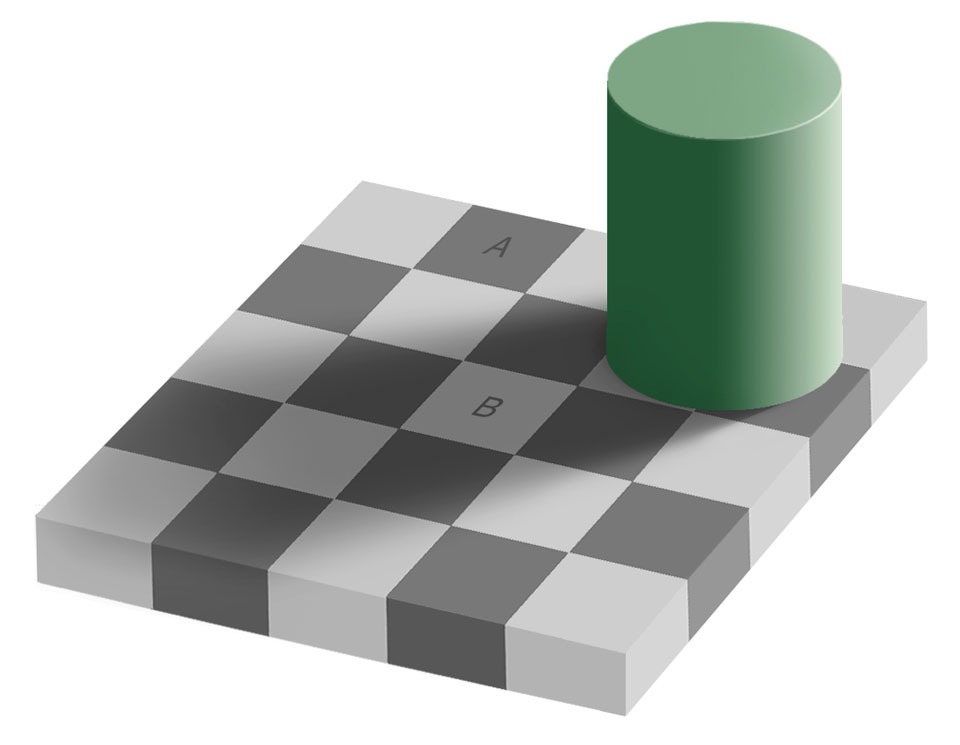
|
| Original url: https://apod.nasa.gov/apod/ap231218.html |
|
Explanation: Are squares A and B the same color? They are! To verify this, either run your cursor over the image or click here to see them connected. The featured illusion , an example of the same color illusion , illustrates that purely human perceptions in science may be ambiguous or inaccurate, even such a seemingly direct perception as relative color. Similar illusions exist on the sky , such as the size of the Moon near the horizon , or the apparent shapes of astronomical objects . The advent of automated, reproducible measuring devices such as CCDs have made science in general and astronomy in particular less prone to, but not free of, human-biased illusions . |
2023/12/17

|
| Original url: https://apod.nasa.gov/apod/ap231217.html |
|
Explanation: Where are all of these meteors coming from? In terms of direction on the sky, the pointed answer is the constellation of Gemini. That is why the major meteor shower in December is known as the Geminids -- because shower meteors all appear to come from a radiant toward Gemini . Three dimensionally, however, sand-sized debris expelled from the unusual asteroid 3200 Phaethon follows a well-defined orbit about our Sun, and the part of the orbit that approaches Earth is superposed in front of the constellation of Gemini . Therefore, when Earth crosses this orbit , the radiant point of falling debris appears in Gemini. Featured here is a composite of many images taken a few days ago through dark skies from Nianhu Lake in China . Over 100 bright meteor streaks from the Geminids meteor shower are visible. |
2023/12/16
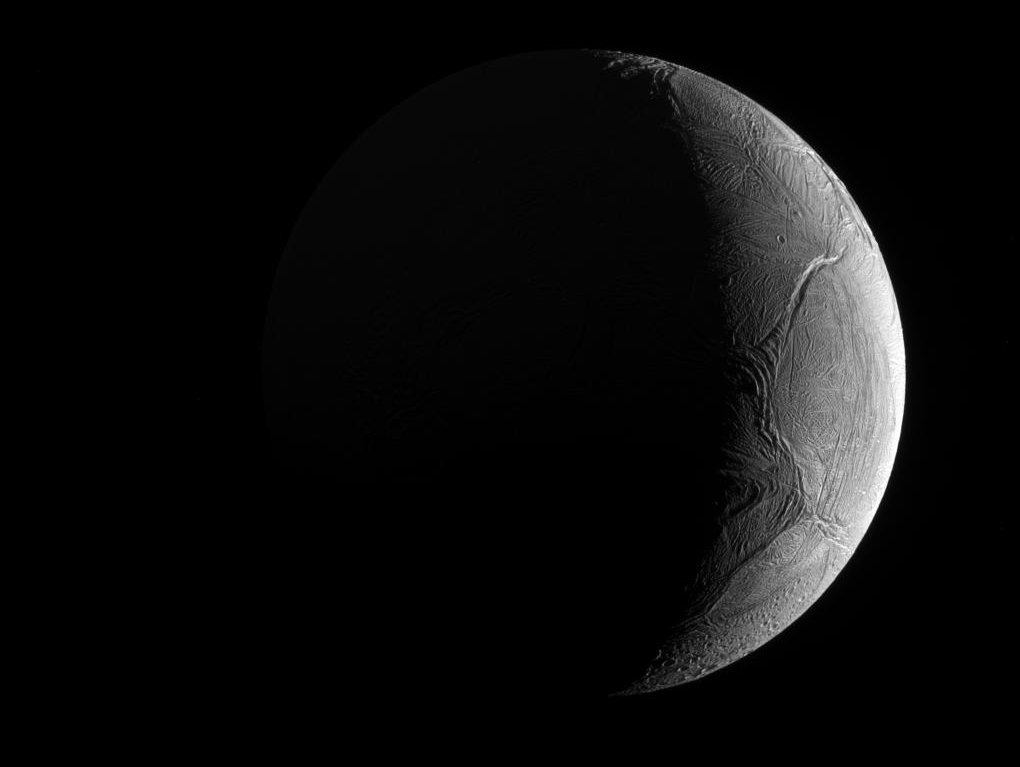
|
| Original url: https://apod.nasa.gov/apod/ap231216.html |
|
Explanation: Peering from the shadows, the Saturn-facing hemisphere of tantalizing inner moon Enceladus poses in this Cassini spacecraft image. North is up in the dramatic scene captured during November 2016 as Cassini's camera was pointed in a nearly sunward direction about 130,000 kilometers from the moon's bright crescent. In fact, the distant world reflects over 90 percent of the sunlight it receives, giving its surface about the same reflectivity as fresh snow . A mere 500 kilometers in diameter, Enceladus is a surprisingly active moon. Data and images collected during Cassini's flybys have revealed water vapor and ice grains spewing from south polar geysers and evidence of an ocean of liquid water hidden beneath the moon's icy crust. |
2023/12/15
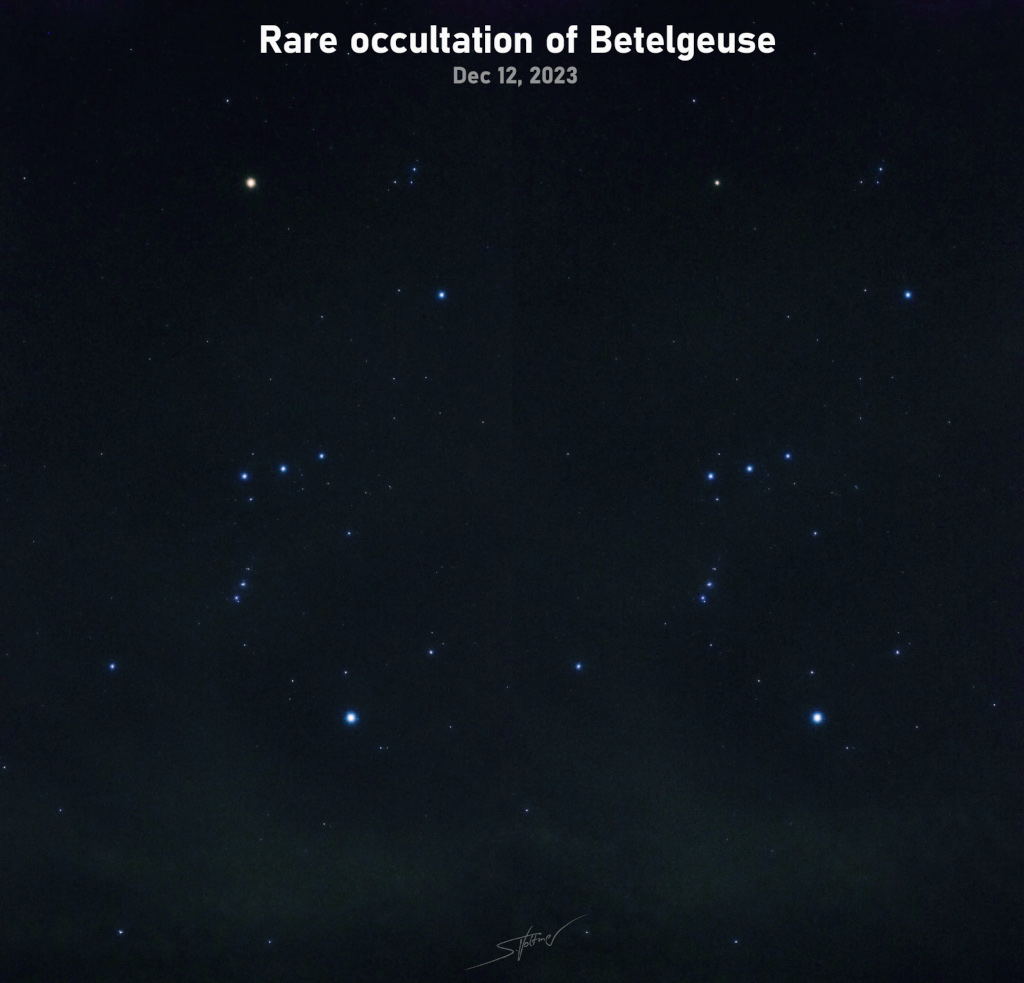
|
| Original url: https://apod.nasa.gov/apod/ap231215.html |
|
Explanation: Asteroid 319 Leona cast a shadow across planet Earth on December 12, as it passed in front of bright star Betelgeuse . But to see everyone's favorite red giant star fade this time, you had to stand near the center of the narrow shadow path starting in central Mexico and extending eastward across southern Florida, the Atlantic Ocean, southern Europe, and Eurasia. The geocentric celestial event is captured in these two panels taken at Almodovar del Rio, Spain from before (left) and during the asteroid-star occultation. In both panels Betelgeuse is seen above and left, at the shoulder of the familiar constellation Orion. Its brightness diminishes noticeably during the exceedingly rare occultation when, for several seconds, the giant star was briefly eclipsed by a roughly 60 kilometer diameter main-belt asteroid . |
2023/12/14

|
| Original url: https://apod.nasa.gov/apod/ap231214.html |
|
Explanation: Massive stars in our Milky Way Galaxy live spectacular lives. Collapsing from vast cosmic clouds, their nuclear furnaces ignite and create heavy elements in their cores. After only a few million years for the most massive stars, the enriched material is blasted back into interstellar space where star formation can begin anew. The expanding debris cloud known as Cassiopeia A is an example of this final phase of the stellar life cycle . Light from the supernova explosion that created this remnant would have been first seen in planet Earth's sky about 350 years ago, although it took that light 11,000 years to reach us. This sharp NIRCam image from the James Webb Space Telescope shows the still hot filaments and knots in the supernova remnant. The whitish, smoke-like outer shell of the expanding blast wave is about 20 light-years across, while the bright speck near center is a neutron star, the incredibly dense, collapsed remains of the massive stellar core. Light echoes from the massive star's cataclysmic explosion are also identified in Webb's detailed image of supernova remnant Cassiopeia A. |
2023/12/13

|
| Original url: https://apod.nasa.gov/apod/ap231213.html |
|
Explanation: What excites the Heart Nebula? First, the large emission nebula on the left, catalogued as IC 1805 , looks somewhat like a human heart . The nebula glows brightly in red light emitted by its most prominent element, hydrogen , but this long-exposure image was also blended with light emitted by silicon (yellow) and oxygen (blue). In the center of the Heart Nebula are young stars from the open star cluster Melotte 15 that are eroding away several picturesque dust pillars with their atom-exciting energetic light and winds. The Heart Nebula is located about 7,500 light years away toward the constellation of Cassiopeia . At the bottom right of the Heart Nebula is the companion Fishhead Nebula . This wide and deep image clearly shows, though, that glowing gas surrounds the Heart Nebula in all directions. |
2023/12/12
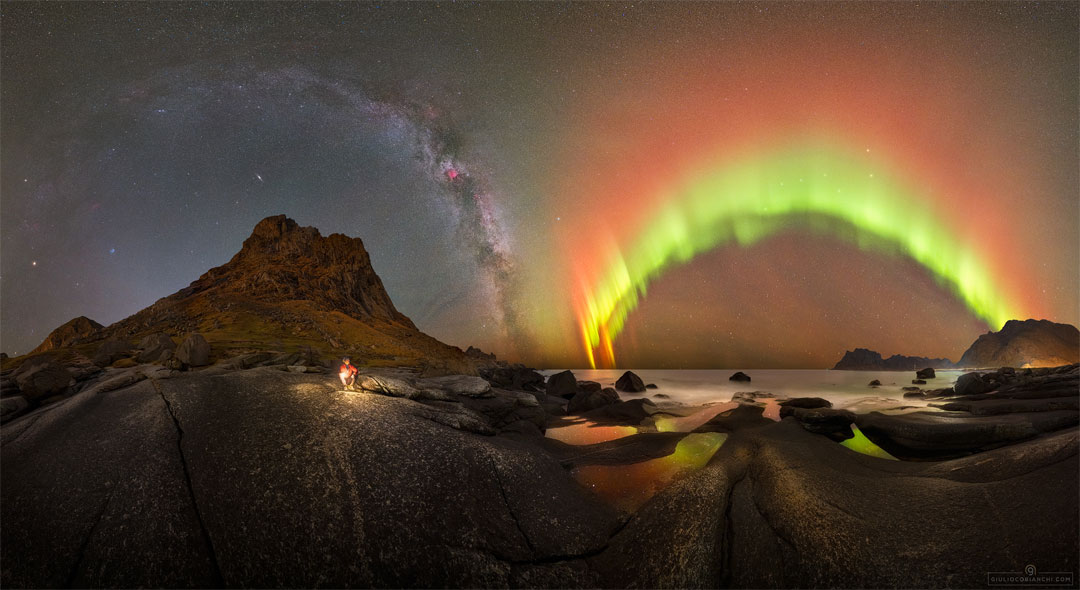
|
| Original url: https://apod.nasa.gov/apod/ap231212.html |
|
Explanation: What are these two giant arches across the sky? Perhaps the more familiar one, on the left, is the central band of our Milky Way Galaxy . This grand disk of stars and nebulas here appears to encircle much of the southern sky. Visible below the stellar arch is the rusty-orange planet Mars and the extended Andromeda galaxy . But this night had more! For a few minutes during this cold arctic night, a second giant arch appeared encircling part of the northern sky: an aurora . Auroras are much closer than stars as they are composed of glowing air high in Earth's atmosphere . Visible outside the green auroral arch is the group of stars popularly known as the Big Dipper . The featured digital composite of 20 images was captured in mid-November 2022 over the Lofoten Islands in Norway . |
2023/12/10
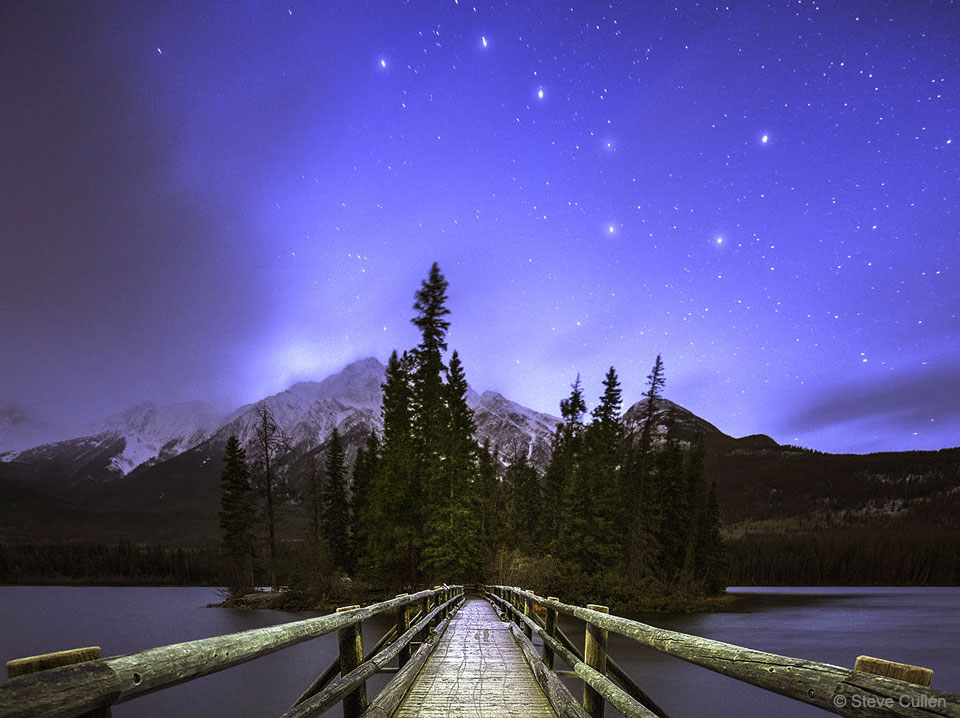
|
| Original url: https://apod.nasa.gov/apod/ap231211.html |
|
Explanation: When did you first learn to identify this group of stars? Although they are familiar to many people around the world, different cultures have associated this asterism with different icons and folklore . Known in the USA as the Big Dipper , the stars are part of a constellation designated by the International Astronomical Union in 1922 as the Great Bear ( Ursa Major ). The recognized star names of these stars are (left to right) Alkaid , Mizar/Alcor , Alioth , Megrez , Phecda , Merak , and Dubhe . Of course, stars in any given constellation are unlikely to be physically related . But surprisingly , most of the Big Dipper stars do seem to be headed in the same direction as they plough through space, a property they share with other stars spread out over an even larger area across the sky. Their measured common motion suggests that they all belong to a loose, nearby star cluster , thought to be on average only about 75 light-years away and up to 30 light-years across. The cluster is more properly known as the Ursa Major Moving Group . The featured image captured the iconic stars recently above Pyramid Mountain in Alberta , Canada . |
2023/12/09
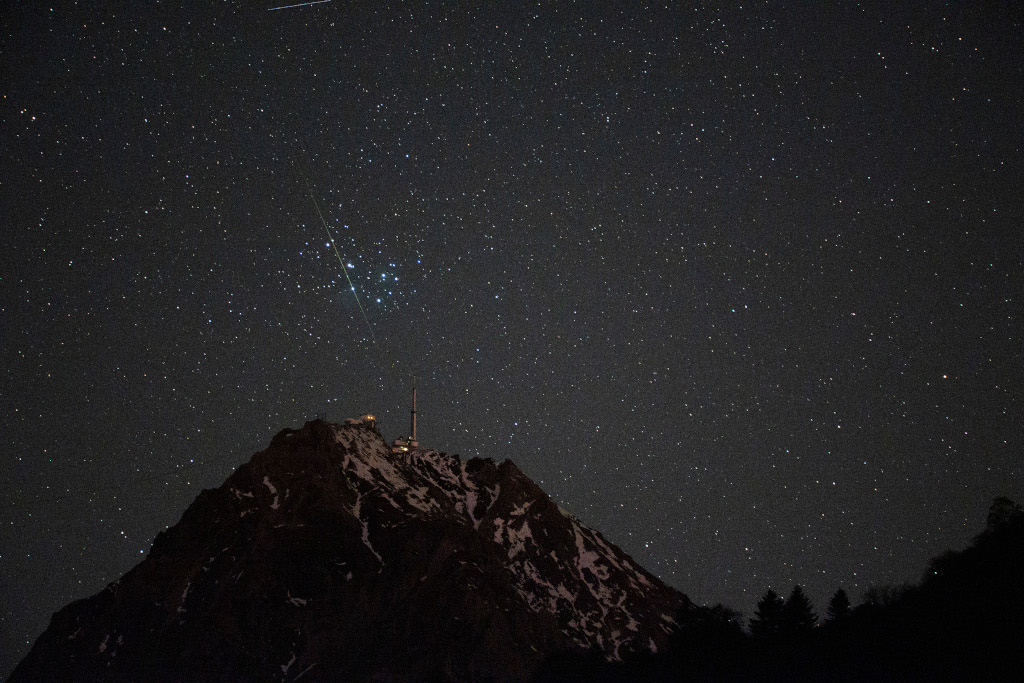
|
| Original url: https://apod.nasa.gov/apod/ap231209.html |
|
Explanation: Near dawn on November 19 the Pleiades stood in still dark skies over the French Pyrenees. But just before sunrise a serendipitous moment was captured in this single 3 second exposure; a bright meteor streak appeared to pierce the heart of the galactic star cluster. From the camera's perspective , star cluster and meteor were poised directly above the mountain top observatory on the Pic du Midi de Bigorre. And though astronomers might consider the Pleiades to be relatively close by, the grain of dust vaporizing as it plowed through planet Earth's upper atmosphere actually missed the cluster's tight grouping of young stars by about 400 light-years. While recording a night sky timelapse series, the camera and telephoto lens were fixed to a tripod on the Tour-de-France- cycled slopes of the Col du Tourmalet about 5 kilometers from the Pic du Midi. |
2023/12/08
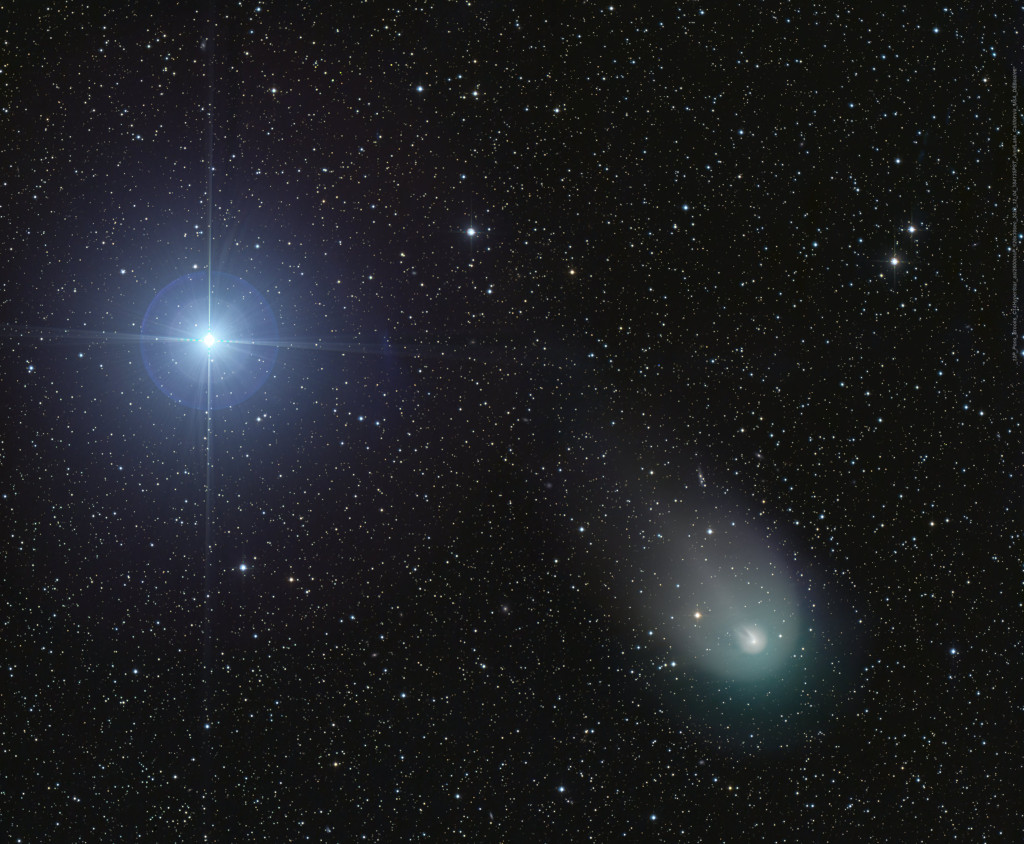
|
| Original url: https://apod.nasa.gov/apod/ap231208.html |
|
Explanation: On December 4, periodic Comet 12P/Pons-Brooks shared this telescopic field of view with Vega, alpha star of the northern constellation Lyra. Fifth brightest star in planet Earth's night, Vega is some 25 light-years distant while the much fainter comet was about 21 light-minutes away. In recent months , outbursts have caused dramatic increases in brightness for Pons-Brooks though. Nicknamed the Devil Comet for its hornlike appearance, fans of interstellar spaceflight have also suggested the distorted shape of this comet's large coma looks like the Millenium Falcon . A Halley-type comet, 12P/Pons-Brooks last visited the inner Solar System in 1954. Its next perihelion passage or closest approach to the Sun will be April 21, 2024. That's just two weeks after the April 8 total solar eclipse path crosses North America. But, highly inclined to the Solar System's ecliptic plane, the orbit of periodic Comet 12P/Pons-Brooks will never cross the orbit of planet Earth. |
2023/12/07
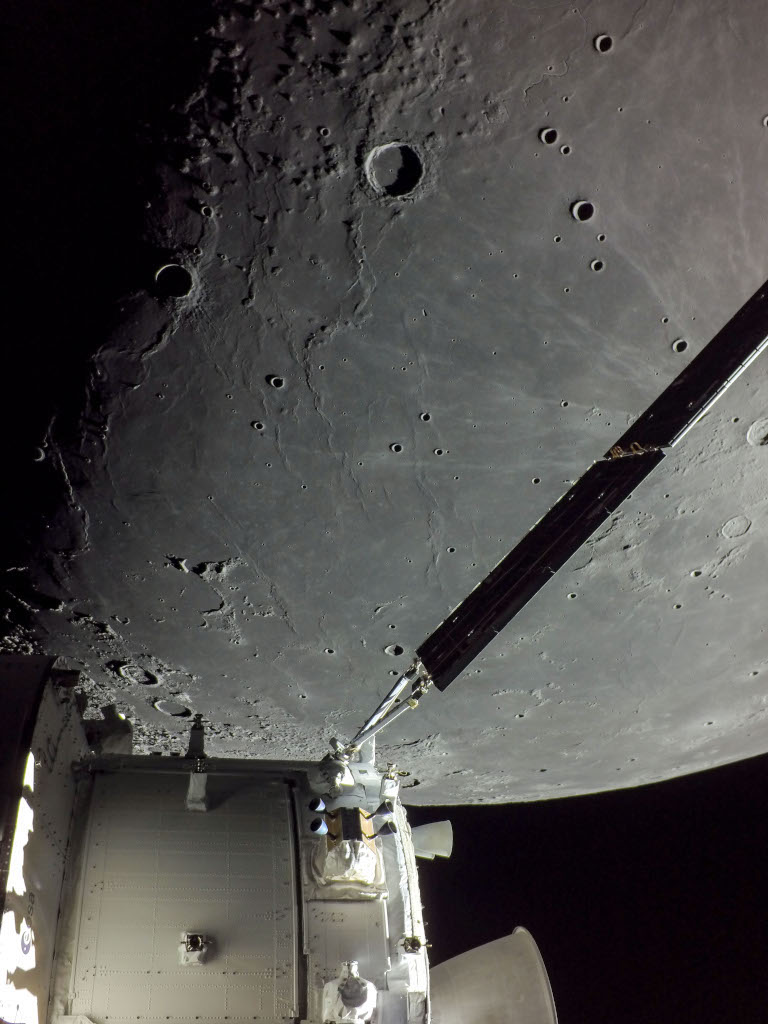
|
| Original url: https://apod.nasa.gov/apod/ap231207.html |
|
Explanation: On December 5, 2022, a camera on board the uncrewed Orion spacecraft captured this view as Orion approached its return powered flyby of the Moon. Beyond one of Orion's extended solar arrays lies dark, smooth, terrain along the western edge of the Oceanus Procellarum. Prominent on the lunar nearside Oceanus Procellarum , the Ocean of Storms, is the largest of the Moon's lava-flooded maria . The lunar terminator, shadow line between lunar night and day, runs along the left of this frame. The 41 kilometer diameter crater Marius is top center, with ray crater Kepler peeking in at the edge, just right of the solar array wing. Kepler's bright rays extend to the north and west, reaching the dark-floored Marius . On December 11, 2022 the Orion spacecraft reached its home world . The historic Artemis 1 mission ended with Orion's successful splashdown in planet Earth's water-flooded Pacific Ocean. |
2023/12/06
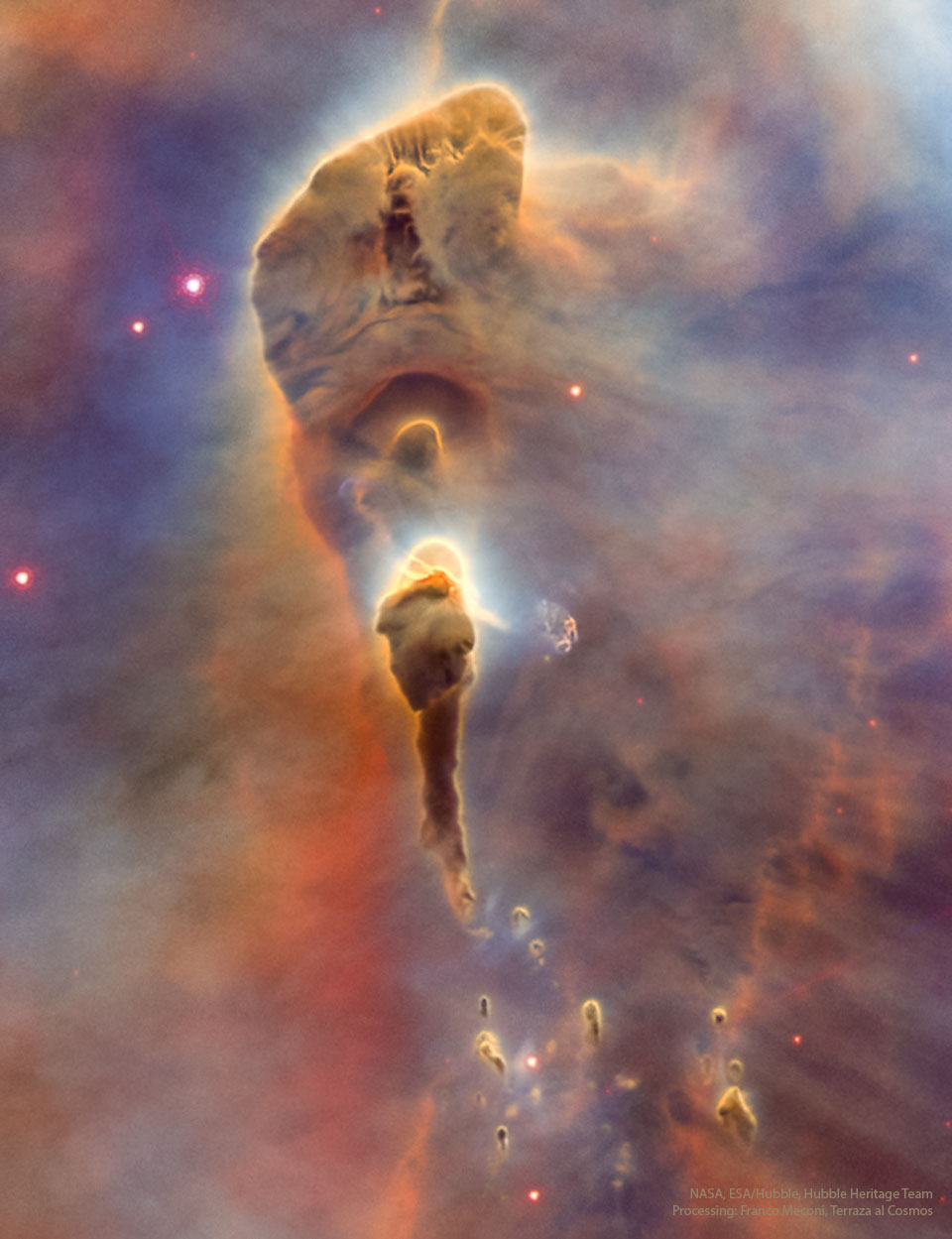
|
| Original url: https://apod.nasa.gov/apod/ap231206.html |
|
Explanation: It's stars versus dust in the Carina Nebula and the stars are winning. More precisely, the energetic light and wind s from massive newly formed stars are evaporating and dispersing the dusty stellar nurseries in which they formed. Located in the Carina Nebula and inside a region known informally as Mystic Mountain , these pillars' appearance is dominated by opaque brown dust even though it is composed mostly of clear hydrogen gas. Even though some of the dust pillar s look like torches , their ends are not on fire -- rather, they are illuminated by nearby stars. About 7,500 light-years distant, the featured image was taken with the Hubble Space Telescope and highlights an interior region of Carina known as HH1066 which spans nearly a light year . Within a few million years, the stars will likely win out completely and the dust torches will completely evaporate . |
2023/12/05
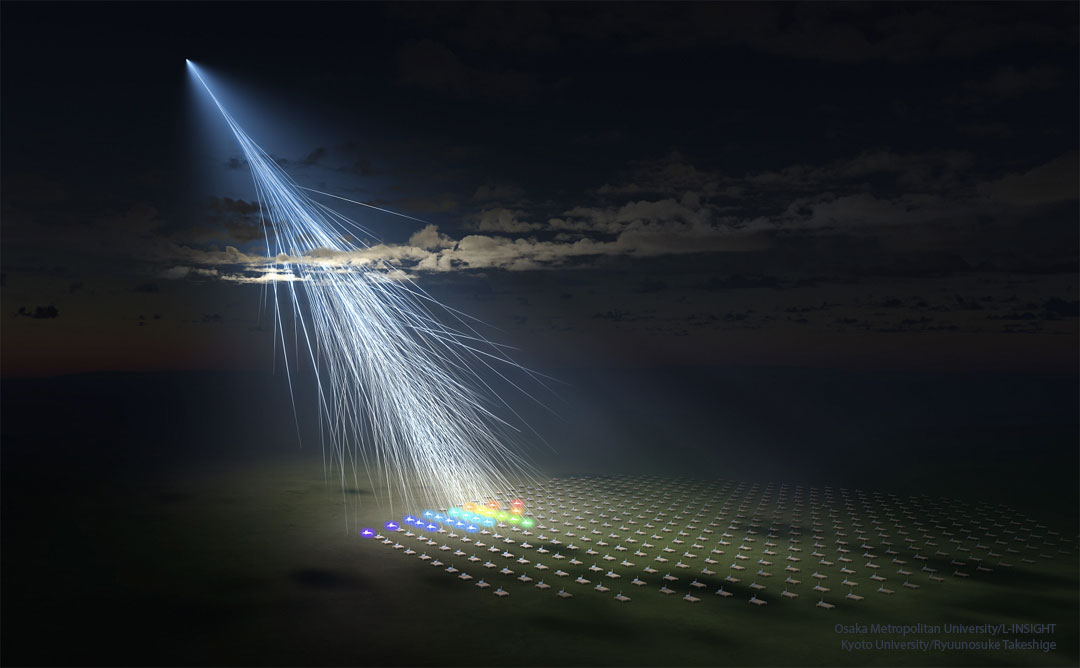
|
| Original url: https://apod.nasa.gov/apod/ap231205.html |
|
Explanation: It was one of the most energetic particles ever known to strike the Earth -- but where did it come from? Dubbed Amaterasu after the Shinto sun goddess , this particle, as do all cosmic rays that strike the Earth's atmosphere , caused an air shower of electrons, protons, and other elementary particles to spray down onto the Earth below. In the featured illustration , a cosmic ray air shower is pictured striking the Telescope Array in Utah , USA , which recorded the Amaterasu event in 2021 May. Cosmic ray air showers are common enough that you likely have been in a particle spray yourself, although you likely wouldn't have noticed. The origin of this energetic particle, likely the nucleus of an atom , remains a mystery in two ways. First, it is not known how any single particle or atomic nucleus can practically acquire so much energy , and second, attempts to trace the particle back to where it originated did not indicate any likely potential source. |
2023/12/04
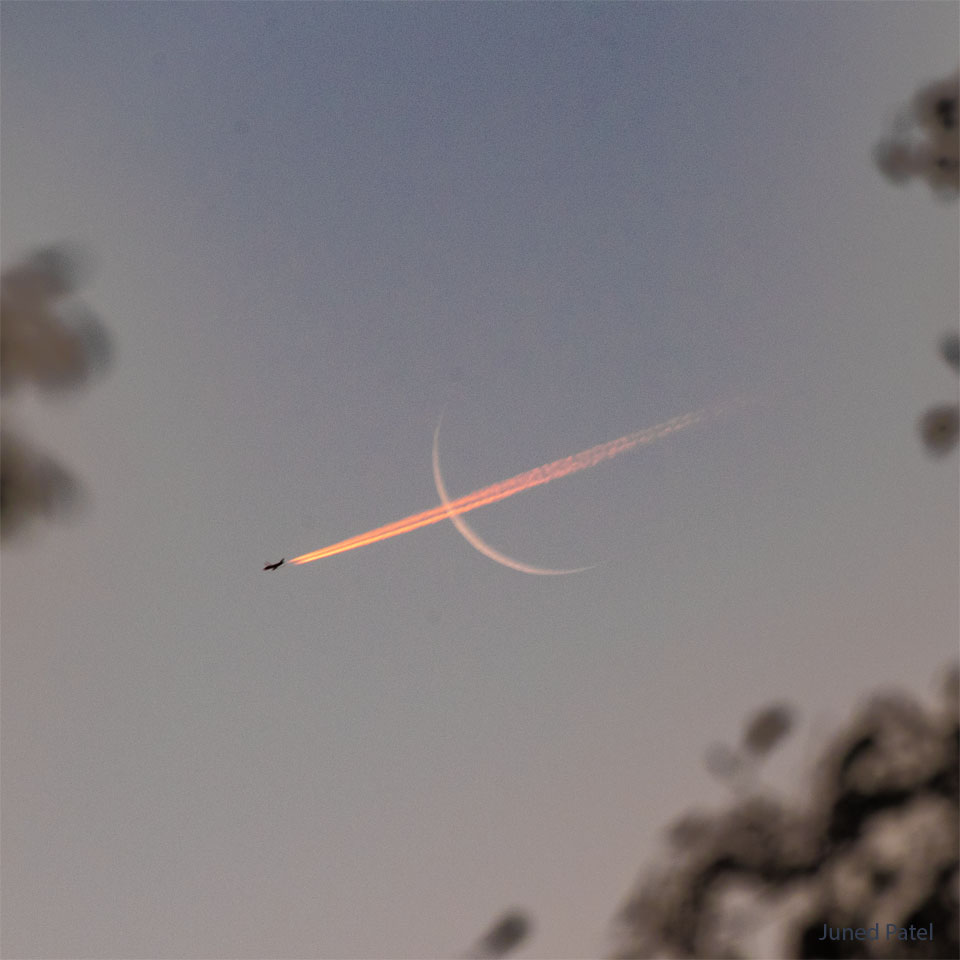
|
| Original url: https://apod.nasa.gov/apod/ap231204.html |
|
Explanation: No, the Moon is not a bow, and no, it did not shoot out a plane like an arrow. What is pictured is a chance superposition. The plane's contrail would normally appear white, but the large volume of air toward the rising Sun preferentially knocked away blue light, not only making the sky blue , but giving the reflected trail a bright red hue . Far in the distance, well behind the plane , the crescent Moon also appears slightly reddened. Captured early last month from Bolton , UK , the featured image was taken so soon after sunrise that the plane was sunlit from below, as was its contrail. Within minutes, unfortunately, the impromptu sky show ended . The plane moved out of sight. The Moon kept rising but became harder to see through a brightening sky. And the contrail gradually dispersed. |
2023/12/02
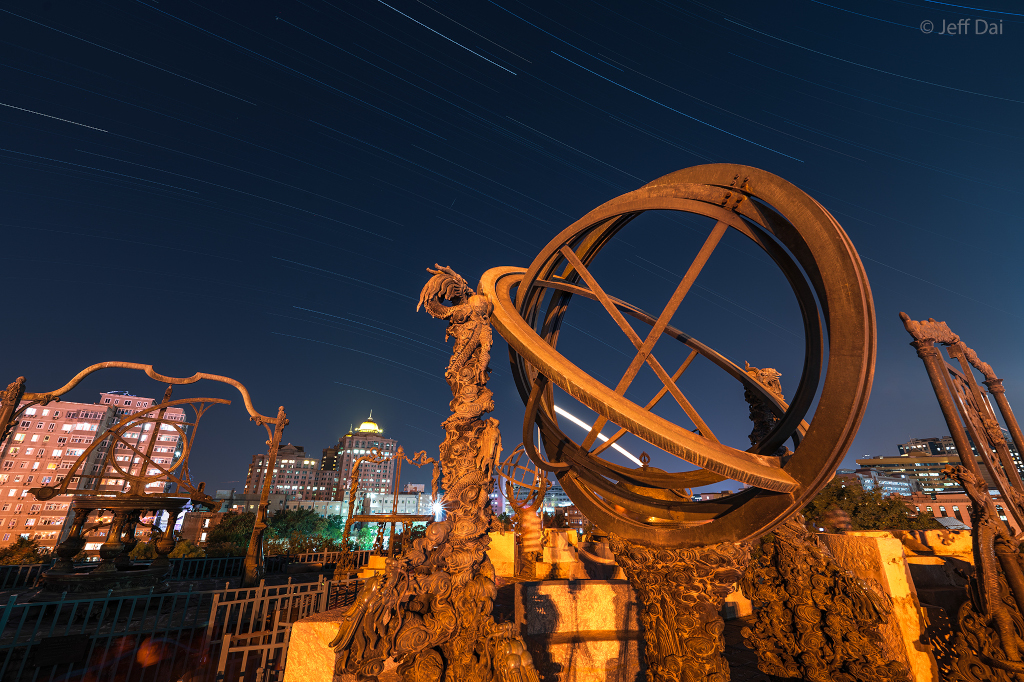
|
| Original url: https://apod.nasa.gov/apod/ap231203.html |
|
Explanation: You can take a subway ride to visit this observatory in Beijing, China but you won't find any telescopes there. Starting in the 1400s astronomers erected devices at the Beijing Ancient Observatory site to enable them to accurately measure and track the positions of naked-eye stars and planets . Some of the large, ornate astronomical instruments are still standing. You can even see stars from the star observation platform today, but now only the very brightest celestial beacons are visible against the city lights . In this time series of exposures from a camera fixed to a tripod to record graceful arcing startrails, the brightest trail is actually the Moon. Its broad arc is seen behind the ancient observatory's brass armillary sphere . Compare this picture from the Beijing Ancient Observatory taken in September 2023 to one taken in 1895 . |
2023/12/01
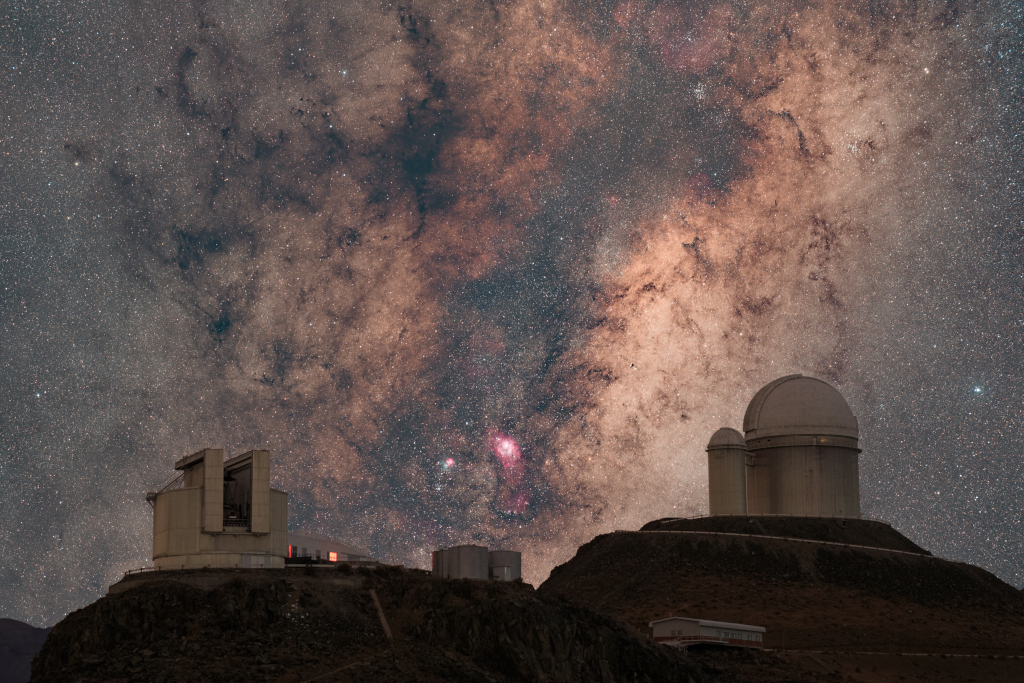
|
| Original url: https://apod.nasa.gov/apod/ap231201.html |
|
Explanation: The core of the Milky Way is rising beyond the Chilean mountain-top La Silla Observatory in this deep night skyscape . Seen toward the constellation Sagittarius, our home galaxy's center is flanked on the left, by the European Southern Observatory's New Technology Telescope which pioneered the use of active optics to accurately control the shape of large telescope mirrors. To the right stands the ESO 3.6-meter Telescope, home of the exoplanet hunting HARPS and NIRPS spectrographs. Between them, the galaxy's central bulge is filled with obscuring clouds of interstellar dust, bright stars, clusters, and nebulae . Prominent reddish hydrogen emission from the star-forming Lagoon Nebula, M8, is near center. The Trifid Nebula, M20, combines blue light of a dusty reflection nebula with reddish emission just left of the cosmic Lagoon. Both are popular stops on telescopic tours of the galactic center. The composited image is a stack of separate exposures for ground and sky made in April 2023, all captured consecutively with the same framing and camera equipment. |
2023/11/30

|
| Original url: https://apod.nasa.gov/apod/ap231130.html |
|
Explanation: On flight day 13 (November 28, 2022) of the Artemis I mission, the Orion spacecraft reached its maximum distance from its home world. Over 430,000 kilometers from Earth in a distant retrograde orbit, Orion surpassed the record for most distant spacecraft designed to carry humans. That record was previously set in 1970 during the Apollo 13 mission to the Moon. Both Earth and Moon are in the same field of view in this video frame from Orion on Artemis I mission flight day 13. The planet and its large natural satellite even appear about the same apparent size from the uncrewed spacecraft's perspective . |
2023/11/29
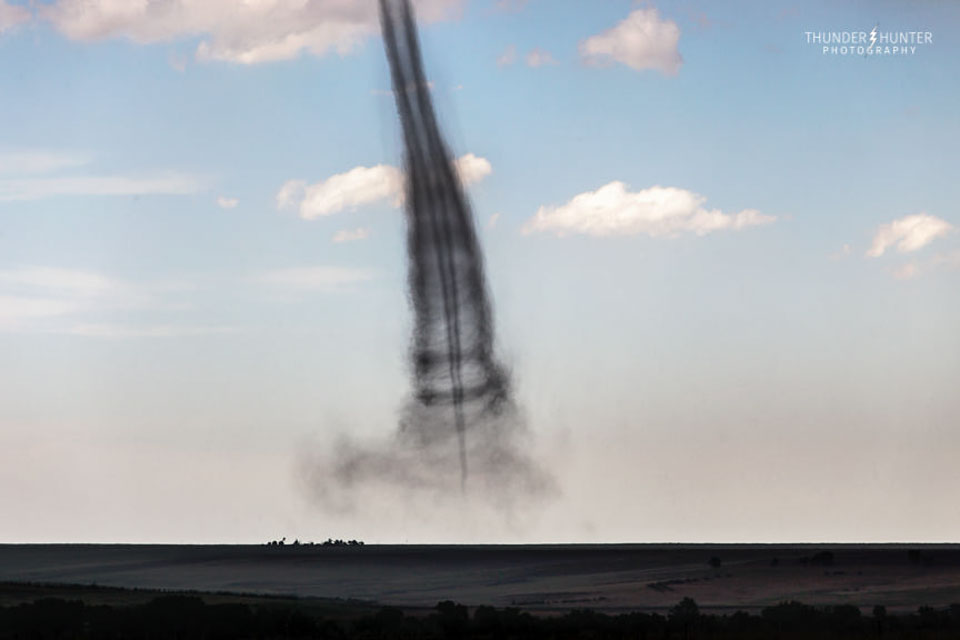
|
| Original url: https://apod.nasa.gov/apod/ap231129.html |
|
Explanation: Could there be a tornado inside another tornado? In general, no. OK, but could there be a tornado inside a wider dust devil ? No again, for one reason because tornados comes down from the sky, but dust devils rise up from the ground. What is pictured is a landspout , an unusual type of tornado known to occur on the edge of a violent thunderstorm . The featured landspout was imaged and identified in Kansas , USA , in June 2019 by an experienced storm chaser. The real tornado is in the center, and the outer sheath was possibly created by large dust particles thrown out from the central tornado. So far, the only planet known to create tornados is Earth , although tornado-like activity has been found on the Sun and dust devils are common on Mars . |
2023/11/28
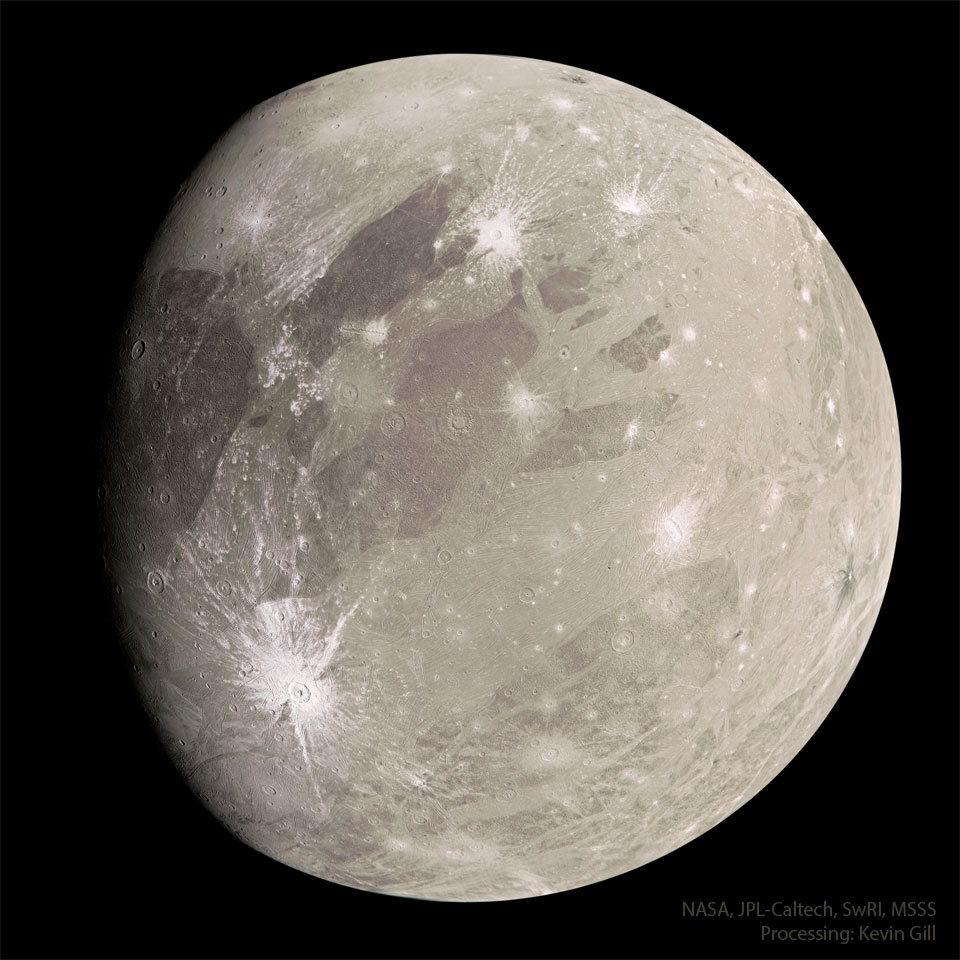
|
| Original url: https://apod.nasa.gov/apod/ap231128.html |
|
Explanation: What does the largest moon in the Solar System look like? Jupiter 's moon Ganymede , larger than even Mercury and Pluto , has an icy surface speckled with bright young craters overlying a mixture of older, darker, more cratered terrain laced with grooves and ridges. The cause of the grooved terrain remains a topic of research , with a leading hypothesis relating it to shifting ice plates. Ganymede is thought to have an ocean layer that contains more water than Earth -- and might contain life . Like Earth's Moon , Ganymede keeps the same face towards its central planet, in this case Jupiter. The featured image was captured in 2021 by NASA's robotic Juno spacecraft when it passed by the immense moon. The close pass reduced Juno's orbital period around Jupiter from 53 days to 43 days. Juno continues to study the giant planet 's high gravity, unusual magnetic field , and complex cloud structures . |
2023/11/27

|
| Original url: https://apod.nasa.gov/apod/ap231127.html |
|
Explanation: This eagle ray glides across a cosmic sea. Officially cataloged as SH2-63 and LBN 86 , the dark nebula is composed of gas and dust that just happens to appear shaped like a common ocean fish . The interstellar dust nebula appears light brown as it blocks and reddens visible light emitted behind it. Dark nebulas glow primarily in infrared light , but also reflect visible light from surrounding stars. The dust in dark nebulas is usually sub-millimeter chunks of carbon, silicon, and oxygen , frequently coated with frozen carbon monoxide and nitrogen . Dark nebulas are also known as molecular clouds because they also contain relatively high amounts of molecular hydrogen and larger molecules . Previously unnamed, the here dubbed Eagle Ray Nebula is normally quite dim but has been imaged clearly over 20-hours through dark skies in Chile . |
2023/11/26
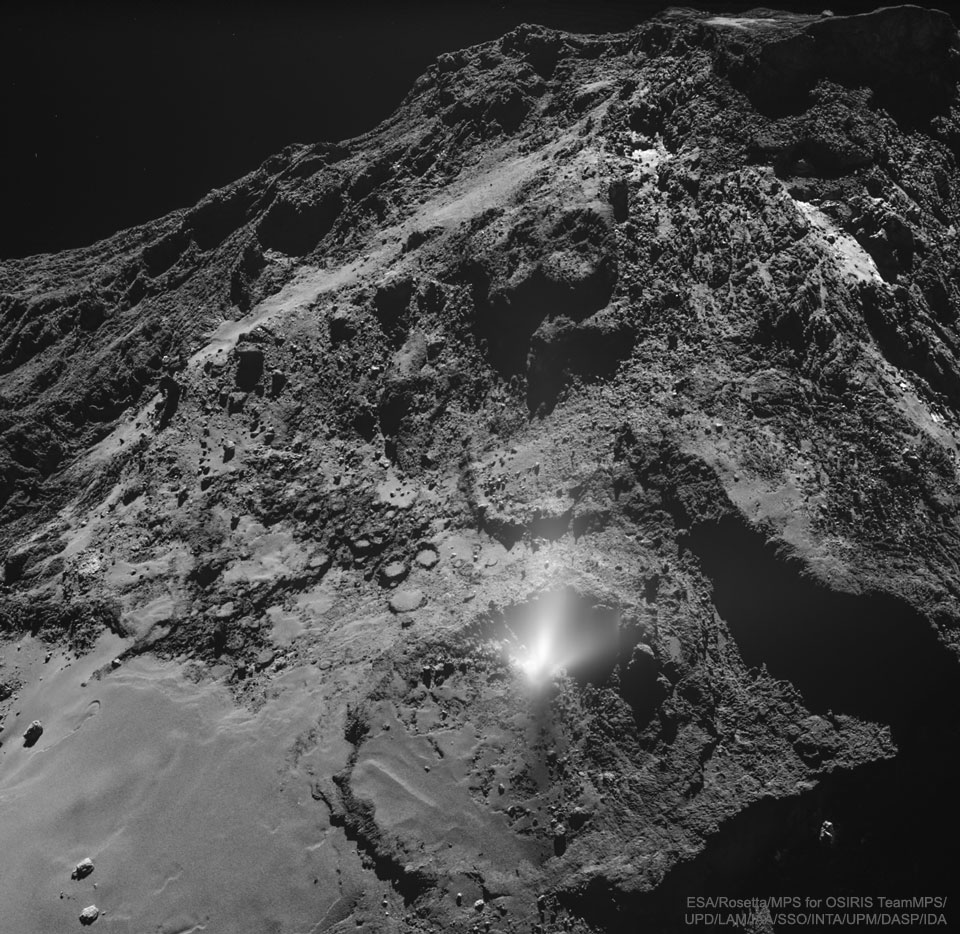
|
| Original url: https://apod.nasa.gov/apod/ap231126.html |
|
Explanation: Where do comet tails come from? There are no obvious places on the nuclei of comets from which the jets that create comet tails emanate. In 2016, though, ESA's Rosetta spacecraft not only imaged a jet emerging from Comet 67P/Churyumov-Gerasimenko , but flew right through it. Featured is a telling picture showing a bright plume emerging from a small circular dip bounded on one side by a 10-meter high wall. Analyses of Rosetta data show that the jet was composed of both dust and water-ice. The rugged but otherwise unremarkable terrain indicates that something likely happened far under the porous surface to create the plume. This image was taken about two months before Rosetta's mission ended with a controlled impact onto Comet 67P's surface. |
2023/11/25
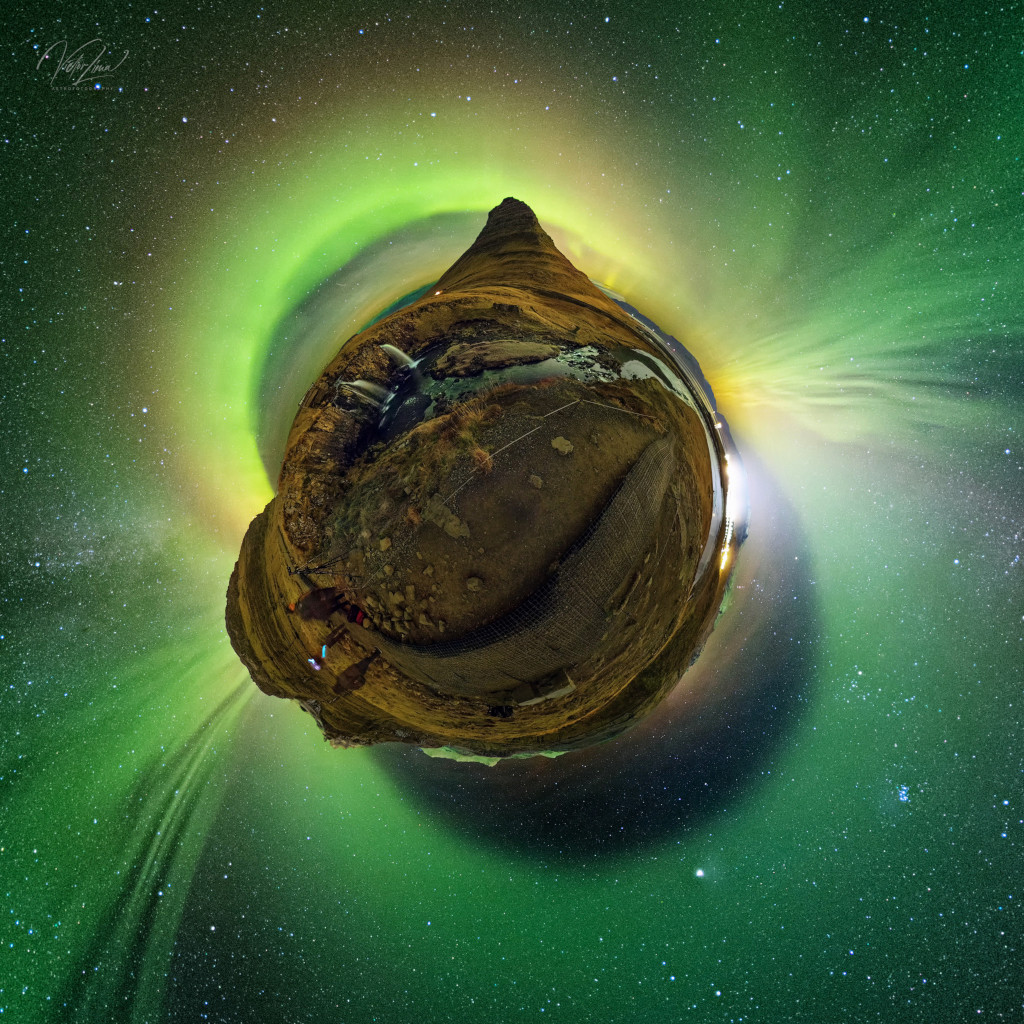
|
| Original url: https://apod.nasa.gov/apod/ap231125.html |
|
Explanation: Immersed in an eerie greenish light, this rugged little planet appears to be home to stunning water falls and an impossibly tall mountain. It's planet Earth of course. On the night of November 9 the nadir-centered 360 degree mosaic was captured by digital camera from the Kirkjufell mountain area of western Iceland. Curtains of shimmering Aurora Borealis or Northern Lights provide the pale greenish illumination. The intense auroral display was caused by solar activity that rocked Earth's magnetosphere in early November and produced strong geomagnetic storms. Kirkjufell mountain itself stands at the top of the stereographic projection's circular horizon. Northern hemisphere skygazers will recognize the familiar stars of the Big Dipper just above Kirkjufell's peak. At lower right the compact Pleiades star cluster and truly giant planet Jupiter also shine in this little planet's night sky. |
2023/11/24

|
| Original url: https://apod.nasa.gov/apod/ap231124.html |
|
Explanation: Jupiter looks sharp in these two rooftop telescope images . Both were captured on November 17 from Singapore, planet Earth, about two weeks after Jupiter's 2023 opposition . Climbing high in midnight skies the giant planet was a mere 33.4 light-minutes from Singapore. That's about 4 astronomical units away. Jupiter's planet girdling dark belts and light zones are visible in remarkable detail, along with the giant world's whitish oval vortices. Its signature Great Red Spot is still prominent in the south. Jupiter rotates rapidly on its axis once every 10 hours. So, based on video frames taken only 15 minutes apart, these images form a stereo pair. Look at the center of the pair and cross your eyes until the separate images come together to see the Solar System's ruling gas giant in 3D. |
2023/11/23
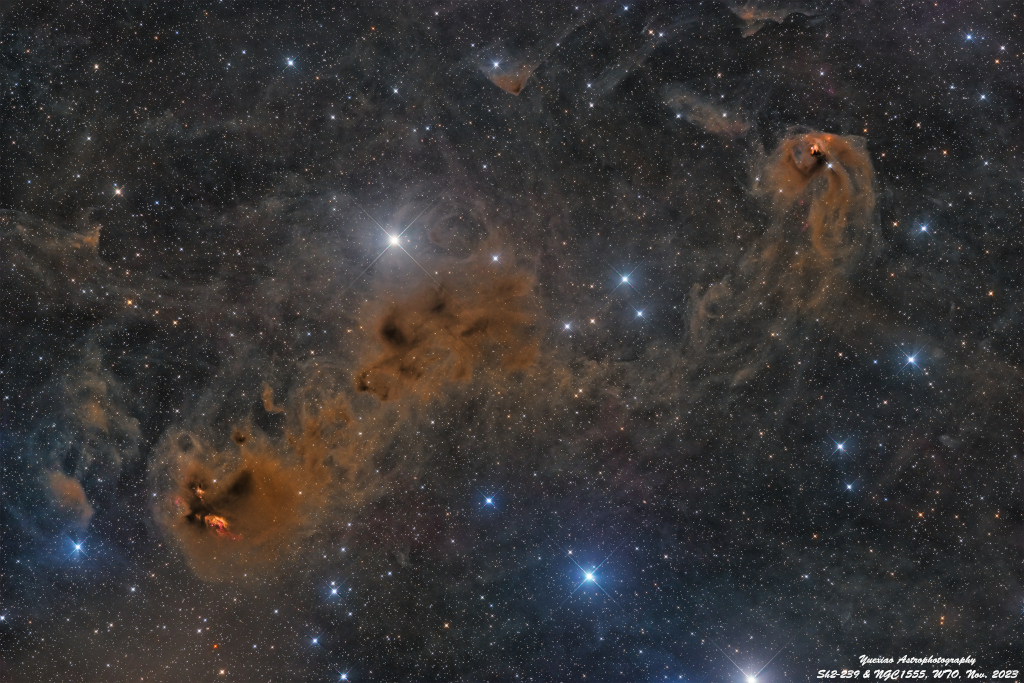
|
| Original url: https://apod.nasa.gov/apod/ap231123.html |
|
Explanation: The cosmic brush of star formation composed this interstellar canvas of emission, dust, and dark nebulae. A 5 degree wide telescopic mosaic, it frames a region found north of bright star Aldebaran on the sky, at an inner wall of the local bubble along the Taurus molecular cloud . At lower left, emission cataloged as Sh2-239 shows signs of embedded young stellar objects. The region's Herbig-Haro objects, nebulosities associated with newly born stars, are marked by tell-tale reddish jets of shocked hydrogen gas. Above and right T Tauri, the prototype of the class of T Tauri variable stars , is next to a yellowish nebula historically known as Hind's Variable Nebula ( NGC 1555 ). T Tauri stars are now generally recognized as young, less than a few million years old, sun-like stars still in the early stages of formation . |
2023/11/22
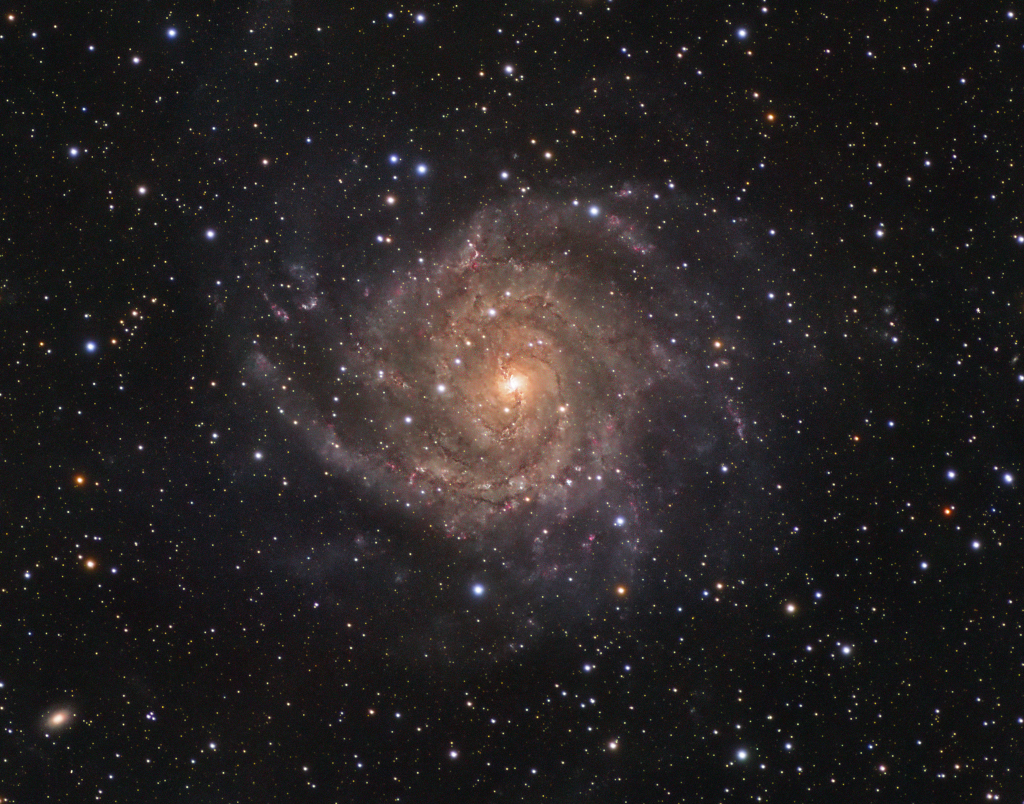
|
| Original url: https://apod.nasa.gov/apod/ap231122.html |
|
Explanation: Similar in size to large, bright spiral galaxies in our neighborhood, IC 342 is a mere 10 million light-years distant in the long-necked, northern constellation Camelopardalis . A sprawling island universe , IC 342 would otherwise be a prominent galaxy in our night sky, but it is hidden from clear view and only glimpsed through the veil of stars, gas and dust clouds along the plane of our own Milky Way galaxy . Even though IC 342's light is dimmed and reddened by intervening cosmic clouds , this sharp telescopic image traces the galaxy's own obscuring dust, young star clusters, and glowing star forming regions along spiral arms that wind far from the galaxy's core . IC 342 has undergone a recent burst of star formation activity and is close enough to have gravitationally influenced the evolution of the local group of galaxies and the Milky Way. |
2023/11/21

|
| Original url: https://apod.nasa.gov/apod/ap231121.html |
|
Explanation: These chaotic and tangled filaments of shocked, glowing gas are spread across planet Earth's sky toward the constellation of Cygnus as part of the Veil Nebula . The Veil Nebula itself is a large supernova remnant , an expanding cloud born of the death explosion of a massive star. Light from the original supernova explosion likely reached Earth over 5,000 years ago. The glowing filaments are really more like long ripples in a sheet seen almost edge on, remarkably well separated into the glow of ionized hydrogen atoms shown in red and oxygen in blue hues. Also known as the Cygnus Loop and cataloged as NGC 6979 , the Veil Nebula now spans about 6 times the diameter of the full Moon . The length of the wisp corresponds to about 30 light years , given its estimated distance of 2,400 light years. Often identified as Pickering's Triangle for a director of Harvard College Observatory , it is perhaps better named for its discoverer, astronomer Williamina Fleming , as Fleming's Triangular Wisp . |
2023/11/20

|
| Original url: https://apod.nasa.gov/apod/ap231120.html |
|
Explanation: Sculpted by stellar winds and radiation, a magnificent interstellar dust cloud by chance has assumed this recognizable shape . Fittingly named the Horsehead Nebula , it is some 1,500 light-years distant , embedded in the vast Orion cloud complex. About five light-years "tall," the dark cloud is cataloged as Barnard 33 and is visible only because its obscuring dust is silhouetted against the glowing red emission nebula IC 434. Stars are forming within the dark cloud. Contrasting blue reflection nebula NGC 2023, surrounding a hot, young star , is at the lower left of the full image . The featured gorgeous color image combines both narrowband and broadband images recorded using several different telescopes. |
2023/11/19
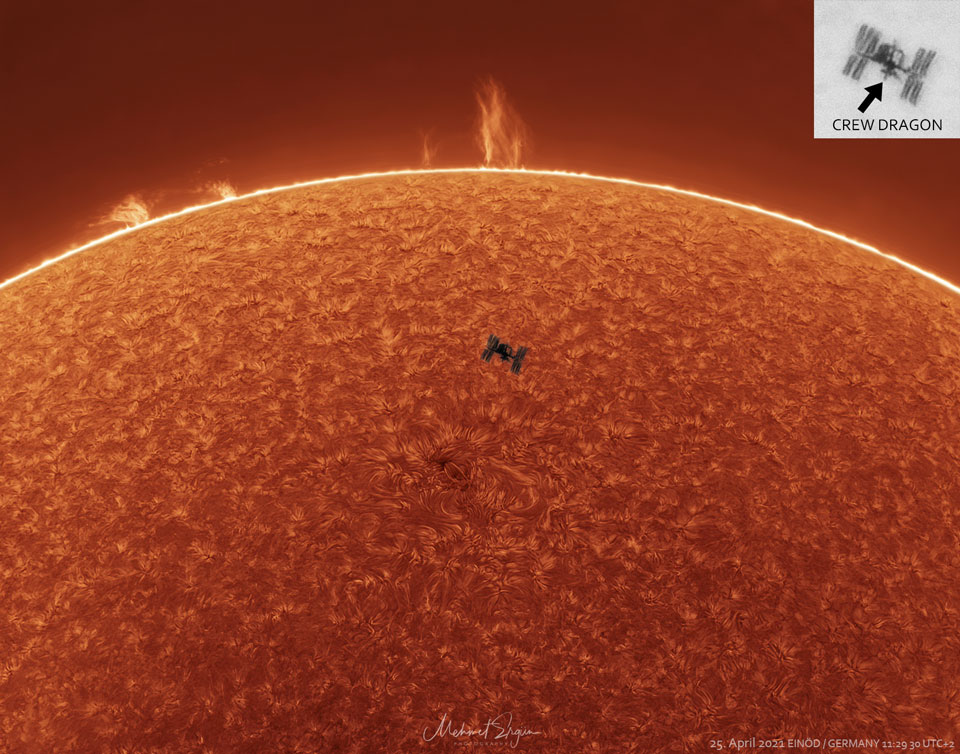
|
| Original url: https://apod.nasa.gov/apod/ap231119.html |
|
Explanation: That's no sunspot. It's the International Space Station (ISS) caught passing in front of the Sun. Sunspot s, individually, have a dark central umbra , a lighter surrounding penumbra , and no Dragon capsules attached . By contrast, the ISS is a complex and multi-spired mechanism, one of the largest and most complicated spacecraft ever created by humanity . Also, sunspots circle the Sun , whereas the ISS orbits the Earth . Transiting the Sun is not very unusual for the ISS , which orbits the Earth about every 90 minutes, but getting one's location, timing and equipment just right for a great image is rare. The featured picture combined three images all taken in 2021 from the same location and at nearly the same time. One image -- overexposed -- captured the faint prominence s seen across the top of the Sun, a second image -- underexposed -- captured the complex texture of the Sun's chromosphere , while the third image -- the hardest to get -- captured the space station as it shot across the Sun in a fraction of a second. Close inspection of the space station's silhouette even reveals a docked Dragon Crew capsule . |
2023/11/18
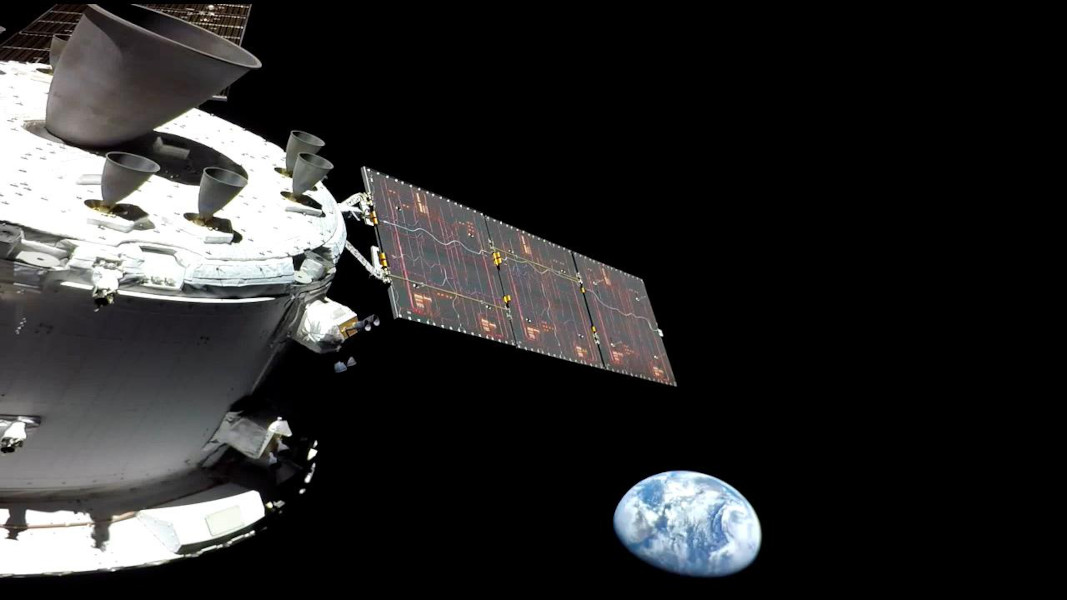
|
| Original url: https://apod.nasa.gov/apod/ap231118.html |
|
Explanation: One year ago a Space Launch System rocket left planet Earth on November 16, 2022 at 1:47am EST carrying the Orion spacecraft on the Artemis I mission, the first integrated test of NASA’s deep space exploration systems. Over an hour after liftoff from Kennedy Space Center's historic Launch Complex 39B, one of Orion's external video cameras captured this view of its new perspective from space . In the foreground are Orion's Orbital Maneuvering System engine and auxillary engines, at the bottom of the European Service Module. Beyond one of the module's 7-meter long extended solar array wings lies the spacecraft's beautiful home world. Making close flybys of the lunar surface and reaching a retrograde orbit 70,000 kilometers beyond the Moon, the uncrewed Artemis I mission lasted over 25 days, testing capabilities to enable human exploration of the Moon and Mars. Building on the success of Artemis I , no earlier than November 2024 the Artemis II mission with a crew of 4 will venture around the Moon and back again. |
2023/11/17
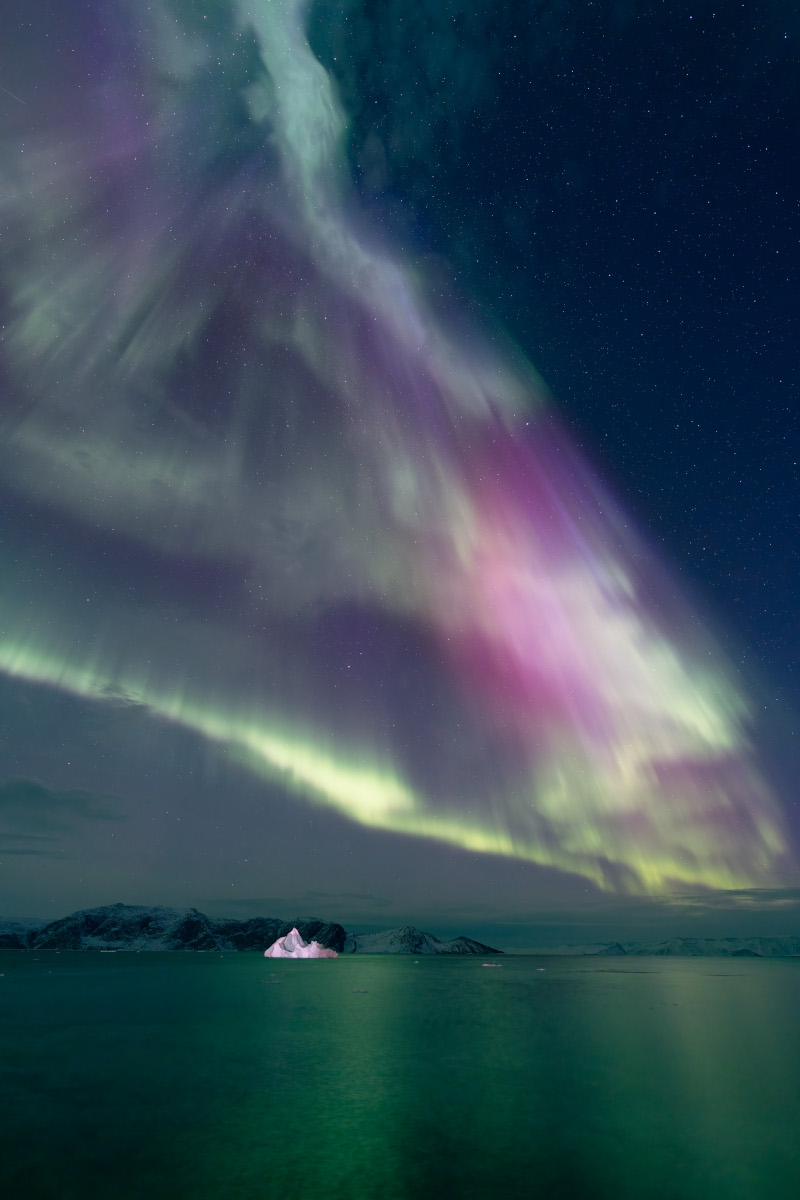
|
| Original url: https://apod.nasa.gov/apod/ap231117.html |
|
Explanation: Light pollution is usually not a problem in Qeqertaq . In western Greenland the remote coastal village boasted a population of 114 in 2020. Lights still shine in its dark skies though. During planet Earth's recent intense geomagnetic storm, on November 6 these beautiful curtains of aurora borealis fell over the arctic realm . On the eve of the coming weeks of polar night at 70 degrees north latitude, the inspiring display of northern lights is reflected in the waters of Disko Bay. In this view from the isolated settlement a lone iceberg is illuminated by shore lights as it drifts across the icy sea . Weekend Watch: The Leonid Meteor Shower. Tomorrow's picture: Artemis Anniversary
< | Archive | Submissions | Index | Search | Calendar | RSS | Education | About APOD | Discuss | >
Authors & editors:
Robert Nemiroff
(
MTU
) &
Jerry Bonnell
(
UMCP
)
|
2023/11/16

|
| Original url: https://apod.nasa.gov/apod/ap231116.html |
|
Explanation: Venus now appears as Earth's brilliant morning star, shining above the southeastern horizon before dawn. For early morning risers, the silvery celestial beacon rose predawn in a close pairing with a waning crescent Moon on Thursday, November 9. But from some northern locations , the Moon was seen to occult or pass in front of Venus. From much of Europe, the lunar occultation could be viewed in daylight skies . This time series composite follows the daytime approach of Moon and morning star in blue skies from Warsaw, Poland. The progression of eight sharp telescopic snapshots , made between 10:56am and 10:58am local time, runs from left to right, when Venus winked out behind the bright lunar limb . |
2023/11/15
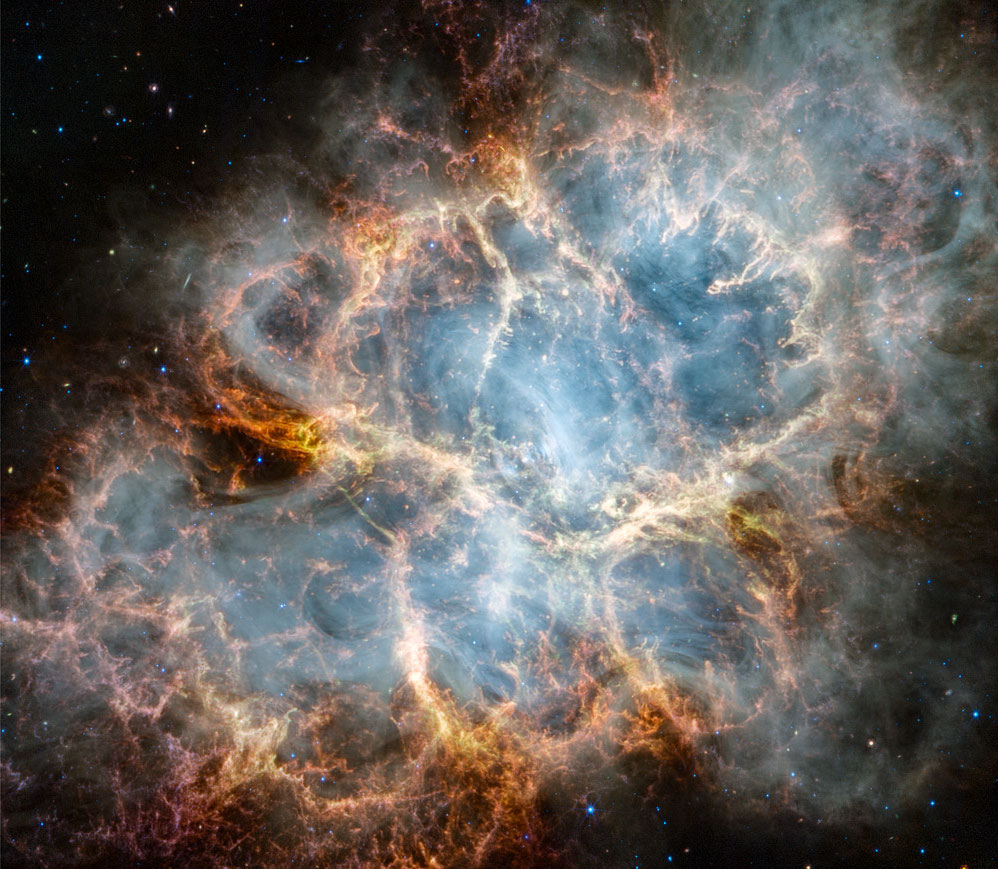
|
| Original url: https://apod.nasa.gov/apod/ap231115.html |
|
Explanation: Cataloged as M1, the Crab Nebula is the first on Charles Messier's famous list of things which are not comets . In fact, the Crab Nebula is now known to be a supernova remnant, an expanding cloud of debris from the death explosion of a massive star. The violent birth of the Crab was witnessed by astronomers in the year 1054. Roughly 10 light-years across , the nebula is still expanding at a rate of about 1,500 kilometers per second. You can see the expansion by comparing these sharp images from the Hubble Space Telescope and James Webb Space Telescope. The Crab's dynamic, fragmented filaments were captured in visible light by Hubble in 2005 and Webb in infrared light in 2023. This cosmic crustacean lies about 6,500 light-years away in the constellation Taurus . |
2023/11/14
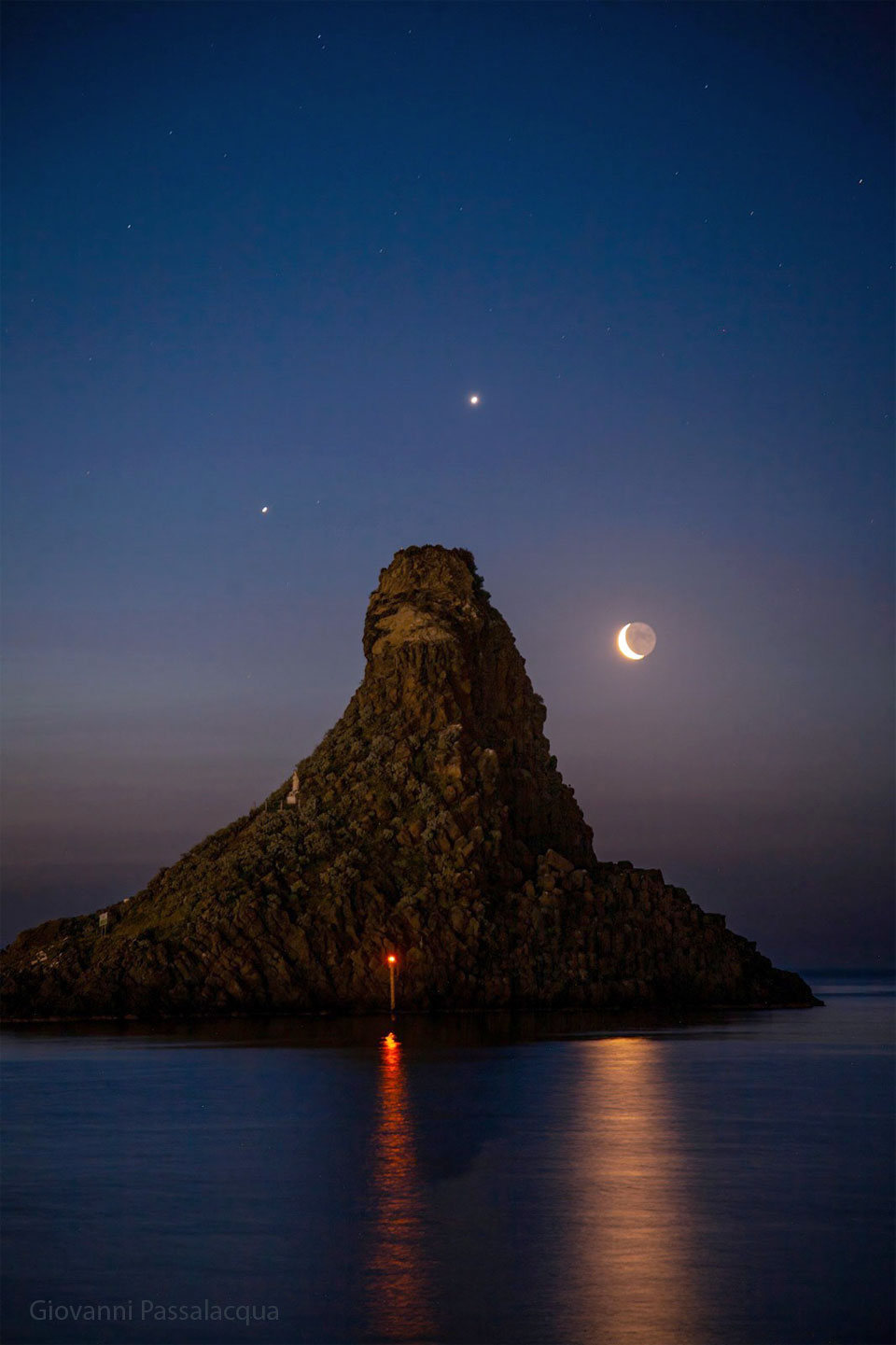
|
| Original url: https://apod.nasa.gov/apod/ap231114.html |
|
Explanation: In the fading darkness before dawn, a tilted triangle appeared to balance atop a rock formation off the southern tip of Sicily . Making up the points of the triangle are three of the four brightest objects visible in Earth’s sky: Jupiter , Venus and the Moon . Though a thin waning crescent , most of the moon’s disk is visible due to earthshine . Captured in this image on 2022 April 27, Venus (center) and Jupiter (left) are roughly three degrees apart -- and were headed toward a close conjunction . Conjunction s of Venus and Jupiter occur about once a year and are visible either in the east before sunrise or in the west after sunset. The featured image was taken about an hour before the arrival of the brightest object in Earth’s sky – the Sun . |
2023/11/13
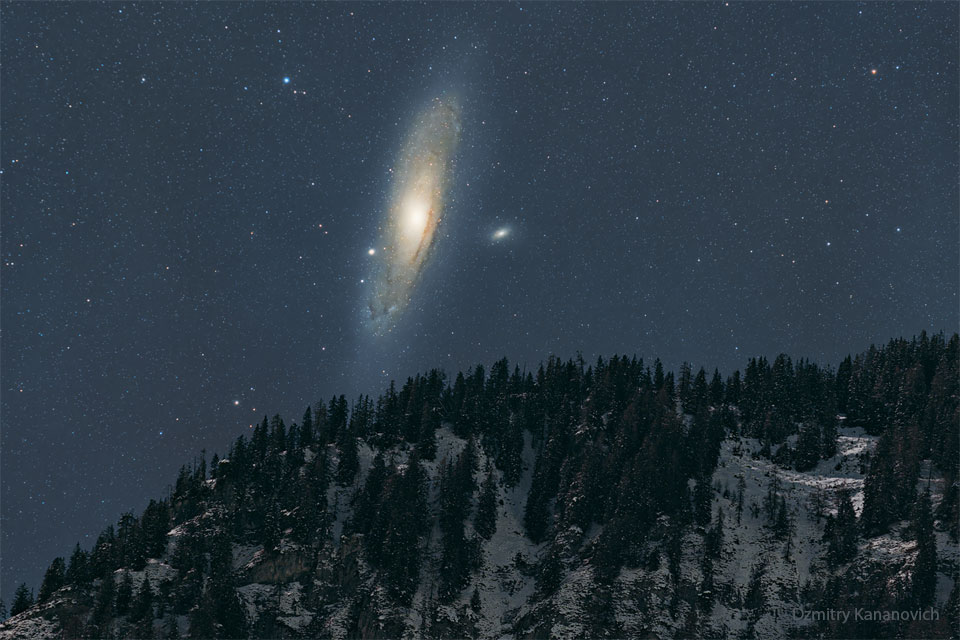
|
| Original url: https://apod.nasa.gov/apod/ap231113.html |
|
Explanation: Have you ever seen the Andromeda galaxy? Although M31 appears as a faint and fuzzy blob to the unaided eye, the light you see will be over two million years old, making it likely the oldest light you ever will see directly . The featured image captured Andromeda just before it set behind the Swiss Alps early last year. As cool as it may be to see this neighboring galaxy to our Milky Way with your own eyes, long duration camera exposures can pick up many faint and breathtaking details . The image is composite of foreground and background images taken consecutively with the same camera and from the same location. Recent data indicate that our Milky Way Galaxy will collide and coalesce with Andromeda galaxy in a few billion years. |
2023/11/12
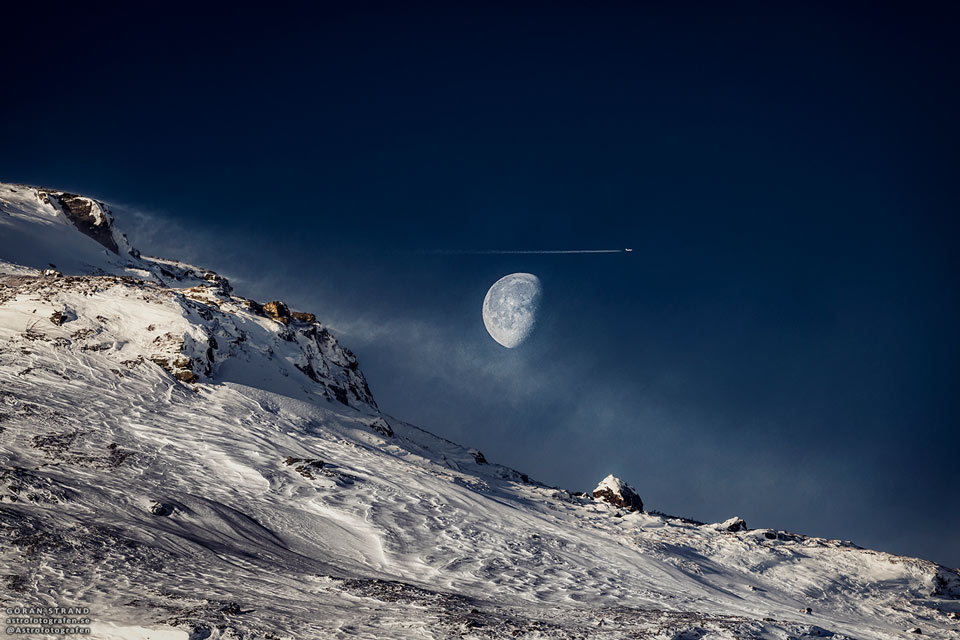
|
| Original url: https://apod.nasa.gov/apod/ap231112.html |
|
Explanation: This is a gibbous Moon. More Earthlings are familiar with a full moon, when the entire face of Luna is lit by the Sun , and a crescent moon , when only a sliver of the Moon's face is lit. When more than half of the Moon is illuminated, though, but still short of full illumination, the phase is called gibbous . Rarely seen in television and movies, gibbous moon s are quite common in the actual night sky. The featured image was taken in Jämtland , Sweden near the end of 2018 October. That gibbous moon turned, in a few days, into a crescent moon, and then a new moon , then back to a crescent, and a few days past that, back to gibbous. Setting up to capture a picturesque gibbous moonscape, the photographer was quite surprised to find an airplane, surely well in the foreground, appearing to fly past it. |
2023/11/11
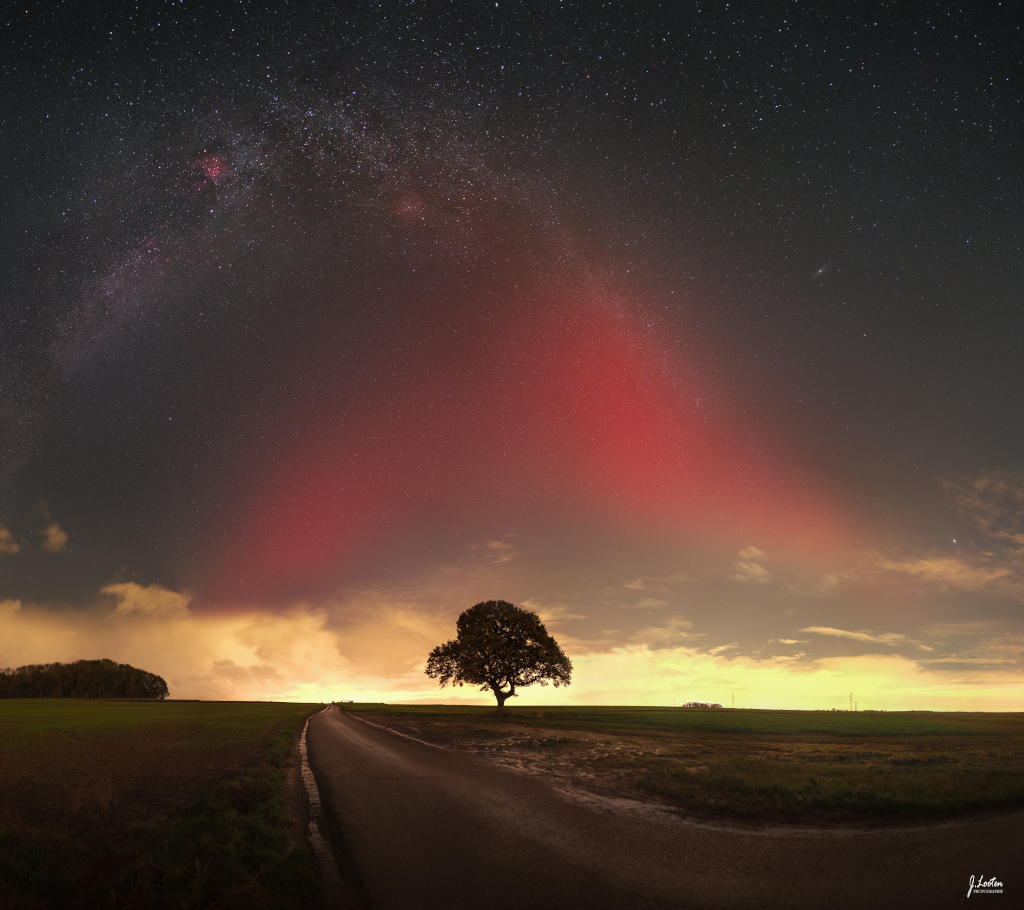
|
| Original url: https://apod.nasa.gov/apod/ap231111.html |
|
Explanation: This broad, luminous red arc was a surprising visitor to partly cloudy evening skies over northern France. Captured extending toward the zenith in a west-to-east mosaic of images from November 5, the faint atmospheric ribbon of light is an example of a Stable Auroral Red (SAR) arc. The rare night sky phenomenon was also spotted at unusually low latitudes around world, along with more dynamic auroral displays during an intense geomagnetic storm . SAR arcs and their relation to auroral emission have been explored by citizen science and satellite investigations. From altitudes substantially above the normal auroral glow, the deep red SAR emission is thought to be caused by strong heating due to currents flowing in planet Earth's inner magnetosphere . Beyond this SAR, the Milky Way arcs above the cloud banks along the horizon , a regular visitor to night skies over northern France. |
2023/11/10

|
| Original url: https://apod.nasa.gov/apod/ap231110.html |
|
Explanation: Dominated by dark matter , massive cluster of galaxies Abell 2744 is known to some as Pandora's Cluster . It lies 3.5 billion light-years away toward the constellation Sculptor. Using the galaxy cluster's enormous mass as a gravitational lens to warp spacetime and magnify even more distant objects directly behind it, astronomers have found a background galaxy, UHZ1, at a remarkable redshift of Z=10.1 . That puts UHZ1 far beyond Abell 2744, at a distance of 13.2 billion light-years, seen when our universe was about 3 percent of its current age. UHZ1 is identified in the insets of this composited image combining X-rays (purple hues) from the spacebased Chandra X-ray Observatory and infrared light from the James Webb Space Telescope. The X-ray emission from UHZ1 detected in the Chandra data is the telltale signature of a growing supermassive black hole at the center of the ultra high redshift galaxy. That makes UHZ1's growing black hole the most distant black hole ever detected in X-rays, a result that now hints at how and when the first supermassive black holes in the universe formed . |
2023/11/09
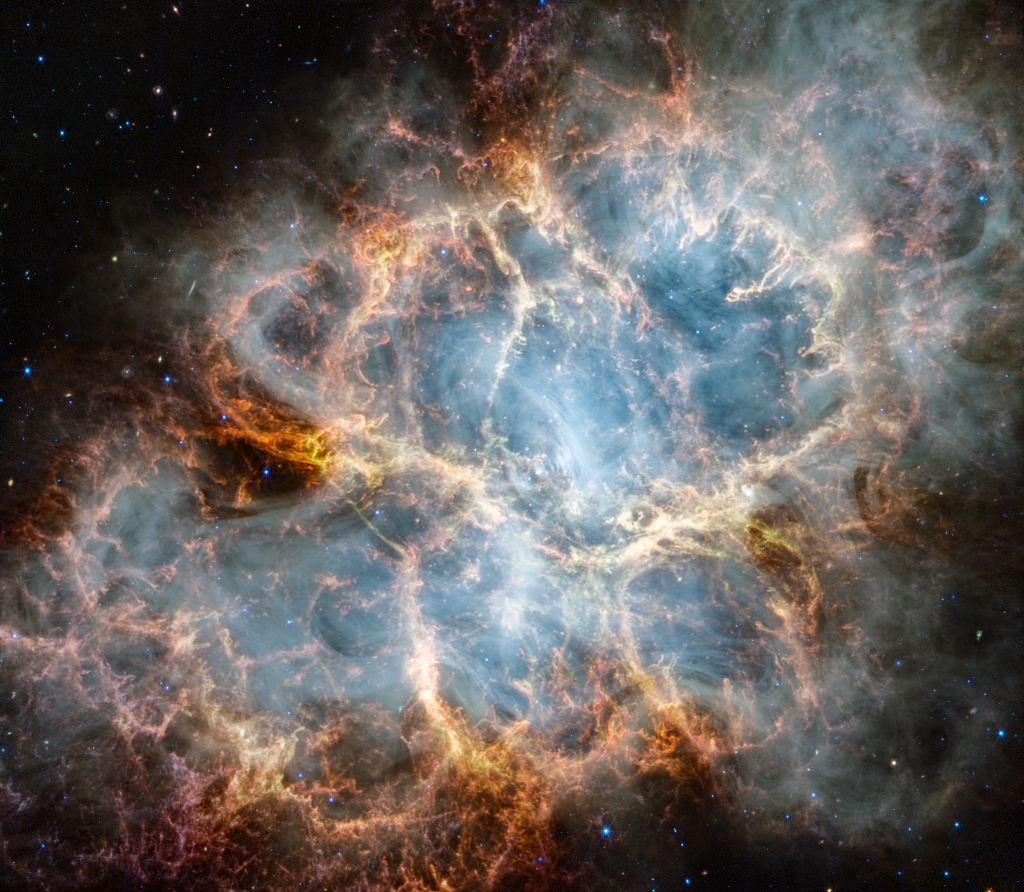
|
| Original url: https://apod.nasa.gov/apod/ap231109.html |
|
Explanation: The Crab Nebula is cataloged as M1, the first object on Charles Messier's famous 18th century list of things which are not comets. In fact, the Crab is now known to be a supernova remnant , debris from the death explosion of a massive star witnessed by astronomers in the year 1054. This sharp image from the James Webb Space Telescope’s NIRCam (Near-Infrared Camera) and MIRI (Mid-Infrared Instrument) explores the eerie glow and fragmented strands of the still expanding cloud of interstellar debris in infrared light. One of the most exotic objects known to modern astronomers, the Crab Pulsar , a neutron star spinning 30 times a second, is visible as a bright spot near the nebula's center. Like a cosmic dynamo , this collapsed remnant of the stellar core powers the Crab's emission across the electromagnetic spectrum. Spanning about 12 light-years, the Crab Nebula is a mere 6,500 light-years away in the head-strong constellation Taurus . |
2023/11/08
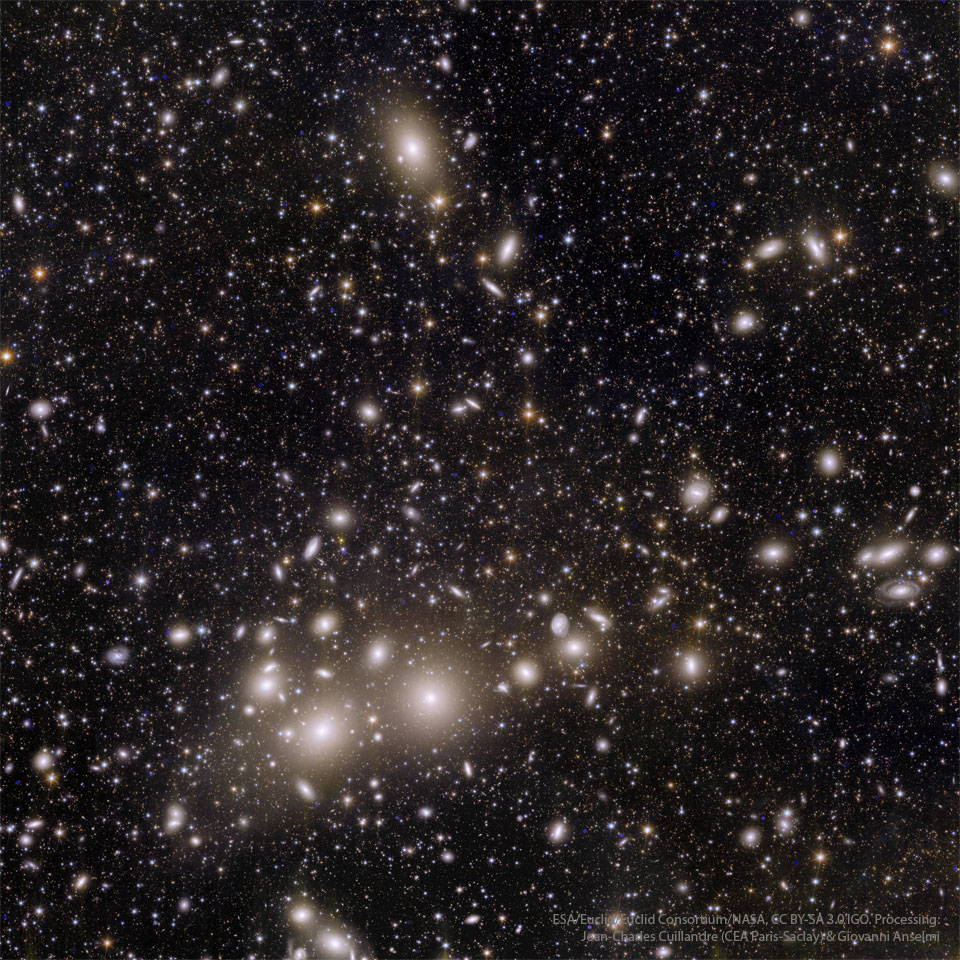
|
| Original url: https://apod.nasa.gov/apod/ap231108.html |
|
Explanation: There's a new space telescope in the sky: Euclid . Equipped with two large panoramic cameras, Euclid captures light from the visible to the near- infrared . It took five hours of observing for Euclid's 1.2-meter diameter primary mirror to capture, through its sharp optics , the 1000+ galaxies in the Perseus cluster , which lies 250 million light years away. More than 100,000 galaxies are visible in the background, some as far away as 10 billion light years. The revolutionary nature of Euclid lies in the combination of its wide field of view (twice the area of the full moon), its high angular resolution (thanks to its 620 Megapixel camera ), and its infrared vision, which captures both images and spectra . Euclid's initial surveys , covering a third of the sky and recording over 2 billion galaxies, will enable a study of how dark matter and dark energy have shaped our universe . |
2023/11/06

|
| Original url: https://apod.nasa.gov/apod/ap231107.html |
|
Explanation: What was that red glow on the horizon last night? Aurora. Our unusually active Sun produced a surface explosion a few days ago that sent out a burst of electrons, protons, and more massive charged nuclei. This coronal mass ejection (CME) triggered auroras here on Earth that are being reported unusually far south in Earth's northern hemisphere . For example, this was the first time that the astrophotographer captured aurora from her home country of Italy . Additionally, many images from these auroras appear quite red in color . In the featured image , the town of Comelico Superiore in the Italian Alps is visible in the foreground, with the central band of our Milky Way galaxy seen rising from the lower left. What draws the eye the most, though, is the bright red aurora on the far right. The featured image is a composite with the foreground and background images taken consecutively with the same camera and from the same location. |
2023/11/05
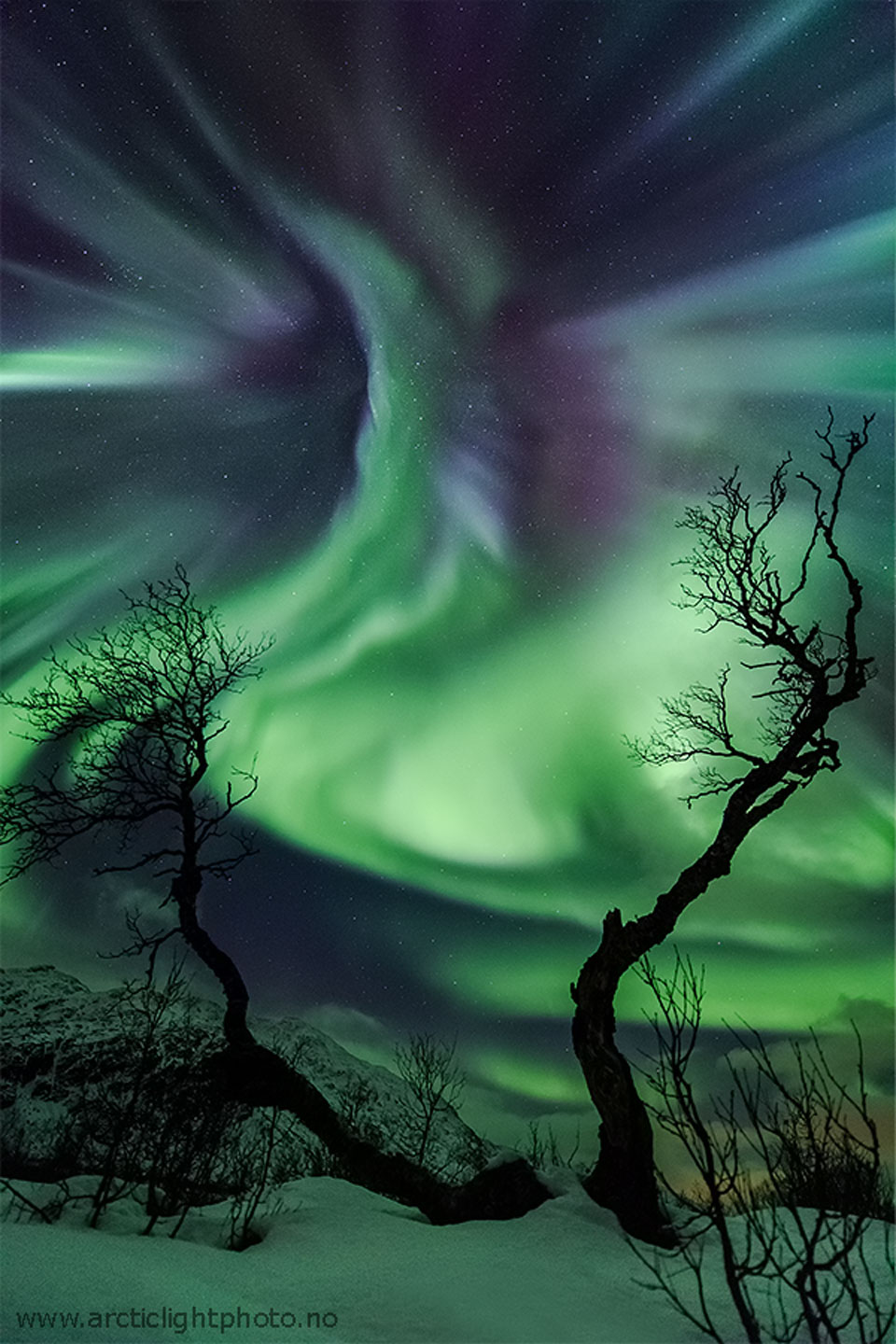
|
| Original url: https://apod.nasa.gov/apod/ap231105.html |
|
Explanation: It was Halloween and the sky looked like a creature. Exactly which creature, the astrophotographer was unsure (but possibly you can suggest one ). Exactly what caused this eerie apparition in 2013 was sure: one of the best auroral displays that year. This spectacular aurora had an unusually high degree of detail . Pictured here , the vivid green and purple auroral colors are caused by high atmospheric oxygen and nitrogen reacting to a burst of incoming electrons . Birch trees in Tromsø , Norway formed an also eerie foreground . Frequently, new photogenic auroras accompany new geomagnetic storms . |
2023/11/04
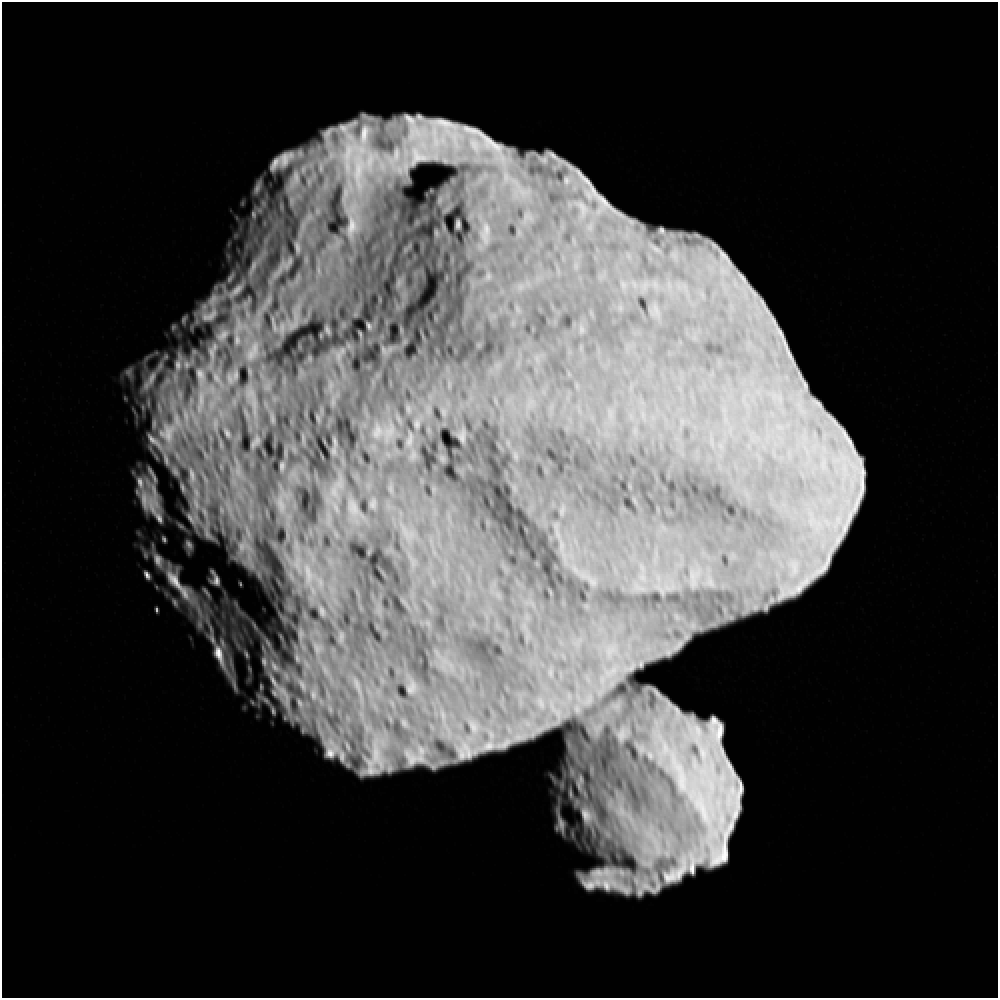
|
| Original url: https://apod.nasa.gov/apod/ap231104.html |
|
Explanation: Last Wednesday the voyaging Lucy spacecraft encountered its first asteroid, 152830 Dinkinesh, and discovered the inner-main belt asteroid has a moon. From a distance of just over 400 kilometers, Lucy's Long-Range Reconnaissance Imager captured this close-up of the binary system during a flyby at 4.5 kilometer per second or around 10,000 miles per hour. A marvelous world, Dinkinesh itself is small, less than 800 meters (about 0.5 miles) across at its widest. Its satellite is seen from the spacecraft's perspective to emerge from behind the primary asteroid. The asteroid moon is estimated to be only about 220 meters wide. |
2023/11/03

|
| Original url: https://apod.nasa.gov/apod/ap231103.html |
|
Explanation: That bright beacon you've seen rising in the east just after sunset is Jupiter. Climbing high in midnight skies, our Solar System's ruling gas giant was at its 2023 opposition, opposite the Sun in planet Earth's sky, on November 2. But only a few days earlier, on October 28, the Moon was at its own opposition. Then both Full Moon and Jupiter could share this telephoto field of view. The celestial scene is composed from two exposures, one long and one short, blended to record bright planet and even brighter Moon during that evening's partial lunar eclipse . Moonlight shining through the thin, high clouds over northern Italy creates the colorful iridescence and lunar corona . Look closely and you'll also spot some of Jupiter's Galilean moons . |
2023/11/02

|
| Original url: https://apod.nasa.gov/apod/ap231102.html |
|
Explanation: Named for the southern constellation toward which most of its galaxies can be found, the Fornax Cluster is one of the closest clusters of galaxies. About 62 million light-years away, it's over 20 times more distant than our neighboring Andromeda Galaxy , but only about 10 percent farther along than the better known and more populated Virgo Galaxy Cluster . Seen across this three degree wide field-of-view, almost every yellowish splotch on the image is an elliptical galaxy in the Fornax cluster. Elliptical galaxies NGC 1399 and NGC 1404 are the dominant, bright cluster members toward the bottom center. A standout, large barred spiral galaxy, NGC 1365 , is visible on the upper right as a prominent Fornax cluster member. |
2023/11/01
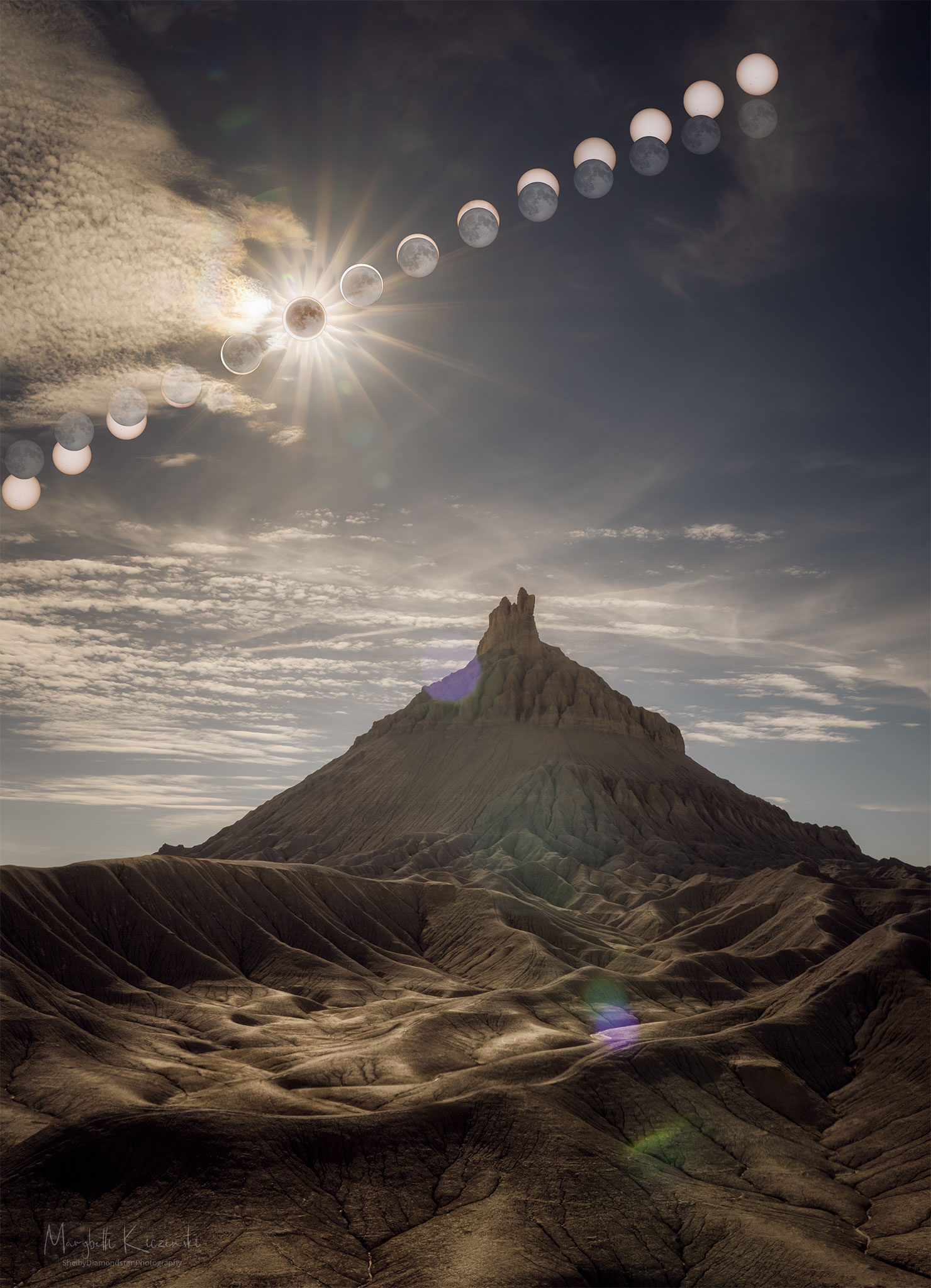
|
| Original url: https://apod.nasa.gov/apod/ap231101.html |
|
Explanation: Part of the Sun disappeared earlier this month, but few people were worried. The missing part, which included the center from some locations, just went behind the Moon in what is known as an annular solar eclipse . Featured here is an eclipse sequence taken as the Moon was overtaking the rising Sun in the sky. The foreground hill is Factory Butte in Utah , USA . The rays flaring out from the Sun are not real -- they result from camera aperture diffraction and are known as sunstar . The Moon is real , but it is artificially brightened to enhance its outline -- which helps the viewer better visualize the Moon's changing position during this ring-of-fire eclipse . As stunning as this eclipse sequence is, it was considered just practice by the astrophotographer. The reason? She hopes to use this experience to better photograph the total solar eclipse that will occur over North America on April 8, 2024. |
2023/10/31
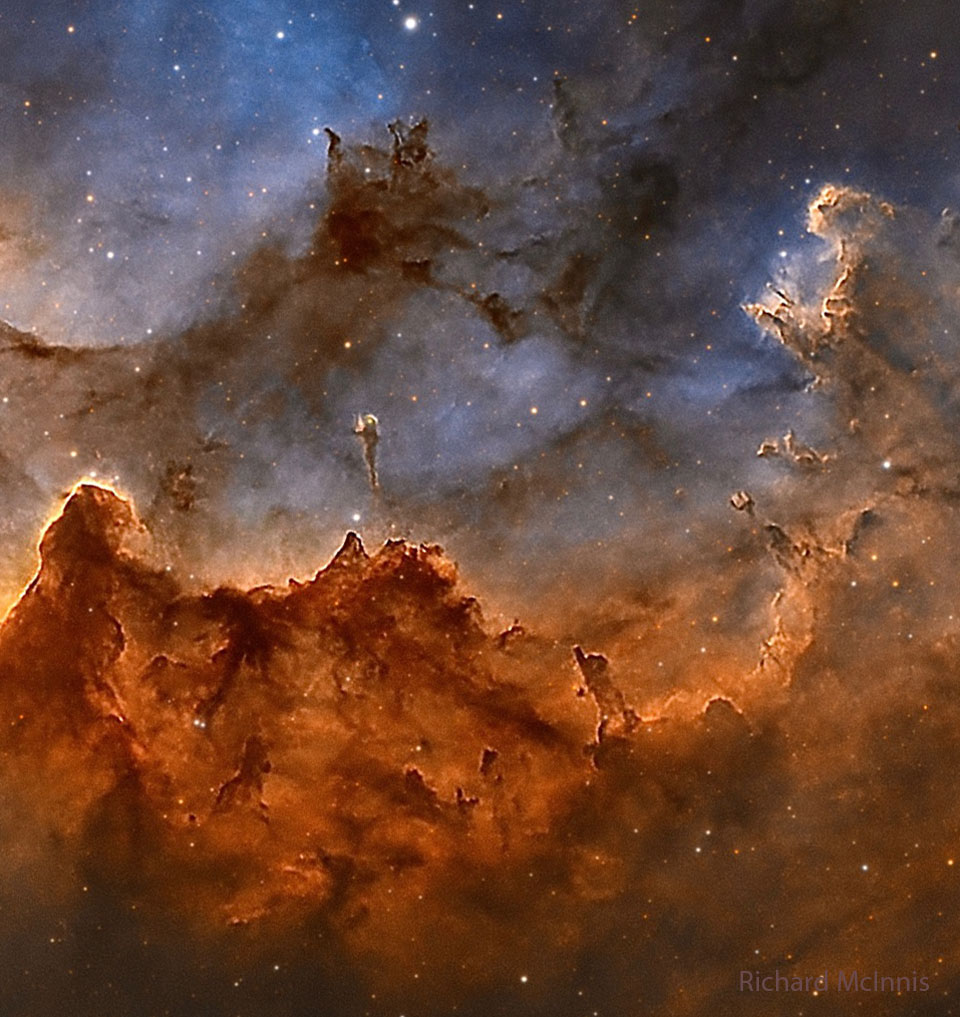
|
| Original url: https://apod.nasa.gov/apod/ap231031.html |
|
Explanation: Halloween's origin is ancient and astronomical. Since the fifth century BC, Halloween has been celebrated as a cross-quarter day , a day halfway between an equinox (equal day / equal night) and a solstice (minimum day / maximum night in the northern hemisphere). With a modern calendar however, even though Halloween occurs today, the real cross- quarter day will occur next week . Another cross-quarter day is Groundhog Day . Halloween's modern celebration retains historic roots in dressing to scare away the spirits of the dead. Perhaps a fitting tribute to this ancient holiday is this closeup view of the Wizard Nebula (NGC 7380). Visually, the interplay of stars, gas, and dust has created a shape that appears to some like a fictional ancient sorcerer . Although the nebula may last only a few million years, some of the stars being conjured from the gas by the great gravitational powers may outlive our Sun. |
2023/10/30
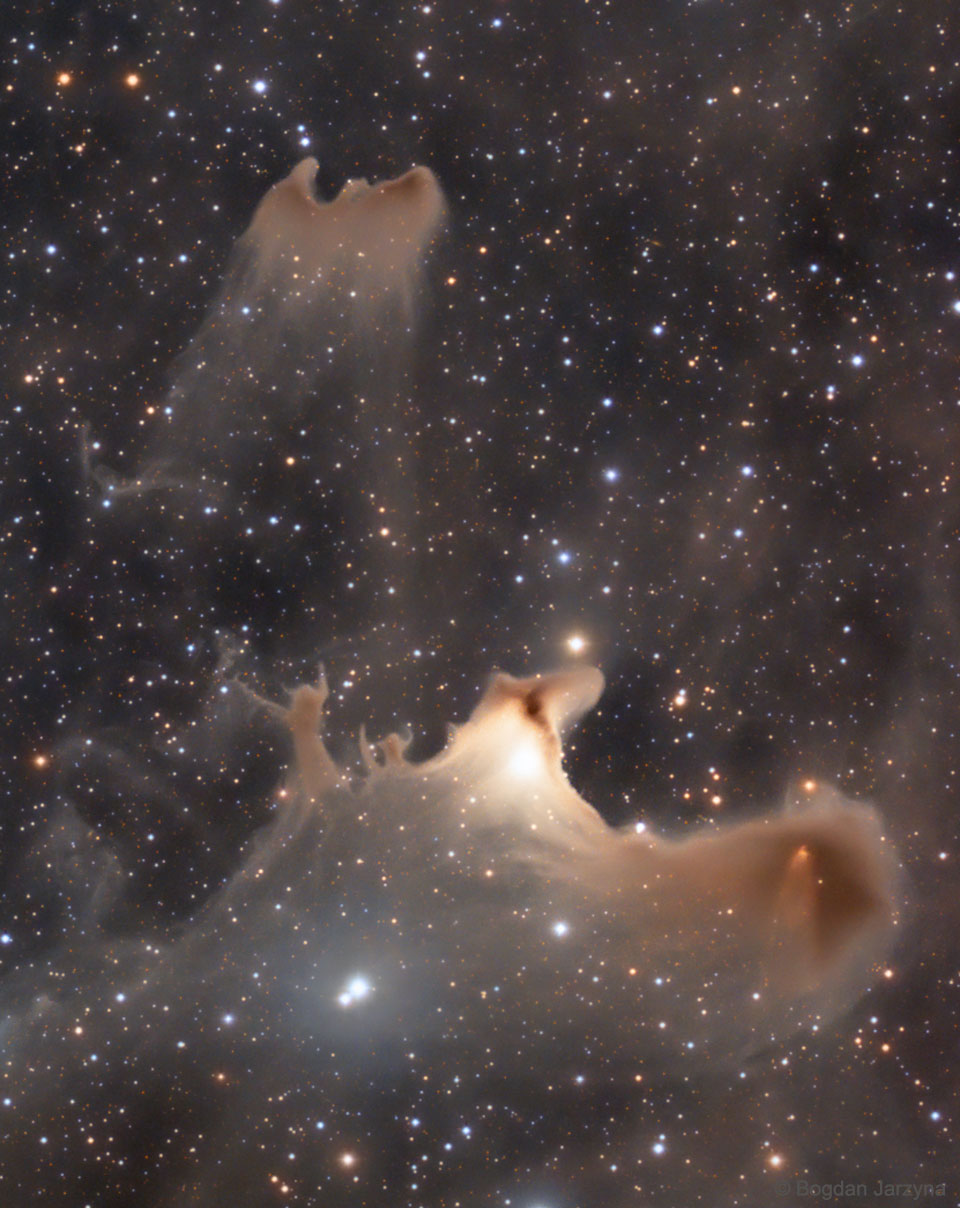
|
| Original url: https://apod.nasa.gov/apod/ap231030.html |
|
Explanation: Do any shapes seem to jump out at you from this interstellar field of stars and dust? The jeweled expanse, filled with faint, starlight-reflecting clouds, drifts through the night in the royal constellation of Cepheus . Far from your own neighborhood on planet Earth , these ghostly apparition s lurk along the plane of the Milky Way at the edge of the Cepheus Flare molecular cloud complex some 1,200 light-years away. Over two light-year s across and brighter than the other spooky chimera s, VdB 141 or Sh2-136 is also known as the Ghost Nebula , seen toward the bottom of the featured image . Within the reflection nebula are the telltale signs of dense cores collapsing in the early stages of star formation. |
2023/10/29
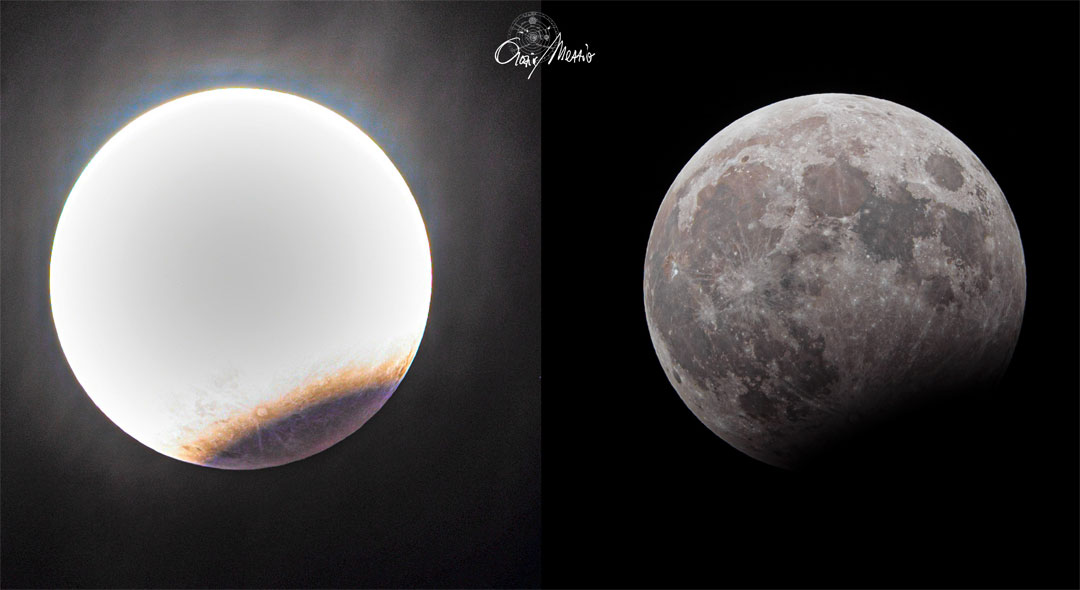
|
| Original url: https://apod.nasa.gov/apod/ap231029.html |
|
Explanation: What's happened to the Moon? Within the last day, part of the Moon moved through the Earth's shadow . This happens about once or twice a year , but not every month since the Moon's orbit around the Earth is slightly tilted . Pictured here, the face of a full Hunter's Moon is shown twice from Italy during this partial lunar eclipse . On the left, most of the Moon appears over exposed except for the eclipsed bottom right, which shows some familiar lunar surface details. In contrast, on the right, most of the (same) Moon appears normally exposed, with the exception of the bottom right, which now appears dark. All lunar eclipses are visible from the half of the Earth facing the Moon at the time of the eclipse, but this eclipse was visible specifically from Europe , Africa , Asia , and Australia , clouds permitting . In April, a total solar eclipse will be visible from North America . |
2023/10/28
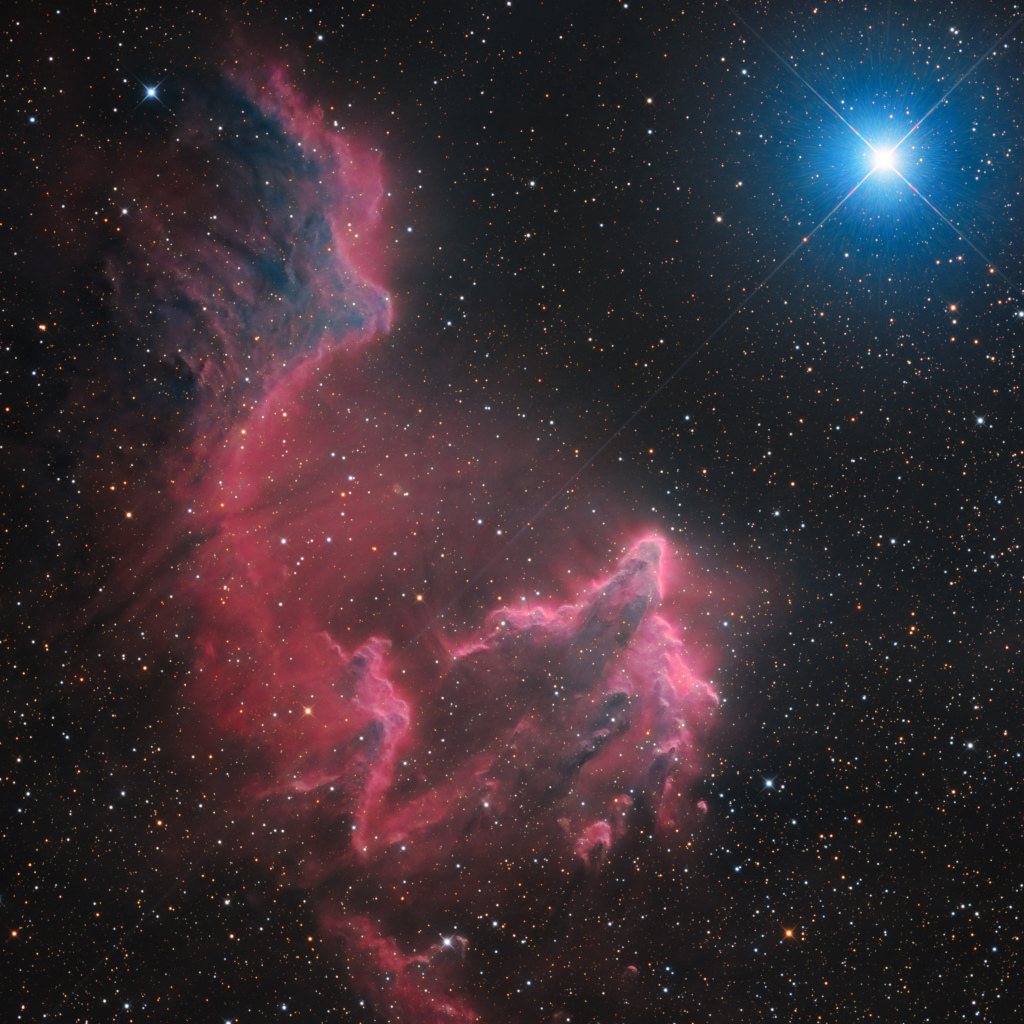
|
| Original url: https://apod.nasa.gov/apod/ap231028.html |
|
Explanation: Gamma Cassiopeiae shines high in northern autumn evening skies. It's the brightest spiky star in this telescopic field of view toward the constellation Cassiopeia. Gamma Cas shares the ethereal-looking scene with ghostly interstellar clouds of gas and dust, IC 59 (top left) and IC 63. About 600 light-years distant, the clouds aren't actually ghosts. They are slowly disappearing though, eroding under the influence of energetic radiation from hot and luminous gamma Cas. Gamma Cas is physically located only 3 to 4 light-years from the nebulae. Slightly closer to gamma Cas, IC 63 is dominated by red H-alpha light emitted as hydrogen atoms ionized by the star's ultraviolet radiation recombine with electrons. Farther from the star, IC 59 shows proportionally less H-alpha emission but more of the characteristic blue tint of dust reflected star light . The cosmic stage spans over 1 degree or 10 light-years at the estimated distance of gamma Cas and friends . |
2023/10/27
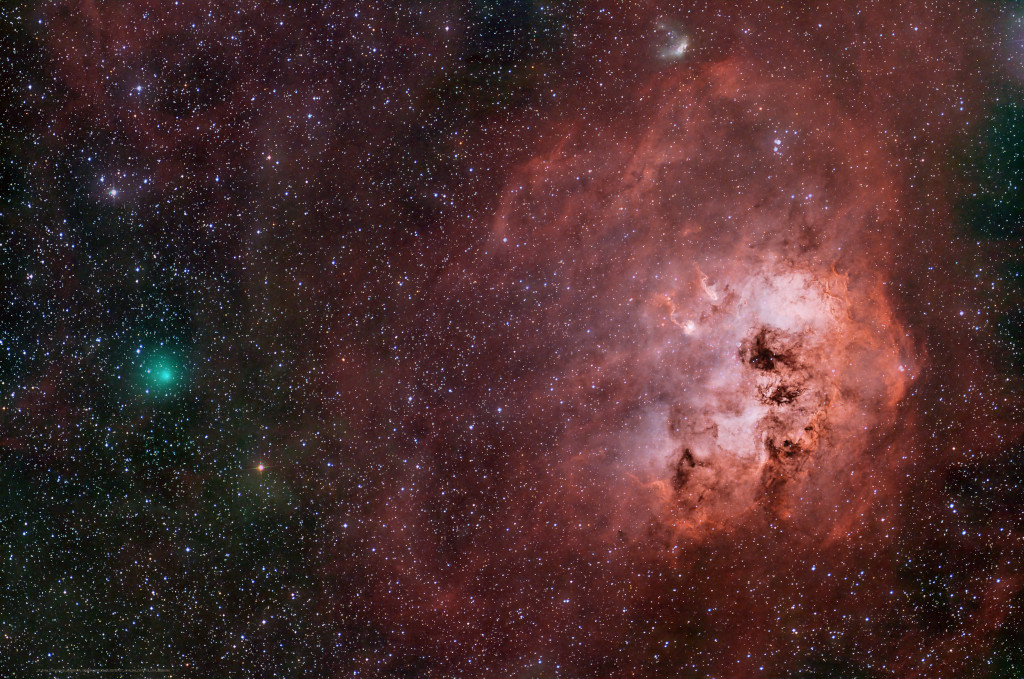
|
| Original url: https://apod.nasa.gov/apod/ap231027.html |
|
Explanation: History's second known periodic comet is Comet Encke (2P/Encke) . As it swings through the inner Solar System, Encke's orbit takes it from an aphelion, its greatest distance from the Sun, inside the orbit of Jupiter to a perihelion just inside the orbit of Mercury. Returning to its perihelion every 3.3 years, Encke has the shortest period of the Solar System's major comets . Comet Encke is also associated with ( at least ) two annual meteor showers on planet Earth, the North and South Taurids . Both showers are active in late October and early November. Their two separate radiants lie near bright star Aldebaran in the head-strong constellation Taurus. A faint comet, Encke was captured in this telescopic field of view imaged on the morning of August 24. Then, Encke's pretty greenish coma was close on the sky to the young, embedded star cluster and light-years long, tadpole-shaped star-forming clouds in emission nebula IC 410. Now near bright star Spica in Virgo Comet Encke passed its 2023 perihelion only five days ago, on October 22. |
2023/10/26
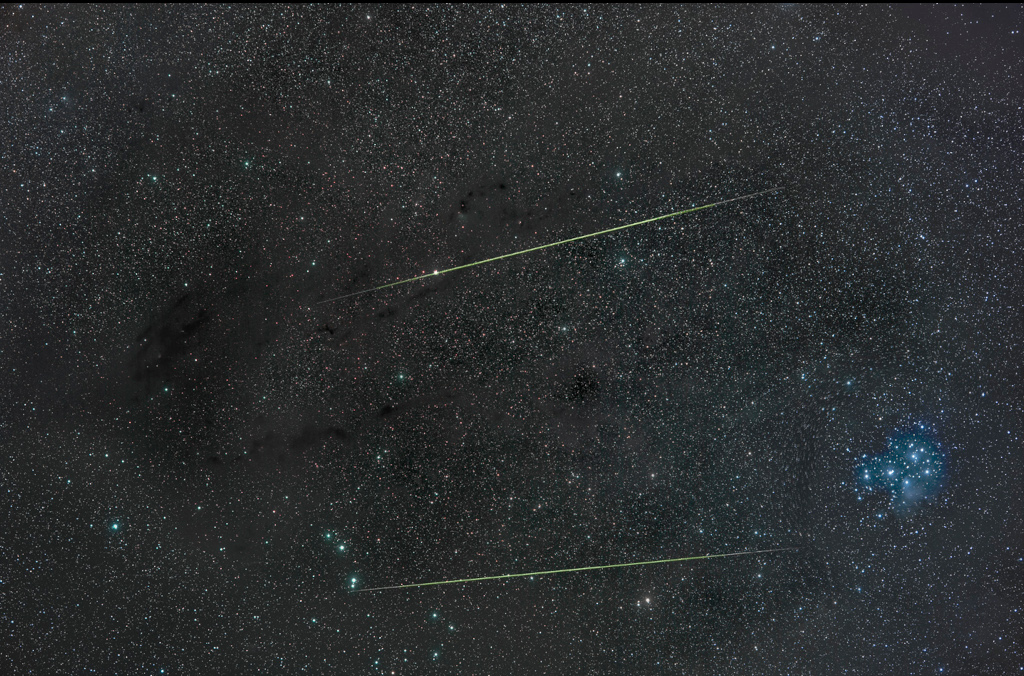
|
| Original url: https://apod.nasa.gov/apod/ap231026.html |
|
Explanation: History's first known periodic comet, Comet Halley (1P/Halley) , returns to the inner Solar System every 76 years or so. The famous comet made its last appearance to the naked-eye in 1986. But dusty debris from Comet Halley can be seen raining through planet Earth's skies twice a year during two annual meteor showers, the Eta Aquarids in May and the Orionids in October . In fact, an unhurried series of exposures captured these two bright meteors, vaporizing bits of Halley dust, during the early morning hours of October 23 against a starry background along the Taurus molecular cloud. Impacting the atmosphere at about 66 kilometers per second their greenish streaks point back to the shower's radiant just north of Orion's bright star Betelgeuse off the lower left side of the frame. The familiar Pleiades star cluster anchors the dusty celestial scene at the right. |
2023/10/24

|
| Original url: https://apod.nasa.gov/apod/ap231025.html |
|
Explanation: This dance is to the death. As these two large galaxies duel, a cosmic bridge of stars, gas, and dust currently stretches over 75,000 light-years and joins them. The bridge itself is strong evidence that these two immense star systems have passed close to each other and experienced violent tides induced by mutual gravity. As further evidence, the face-on spiral galaxy on the right, also known as NGC 3808A, exhibits many young blue star clusters produced in a burst of star formation. The twisted edge-on spiral on the left (NGC 3808B) seems to be wrapped in the material bridging the galaxies and surrounded by a curious polar ring . Together, the system is known as Arp 87 . While such interactions are drawn out over billions of years, repeated close passages will ultimately create one merged galaxy. Although this scenario does look unusual, galactic mergers are thought to be common, with Arp 87 representing a stage in this inevitable process . The Arp 87 dancing pair are about 300 million light-years distant toward the constellation of the Lion ( Leo ). The prominent edge-on spiral galaxy at the far left appears to be a more distant background galaxy and not involved in the on-going merger. |
2023/10/23

|
| Original url: https://apod.nasa.gov/apod/ap231023.html |
|
Explanation: There goes another one! Volcanoes on Jupiter 's moon Io keep erupting. To investigate, NASA 's robotic Juno spacecraft has begun a series of visits to this very strange moon. Io is about the size of Earth's moon , but because of gravitational flexing by Jupiter and other moons, Io's interior gets heated and its surface has become covered with volcanoes . The featured image is from last week's flyby , passing within 12,000 kilometers above the dangerously active world. The surface of Io is covered with sulfur and frozen sulfur dioxide, making it appear yellow, orange and brown. As hoped, Juno flew by just as a volcano was erupting -- with its faint plume visible near the top of the featured image. Studying Io's volcanoes and plumes helps humanity better understand how Jupiter's complex system of moons, rings, and auroras interact. Juno is scheduled to make two flybys of Io during the coming months that are almost 10 times closer: one in December and another in February 2024. |
2023/10/22
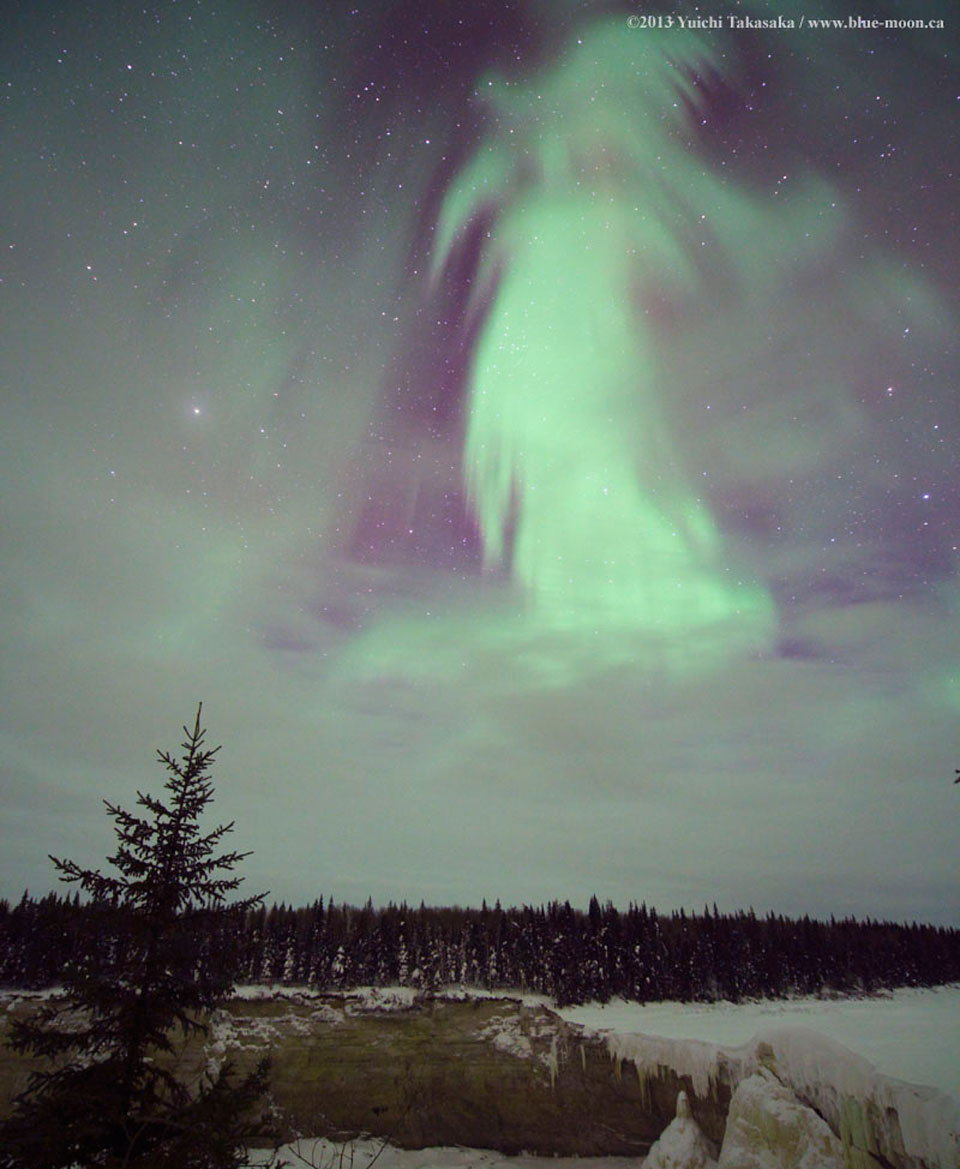
|
| Original url: https://apod.nasa.gov/apod/ap231022.html |
|
Explanation: What does this aurora look like to you? While braving the cold to watch the skies above northern Canada early one morning in 2013, a most unusual aurora appeared. The aurora definitely appeared to be shaped like something , but what? Two ghostly possibilities recorded by the astrophotographer were "witch" and "goddess of dawn", but please feel free to suggest your own Halloween-enhanced impressions. Regardless of fantastical pareidolic interpretations, the pictured aurora had a typical green color and was surely caused by the scientifically commonplace action of high-energy particles from space interacting with oxygen in Earth's upper atmosphere . In the image foreground, at the bottom, is a frozen Alexandra Falls , while evergreen trees cross the middle. |
2023/10/21
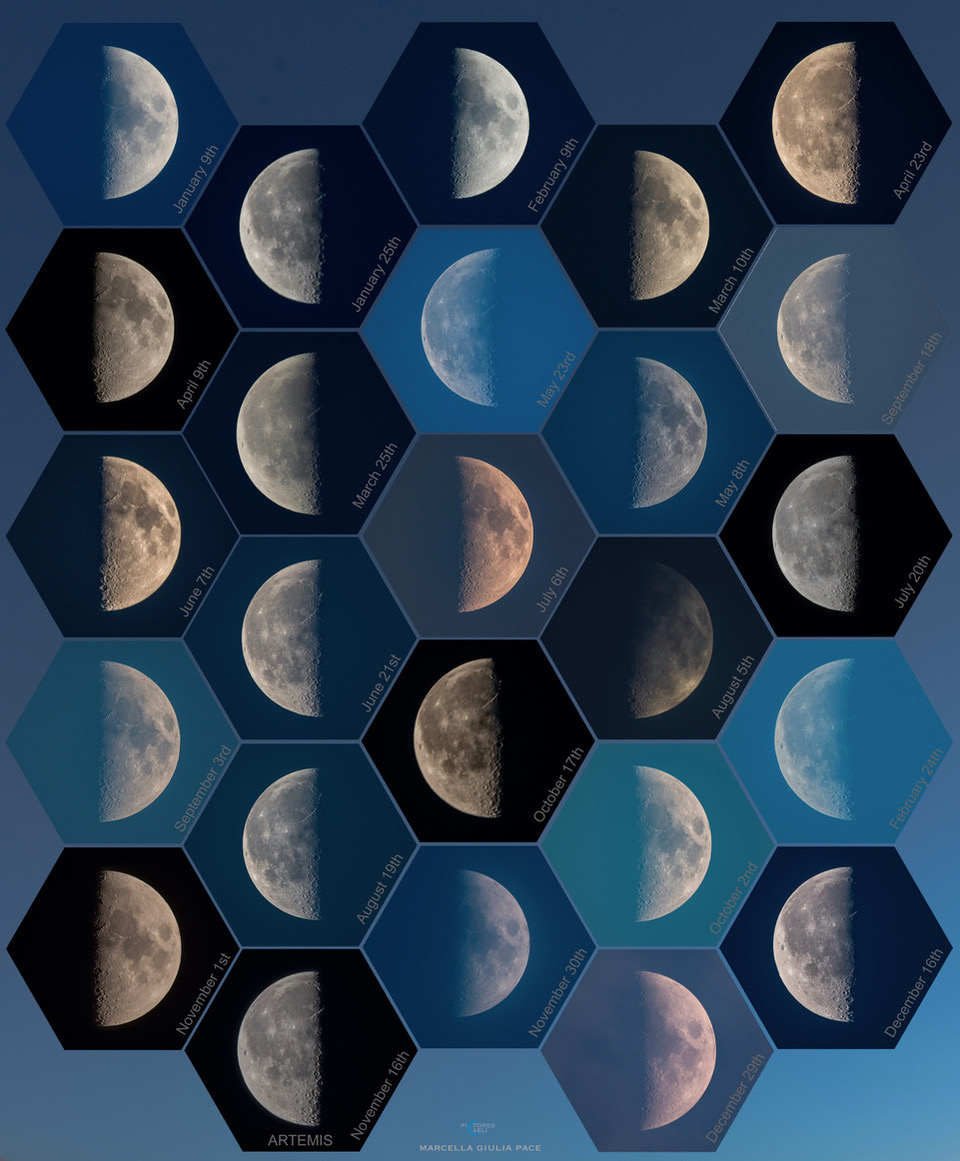
|
| Original url: https://apod.nasa.gov/apod/ap231021.html |
|
Explanation: Half way between New Moon and Full Moon is the Moon's first quarter phase . That's a quarter of the way around its moonthly orbit. At the first quarter phase, half the Moon's visible side is illuminated by sunlight. For the Moon's third quarter phase, half way between Full Moon and New Moon, sunlight illuminates the other half of the visible lunar disk. At both first and third quarter phases, the terminator, or shadow line separating the lunar night and day, runs down the middle. Near the terminator , long shadows bring lunar craters and mountains in to sharp relief, making the quarter phases a good time to observe the Moon. But in case you missed some, all the quarter phases of the Moon and their calendar dates during 2022 can be found in this well-planned array of telephoto images. Of course, you can observe a first quarter Moon tonight. |
2023/10/20
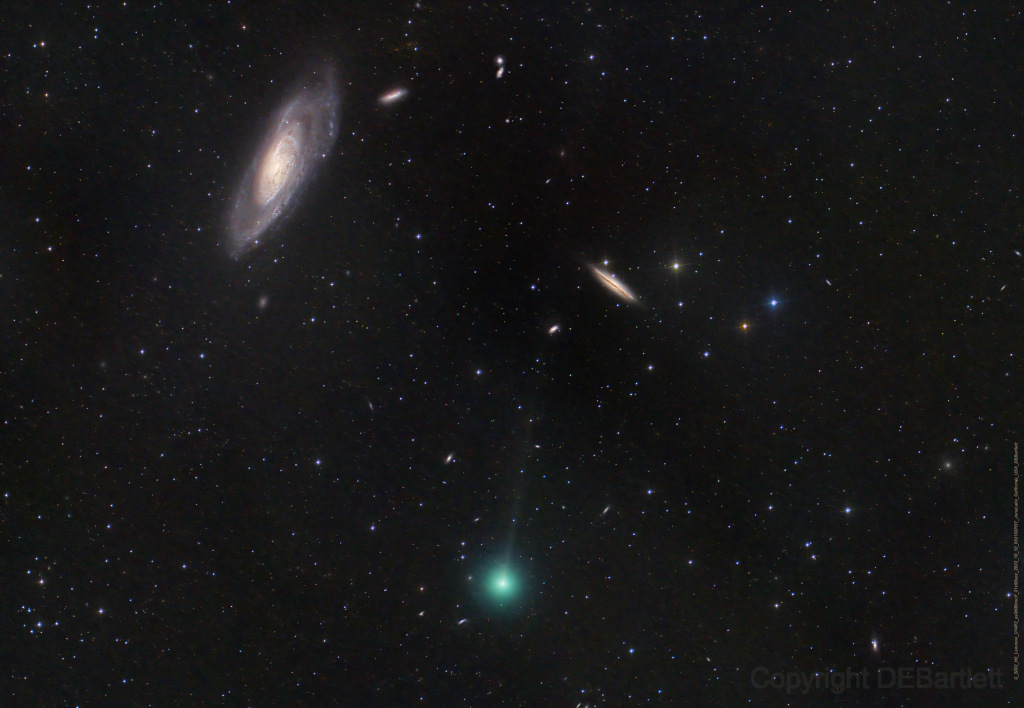
|
| Original url: https://apod.nasa.gov/apod/ap231020.html |
|
Explanation: Galaxies abound in this sharp telescopic image recorded on October 12 in dark skies over June Lake, California. The celestial scene spans nearly 2 degrees within the boundaries of the well-trained northern constellation Canes Venatici. Prominent at the upper left 23.5 million light-years distant is big, beautiful spiral galaxy NGC 4258, known to some as Messier 106 . Eye-catching edge-on spiral NGC 4217 is above and right of center about 60 million light-years away. Just passing through the pretty field of view is comet C/2023 H2 Lemmon , discovered last April in image data from the Mount Lemmon Survey . Here the comet sports more of a lime green coma though, along with a faint, narrow ion tail stretching toward the top of the frame. This visitor to the inner Solar System is presently less than 7 light-minutes away and still difficult to spot with binoculars, but it's growing brighter. Comet C/2023 H2 Lemmon will reach perihelion, its closest point to the Sun, on October 29 and perigee, its closest to our fair planet, on November 10 as it transitions from morning to evening northern skies. |
2023/10/19

|
| Original url: https://apod.nasa.gov/apod/ap231019.html |
|
Explanation: This timelapse series captured on October 14 is set against the sunrise view from Sunset Point, Bryce Canyon, planet Earth . Of course on that date the New Moon caught up with the Sun in the canyon's morning skies. Local temperatures fell as the Moon's shadow swept across the high altitude scene and the brilliant morning sunlight became a more subdued yellow hue cast over the reddish rocky landscape. In the timelapse series, images were taken at 2 minute intervals. The camera and solar filter were fixed to a tripod to follow the phases of the annular solar eclipse . |
2023/10/18
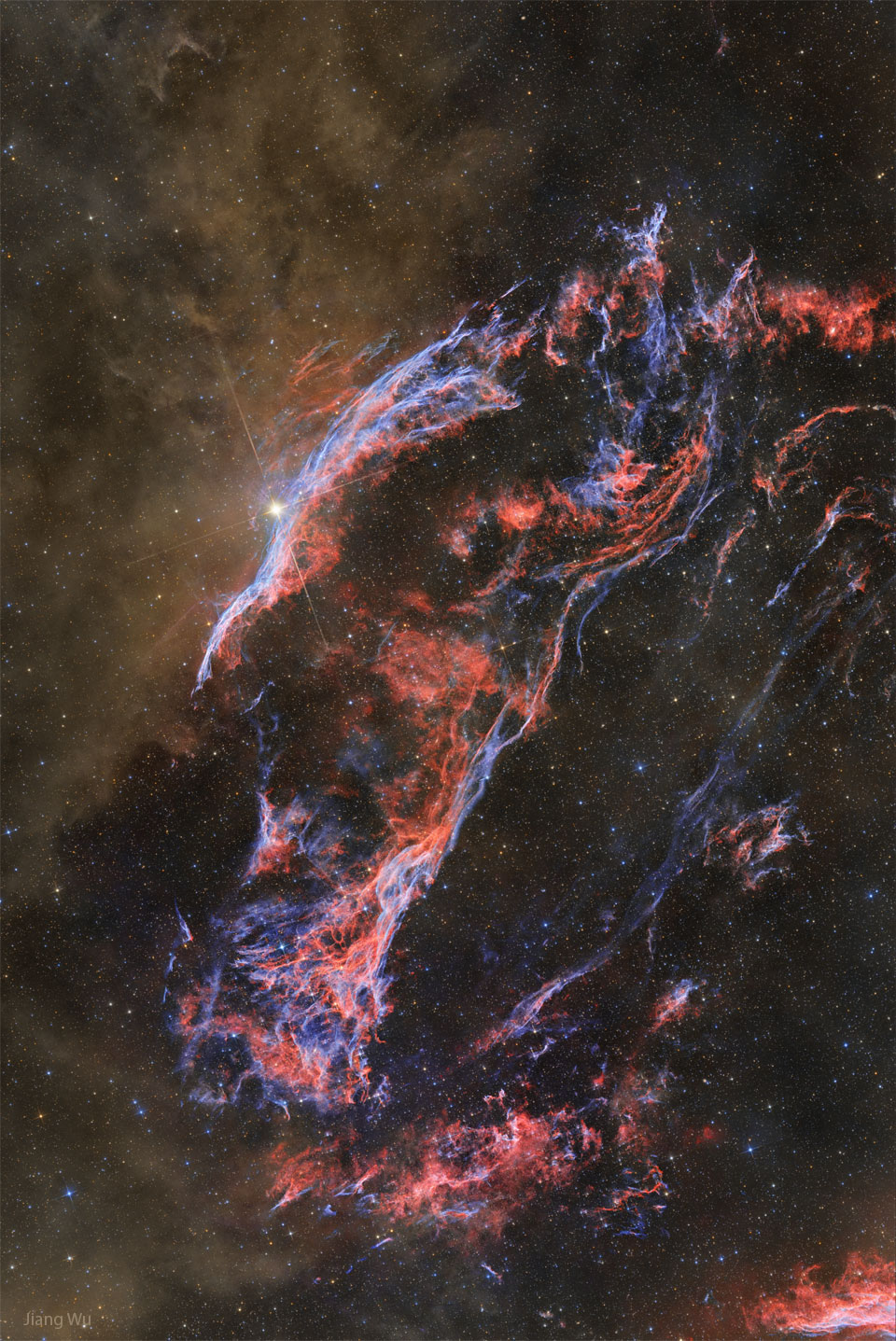
|
| Original url: https://apod.nasa.gov/apod/ap231018.html |
|
Explanation: It's so big it is easy to miss. The entire Veil Nebula spans six times the diameter of the full moon , but is so dim you need binoculars to see it. The nebula was created about 15,000 years ago when a star in the constellation of the Swan ( Cygnus ) exploded. The spectacular explosion would have appeared brighter than even Venus for a week - but there is no known record of it. Pictured is the western edge of the still-expanding gas cloud. Notable gas filaments include the Witch's Broom Nebula on the upper left near the bright foreground star 52 Cygni , and Fleming's Triangular Wisp (formerly known as Pickering's Triangle ) running diagonally up the image middle. What is rarely imaged -- but seen in the featured long exposure across many color bands -- is the reflecting brown dust that runs vertically up the image left, dust likely created in the cool atmospheres of massive stars . |
2023/10/17
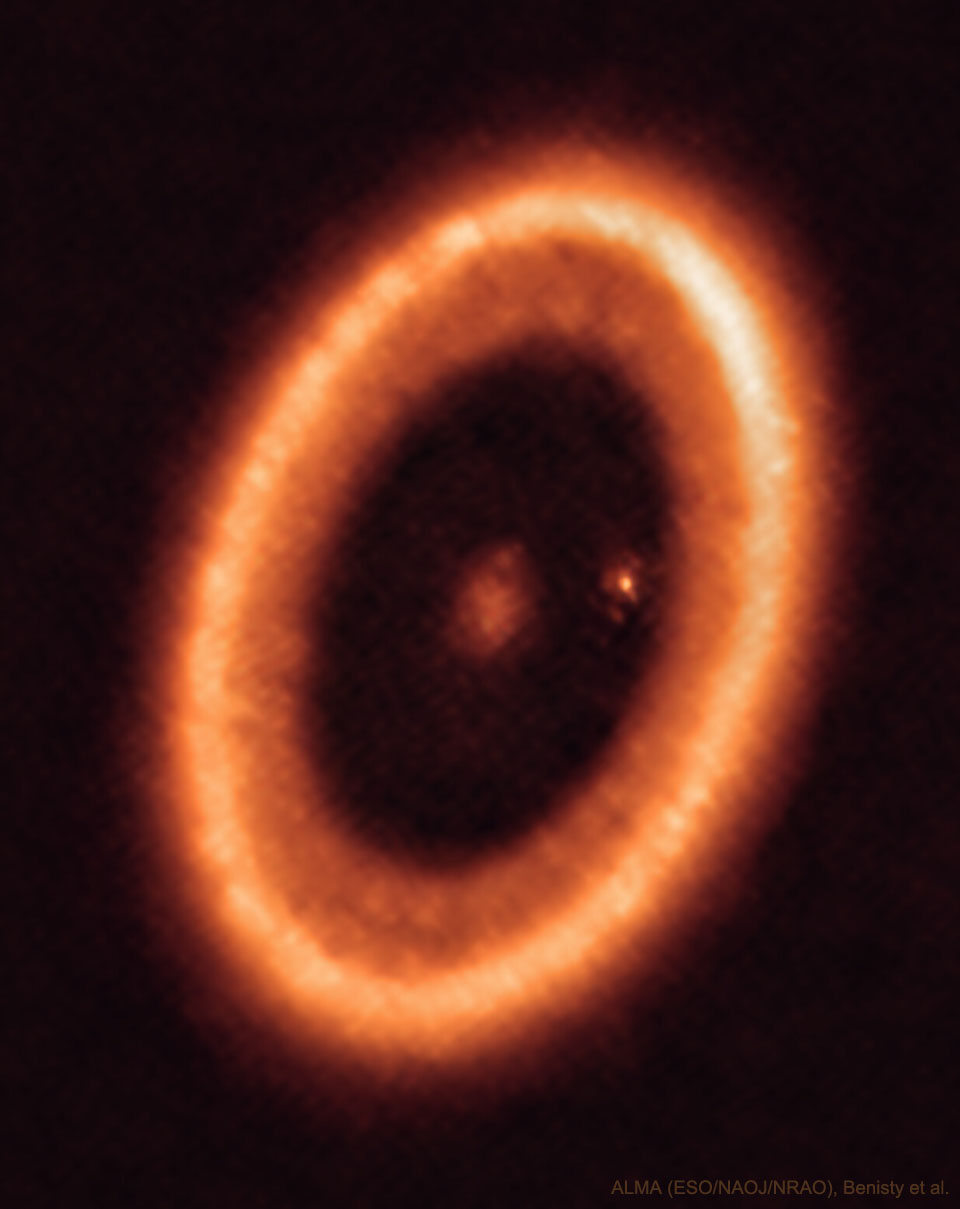
|
| Original url: https://apod.nasa.gov/apod/ap231017.html |
|
Explanation: It's not the big ring that's attracting the most attention. Although the big planet-forming ring around the star PDS 70 is clearly imaged and itself quite interesting. It's also not the planet on the right, just inside the big disk , that’s being talked about the most. Although the planet PDS 70 c is a newly formed and, interestingly, similar in size and mass to Jupiter . It's the fuzzy patch around the planet PDS 70c that's causing the commotion . That fuzzy patch is thought to be a dusty disk that is now forming into moons -- and that had never been seen before. The featured image was taken in 2021 by the Atacama Large Millimeter Array (ALMA) of 66 radio telescopes in the high Atacama Desert of northern Chile . Based on ALMA data, astronomers infer that the moon-forming exoplanetary disk has a radius similar to our Earth's orbit, and may one day form three or so Luna -sized moons -- not very different from our Jupiter 's four . |
2023/10/16
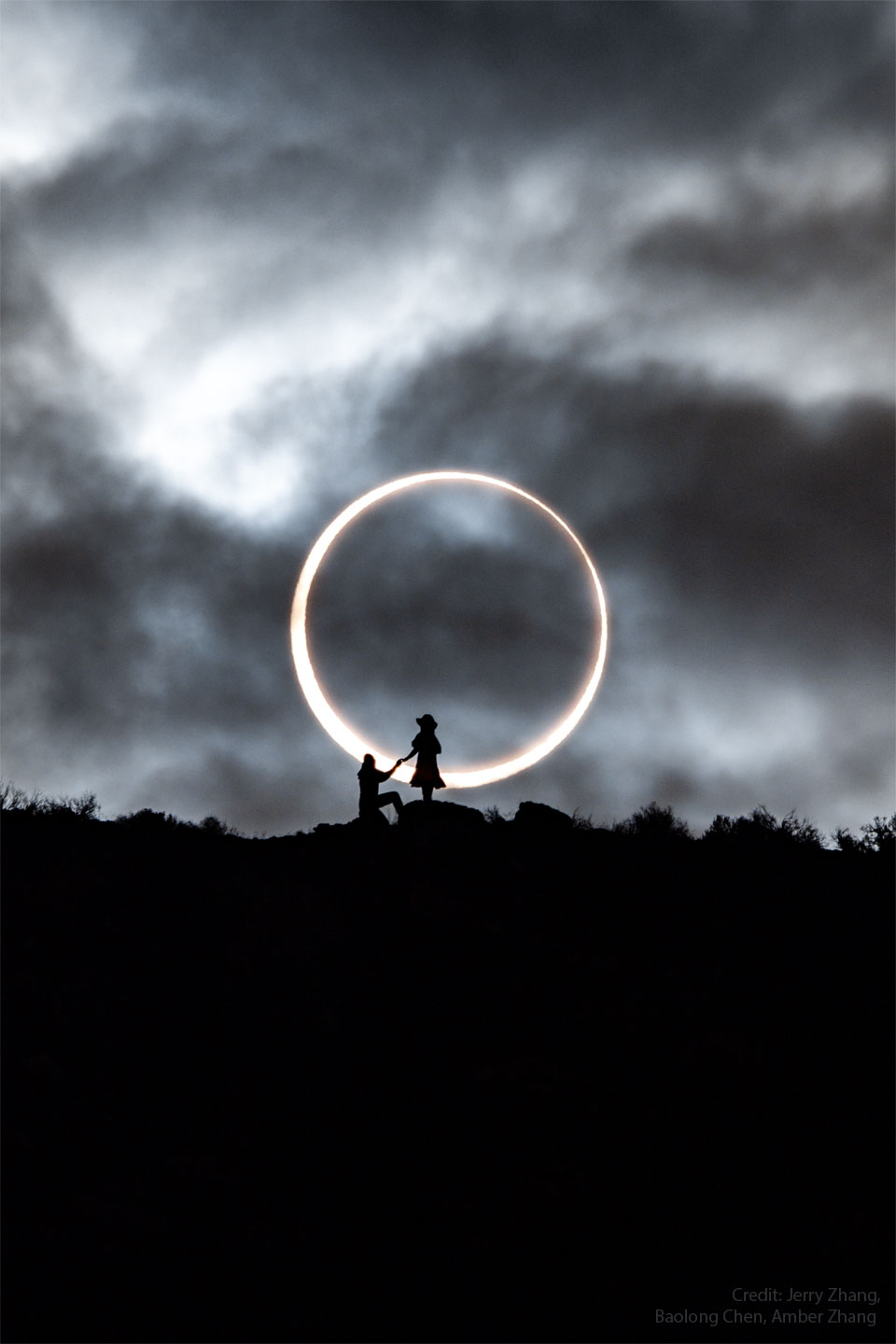
|
| Original url: https://apod.nasa.gov/apod/ap231016.html |
|
Explanation: She knew everything but the question. She was well aware that there would be a complete annular eclipse of the Sun visible from their driving destination: Lake Abert in Oregon . She knew that the next ring-of-fire eclipse would occur in the USA only in 16 more years , making this a rare photographic opportunity. She was comfortable with the plan: that she and her boyfriend would appear in front of the eclipse in silhouette , sometimes alone, and sometimes together. She knew that the annular phase of this eclipse would last only a few minutes and she helped in the many hours of planning . She could see their friend who set up the camera about 400 meters away at the bottom of a ridge. What she didn't know was the question she would be asked. But she did know the answer: "yes". |
2023/10/15

|
| Original url: https://apod.nasa.gov/apod/ap231015.html |
|
Explanation: Yes, but can your tree do this? If you look closely at the ground in the featured image, you will see many images of yesterday's solar eclipse -- created by a tree. Gaps between tree leaves act like pinhole lenses and each create a small image of the partially eclipsed Sun visible in the other direction. The image was taken in Burleson , Texas , USA . Yesterday, people across the Americas were treated to a partial eclipse of the Sun, when the Moon moves in front of part of the Sun. People in a narrow band of Earth were treated to an annular eclipse , also called a ring-of-fire eclipse , when the Moon becomes completely engulfed by the Sun and sunlight streams around all of the Moon's edges . In answer to the lede question, your tree not only can do this , but will do it every time that a visible solar eclipse passes overhead. Next April 8, a deeper, total solar eclipse will move across North America . |
2023/10/14

|
| Original url: https://apod.nasa.gov/apod/ap231014.html |
|
Explanation: Want to see a ring around the Sun? It's easy to do in daytime skies around the world. Created by randomly oriented ice crystals in thin high cirrus clouds, circular 22 degree halos are visible much more often than rainbows. This one was captured by smart phone photography on May 29, 2021 near Rome, Italy. Carefully blocking the Sun , for example with a finger tip, is usually all that it takes to reveal the common bright halo ring. The halo's characteristic angular radius is about equal to the span of your hand, thumb to little finger, at the end of your outstretched arm. Want to see a ring of fire eclipse ? That's harder. The spectacular annular phase of today's (October 14) solar eclipse , known as a ring of fire , is briefly visible only when standing along the Moon's narrow shadow track that passes over limited parts of North, Central, and South America. The solar eclipse is partial though, when seen from broader regions throughout the Americas. |
2023/10/13
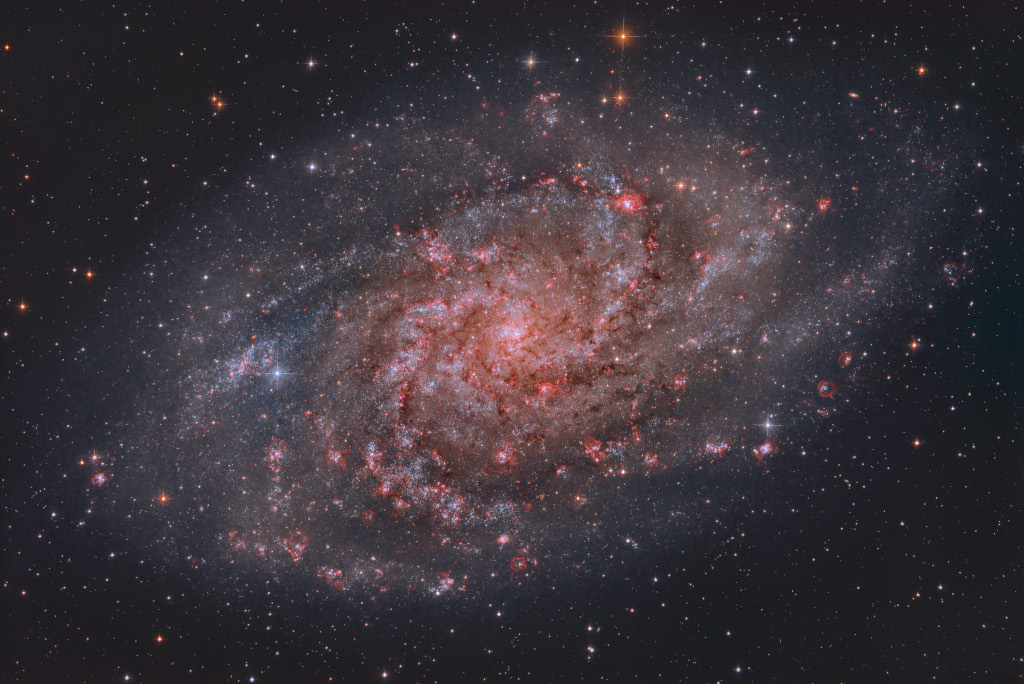
|
| Original url: https://apod.nasa.gov/apod/ap231013.html |
|
Explanation: Gorgeous spiral galaxy Messier 33 seems to have more than its fair share of glowing hydrogen gas. A prominent member of the local group of galaxies, M33 is also known as the Triangulum Galaxy and lies a mere 3 million light-years away. The galaxy's central 30,000 light-years or so are shown in this sharp galaxy portrait . The portrait features M33's reddish ionized hydrogen clouds or HII regions . Sprawling along loose spiral arms that wind toward the core, M33's giant HII regions are some of the largest known stellar nurseries, sites of the formation of short-lived but very massive stars. Intense ultraviolet radiation from the luminous, massive stars ionizes the surrounding hydrogen gas and ultimately produces the characteristic red glow. In this image, broadband data were combined with narrowband data recorded through a hydrogen-alpha filter. That filter transmits the light of the strongest visible hydrogen emission line . |
2023/10/12

|
| Original url: https://apod.nasa.gov/apod/ap231012.html |
|
Explanation: Mu Cephei is a very large star. An M-class supergiant some 1500 times the size of the Sun, it is one of the largest stars visible to the unaided eye, and even one of the largest in the entire Galaxy. If it replaced the Sun in our fair Solar System , Mu Cephei would easily engulf Mars and Jupiter. Historically known as Herschel's Garnet Star , Mu Cephei is extremely red. Approximately 2800 light-years distant, the supergiant is seen near the edge of reddish emission nebula IC 1396 toward the royal northern constellation Cepheus in this telescopic view . Much cooler and hence redder than the Sun, this supergiant's light is further reddened by absorption and scattering due to intervening dust within the Milky Way. A well-studied variable star understood to be in a late phase of stellar evolution, Mu Cephei is a massive star too, destined to ultimately explode as a core-collapse supernova . |
2023/10/11

|
| Original url: https://apod.nasa.gov/apod/ap231011.html |
|
Explanation: What's happening in the lower arm of this spiral galaxy? A supernova . Last month, supernova SN 2023rve was discovered with UAE 's Al-Khatim Observatory and later found to be consistent with the death explosion of a massive star, possibly leaving behind a black hole . Spiral galaxy NGC 1097 is a relatively close 45 million light year s away and visible with a small telescope toward the southern constellation of the Furnace ( Fornax ). The galaxy is notable not only for its picturesque spiral arms , but also for faint jets consistent with ancient star streams left over from a galactic collision -- possibly with the small galaxy seen between its arms on the lower left. The featured image highlights the new supernova by blinking between two exposures taken several months apart. Finding supernovas in nearby galaxies can be important in determining the scale and expansion rate of our entire universe -- a topic currently of unexpected tension and much debate . |
2023/10/10
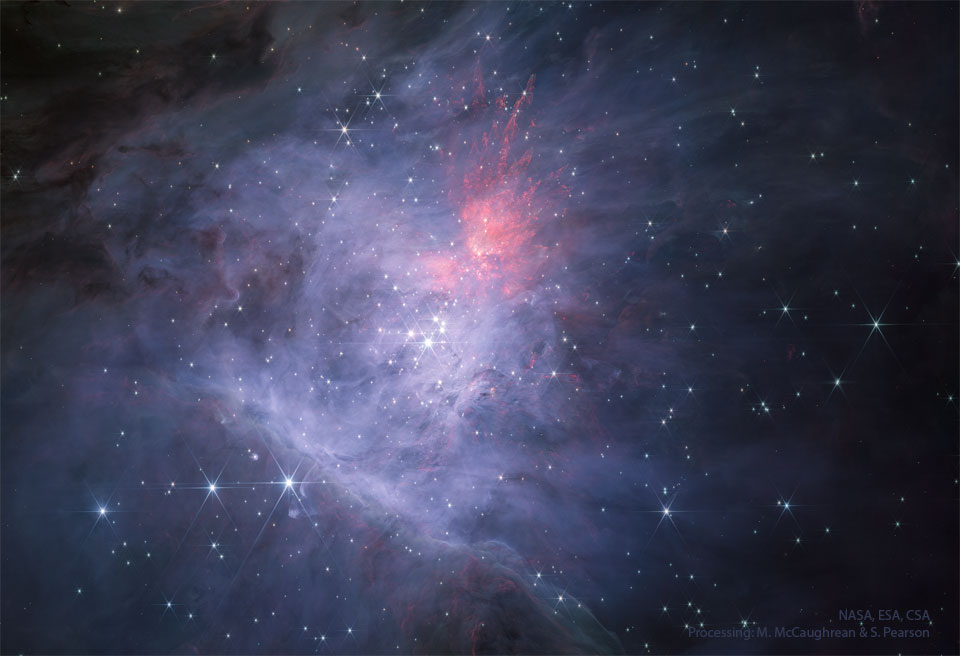
|
| Original url: https://apod.nasa.gov/apod/ap231010.html |
|
Explanation: The Great Nebula in Orion has hidden stars. To the unaided eye in visible light, it appears as a small fuzzy patch in the constellation of Orion . But this image was taken by the Webb Space Telescope in a representative-color composite of red and very near infrared light. It confirms with impressive detail that the Orion Nebula is a busy neighborhood of young stars, hot gas, and dark dust. The rollover image shows the same image in representative colors further into the near infrared . The power behind much of the Orion Nebula (M42) is the Trapezium - a cluster of bright stars near the nebula's center. The diffuse and filamentary glow surrounding the bright stars is mostly heated interstellar dust . Detailed inspection of these images shows an unexpectedly large number of Jupiter-Mass Binary Objects ( JuMBOs ), pairs of Jupiter-mass objects which might give a clue to how stars are forming. The whole Orion Nebula cloud complex, which includes the Horsehead Nebula , will slowly disperse over the next few million years. |
2023/10/09
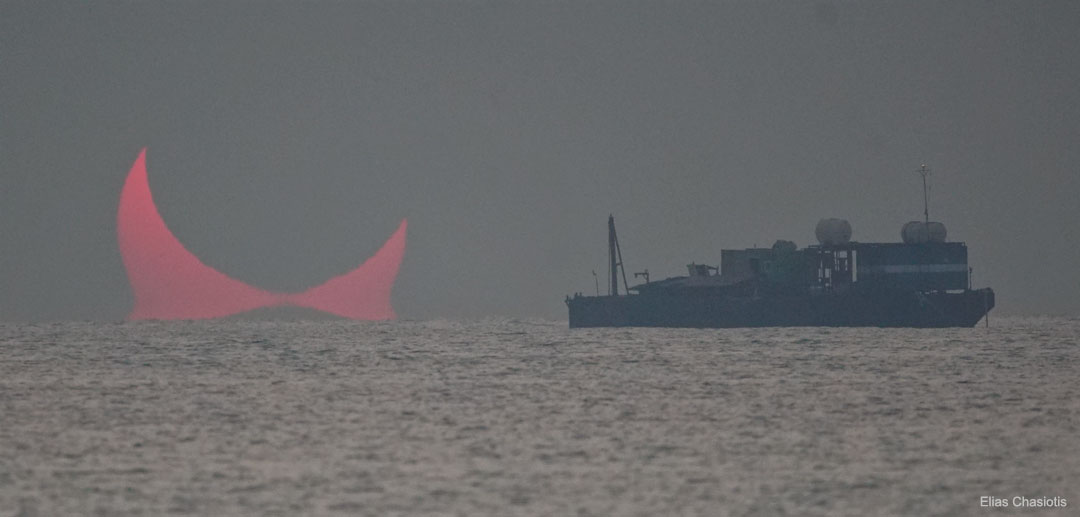
|
| Original url: https://apod.nasa.gov/apod/ap231009.html |
|
Explanation: Yes, but have you ever seen a sunrise like this? Here, after initial cloudiness, the Sun appeared to rise in two pieces and during a partial eclipse in 2019, causing the photographer to describe it as the most stunning sunrise of his life. The dark circle near the top of the atmospherically-reddened Sun is the Moon -- but so is the dark peak just |